Cambium Networks 89FT0011 Dual Channel 2.4GHz MIMO Station and Connectorized Station User Manual Exhibit D Users Manual per 2 1033 b3
Cambium Networks Inc. Dual Channel 2.4GHz MIMO Station and Connectorized Station Exhibit D Users Manual per 2 1033 b3
Exhibit D Users Manual per 2 1033 b3
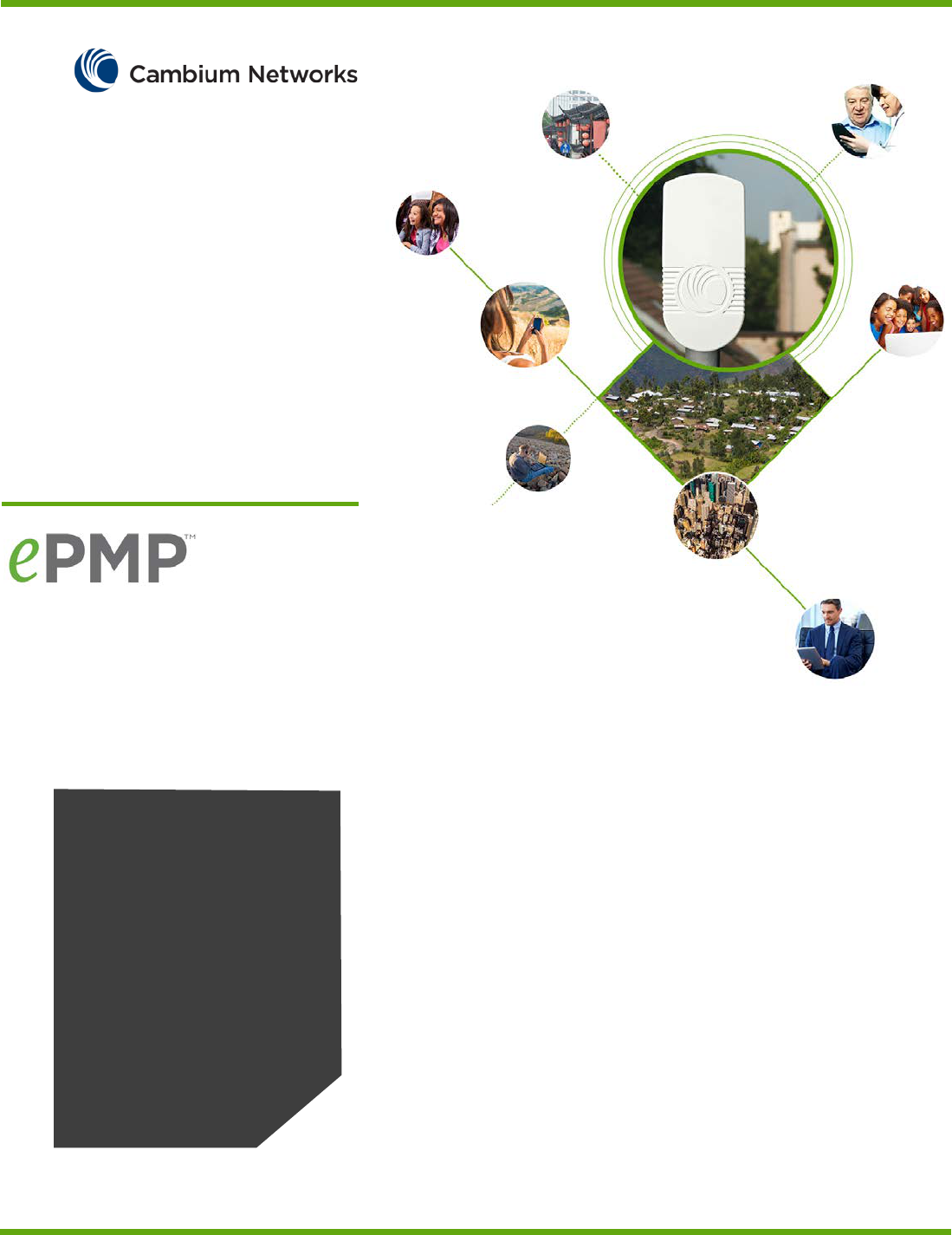
System Release 1.4.3
• Product Description
• System Planning
• Configuration
• Operation and
Troubleshooting
• Legal and Reference
Information
User Guide

CAMBIUM NETWORKS
Accuracy
While reasonable efforts have been made to assure the accuracy of this document, Cambium
Networks assumes no liability resulting from any inaccuracies or omissions in this document, or
from use of the information obtained herein. Cambium reserves the right to make changes to
any products described herein to improve reliability, function, or design, and reserves the right
to revise this document and to make changes from time to time in content hereof with no
obligation to notify any person of revisions or changes. Cambium does not assume any liability
arising out of the application or use of any product, software, or circuit described herein; neither
does it convey license under its patent rights or the rights of others. It is possible that this
publication may contain references to, or information about Cambium products (machines and
programs), programming, or services that are not announced in your country. Such references
or information must not be construed to mean that Cambium intends to announce such
Cambium products, programming, or services in your country.
Copyrights
This document, Cambium products, and 3rd Party software products described in this document
may include or describe copyrighted Cambium and other 3rd Party supplied computer programs
stored in semiconductor memories or other media. Laws in the United States and other
countries preserve for Cambium, its licensors, and other 3rd Party supplied software certain
exclusive rights for copyrighted material, including the exclusive right to copy, reproduce in any
form, distribute and make derivative works of the copyrighted material. Accordingly, any
copyrighted material of Cambium, its licensors, or the 3rd Party software supplied material
contained in the Cambium products described in this document may not be copied, reproduced,
reverse engineered, distributed, merged or modified in any manner without the express written
permission of Cambium. Furthermore, the purchase of Cambium products shall not be deemed
to grant either directly or by implication, estoppel, or otherwise, any license under the
copyrights, patents or patent applications of Cambium or other 3rd Party supplied software,
except for the normal non-exclusive, royalty free license to use that arises by operation of law in
the sale of a product.
Restrictions
Software and documentation are copyrighted materials. Making unauthorized copies is
prohibited by law. No part of the software or documentation may be reproduced, transmitted,
transcribed, stored in a retrieval system, or translated into any language or computer language,
in any form or by any means, without prior written permission of Cambium.
License Agreements
The software described in this document is the property of Cambium and its licensors. It is
furnished by express license agreement only and may be used only in accordance with the
terms of such an agreement.
High Risk Materials
Cambium and its supplier(s) specifically disclaim any express or implied warranty of fitness for
any high risk activities or uses of its products including, but not limited to, the operation of
nuclear facilities, aircraft navigation or aircraft communication systems, air traffic control, life
support, or weapons systems (“High Risk Use”). Any High Risk is unauthorized, is made at your
own risk and you shall be responsible for any and all losses, damage or claims arising out of any
High Risk Use.
© 2014 Cambium Networks Limited. All Rights Reserved.
2

CAMBIUM NETWORKS
Safety and regulatory information
This section describes important safety and regulatory guidelines that must be observed by
personnel installing or operating ePMP equipment.
IMPORTANT SAFETY INFORMATION
Warning
To prevent loss of life or physical injury, observe the safety guidelines in this section.
Power lines
Exercise extreme care when working near power lines.
Working at heights
Exercise extreme care when working at heights.
Grounding and protective earth
Connectorized ePMP devices must be properly grounded to protect against lightning. It is the
user’s responsibility to install the equipment in accordance with national regulations. In the USA,
follow Section 810 of the National Electric Code, ANSI/NFPA No.70-1984 (USA). In Canada, follow
Section 54 of the Canadian Electrical Code. These codes describe correct installation procedures
for grounding the outdoor unit, mast, lead-in wire and discharge unit, size of grounding
conductors and connection requirements for grounding electrodes. Other regulations may apply in
different countries and therefore it is recommended that installation be contracted to a
professional installer.
Powering down before servicing
Always power down and unplug the equipment before servicing.
Primary disconnect device
The ePMP power supply is the primary disconnect device.
External cables
Safety may be compromised if outdoor rated cables are not used for connections that will be
exposed to the outdoor environment.
RF exposure near the antenna
Strong radio frequency (RF) fields will be present close to the antenna when the transmitter is on.
Always turn off the power to the ePMP device before undertaking maintenance activities in front of
the antenna.
Minimum separation distances
Install the ePMP device so as to provide and maintain the minimum separation distances from all
persons.
The minimum separation distances for each frequency variant are specified in
Calculated distances
and power compliance margins
on page
263
.
3

CAMBIUM NETWORKS
IMPORTANT REGULATORY INFORMATION
The ePMP product is certified as an unlicensed device in frequency bands where it is not allowed
to cause interference to licensed services (called primary users of the bands).
Radar avoidance
In countries where radar systems are the primary band users, the regulators have mandated
special requirements to protect these systems from interference caused by unlicensed devices.
Unlicensed devices must detect and avoid co-channel operation with radar systems.
The ePMP provides detect and avoid functionality for countries and frequency bands requiring
protection for radar systems.
Installers and users must meet all local regulatory requirements for radar detection. To meet these
requirements, users must set the correct country code during commissioning of the ePMP
equipment. If this is not done, installers and users may be liable to civil and criminal penalties.
Contact the Cambium helpdesk if more guidance is required.
USA and Canada specific information
The USA Federal Communications Commission (FCC) has asked manufacturers to implement
special features to prevent interference to weather radar systems that operate in the band 5600
MHz to 5650 MHz. These features must be implemented in all products able to operate outdoors in
the band 5470 MHz to 5725 MHz.
Manufacturers must ensure that such radio products cannot be configured to operate outside of
FCC rules; specifically it must not be possible to disable or modify the radar protection functions
that have been demonstrated to the FCC.
In order to comply with these FCC requirements, Cambium supplies variants of the ePMP for
operation in the USA or Canada. These variants are only allowed to operate with license keys and
country codes that comply with FCC/IC rules. In particular, operation of radio channels overlapping
the band 5600-5650 MHz is not allowed and these channels are permanently barred.
In addition, other channels may also need to be barred when operating close to weather radar
installations.
Note
To ensure compliance with FCC rules (KDB 443999: Interim Plans to Approve UNII Devices
Operating in the 5470 - 5725 MHz Band with Radar Detection and DFS Capabilities), follow
Avoidance of weather radars
on page
64
.
Other variants of the ePMP are available for use in the rest of the world, but these variants are not
supplied to the USA or Canada except under strict controls, when they are needed for export and
deployment outside the USA or Canada.
Specific expertise and training required for professional installers
To ensure that the ePMP is installed and configured in compliance with the requirements of
Industry Canada and the FCC, installers must have the radio engineering skills and training
described in this section. This is particularly important when installing and configuring an ePMP
system for operation in the 5.4 GHz UNII band.
4

CAMBIUM NETWORKS
Avoidance of weather radars
The installer must be familiar with the requirements in FCC KDB 443999. Essentially, the installer
must be able to:
• Access the FCC data base of weather radar location and channel frequencies.
• Use this information to correctly configure the product (using the GUI) to avoid operation on
channels that must be avoided according to the guidelines that are contained in the KDB and
explained in detail in this user guide.
In ETSI regions, the band 5600 MHz to 5650 MHz is reserved for the use of weather radars.
External antennas
When using a connectorized version of the product (as compared to the version with an integrated
antenna), the conducted transmit power must be reduced to ensure the regulatory limit on
transmitter EIRP is not exceeded. The installer must have an understanding of how to compute the
effective antenna gain from the actual antenna gain and the antenna cable losses.
The product GUI automatically applies the correct conducted power limit to ensure that it is not
possible for the installation to exceed the EIRP limit, when the appropriate values for antenna gain
are entered into the GUI.
Ethernet networking skills
The installer must have the ability to configure IP addressing on a PC and to set up and control
products using a web browser interface.
Lightning protection
To protect outdoor radio installations from the impact of lightning strikes, the installer must be
familiar with the normal procedures for site selection, bonding and grounding. Installation
guidelines for the ePMP can be found in section
System planning
on page
60
.
Training
The installer needs to have basic competence in radio and IP network installation. The specific
requirements applicable to the ePMP must be gained by reading this user guide and by performing
sample set ups at base workshop before live deployments.
5

CAMBIUM NETWORKS
Contents
Safety and regulatory information ................................................................................... 3
Important safety information ........................................................................................... 3
Important regulatory information.................................................................................... 4
Contents ..................................................................................................................... 6
About This User Guide ............................................................................................. 11
General information ....................................................................................................... 12
Version information ........................................................................................................12
Contacting Cambium Networks ......................................................................................12
Problems and warranty .................................................................................................. 14
Security advice ............................................................................................................... 15
Warnings, cautions, and notes ....................................................................................... 16
Caring for the environment ............................................................................................ 17
Product description .................................................................................................. 18
Overview of ePMP .......................................................................................................... 19
Purpose ............................................................................................................................19
Key features .....................................................................................................................19
Typical deployment Equipment ......................................................................................20
Wireless operation ......................................................................................................... 21
Time division duplexing ..................................................................................................21
OFDM and channel bandwidth .......................................................................................21
Adaptive modulation .......................................................................................................21
MIMO ...............................................................................................................................21
Radar avoidance ..............................................................................................................22
Encryption ........................................................................................................................22
Country codes ..................................................................................................................22
PMP networks ..................................................................................................................23
Further reading on wireless operation ...........................................................................24
System management ..................................................................................................... 25
Management agent .........................................................................................................25
Web server .......................................................................................................................25
SNMP ...............................................................................................................................27
Network Time Protocol (NTP) .........................................................................................27
Cambium Network Services Server ...............................................................................27
Software upgrade ............................................................................................................27
Further reading on system management.......................................................................28
System hardware ..................................................................................................... 29
Site planning .................................................................................................................. 30
Site installation ................................................................................................................30
Grounding and lightning protection ...............................................................................30
Lightning protection zones .............................................................................................31
Connectorized Module ................................................................................................... 32
Connectorized Module description ................................................................................32
Connectorized part numbers ..........................................................................................33
Connectorized module mounting bracket ......................................................................33
6

CAMBIUM NETWORKS
Connectorized Module interfaces ...................................................................................34
Connectorized Module LEDs ...........................................................................................35
Connectorized Module specifications ............................................................................36
Connectorized Module heater .........................................................................................37
Connectorized Module and external antenna location ..................................................37
Connectorized Module wind loading .............................................................................38
Connectorized Module software packages ....................................................................38
Connectorized module antennas and antenna cabling .................................................. 39
Antenna requirements ....................................................................................................39
FCC and IC approved antennas ......................................................................................39
Integrated Module .......................................................................................................... 40
Integrated Module description .......................................................................................40
Integrated Module part numbers ...................................................................................41
Integrated Module mounting bracket .............................................................................41
Integrated Module interfaces ..........................................................................................42
Integrated Module LEDs ..................................................................................................43
Integrated Module specifications ...................................................................................43
Integrated Module heater ...............................................................................................44
Integrated Module wind loading ....................................................................................44
Integrated Module software packages ...........................................................................45
Un-synced Connectorized Radio .................................................................................... 46
Un-synced Connectorized Radio description .................................................................46
Un-synced Connectorized Radio part numbers .............................................................47
Un-synced Connectorized Radio mounting bracket ......................................................47
Un-synced Connectorized Radio Interfaces ...................................................................48
Un-synced Connectorized Radio LEDs ...........................................................................49
Un-synced Connectorized Radio specifications .............................................................50
Un-synced Connectorized Radio heater .........................................................................51
Un-synced Connectorized Radio and external antenna location ..................................51
Un-synced connectorized Radio wind loading ..............................................................52
Un-synced Connectorized Radio software packages.....................................................53
Un-synced connectorized radio antennas and antenna cabling ...................................53
Antenna requirements ....................................................................................................53
FCC and IC approved antennas ......................................................................................53
Power supply description ...............................................................................................54
Power supply part numbers............................................................................................54
Power supply interfaces ..................................................................................................55
Power supply specifications ...........................................................................................56
Power supply location .....................................................................................................56
Ethernet cabling ............................................................................................................. 57
Ethernet standards and cable lengths ............................................................................57
Outdoor Cat5e cable ........................................................................................................57
Surge Suppression unit .................................................................................................. 58
Cambium 600SSH details ...............................................................................................59
System planning ...................................................................................................... 60
Radio spectrum planning ............................................................................................... 61
General wireless specifications ......................................................................................61
Regulatory limits .............................................................................................................62
7

CAMBIUM NETWORKS
Conforming to the limits .................................................................................................62
Available spectrum ..........................................................................................................63
Channel bandwidth .........................................................................................................63
Avoidance of weather radars ..........................................................................................64
Link planning .................................................................................................................. 65
Range and obstacles .......................................................................................................65
Path loss ...........................................................................................................................65
Adaptive modulation .......................................................................................................65
Planning for connectorized units .................................................................................... 66
Calculating maximum power level for connectorized units ..........................................66
Data network planning ................................................................................................... 68
Ethernet interfaces ..........................................................................................................68
Management VLAN .........................................................................................................68
Quality of service for bridged Ethernet traffic ...............................................................69
Configuration ........................................................................................................... 70
Preparing for configuration ............................................................................................ 71
Safety precautions ...........................................................................................................71
Regulatory compliance ...................................................................................................71
Connecting to the unit .................................................................................................... 72
Configuring the management PC ...................................................................................72
Connecting to the PC and powering up .........................................................................73
Using the web interface ................................................................................................. 74
Logging into the web interface .......................................................................................75
Layout of the web interface ............................................................................................76
Configuring connectorized radios using the Quick Start menu ..................................... 83
Configuring STA units using the Quick Start menu ....................................................... 86
Using the AP menu options ........................................................................................... 89
AP Configure menu .........................................................................................................90
AP Monitor menu .......................................................................................................... 116
AP Tools menu .............................................................................................................. 129
Using the STA menu options ....................................................................................... 139
STA Configuration menu .............................................................................................. 140
STA Monitor menu ........................................................................................................ 165
STA Tools menu ............................................................................................................ 177
Radius Server ............................................................................................................... 187
Installing Free-radius on Ubuntu 12.04 LTS ................................................................. 187
Configuring Free-radius server ..................................................................................... 187
Configuring radius parameters on AP .......................................................................... 189
Configuring radius parameters on STA ....................................................................... 190
Configuring MIR profiles ............................................................................................... 191
Creating certificate for Radius server and STA device ................................................ 192
Operation and Troubleshooting ............................................................................ 197
General Planning for Troubleshooting ......................................................................... 198
General Fault Isolation Process .................................................................................... 198
Questions to Help Isolate the Problem ......................................................................... 199
Upgrading device software .......................................................................................... 200
Testing hardware ......................................................................................................... 201
Checking the power supply LED ................................................................................... 201
8

CAMBIUM NETWORKS
Power LED is off ............................................................................................................ 201
Ethernet LED is off ......................................................................................................... 201
Troubleshooting the radio link ..................................................................................... 204
Module has lost or does not establish radio connectivity........................................... 204
Link is unreliable or does not achieve data rates required ......................................... 205
Module Has Lost or Does Not Gain GPS Synchronization .......................................... 205
Using the device external reset button ........................................................................ 206
Resetting the AP or STA to factory defaults by power cycling .................................... 207
Legal and reference information ........................................................................... 208
Cambium Networks end user license agreement ........................................................ 209
Acceptance of this agreement ...................................................................................... 209
Definitions ...................................................................................................................... 209
Grant of license ............................................................................................................. 209
Conditions of use ........................................................................................................... 209
Title and restrictions ...................................................................................................... 210
Confidentiality ............................................................................................................... 211
Right to use Cambium’s name ..................................................................................... 211
Transfer .......................................................................................................................... 211
Updates .......................................................................................................................... 211
Maintenance .................................................................................................................. 211
Disclaimer ...................................................................................................................... 212
Limitation of liability ..................................................................................................... 212
U.S. government ........................................................................................................... 212
Term of license .............................................................................................................. 213
Governing law ............................................................................................................... 213
Assignment .................................................................................................................... 213
Survival of provisions ................................................................................................... 213
Entire agreement ........................................................................................................... 213
Third party software ...................................................................................................... 213
Preamble ........................................................................................................................ 223
TERMS AND CONDITIONS FOR COPYING, DISTRIBUTION AND MODIFICATION ... 224
END OF TERMS AND CONDITIONS ............................................................................. 229
Hardware warranty ....................................................................................................... 258
Limit of liability ............................................................................................................. 259
System threshold, output power and link loss ............................................................. 260
Compliance with safety standards ............................................................................... 261
Electrical safety compliance.......................................................................................... 261
Electromagnetic compatibility (EMC) compliance ....................................................... 261
Human exposure to radio frequency energy ............................................................... 262
Compliance with radio regulations .............................................................................. 266
Type approvals .............................................................................................................. 266
FCC and ETSI compliance testing ................................................................................. 266
Examples of regulatory limits ....................................................................................... 267
Notifications ................................................................................................................. 279
2.4 GHz, 5.4 GHz regulatory compliance ...................................................................... 279
5.8 GHz regulatory compliance ..................................................................................... 282
Thailand notification ..................................................................................................... 286
Data throughput tables ................................................................................................. 287
9

CAMBIUM NETWORKS
Data throughput capacity .............................................................................................. 287
Radio Specifications ..................................................................................................... 288
Connectorized Radio Specifications ............................................................................. 288
Integrated Radio Specifications .................................................................................... 292
Un-synced Connectorized Radio Specifications .......................................................... 296
Glossary ....................................................................................................................... 300
10

CAMBIUM NETWORKS
About This User Guide
This guide describes the planning, installation, configuration and operation of the Cambium ePMP
Series of point-to-multipoint wireless Ethernet systems. It is intended for use by the system
designer, system installer and system administrator.
For radio network design, see:
•
Product description
•
System hardware
•
System planning
•
Legal and reference information
For system configuration, monitoring and fault-finding, see:
•
Configuration
•
Operation and Troubleshooting
For radio equipment installation, refer the following guides:
• The ePMP Quick Start Guide
• The ePMP Installation Guide
Note
The ePMP Installation Guide
is reproduced as an addendum to this user guide.
11

CAMBIUM NETWORKS
General information
VERSION INFORMATION
The following shows the issue status of this document:
Issue
Date of issue
Remarks
001v000 October 2013 System Release 1.0 (Software Release 1.1.6)
002v000 December 2013 System Release 1.0 (Software Release 1.2.3)
003v000 January 2014 System Release 1.0 (Software Release 1.3.4)
004v000 March 2014 System Release 1.0 (Software Release 1.4.1)
005v000 March 2014 System Release 1.0 (Software Release 1.4.3)
CONTACTING CAMBIUM NETWORKS
Support website:
http://www.cambiumnetworks.com/support
Main website:
http://www.cambiumnetworks.com
Sales enquiries:
solutions@cambiumnetworks.com
Support enquiries:
support@cambiumnetworks.com
Telephone number list:
http://www.cambiumnetworks.com/support/contact-support/
Address: Cambium Networks Limited,
3800 Golf Road, Suite 360
Rolling Meadows, IL 60008
Purpose
Cambium Networks enhanced Point-To-Multipoint (ePMP) documents are intended to instruct and
assist personnel in the operation, installation and maintenance of the Cambium ePMP equipment
and ancillary devices. It is recommended that all personnel engaged in such activities be properly
trained.
Cambium disclaims all liability whatsoever, implied or expressed, for any risk of damage, loss or
reduction in system performance arising directly or indirectly out of the failure of the customer, or
anyone acting on the customer's behalf, to abide by the instructions, system parameters, or
recommendations made in this document.
12

CAMBIUM NETWORKS
Cross references
References to external publications are shown in italics. Other cross references, emphasized in
green text
in electronic versions, are active links to the references.
Feedback
We appreciate feedback from the users of our documents. This includes feedback on the structure,
content, accuracy, or completeness of our documents.
For feedback, send mail to
support@cambiumnetworks.com
.
13

CAMBIUM NETWORKS
Problems and warranty
Reporting problems
If any problems are encountered when installing or operating this equipment, follow this
procedure to investigate and report:
1
Search this document and the software release notes of supported releases.
2
Visit the support website:
http://www.cambiumnetworks.com/support/epmp
3
Ask for assistance from the Cambium product supplier.
4
Gather information from affected units, such as any available diagnostic downloads.
5
Escalate the problem by emailing or telephoning support:
http://www.cambiumnetworks.com/support/contact-support
Repair and service
If unit failure is suspected, obtain details of the Return Material Authorization (RMA) process from
the support website.
Warranty
Cambium’s standard hardware warranty is for one (1) year from date of shipment from Cambium
or a Cambium distributor. Cambium warrants that hardware will conform to the relevant published
specifications and will be free from material defects in material and workmanship under normal
use and service. Cambium shall within this time, at its own option, either repair or replace the
defective product within thirty (30) days of receipt of the defective product. Repaired or replaced
product will be subject to the original warranty period but not less than thirty (30) days.
To register PMP products or activate warranties, visit the support website.
For warranty assistance, contact the reseller or distributor.
Caution
Do not open the radio housing for repair or diagnostics; there are no serviceable parts within the
housing.
Portions of Cambium equipment may be damaged from exposure to electrostatic discharge. Use
precautions to prevent damage.
14

CAMBIUM NETWORKS
Security advice
Cambium Networks systems and equipment provide security parameters that can be configured
by the operator based on their particular operating environment. Cambium recommends setting
and using these parameters following industry recognized security practices. Security aspects to
be considered are protecting the confidentiality, integrity, and availability of information and
assets. Assets include the ability to communicate, information about the nature of the
communications, and information about the parties involved.
In certain instances Cambium makes specific recommendations regarding security practices,
however the implementation of these recommendations and final responsibility for the security of
the system lies with the operator of the system.
Cambium Networks ePMP equipment is shipped with default web management interface login
credentials. It is highly recommended that these usernames and passwords are modified prior to
system deployment.
15
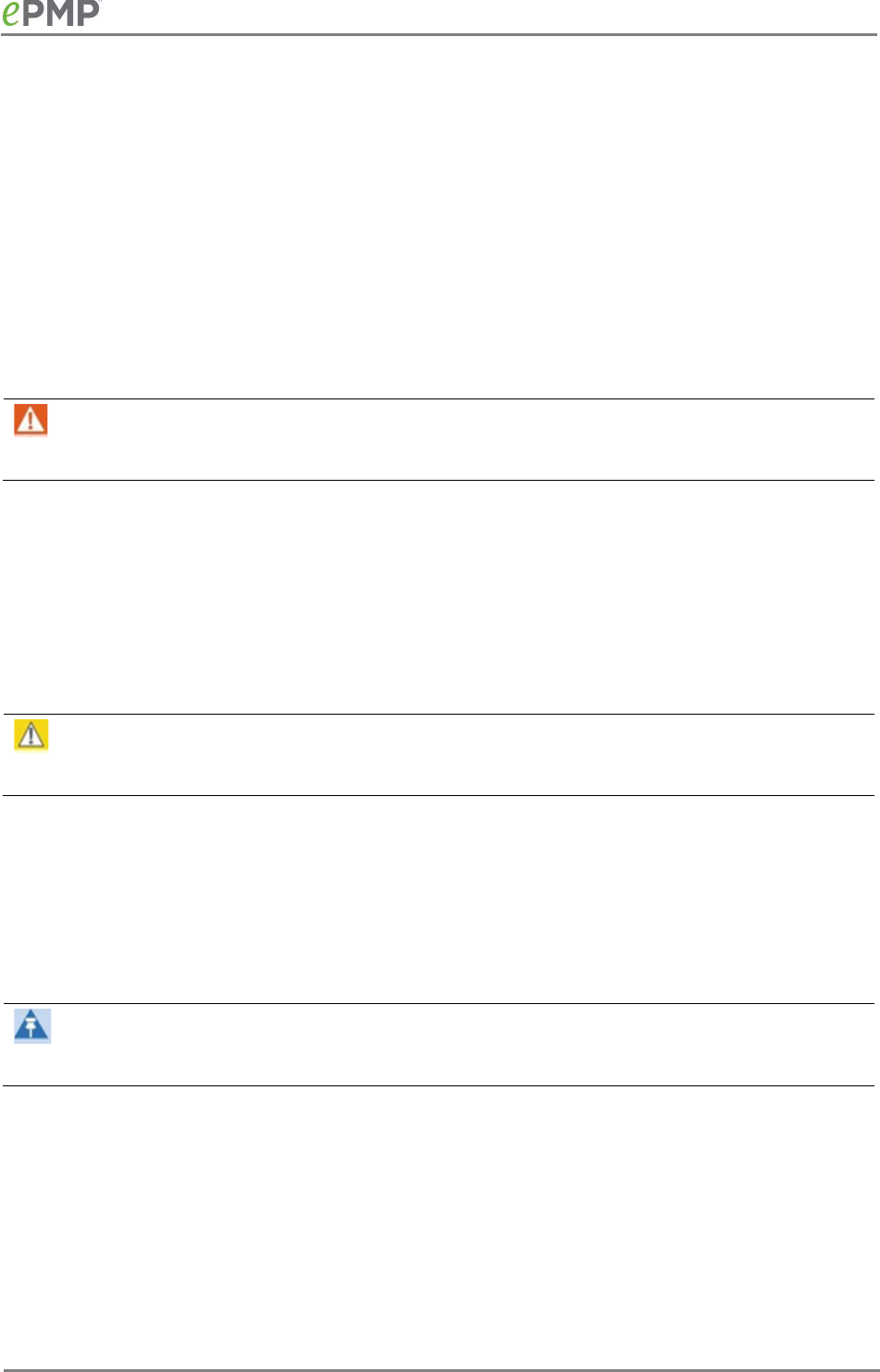
CAMBIUM NETWORKS
Warnings, cautions, and notes
The following describes how warnings and cautions are used in this document and in all
documents of the Cambium Networks document set.
Warnings
Warnings precede instructions that contain potentially hazardous situations. Warnings are used to
alert the reader to possible hazards that could cause loss of life or physical injury. A warning has
the following format:
Warning
Warning text and consequence for not following the instructions in the warning.
Cautions
Cautions precede instructions and are used when there is a possibility of damage to systems,
software, or individual items of equipment within a system. However, this damage presents no
danger to personnel. A caution has the following format:
Caution
Caution text and consequence for not following the instructions in the caution.
Notes
A note means that there is a possibility of an undesirable situation or provides additional
information to help the reader understand a topic or concept. A note has the following format:
Note
Note text.
16

CAMBIUM NETWORKS
Caring for the environment
The following information describes national or regional requirements for the disposal of
Cambium Networks supplied equipment and for the approved disposal of surplus packaging.
In EU countries
The following information is provided to enable regulatory compliance with the European Union
(EU) directives identified and any amendments made to these directives when using Cambium
equipment in EU countries.
Disposal of Cambium equipment
European Union (EU) Directive 2002/96/EC Waste Electrical and Electronic Equipment (WEEE)
Do not dispose of Cambium equipment in landfill sites. For disposal instructions, see
http://www.cambiumnetworks.com/support
Disposal of surplus packaging
Do not dispose of surplus packaging in landfill sites. In the EU, it is the individual recipient’s
responsibility to ensure that packaging materials are collected and recycled according to the
requirements of EU environmental law.
In non-EU countries
In non-EU countries, dispose of Cambium equipment and all surplus packaging in accordance with
national and regional regulations.
17

Product description
This chapter provides a high level description of the ePMP product. It describes in general terms
the function of the product, the main product variants and typical deployment. It also describes the
main hardware components.
The following topics are described in this chapter:
•
Overview of ePMP
on page
19
introduces the key features, typical uses, product variants and
components of the ePMP.
•
Wireless operation
on page
21
describes how the ePMP wireless link is operated, including
modulation modes, power control and security.
•
System management
on page
25
introduces the ePMP management system, including the web
interface, installation, configuration, alerts and upgrades.
18

CAMBIUM NETWORKS
Overview of ePMP
This section introduces the key features, typical uses, product variants and components of the
ePMP.
PURPOSE
Cambium ePMP Series products are designed for Ethernet bridging over point-to-multipoint
microwave links in the unlicensed 5 GHz and 2.4 GHz bands. Users must ensure that the ePMP
Series complies with local operating regulations.
The ePMP Series
acts as a transparent bridge between two segments of the operator and
customers’ networks. In this sense, it can be treated as a virtual wired connection between the
Access Point and the Station. The ePMP Series
forwards 802.3 Ethernet packets destined for the
other part of the network and filters packets it does not need to forward.
KEY FEATURES
The ePMP is a high performance wireless bridge for Ethernet traffic with a maximum UDP
throughput of 200+ Mbps (40 MHz Channel Bandwidth). It is capable of operating in line-of-sight
(LOS) and near-LOS conditions. Its maximum LOS range is 13 mi (20 MHz channel bandwidth), or
9 mi (40 MHz channel bandwidth).
Utilizing GPS sync, the ePMP is an ideal fit for networks that require capacity and reliability for
superior QoS in remote and underserved areas. This integrated PTP and PMP solution features an
efficient GPS synchronized operational mode that permits highly scalable frequency reuse.
The ePMP operates in the unlicensed 5 GHz and 2.4 GHz bands and supports a channel bandwidth
of up to 40 MHz. It is available with an integrated antenna or in connectorized version for use with
an external antenna.
The wireless link is primarily TDD based. System Release 1.2.3 added Flexible Frame Ratio option
which provides improved latency and throughput under unsynchronized operational mode.
From a network point-of-view, the ePMP wireless link is a transparent Layer 2 bridge. It offers
limited switching capability in order to support a primary and a secondary (future release) Ethernet
port on the Station.
ePMP supports quality of service (QoS) classification capability and supports three traffic priorities.
Management of the unit is conducted via the same interface as the bridged traffic (in-band
Management).
System Release 1.3.4 adds support for RADIUS EAP-TTLS authentication and VSA support for MIR.
When deployed with a sector antenna, the ePMP 1000 GPS Sync Radio can be configured as a GPS
synchronized Access Point serving ePMP Integrated Radios configured as Stations. When
deployed with a high gain point to point antenna, the ePMP GPS Sync Radio can be configured to
be a GPS Synchronized Backhaul Master, forming a PTP link with another ePMP Radio module.
Table 1
gives a summary of the main ePMP characteristics.
19

CAMBIUM NETWORKS
Table 1
Main characteristics of the
ePMP Series
Characteristic
Value
Topology PMP or PTP
Wireless link condition LOS, near LOS
Range 20 MHz: Up to 13 mi
40 MHz: Up to 9 mi
Scheduler TDD or Flexible
Connectivity Ethernet
Operating frequencies Unlicensed bands, 5 GHz and 2.4 GHz
Channel bandwidth 20 MHz, 40 MHz
Data rate 200+ Mbps
TYPICAL DEPLOYMENT EQUIPMENT
The ePMP is a solution consisting of an integrated or connectorized outdoor units, indoor power
supply units/LAN injectors, cabling, and surge suppression equipment.
The main hardware components of an ePMP deployment are as follows:
•
Connectorized Radio with GPS Sync:
A connectorized outdoor transceiver unit containing all
the radio, networking, and surge suppression electronics.
•
Connectorized Radio Power Supply:
An indoor power supply module providing Power-over-
Ethernet (PoE) supply and 1000/100/10 Base-TX to the Access Point.
•
Connectorized Radio Cabling and lightning protection:
Shielded Cat 5e cables, grounding
cables, and connectors.
•
Integrated Radio:
An integrated-antenna outdoor transceiver unit containing all the radio,
networking, antenna, and surge suppression electronics.
•
Un-synced Connectorized Radio:
A connectorized outdoor transceiver unit containing all the
radio, networking, and surge suppression electronics.
•
Integrated Radio Power Supply:
An indoor power supply module providing Power-over-
Ethernet (PoE) supply and 100/10 Base-TX to the Subscriber Module.
•
Integrated Radio Cabling and lightning protection:
Cat 5e cables and connectors
For more information about these components, including interfaces, specifications and Cambium
part numbers, see
System hardware
on page
29
.
20

CAMBIUM NETWORKS
Wireless operation
This section describes how the ePMP wireless link is operated, including modulation modes,
power control and security.
TIME DIVISION DUPLEXING
TDD cycle
ePMP links operate using Time Division Duplexing (TDD). The links employ a TDD cycle in which
the APs determines which STAs may transmit and when based on the configured downlink/uplink
ratio (duty cycle). Three fixed Downlink/Uplink frame ratios are available – 75/25, 50/50 and 30/70.
A flexible frame ratio is available as a fourth option where the AP dynamically determines the
downlink and uplink ratio based on data demand in each direction.
OFDM AND CHANNEL BANDWIDTH
The ePMP series transmits using Orthogonal Frequency Division Multiplexing (OFDM). This
wideband signal consists of many equally spaced sub-carriers. Although each sub carrier is
modulated at a low rate using conventional modulation schemes, the resultant data rate from all
the sub-carriers is high.
The channel bandwidth of the OFDM signal is 20 MHz or 40 MHz, based on operator configuration.
Each channel is offset in center frequency from its neighboring channel by 5 MHz.
ADAPTIVE MODULATION
The ePMP series can transport data over the wireless link using a number of different modulation
modes ranging from 64-QAM to QPSK. For a given channel bandwidth and TDD frame structure,
each modulation mode transports data at a fixed rate. Also, the receiver requires a given signal to
noise ratio in order to successfully demodulate a given modulation mode. Although the more
complex modulations such as 64QAM will transport data at a much higher rate than the less
complex modulation modes, the receiver requires a much higher signal to noise ratio.
The ePMP series provides an adaptive modulation scheme where the receiver constantly monitors
the quality of the received signal and notifies the far end of the link of the optimum modulation
mode with which to transmit. In this way, optimum capacity is achieved at all times.
MIMO
Multiple-Input Multiple-Output (MIMO) techniques provide protection against fading and increase
the probability that the receiver will decode a usable signal.
The ePMP transmits two signals on the same radio frequency, one of which is vertically polarized
and the other horizontally polarized.
21
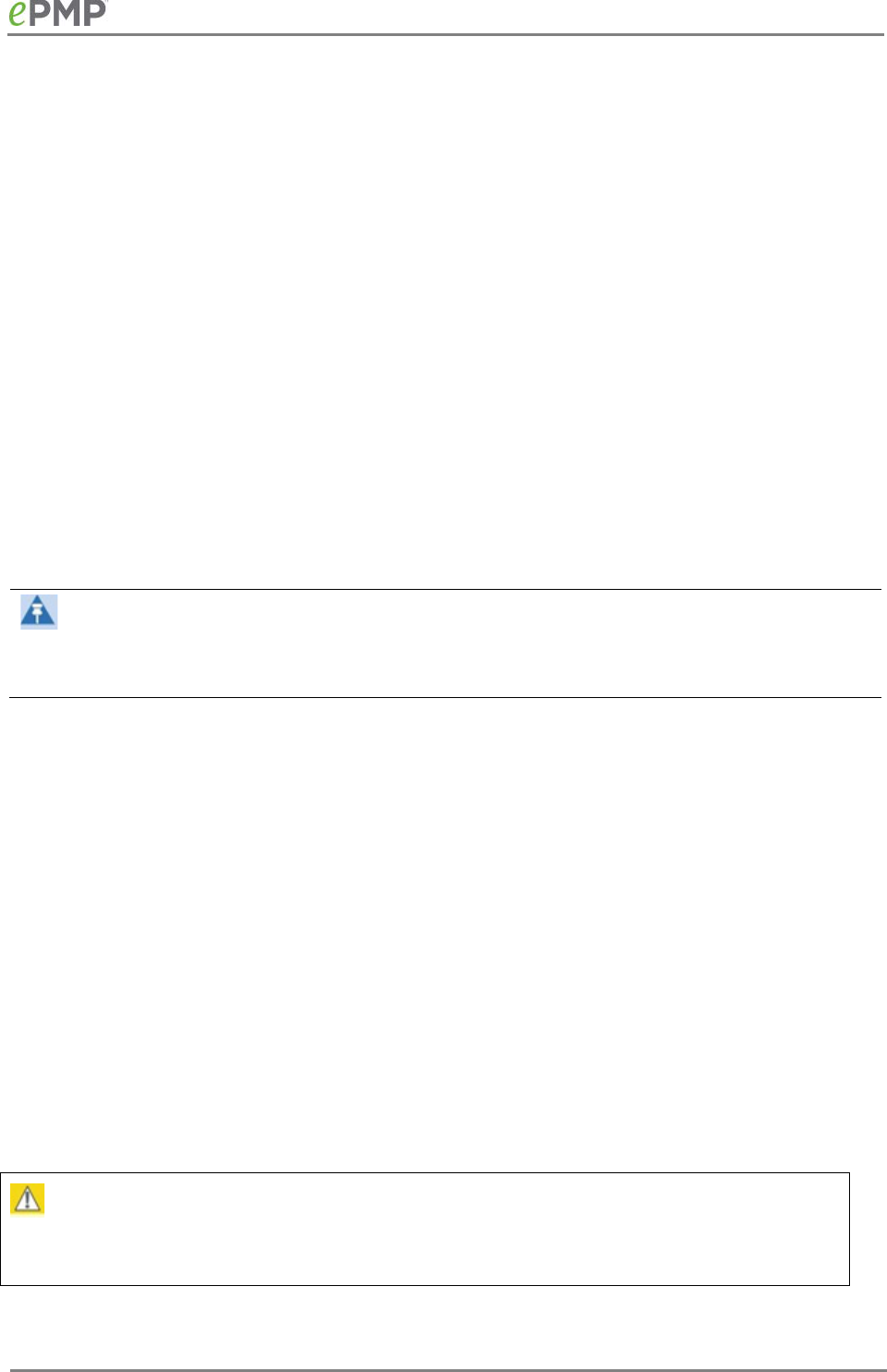
CAMBIUM NETWORKS
RADAR AVOIDANCE
In regions where protection of radars is part of the local regulations, the ePMP must detect
interference from radar-like systems and avoid co-channel operation with these systems.
To meet this requirement, the ePMP implements the following features:
• The equipment can only transmit on available channels, of which there are none at initial
power up. The radar detection algorithm will always scan a usable channel for 60 seconds for
radar interference before making the channel an available channel.
• This compulsory channel scan will mean that there is at least 60 seconds service outage every
time radar is detected and that the installation time is extended by at least 60 seconds even if
there is found to be no radar on the channel
There is a secondary requirement for bands requiring radar avoidance. Regulators have mandated
that products provide a uniform loading of the spectrum across all devices. In general, this
prevents operation with fixed frequency allocations. However:
• ETSI regulations do allow frequency planning of networks (as that has the same effect of
spreading the load across the spectrum).
• The FCC does allow channels to be avoided if there is actually interference on them.
Note
When operating in a region which requires DFS, ensure that the AP is configured with alternate
frequencies and that the STA is configured to scan for these frequencies to avoid long outages.
ENCRYPTION
The ePMP supports optional encryption for data transmitted over the wireless link. The encryption
algorithm used is the Advanced Encryption Standard (AES) with 128-bit key size. AES is a
symmetric encryption algorithm approved by U.S. Government organizations (and others) to
protect sensitive information.
COUNTRY CODES
Some aspects of wireless operation are controlled, enforced or restricted according to a country
code. ePMP country codes represent individual countries (for example Denmark) or regulatory
regions (for example FCC or ETSI).
Country codes affect the following aspects of wireless operation:
• Maximum transmit power
• Radar avoidance
• Frequency range
Caution
To avoid possible enforcement action by the country regulator, always operate links in
accordance with local regulations
22

CAMBIUM NETWORKS
PMP NETWORKS
Using frequency planning
Frequency planning is the exercise of assigning operating channels to PMP units so as to minimize
RF interference between links. Frequency planning must consider interference from any PMP unit
to any other PMP unit in the network. Low levels of interference normally allow for stable
operation and high link capacity.
The frequency planning task is made more straightforward by use of the following techniques:
• Using several different channels
• Separating units located on the same mast
• Configuring a 5 MHz guard band between adjacent sector operating band edges.
For help with planning networks, see
System planning
, or contact your Cambium distributor or re-
seller.
23

CAMBIUM NETWORKS
FURTHER READING ON WIRELESS OPERATION
For information on planning wireless operation, see:
•
Radio spectrum planning
on page
61
describes the regulatory restrictions that affect radio
spectrum usage, such as frequency range and radar avoidance.
•
Link planning
on page
65
describes factors to be taken into account when planning links, such
as range, path loss and data throughput.
•
Compliance with safety standards
on page
261
lists the safety specifications against which the
ePMP has been tested, and describes how to keep RF exposure within safe limits.
•
Compliance with radio regulations
on page
266
describes how the ePMP complies with the
radio regulations that are enforced in various countries.
•
Notifications
on page
278
refer to compliance with the radio regulations that are enforced in
various regions.
•
Data throughput tables
on page
287
contains tables and graphs to support calculation of the
data rate capacity that can be provided by ePMP configurations.
For information on configuring and operating the wireless link, see:
•
Configuration
on page
70
describes the configuration parameters of the ePMP devices
•
Operation and Troubleshooting
on page
197
describes post-installation procedures and
troubleshooting tips.
24

CAMBIUM NETWORKS
System management
This section introduces the ePMP management system, including the web interface, installation,
configuration, alerts and upgrades, and management software.
MANAGEMENT AGENT
ePMP equipment is managed through an embedded management agent. Management
workstations, network management systems or PCs can be connected to this agent using the
module’s Ethernet port or over-the air (STA).
The management agent supports the following interfaces:
• Hypertext Transfer Protocol (HTTP)
• Hypertext Transfer Protocol secure (HTTPs)
• Simple Network Management Protocol (SNMP)
• Network Time Protocol (NTP)
• System logging (Syslog)
• Cambium Network Services Server (CNSS) software
• Dynamic Host Configuration Protocol (DHCP)
WEB SERVER
The ePMP management agent contains a web server. The web server supports access via the
HTTP and HTTPs interfaces.
Web-based management offers a convenient way to manage the ePMP equipment from a locally
connected computer or from a network management workstation connected through a
management network, without requiring any special management software. The web-based
interfaces are the only interfaces supported for installation of ePMP, and for the majority of ePMP
configuration management tasks.
25
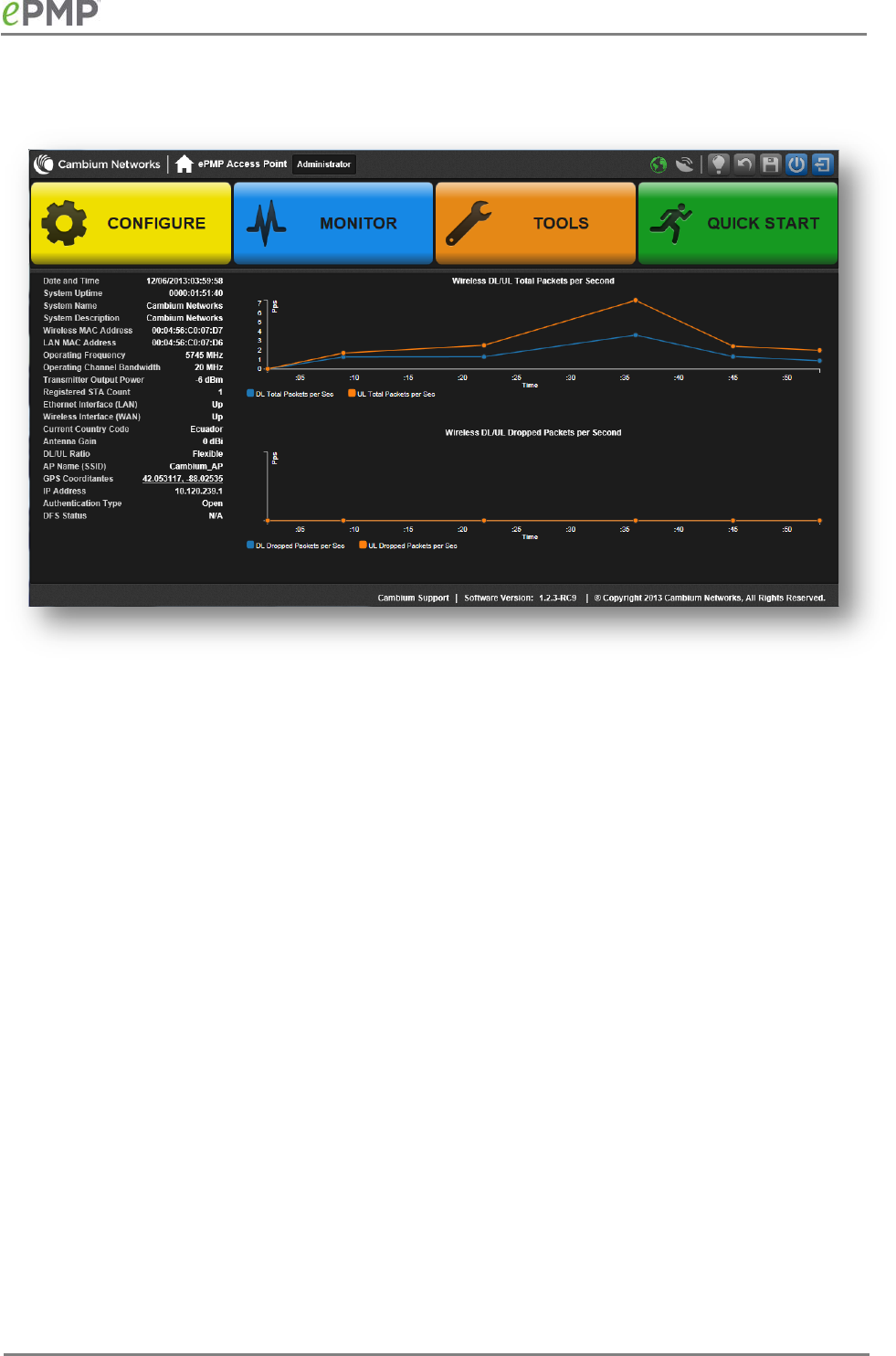
CAMBIUM NETWORKS
Figure 1
AP web-based management screenshot
Web pages
The web-based management interfaces provide comprehensive web-based fault, configuration,
performance and security management functions organized into the following web-pages and
groups:
Access Point and Station web-pages:
•
Dashboard:
The Dashboard web-page reports the general device status, session status,
remote subscriber status, event log information, and network interface status.
•
Configure:
The Configuration web-page may be utilized for configuring general device
parameters, as well as IP, radio, SNMP, Quality of Service (QoS), security, time, VLAN, protocol
filtering, and unit settings.
•
Monitor:
The Monitor web-page reports detailed operating statistics for the radio link and
network, and reports system log information.
•
Tools:
The Tools web-page offers useful tools for device installation, configuration, and
operation including software upgrade, backup/restore, spectrum analyzer, throughput test,
ping test, and traceroute.
•
Quick Start:
The Quick Start web-page provides quick access to requisite parameters for radio
link establishment and network access.
26

CAMBIUM NETWORKS
Identity-based user accounts
When identity-based user accounts are configured, a security officer can define from one to four
user accounts, each of which may have one of the four possible roles:
• ADMINISTRATOR (default username/password “admin”), who has full read and write
permission.
• INSTALLER (default username/password “installer”), who has permission to read and write
parameters applicable to unit installation and monitoring.
• HOME (default username/password “home”), who has permission only to access pertinent
information for support purposes
• READONLY (default username/password “readonly”), who has permission to only view the
Monitor page.
SNMP
The management agent supports fault and performance management by means of an SNMP
interface. The management agent is compatible with SNMP v2c using one Management
Information Base (MIB) file which is available for download from the Cambium Networks Support
website (
https://support.cambiumnetworks.com/files/epmp
).
NETWORK TIME PROTOCOL (NTP)
The clock supplies accurate date and time information to the system. It can be set to run with or
without a connection to a network time server (NTP). It can be configured to display local time by
setting the time zone and daylight saving in the Time web page.
If an NTP server connection is available, the clock can be set to synchronize with the server time at
regular intervals.
ePMP devices may receive NTP data from a CMM3 or CMM4 module or an NTP server configured
in the system’s management network.
The Time Zone option is configurable on the AP’s
Configure
,
System
page, and may be used to
offset the received NTP time to match the operator’s local time zone.
CAMBIUM NETWORK SERVICES SERVER
The Cambium Network Services Server (CNSS) may be used to monitor, configure, and upgrade
Cambium network equipment.
For Cambium Network Services Server download, see
https://support.cambiumnetworks.com/files/cnss
.
SOFTWARE UPGRADE
Software upgrades may be issued via the radio web interface (Tools, Software Upgrade) or via
CNSS (Cambium Networks Services Server).
For Software upgrades, see
https://support.cambiumnetworks.com/files/epmp
.
27

CAMBIUM NETWORKS
System hardware
This chapter describes the site planning and hardware components of an ePMP link.
The following topics are described in this chapter:
•
Site planning
on page
30
describes factors to be considered when planning the proposed
network.
•
Connectorized Module
on page
32
describes the connectorized module hardware, part
numbers, mounting equipment, and specifications.
•
Integrated Module
on page
40
describes the STA hardware, part numbers, mounting
equipment, and specifications.
•
Un-synced Connectorized Radio
on page
46
describes the hardware, part numbers, mounting
equipment, and specifications.
•
Power supply
on page
54
describes the power supply hardware, part numbers, and
specifications.
•
Connectorized module antennas and antenna cabling
on page
39
describes the AP antenna
and part numbers.
•
Ethernet cabling
on page
57
describes cable standards and lengths
•
Surge Suppression unit
on page
58
describes surge suppression requirements and
recommendations.
29
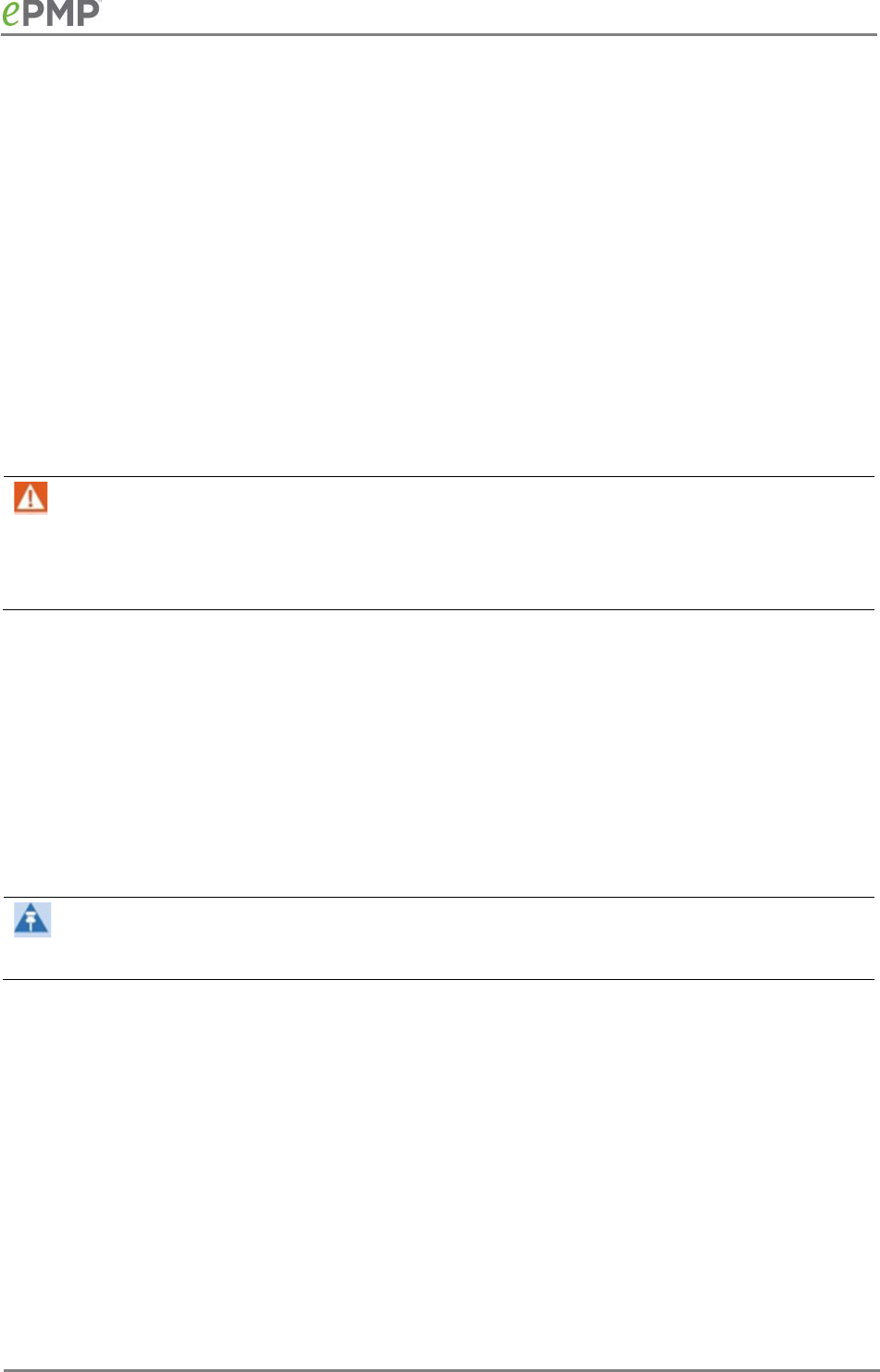
CAMBIUM NETWORKS
Site planning
Conduct a site survey to ensure that the proposed AP and STA sites meet the requirements
defined in this section.
SITE INSTALLATION
An ePMP site typically consists of a high supporting structure such as a mast, tower or building for
the AP or STA.
There is only one Ethernet interface, a copper Cat5e connection from the AP or STA to the AP/STA
power supply and network terminating equipment. If a 1000 Base-TX (Gigabit) Ethernet
connection is required at the AP, ensure that power supply N000900L001A is utilized.
GROUNDING AND LIGHTNING PROTECTION
Warning
Electro-magnetic discharge (lightning) damage is not covered under warranty. The
recommendations in this guide, when followed correctly, give the user the best protection from
the harmful effects of EMD. However 100% protection is neither implied nor possible.
Structures, equipment and people must be protected against power surges (typically caused by
lightning) by conducting the surge current to ground via a separate preferential solid path. The
actual degree of protection required depends on local conditions and applicable local regulations.
To adequately protect an ePMP installation, both ground bonding and transient voltage surge
suppression are required.
Full details of lightning protection methods and requirements can be found in the international
standards IEC 61024-1 and IEC 61312-1, the U.S. National Electric Code ANSI/NFPA No. 70-1984 or
section 54 of the Canadian Electric Code.
Note
International and national standards take precedence over the requirements in this guide.
30
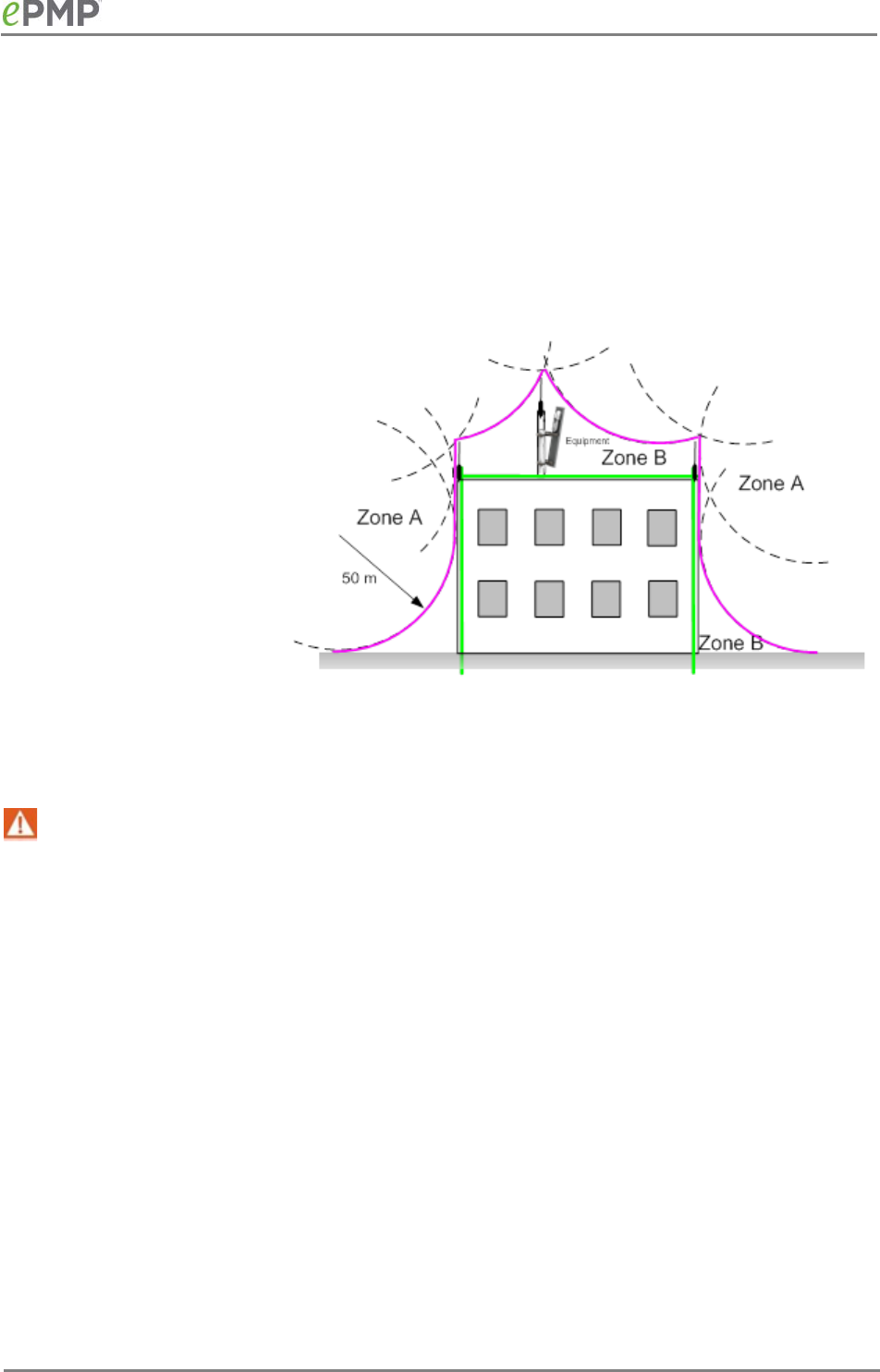
CAMBIUM NETWORKS
LIGHTNING PROTECTION ZONES
Use the rolling sphere method (
Figure 2
) to determine where it is safe to mount equipment. An
imaginary sphere, typically 50 meters in radius, is rolled over the structure. Where the sphere rests
against the ground and a strike termination device (such as a finial or ground bar), all the space
under the sphere is considered to be in the zone of protection (Zone B). Similarly, where the
sphere rests on two finials, the space under the sphere is considered to be in the zone of
protection.
Figure 2
Rolling sphere method to determine the lightning protection zones
Assess locations on masts,
towers and buildings to
determine if the location is in
Zone A or Zone B:
•
Zone A
: In this zone a
direct lightning strike is
possible. Do not mount
equipment in this zone.
•
Zone B
: In this zone, direct
EMD (lightning) effects are
still possible, but
mounting in this zone
significantly reduces the
possibility of a direct
strike. Mount equipment in
this zone.
Warning
Never mount equipment in Zone A. Mounting in Zone A may put equipment, structures and life at
risk.
31
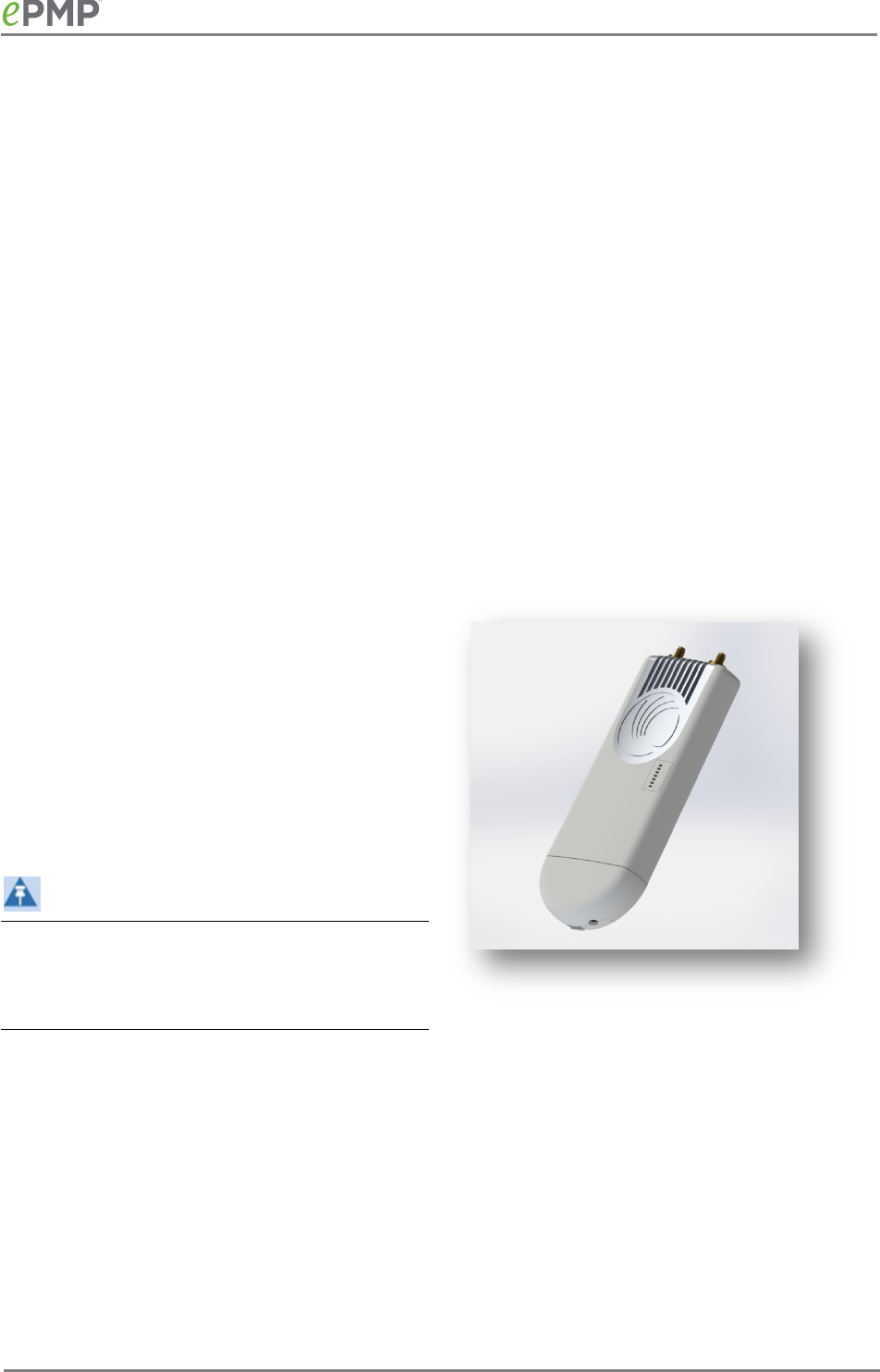
CAMBIUM NETWORKS
Connectorized Module
For details of the ePMP connectorized hardware, see:
•
Connectorized Module description
on page
32
•
Connectorized part numbers
on page
33
•
Connectorized Module interfaces
on page
34
•
Connectorized Module specifications
on page
36
•
Connectorized Module and external antenna location
on page
37
•
Connectorized Module wind loading
on page
38
•
Connectorized Module software packages
on page
38
•
Connectorized module antennas and antenna cabling
on page
39
CONNECTORIZED MODULE DESCRIPTION
The connectorized ePMP device is a self-
contained transceiver unit that houses both
radio and networking electronics. The
connectorized unit is designed to work with
externally mounted antennas that have high
gains. Connectorized units can cope with more
difficult radio conditions. The unit is designed
with female RP-SMA 50Ω antenna connections
located at the top of the unit. An ePMP
connectorized unit may function as an Access
Point (AP) or a Station (STA) in a Point-To-
Multipoint (PMP) or in a Point-To-Point (PTP)
network topology.
Note
To select antennas, RF cables and connectors
for connectorized units, see
Connectorized
module antennas and
antenna cabling
on page
39
.
Figure 3
ePMP Series Connectorized Radio with
Sync
32

CAMBIUM NETWORKS
CONNECTORIZED PART NUMBERS
Choose the correct regional variant: one is for use in regions where FCC or IC licensing restrictions
apply (FCC/IC), and the other is for use in ETSI countries or non-FCC/IC/ETSI-restricted regions.
Each of the parts listed in
Table 2
includes the following items:
• One connectorized unit
• One power supply 1000/100/10 Base-TX LAN injector
The GPS-capable parts listed in
Table 2
also ship with a GPS antenna.
Table 2
Connectorized part numbers
Cambium description
Cambium part number
ePMP GPS, Conn - 5 GHz - no power cord C050900A011A
ePMP GPS, Conn - 5 GHz - US power cord - FCC version C058900A112A
ePMP Conn - 5 GHz - no power cord C050900A021A
ePMP Conn - 5 GHz - US power cord - FCC version C058900A122A
ePMP GPS, Conn - 2.4 GHz - US power cord C024900A011A
Table 3
AP accessory part numbers
Cambium description
Cambium part number
ePMP Power Supply for GPS Radio - no cord (spare) N000900L001A
ePMP Power Supply for non-GPS Radio - no cord (spare) N000900L002A
CONNECTORIZED MODULE MOUNTING BRACKET
The connectorized unit is designed to be attached to a Cambium ePMP sector antenna (see
Table
10
). The Cambium ePMP sector antenna contains all of the mounting brackets, antenna cabling,
and GPS antenna mounting for device deployment.
33
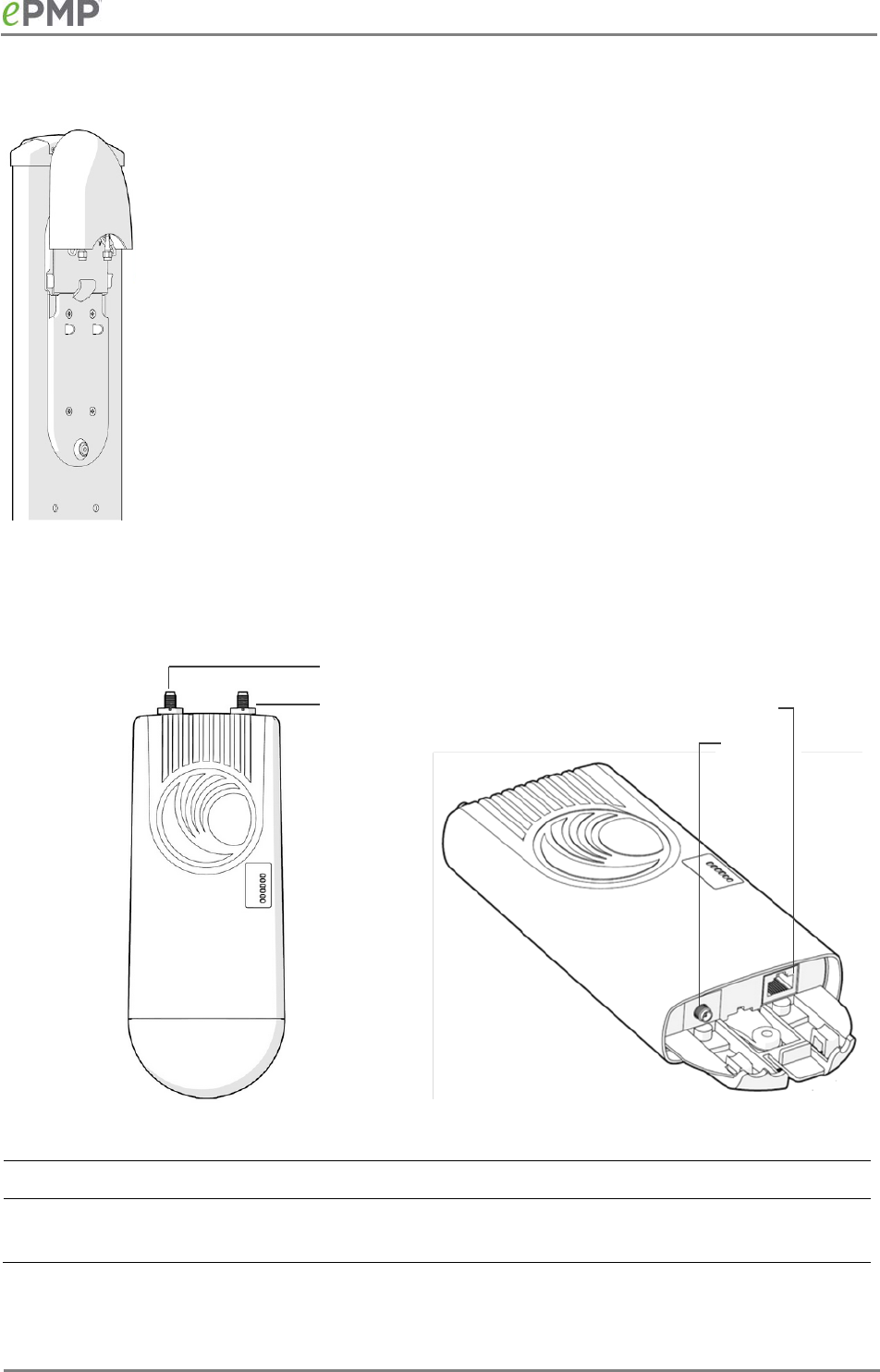
CAMBIUM NETWORKS
Figure 4
Connectorized module sector antenna
CONNECTORIZED MODULE INTERFACES
The connectorized module interfaces are illustrated in
Figure 5
and described in
Table 4
.
Figure 5
Connectorized module interfaces
Table 4
Connectorized module interfaces
Name
Connector
Interface
Description
Antenna
port H RP-SMA, female Antenna,
H polarization To/from H polarized antenna port
Antenna port V
Antenna port H
ETH
GPS
34
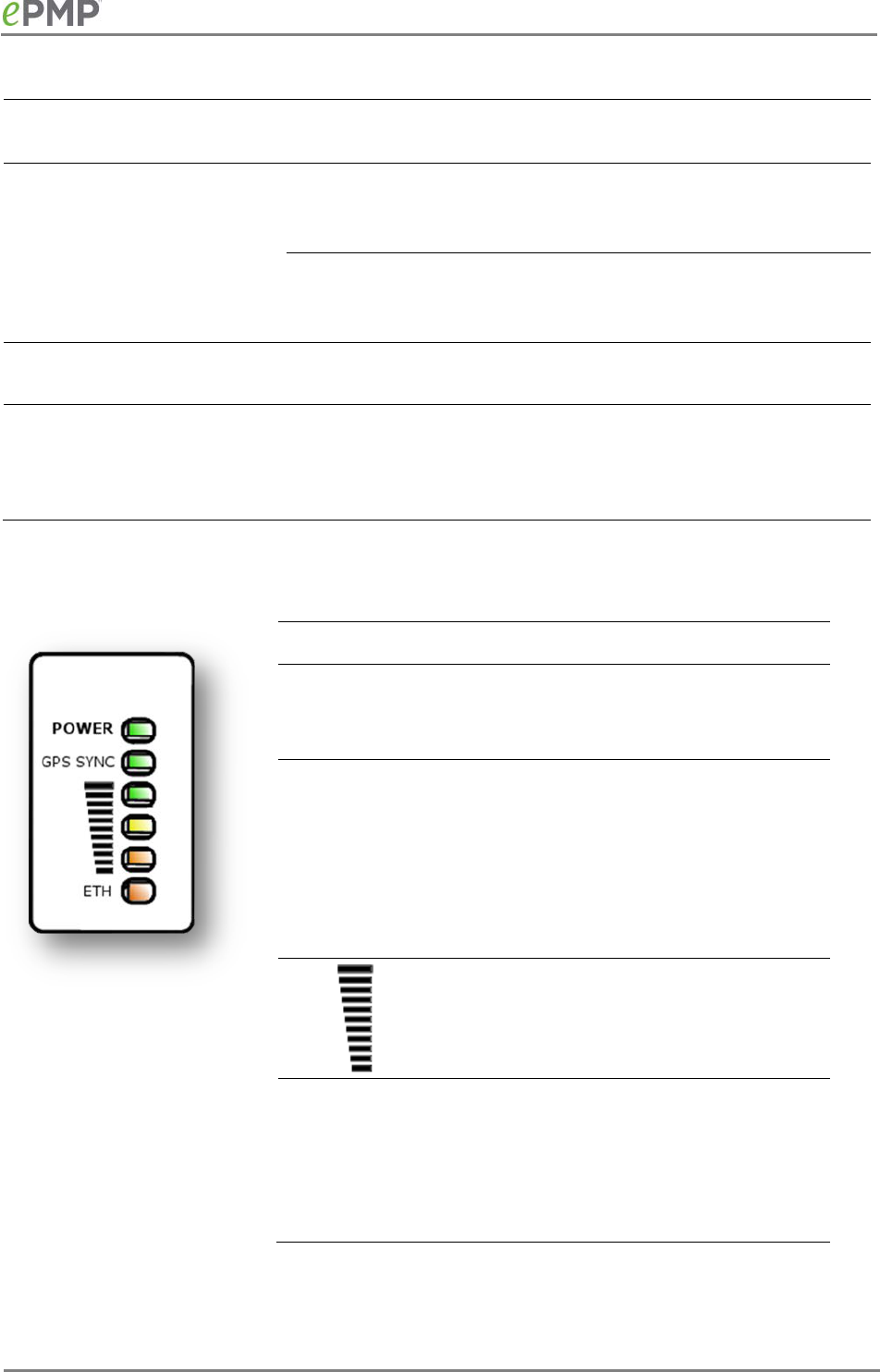
CAMBIUM NETWORKS
Antenna
port V RP-SMA, female Antenna,
V polarization To/from V polarized antenna port
ETH RJ45
PoE input
802.3af PoE Standard, as well as Proprietary
power over Ethernet (PoE) twisted pair (for
powering via CMM3/CMM4)
10/100/1000
Base-TX
Ethernet
Management and data
GPS SMA, female Antenna, GPS To/from GPS antenna
Reset
Button Physical button N/A
For resetting the radio and for setting the radio
back to its factory default configuration. See
Using the device external reset button
on page
206
.
CONNECTORIZED MODULE LEDS
LED
Function
POWER
Green: Power is applied to the device
Unlit: No power is applied to the device or
improper power source
GPS SYNC Orange: AP has acquired a 1PPS GPS
synchronization pulse either from the
internal GPS module and antenna or from
a connected CMM
Unlit: 1PPS GPS not acquired, or
Synchronization Source
set to
Internal
(AP
generating sync, not GPS-based)
Reserved for future release
ETH Once lit, blinking indicates Ethernet activity
Red: 10BaseTX link
Green: 100BaseTX link
Orange: 1000BaseTX link
Unlit: No Ethernet link established
35

CAMBIUM NETWORKS
CONNECTORIZED MODULE SPECIFICATIONS
The ePMP connectorized module conforms to the specifications listed in
Table 5
and
Table 6
.
The connectorized meets the low level static discharge specifications identified in
Electromagnetic
compatibility (EMC) compliance
on page
261
and provides internal surge suppression but does not
provide lightning suppression.
For a full listing of connectorized radio specifications, see
Connectorized Radio Specifications
on
page
288
.
Table 5
Connectorized module physical specifications
Category
Specification
Dimensions (H x W x D) Radio: 227 x 88 x 33 mm (8.9” x 3.5” x 1.3”)
Antenna: 529 x 124 x 53 mm (20.8” x 4.9” x 2.1”)
Weight .521 kg (1.15 lbs) without antenna
4.5 kg (10 lbs) with antenna
Table 6
Connectorized module environmental specifications
Category
Specification
Temperature -30°C (-22°F) to +55°C (131°F)
Wind loading 118 mph (190 kph) maximum. See Connectorized Module
wind loading on page 38 for a full description.
Humidity 95% condensing
Environmental IP55
36

CAMBIUM NETWORKS
CONNECTORIZED MODULE HEATER
Upon power on, if the ePMP connectorized module temperature is at or below 32° F (0° C), an
internal heater is activated to ensure that the device is able to successfully begin operation. The
unit’s heater is only activated when the unit is powered on, and will not apply heat to the device
once startup is complete. When the unit temperature is greater than 32° F (0° C), the heater is
deactivated and the unit continues its startup sequence.
The effect on device startup time at various temperatures is defined in
Table 7
.
Table 7
Connectorized module startup times based on ambient temperature
Initial
Temperature
Startup time (from power on to operational)
-22° F (-30° C) 20 minutes
-4° F (-20° C) 6 minutes
14° F (-10° C) 2 minutes, 30 seconds
CONNECTORIZED MODULE AND EXTERNAL ANTENNA LOCATION
Find a location for the device and external antenna that meets the following requirements:
• The equipment is high enough to achieve the best radio path.
• People can be kept a safe distance away from the equipment when it is radiating. The safe
separation distances are defined in
Calculated distances and power compliance margins
on
page
263
.
• The equipment is lower than the top of the supporting structure (tower, mast or building) or its
lightning air terminal.
• The location is not subject to excessive wind loading. For more information, see
Connectorized
Module wind loading
on page
38
.
37

CAMBIUM NETWORKS
CONNECTORIZED MODULE WIND LOADING
Ensure that the device and the structure on which it is mounted are capable of withstanding the
prevalent wind speeds at a proposed ePMP site. Wind speed statistics is available from national
meteorological offices.
The device and its mounting bracket are capable of withstanding wind speeds of up to 190 kph
(118 mph).
Wind blowing on the device will subject the mounting structure to significant lateral force. The
magnitude of the force depends on both wind strength and surface area of the device. Wind
loading is estimated using the following formulae:
Force (in kilograms) = 0.1045aV2
Where:
Is:
a surface area in square meters
V wind speed in meters per second
Force (in pounds) = 0.0042Av2
Where:
Is:
A
surface area in square feet
v
wind speed in miles per hour
Applying these formulae to the ePMP device at different wind speeds, the resulting wind loadings
are shown in
Table 8
and
Table 9
.
Table 8
Connectorized module wind loading (Kg)
Type of ePMP
device
Largest
surface area
(square meters)
Wind speed (meters per second)
30
40
50
60
70
Connectorized 0.13 12.2 Kg 21.7 Kg 34 Kg 49 Kg 66.6 Kg
Table 9
Connectorized module wind loading (lb)
Type of ePMP
device
Largest
surface area
(square feet)
Wind speed (miles per hour)
80
100
120
140
150
Connectorized 1.39 37.4 lb 58.4 lb 84.1 lb 114.4 lb 131.4 lb
CONNECTORIZED MODULE SOFTWARE PACKAGES
Connectorized radios may be upgraded by downloading new software packages from the
Cambium Networks website or by using the Cambium Network Services Server. The software
packages applicable to ePMP connectorized radios are named:
• ePMP-GPS_Synced-v1.4.3.tar.gz
38
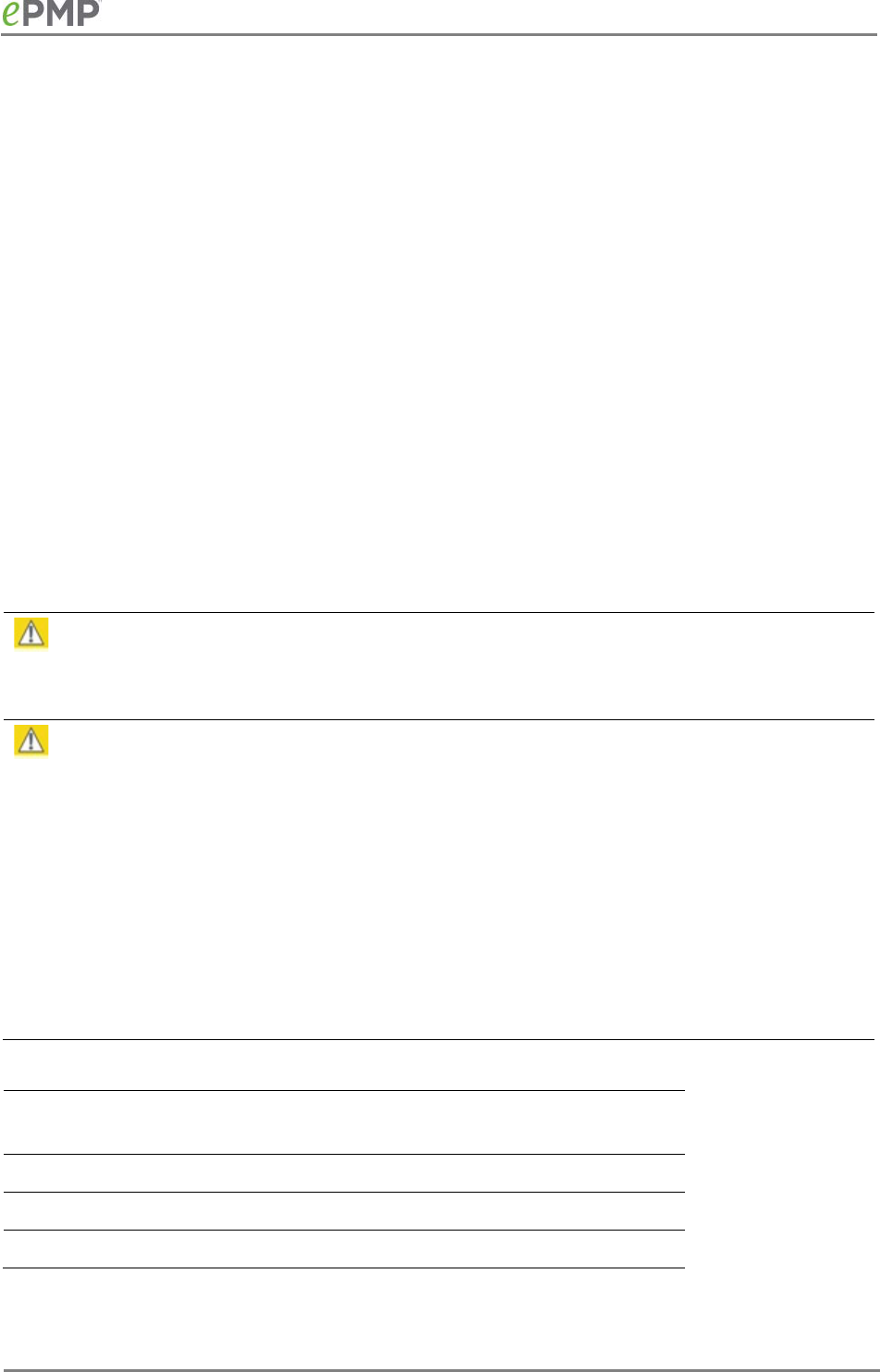
CAMBIUM NETWORKS
Connectorized module antennas and antenna cabling
Connectorized modules require external antennas connected using RF cable (included with
Cambium ePMP sector antennas). For details of the antennas and accessories required for a
connectorized ePMP installation, see:
•
Antenna requirements
on page
39
•
FCC and IC approved antennas
on page
39
ANTENNA REQUIREMENTS
For connectorized units operating in the USA or Canada 2.4 GHz, 5.4 GHz or 5.8 GHz bands, choose
external antennas from those listed in
FCC and IC approved antennas
on page
39
. For installations
in other countries, the listed antennas are advisory, not mandatory.
FCC AND IC APPROVED ANTENNAS
For connectorized units operating in the USA or Canada, choose external antennas from
Table 10
.
These are approved by the FCC for use with the product and are constrained by the following
limits:
• 5 GHz – 15 dBi gain
• 2.4 GHz - 15 dBi gain
Caution
Using other than approved antennas may cause measurements higher than reported for
certification.
Caution
This radio transmitter (IC certification number 109W-0005) has been approved by Industry
Canada to operate with the antenna types listed below with the maximum permissible gain and
required antenna impedance for each antenna type indicated. Antenna types not included in this
list, having a gain greater than the maximum gain indicated for that type, are strictly prohibited
for use with this device.
Le présent émetteur radio (Numéro de certification IC 109W-0005) a été approuvé par Industrie
Canada pour fonctionner avec les types d'antenne énumérés ci-dessous et ayant un gain
admissible maximal et l'impédance requise pour chaque type d'antenne. Les types d'antenne
non inclus dans cette liste, ou dont le gain est supérieur au gain maximal indiqué, sont
strictement interdits pour l'exploitation de l'émetteur.
Table 10
Allowed antennas for deployment in USA/Canada
Cambium part
number
Antenna Type
Gain (dBi)
C050900D003A 5 GHz Sector Antenna – 90 degree 15
C050900D002A 5 GHz Sector Antenna – 120 degree 15
C024900D004A 2.4 GHz Sector Antenna - 90 /120 degree 15
39
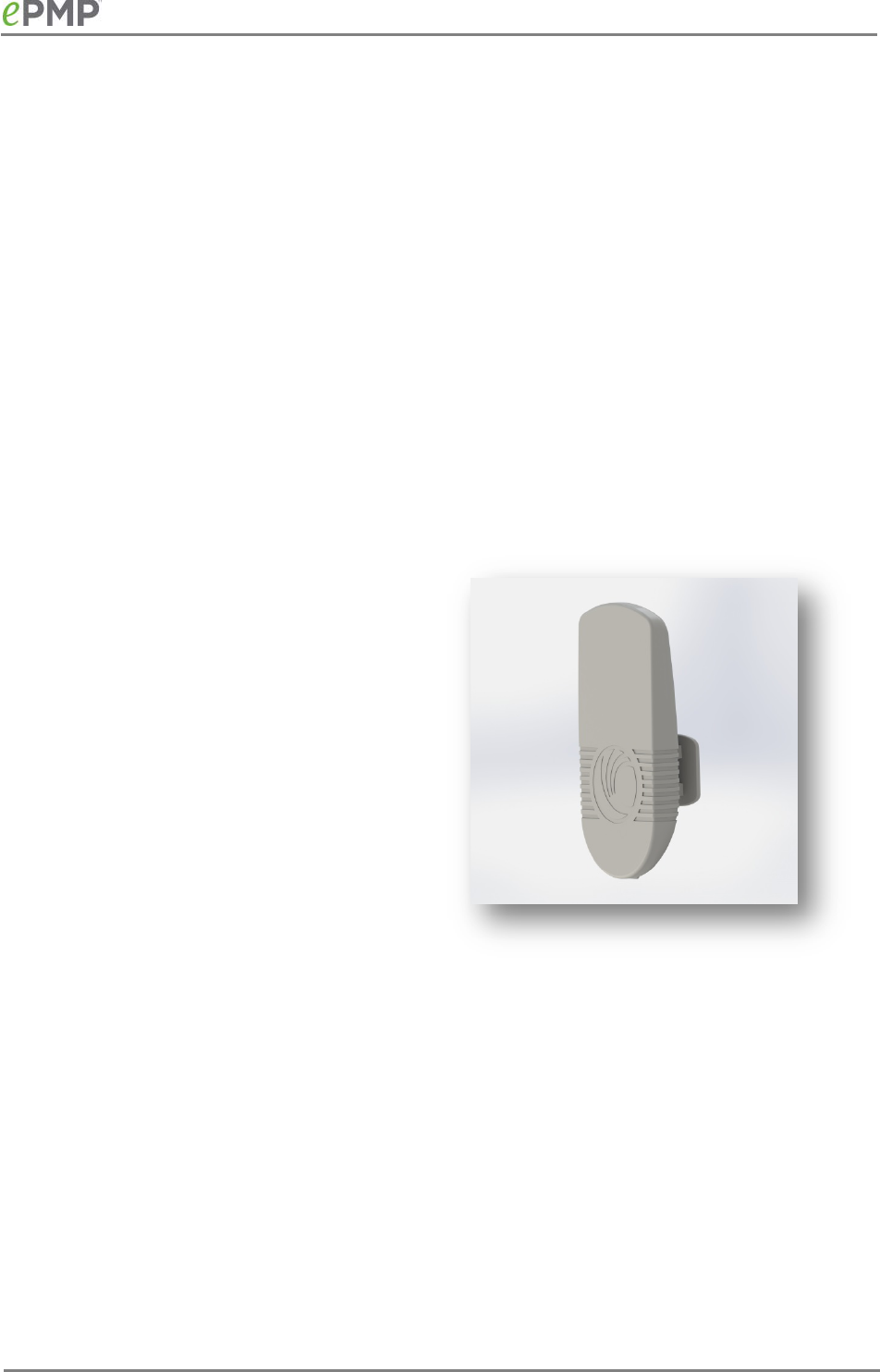
CAMBIUM NETWORKS
Integrated Module
For details of the ePMP integrated hardware, see:
•
Integrated Module description
on page
40
•
Integrated Module part numbers
on page
41
•
Integrated Module mounting bracket
on page
41
•
Integrated Module interfaces
on page
42
•
Integrated Module specifications
on page
43
•
Integrated Module heater
on page
44
•
Integrated Module wind loading
on page
44
•
Integrated Module software packages
on page
45
.
INTEGRATED MODULE DESCRIPTION
The integrated module is a self-contained
transceiver unit that houses both radio and
networking electronics. An ePMP integrated unit
may function as an Access Point (AP) or a
Station (STA) in a Point-To-Multipoint (PMP) or
in a Point-To-Point (PTP) network topology.
Figure 6
ePMP Series Integrated Radio
40
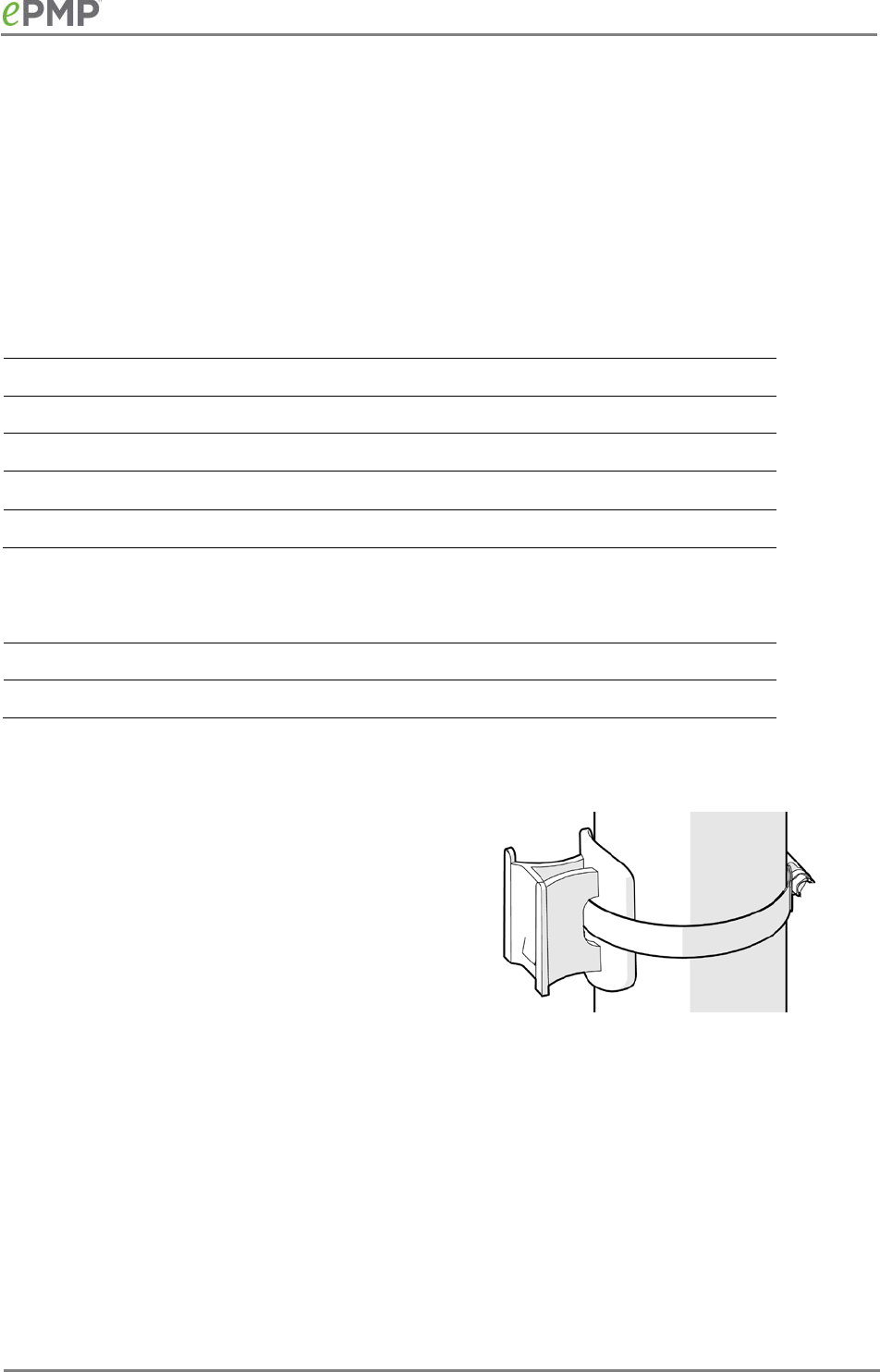
CAMBIUM NETWORKS
INTEGRATED MODULE PART NUMBERS
Choose the correct regional variant: one is for use in regions where FCC or IC licensing restrictions
apply (FCC/IC), and the other is for use in ETSI countries or the rest of the world (ETSI/RoW).
Each of the parts listed in
Table 11
includes the following items:
• One integrated module (with mounting bracket)
• One metal mounting strap
Table 11
Integrated module part numbers
Cambium description
Cambium part number
ePMP Integrated – 5 GHz – no power cord C050900C031A
ePMP Integrated – 5 GHz – US power cord – FCC version C058900C132A
ePMP Integrated – 5 GHz – EU power cord C050900P033A
ePMP Integrated - 2.4 GHz - US power cord C024900C031A
Table 12
Integrated module accessory part numbers
Cambium description
Cambium part number
ePMP Power Supply for non-GPS Radio - no cord (spare) N000900L002A
INTEGRATED MODULE MOUNTING BRACKET
The integrated module is designed to be pole-
mounted for use with a non-Cambium antenna.
Order integrated module mounting brackets
from Cambium Networks.
Figure 7
Integrated module mounting bracket
41
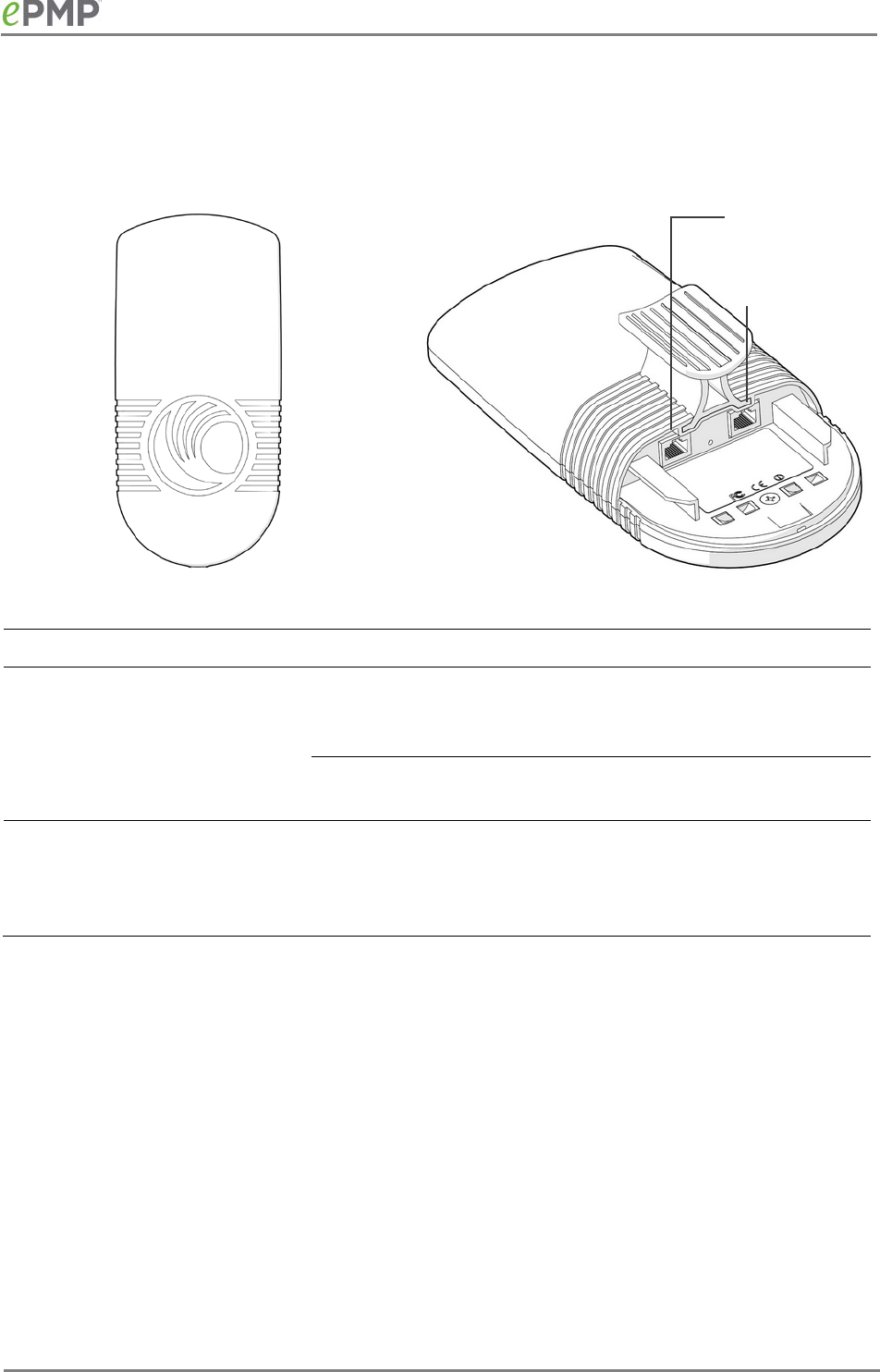
CAMBIUM NETWORKS
INTEGRATED MODULE INTERFACES
The integrated module interfaces are illustrated in
Figure 8
and described in
Table 13
.
Figure 8
Integrated module interfaces
Table 13
Integrated module interfaces
Port name
Connector
Interface
Description
Primary Ethernet RJ45
PoE input
Proprietary power over Ethernet (PoE)
twisted pair (for powering via
CMM3/CMM4)
10/100 Base-TX
Ethernet Management and data
Auxiliary
Ethernet (future
release)
RJ45
Cambium
proprietary PoE
output, data
bridging
Proprietary 30V PoE
output for
auxiliary devices (not 802.3af standard
PoE)
Auxiliary
Ethernet
Primary
Ethernet
42
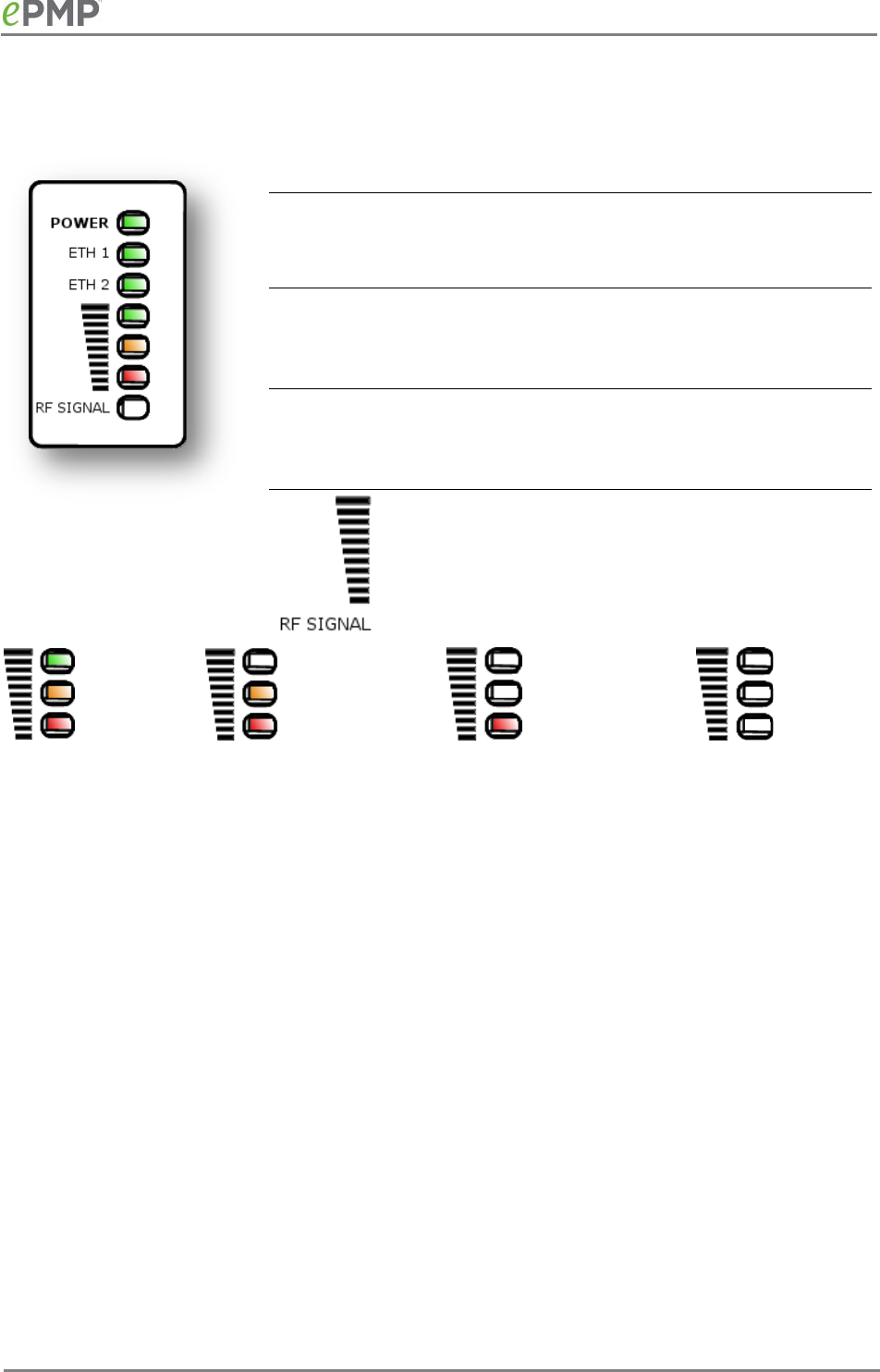
CAMBIUM NETWORKS
INTEGRATED MODULE LEDS
LED
Function
POWER
Green: Power is applied to the device
Unlit: No power is applied to the device or improper
power source
ETH 1
Main/Primary Ethernet port indicator
Once lit, blinking indicates Ethernet activity
Green: 10/100BaseTX link
ETH 2
Auxiliary/Secondary Ethernet port indicator
Once lit, blinking indicates Ethernet activity
Green: 10/100BaseTX link
Radio scanning: LEDs light in an ascending
sequence to indicate that the radio is scanning
Radio registered: LEDs light to indicate the RSSI
level at the device.
RSSI
> -60
dBm
-70 dBm
< RSSI
≤
≤
-60 dBm
-80 dBm
< RSSI
≤
-70 dBm
RSSI
≤
-80
dBm
INTEGRATED MODULE SPECIFICATIONS
The ePMP integrated module conforms to the specifications listed in
Table 14
and
Table 15
.
The integrated device meets the low level static discharge specifications identified in
Electromagnetic compatibility (EMC) compliance
on page
261
and provides internal surge
suppression but does not provide lightning suppression.
For a full listing of integrated radio specifications, see Error! Reference source not found. on page
Error! Bookmark not defined..
43

CAMBIUM NETWORKS
Table 14
Integrated module physical specifications
Category
Specification
Dimensions (H x W x D) Radio: 29.1 x 14.5 x 8.3 cm (11.4 x 5.7 x 3.3 in)
Weight 0.49 kg (1.1 lbs)
Table 15
Integrated module environmental specifications
Category
Specification
Temperature -30°C (-22°F) to +60°C (131°F)
Wind loading 90 mph (145 kph) maximum. See
Integrated Module wind
loading
on page
44
for a full description.
Humidity 95% condensing
Environmental IP55
INTEGRATED MODULE HEATER
Upon power on, if the ePMP integrated module device temperature is at or below 32° F (0° C), an
internal heater is activated to ensure that the device is able to successfully begin operation. The
unit’s heater is only activated when the unit is powered on, and will not apply heat to the device
once startup is complete. When the unit temperature is greater than 32° F (0° C), the heater is
deactivated and the integrated module continues its startup sequence.
The effect on integrated module startup time at various temperatures is defined in
Table 16
.
Table 16
Integrated module startup times based on ambient temperature
Initial
Temperature
Startup time (from power on to operational)
-22° F (-30° C) 4 minutes
-4° F (-20° C) 2 minutes
14° F (-10° C) 1 minutes, 30 seconds
INTEGRATED MODULE WIND LOADING
Ensure that the integrated module and the structure on which it is mounted are capable of
withstanding the prevalent wind speeds at a proposed ePMP site. Wind speed statistics must be
available from national meteorological offices.
The integrated module and its mounting bracket are capable of withstanding wind speeds of up to
145 kph (90 mph).
44

CAMBIUM NETWORKS
Wind blowing on the integrated module will subject the mounting structure to significant lateral
force. The magnitude of the force depends on both wind strength and surface area of the
integrated module. Wind loading is estimated using the following formulae:
Force (in kilograms) = 0.1045aV2
Where:
Is:
a surface area in square meters
V wind speed in meters per second
Force (in pounds) = 0.0042Av2
Where:
Is:
A
surface area in square feet
v
wind speed in miles per hour
Applying these formulae to the ePMP integrated module at different wind speeds, the resulting
wind loadings are shown in
Table 17
and
Table 18
.
Table 17
Integrated module wind loading (Kg)
Type of ePMP
module
Largest
surface area
(square meters)
Wind speed (meters per second)
30
40
50
60
70
Integrated 0.042 4 Kg 7 Kg 11 Kg 15.8 Kg 21.6 Kg
Table 18
Integrated module wind loading (lb)
Type of ePMP
module
Largest surface
area (square feet)
Wind speed (miles per hour)
80
100
120
140
150
Integrated 0.45 12.1 lb 18.9 lb 27.2 lb 37 lb 42.5 lb
INTEGRATED MODULE SOFTWARE PACKAGES
Integrated radios may be upgraded by downloading new software packages from the Cambium
Networks website or by using the Cambium Network Services Server. The software packages
applicable to ePMP integrated radios are named:
• ePMP-NonGPS_Synced-v1.4.3.tar.gz
45
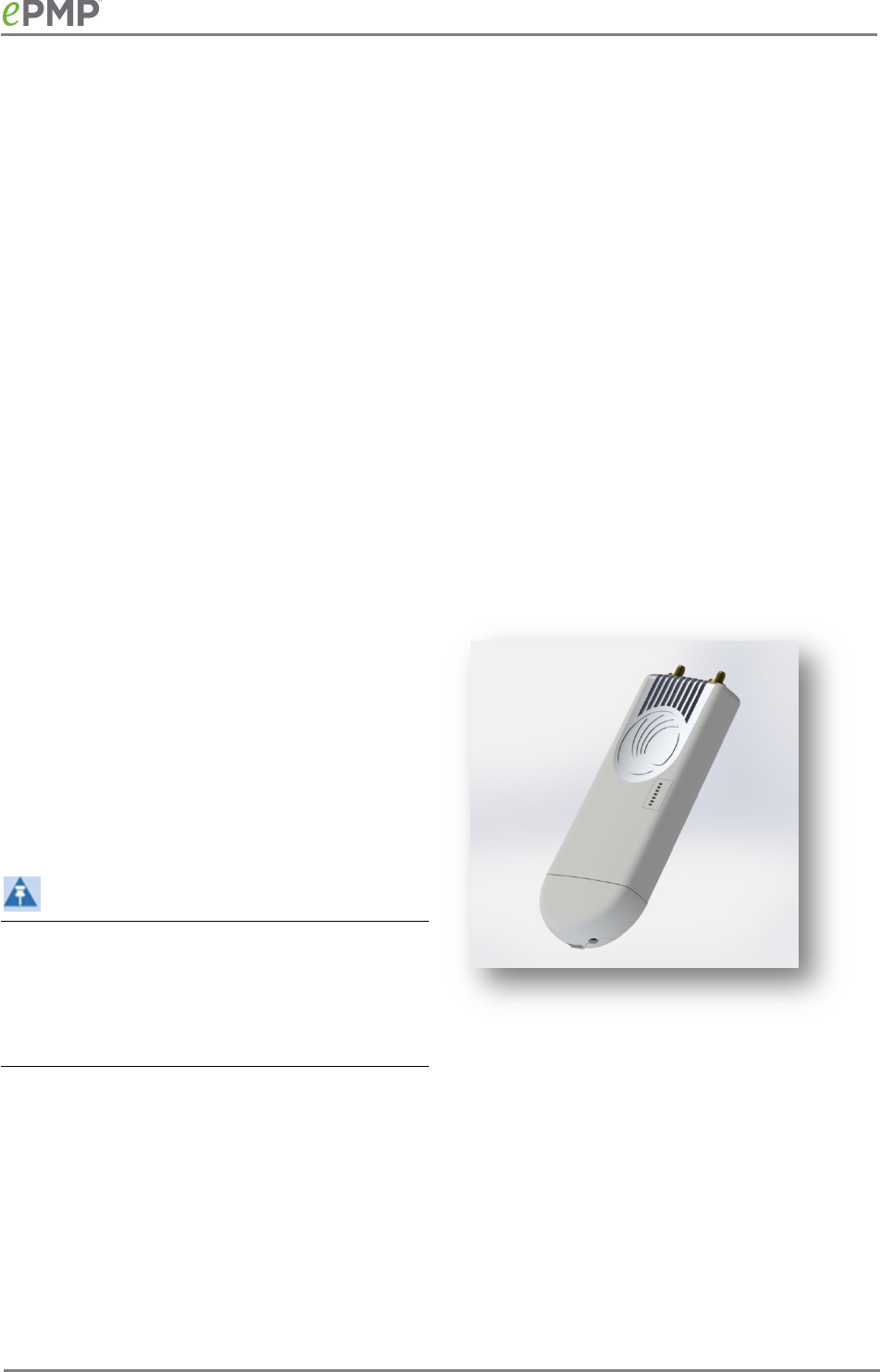
CAMBIUM NETWORKS
Un-synced Connectorized Radio
For details of the ePMP connectorized hardware, see the following:
•
Un-synced Connectorized Radio description
on page
46
•
Un-synced Connectorized Radio part numbers
on page
47
•
Un-synced Connectorized Radio Interfaces
on page
48
•
Un-synced Connectorized Radio specifications
on page
50
•
Un-synced Connectorized Radio and external antenna location
on page
51
•
Un-synced connectorized Radio wind loading
on page
52
•
Un-synced Connectorized Radio software packages
on page
53
•
Un-synced connectorized radio antennas and antenna cabling
on page
53
UN-SYNCED CONNECTORIZED RADIO DESCRIPTION
The connectorized ePMP device is a self-
contained transceiver unit that houses both
radio and networking electronics. The
connectorized unit is designed to work with
externally mounted antennas that have high
gains. Connectorized units can cope with more
difficult radio conditions. The unit is designed
with female RP-SMA 50Ω antenna connections
located at the top of the unit. An ePMP
connectorized unit may function as an Access
Point (AP) or a Station (STA) in a Point-To-
Multipoint (PMP) or in a Point-To-Point (PTP)
network topology.
Note
To select antennas, RF cables and connectors
for connectorized units, see
Un-synced connectorized radio antennas and
antenna
cabling on page
53
.
Figure 9
ePMP Series Un-synced Connectorized
Radio
46
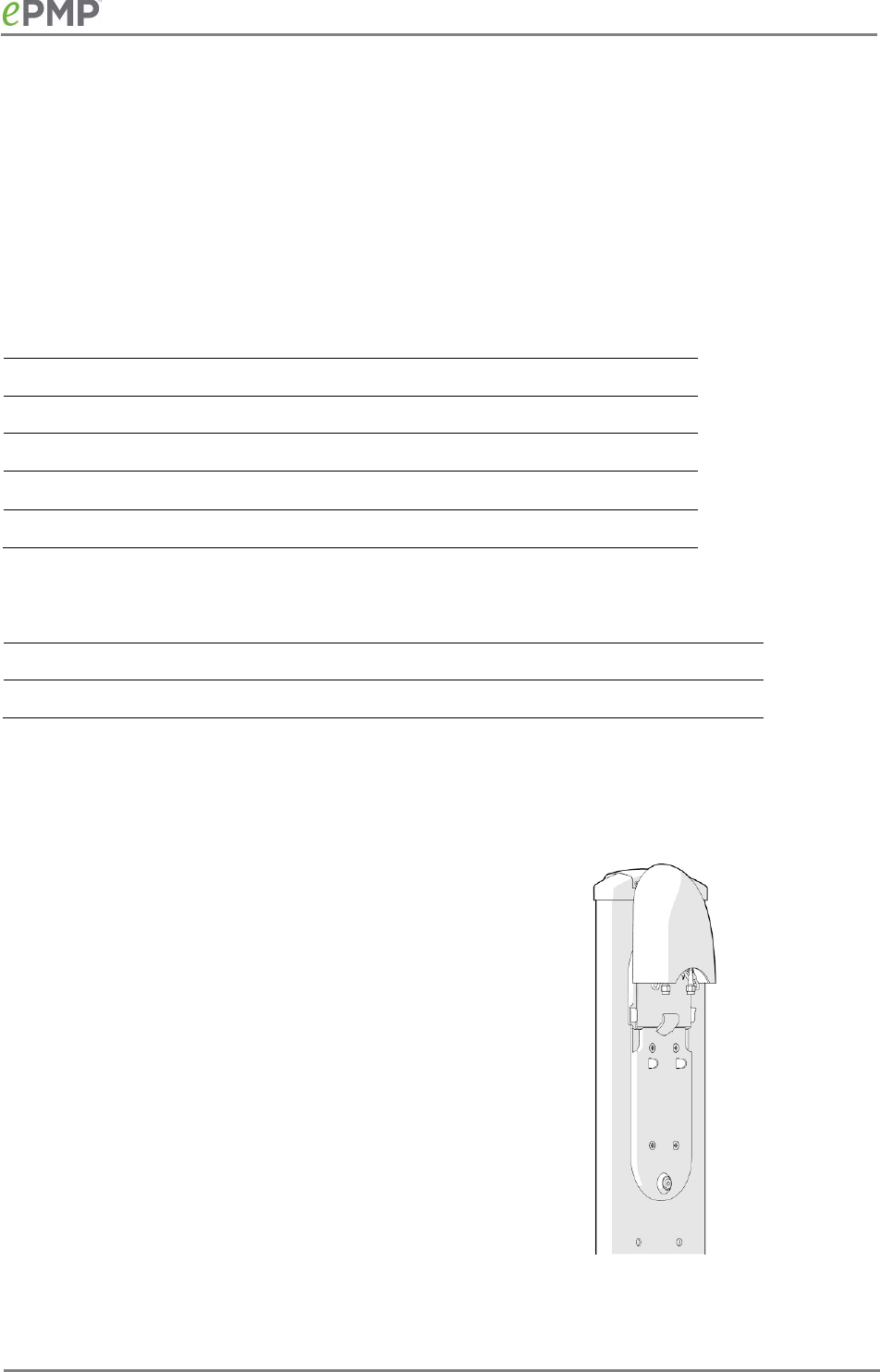
CAMBIUM NETWORKS
UN-SYNCED CONNECTORIZED RADIO PART NUMBERS
Choose the correct regional variant: one is for use in regions where FCC or IC licensing restrictions
apply (FCC/IC), and the other is for use in ETSI countries or non-FCC/IC/ETSI-restricted regions.
Each of the parts listed in
Table 19
includes the following items:
• One connectorized unit
• One power supply 100/10 Base-TX LAN injector
Table 19
Un-synced
Connectorized Radio part numbers
Cambium description
Cambium part number
ePMP 1000: 5 GHz Connectorized Radio (EU) C050900A023A
ePMP 1000: 5 GHz Connectorized Radio (FCC) C058900A122A
ePMP 1000: 5 GHz Connectorized Radio (ROW) C050900A021A
ePMP 1000: 2.4 GHz Connectorized Radio C024900A021A
Table 20
AP accessory part numbers
Cambium description
Cambium part number
ePMP Power Supply for non-GPS Radio - no cord (spare) N000900L002A
UN-SYNCED CONNECTORIZED RADIO MOUNTING BRACKET
The unsynced connectorized unit is designed to
be attached to a Cambium ePMP sector antenna
or with a non-Cambium antenna.
Figure 10
Un-synced connectorized radio sector
antenna
47
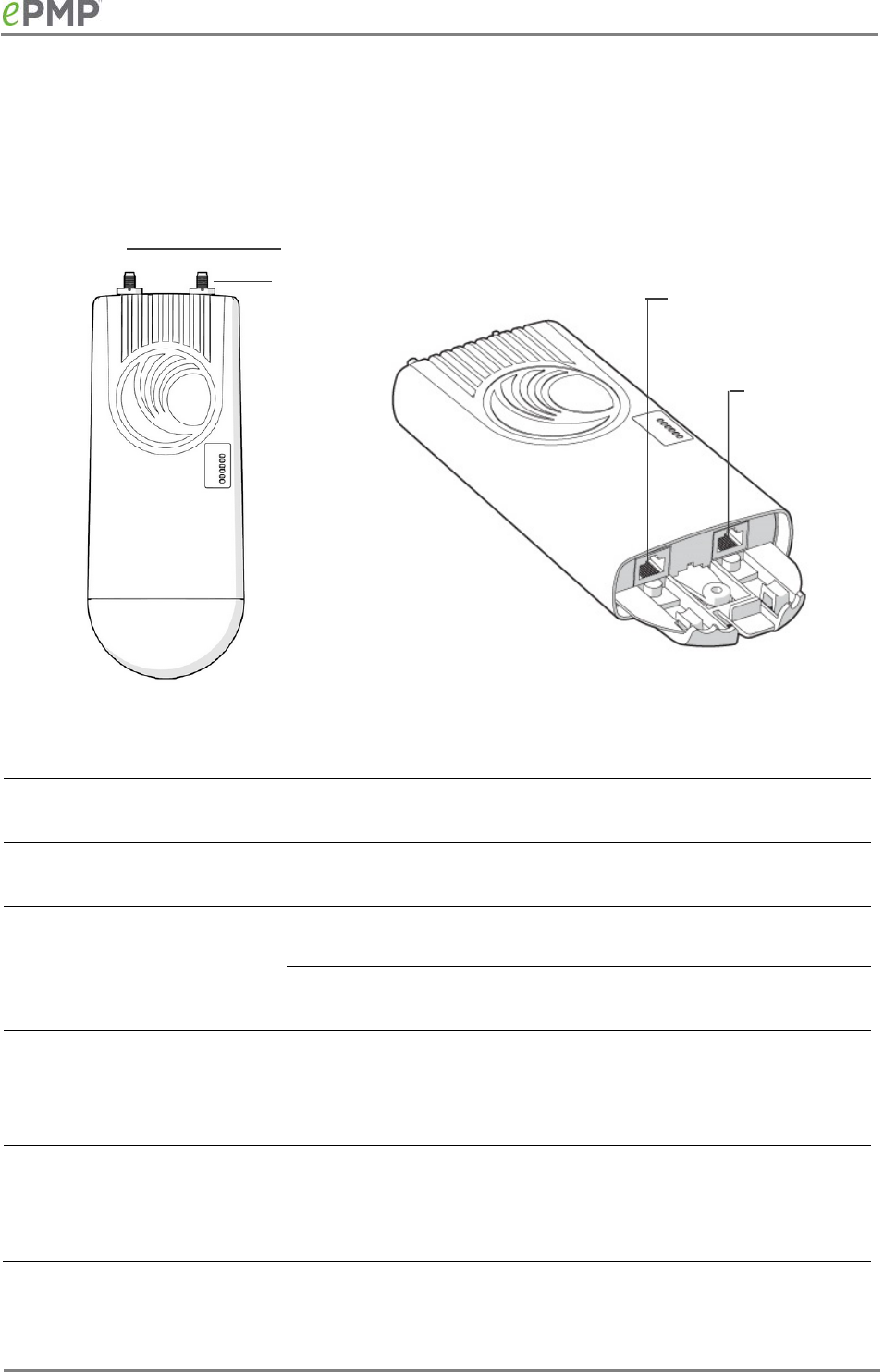
CAMBIUM NETWORKS
UN-SYNCED CONNECTORIZED RADIO INTERFACES
The un-synced connectorized radio with interfaces are illustrated in
Figure 11
and described in
Table 21
.
Figure 11
Un-synced connectorized radio interfaces
Table 21
Un-synced connectorized radio interfaces
Name
Connector
Interface
Description
Antenna
port H RP-SMA, female Antenna,
H polarization To/from H polarized antenna port
Antenna
port V RP-SMA, female Antenna,
V polarization To/from V polarized antenna port
Primary
Ethernet RJ45
PoE input Proprietary power over Ethernet (PoE) twisted
pair (for powering via CMM3/CMM4)
10/100 Base-
TX Ethernet Management and data
Auxiliary
Ethernet
(future
release)
RJ45
Cambium
propriety PoE
output, data
bridging
Propriety 30V PoE
output for auxiliary devices
(not 802 3af standard Poe)
Reset
Button Physical button N/A
For resetting the radio and for resetting the
radio back to its factory default configuration,
see Using the device external reset button on
page
206
.
Antenna port V
Antenna port H
AUXILLARY
ETHERNET
PRIMARY
ETHERNET
48
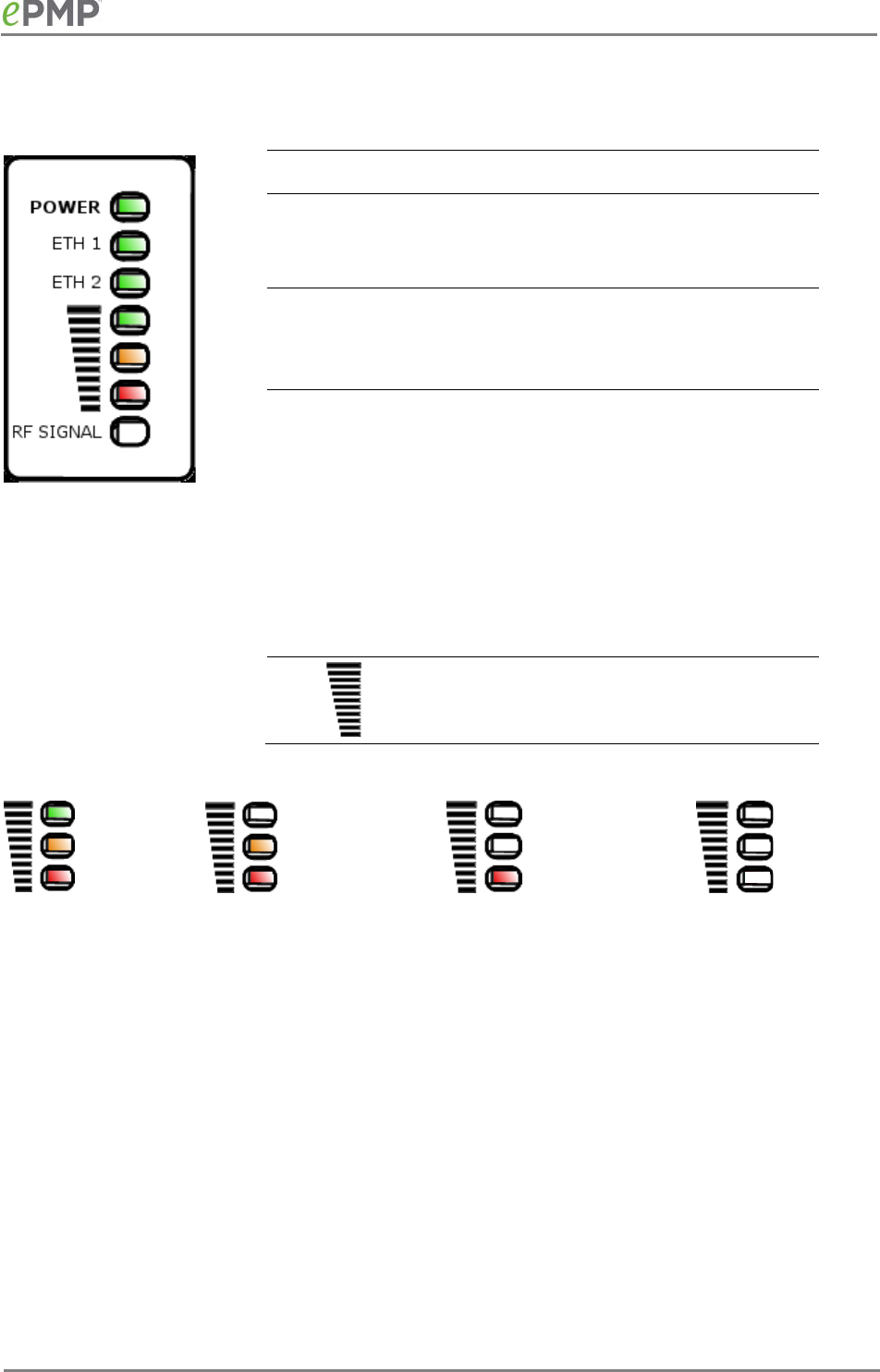
CAMBIUM NETWORKS
UN-SYNCED CONNECTORIZED RADIO LEDS
LED
Function
POWER Green: Power is applied to the device
Unlit: No power is applied to the device or
improper power source
ETH 1 Main/Primary Ethernet port indicator
Once lit, blinking indicates Ethernet activity
Green: 10/100BaseTX link
ETH 2 Auxiliary/Secondary Ethernet port
indicator
Once lit, blinking indicates Ethernet activity
Green: 10/100BaseTX link
Radio scanning: LEDs light in an ascending
sequence to indicate that the radio is
scanning
Radio registered: LEDs light to indicate the
RSSI level at the device.
Reserved for future release
RSSI
> -60
dBm
-70 dBm
< RSSI
≤
≤
-60 dBm
-80 dBm
< RSSI
≤
-70 dBm
RSSI
≤
-80
dBm
49

CAMBIUM NETWORKS
UN-SYNCED CONNECTORIZED RADIO SPECIFICATIONS
The ePMP un-synced connectorized radio conforms to the specifications listed in
Table 22
and
Table 23
.
The connectorized meets the low level static discharge specifications identified in
Electromagnetic
compatibility (EMC) compliance
on page
261
and provides internal surge suppression but does
not provide lightning suppression.
For a full listing of connectorized radio specifications, see
Connectorized Radio Specifications
on
page
288
.
Table 22
Un-synced connectorized radio physical specifications
Category
Specification
Dimensions (H x W x D) Radio: 227 x 88 x 33 mm (8.9” x 3.5” x 1.3”)
Antenna: 529 x 124 x 53 mm (20.8” x 4.9” x 2.1”)
Weight .521 kg (1.15 lbs) without antenna
4.5 kg (10 lbs) with antenna
Table 23
Un-synced connectorized radio environmental specifications
Category
Specification
Temperature -30°C (-22°F) to +55°C (131°F)
Wind loading 118 mph (190 kph) maximum. See
Un-synced connectorized
Radio wind loading
on page
52
for a full description.
Humidity 95% condensing
Environmental IP55
50

CAMBIUM NETWORKS
UN-SYNCED CONNECTORIZED RADIO HEATER
On startup, if the ePMP un-synced connectorized radio temperature is at or below 32° F (0° C), an
internal heater is activated to ensure that the device is able to successfully begin operation. The
unit’s heater is only activated when the unit is powered on and will not transfer heat to the device
until the startup completes. When the unit temperature is greater than 32° F (0° C), the heater is
deactivated and the unit continues its startup sequence.
The effect on device startup time at various temperatures is defined in
Table 24
.
Table 24
Un-synced connectorized radio startup times based on ambient temperature
Initial
Temperature
Startup time (from power on to operational)
-22° F (-30° C) 20 minutes
-4° F (-20° C) 6 minutes
14° F (-10° C) 2 minutes, 30 seconds
UN-SYNCED CONNECTORIZED RADIO AND EXTERNAL ANTENNA LOCATION
Find a location for the device and external antenna that meets the following requirements:
• The equipment is high enough to achieve the best radio path.
• People are a safe distance away from the equipment when it is radiating. The safe separation
distances are defined in
Calculated distances and power compliance margins
on page
263
.
• The equipment is lower than the top of the supporting structure (tower, mast or building) or its
lightning air terminal.
• The location is not subjected to excessive wind loading. For more information, see
Un-synced
connectorized Radio wind loading
on page
52
.
51

CAMBIUM NETWORKS
UN-SYNCED CONNECTORIZED RADIO WIND LOADING
Ensure that the device and the structure on which it is mounted are capable of withstanding the
prevalent wind speeds at a proposed ePMP site. Wind speed statistics must be available from
national meteorological offices.
The device and its mounting bracket are capable of withstanding wind speeds of up to 190 kph
(118 mph).
Wind speeds on the device subjects the mounting structure to significant lateral force. The
magnitude of the force depends on both the wind strength and surface area of the device. Wind
loading is estimated using the following formulae:
Force (in kilograms) = 0.1045aV2
Where:
Is:
a surface area in square meters
V wind speed in meters per second
Force (in pounds) = 0.0042Av2
Where:
Is:
A
surface area in square feet
v
wind speed in miles per hour
Applying these formulae to the ePMP device at different wind speeds, the resulting wind loadings
are shown in
Table 25
and
Table 26
.
Table 25
Un-synced connectorized radio wind loading (Kg)
Type of ePMP
device
Largest
surface area
(square meters)
Wind speed (meters per second)
30
40
50
60
70
Connectorized 0.13 12.2 Kg 21.7 Kg 34 Kg 49 Kg 66.6 Kg
Table 26
Un-synced connectorized radio wind loading (lb)
Type of ePMP
device
Largest
surface area
(square feet)
Wind speed (miles per hour)
80
100
120
140
150
Connectorized 1.39 37.4 lb 58.4 lb 84.1 lb 114.4 lb 131.4 lb
52

CAMBIUM NETWORKS
UN-SYNCED CONNECTORIZED RADIO SOFTWARE PACKAGES
Un-synced connectorized radio may be upgraded by downloading new software packages from
the Cambium Networks website or by using the Cambium Network Services Server. The software
packages applicable to ePMP Un-synced connectorized radio are named:
• ePMP-NonGPS_Synced-v1.4.3.tar.gz
UN-SYNCED CONNECTORIZED RADIO ANTENNAS AND ANTENNA CABLING
Un-synced connectorized radio requires external antennas connected using RF cable (included
with Cambium ePMP sector antennas). For details of the antennas and accessories required for a
connectorized ePMP installation, see:
•
Antenna requirements
on page
39
•
FCC and IC approved antennas
on page
39
ANTENNA REQUIREMENTS
For connectorized units operating in the USA or Canada 2.4 GHz, 5.4 GHz or 5.8 GHz bands, choose
external antennas from those listed in
FCC and IC approved antennas
on page
39
. For installations
in other countries, the listed antennas are advisory, not mandatory.
FCC AND IC APPROVED ANTENNAS
For connectorized units operating in the USA or Canada, choose external antennas from
Table 27
.
These are approved by the FCC for use with the product and are constrained by the following
limits:
• 5 GHz – 15 dBi gain
• 2.4 GHz - 15 dBi gain
Caution
Using other than approved antennas may cause measurements higher than reported for
certification.
Caution
This radio transmitter (IC certification number 109W-0005) has been approved by Industry Canada
to operate with the antenna types listed below with the maximum permissible gain and required
antenna impedance for each antenna type indicated. Antenna types not included in this list, having
a gain greater than the maximum gain indicated for that type, are strictly prohibited for use with
this device.
Le présent émetteur radio (Numéro de certification IC 109W-0005 ) a été approuvé par Industrie
Canada pour fonctionner avec les types d'antenne énumérés ci-dessous et ayant un gain
admissible maximal et l'impédance requise pour chaque type d'antenne. Les types d'antenne non
inclus dans cette liste, ou dont le gain est supérieur au gain maximal indiqué, sont strictement
interdits pour l'exploitation de l'émetteur.
53

CAMBIUM NETWORKS
Table 27
Allowed antennas for deployment in USA/Canada – 5 GHz
Cambium part
number
Antenna Type
Gain (dBi)
C050900D003A 5 GHz Sector Antenna – 90 degree 15
C050900D002A 5 GHz Sector Antenna – 120 degree 15
Power supply
For details of the ePMP power supply units, see:
•
Power supply description
on page
54
•
Power supply part numbers
on page
54
•
Power supply interfaces
on page
55
•
Power supply specifications
on page
56
•
Power supply location
on page
56
POWER SUPPLY DESCRIPTION
The power supply is an indoor unit that is connected to the connectorized or integrated module
and network terminating equipment using Cat5e cable with RJ45 connectors. It is also plugged
into an AC or DC power supply so that it can inject Power over Ethernet (PoE) into the module.
POWER SUPPLY PART NUMBERS
Each module requires one power supply and one power supply line cord. One can order power
supplies and line cords from Cambium Networks (
Table 28
). The power supplies listed in
Table 28
may be used for both connectorized and integrated modules, however, only N000900L001A
provides a Gigabit Ethernet interface (connectorized modules only).
Table 28
Power supply component part numbers
Cambium description
Cambium part number
ePMP Pwr Supply for GPS Radio - no cord (spare) N000900L001A
ePMP Pwr Supply for non-GPS Radio - no cord (spare) N000900L002A
54
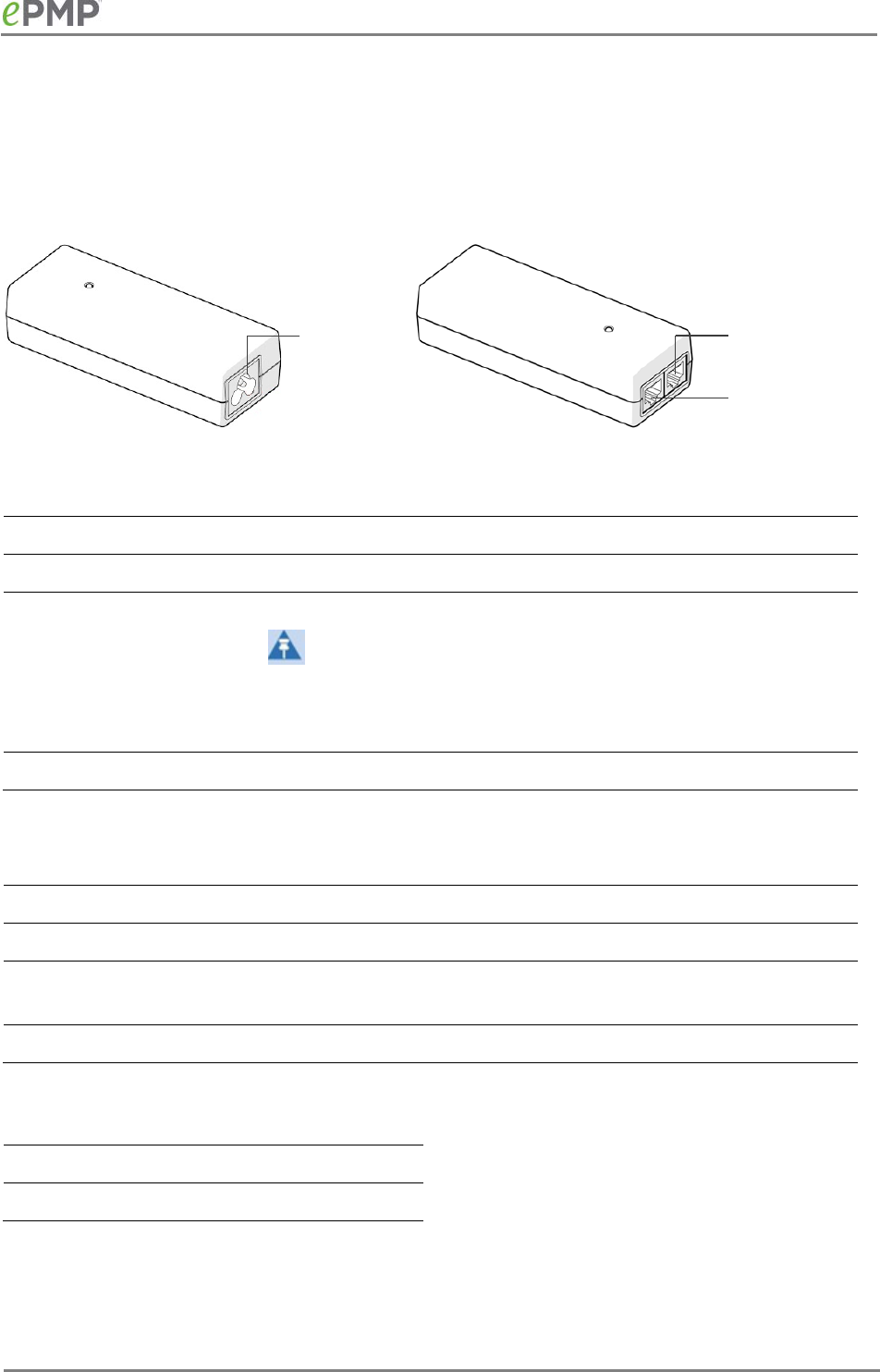
CAMBIUM NETWORKS
POWER SUPPLY INTERFACES
The power supply interfaces are illustrated in
Figure 12
and described in
Table 29
and
Table 31
.
Figure 12
Power supply interfaces
Table 29
Power supply interface functions - N000900L001A
Interface
Function
Power input Mains power input.
Gigabit Data + Power RJ45 socket for connecting Cat5e cable to radio
Note
This port provides a Gigabit Ethernet interface to ePMP
connectorized radios. To ePMP integrated radios, this port
provides a 100/10 Mbit/sec Ethernet interface.
Gigabit Data RJ45 socket for connecting Cat5e cable to network.
Table 30
Power supply interface functions - N000900L002A
Interface
Function
Power input Mains power input.
10/100 Mbit/sec Data +
Power
RJ45 socket for connecting Cat5e cable to radio
10/100 Mbit/sec Data RJ45 socket for connecting Cat5e cable to network.
Table 31
Power Supply LED functions
LED
Function
Power (green) Power supply detection
Gigabit
Data
Gigabit
Data +
Power
Power
input
55

CAMBIUM NETWORKS
POWER SUPPLY SPECIFICATIONS
The ePMP power supply conforms to the specifications listed in
Table 32
,
Table 33
and
Table 34
.
These specifications apply to all ePMP product variants.
Table 32
Power supply physical specifications
Category
Specification
Dimensions (H x W x D) 11.8 x 4.4 x 3.2 cm (4.66 x 1.75 x 1.25 in)
Weight 0.26 lbs
Table 33
Power supply environmental specifications
Category
Specification
Ambient Operating
Temperature
0° C to +40° C
Humidity 20% - 90%
Table 34
Power supply electrical specifications
Category
Specification
AC Input 100 to 240 VAC
Efficiency Meets efficiency level ‘V’
Over Current Protection Zener clamping (38V to 45V)
Hold up time 10 ms minimum at maximum load, 120 VAC
POWER SUPPLY LOCATION
Find a location for the power supply that meets the following requirements:
• The power supply can be mounted on a wall or other flat surface.
• The power supply is kept dry, with no possibility of condensation, flooding or rising damp.
• The power supply can be accessed to view status indicators.
• The power supply can be connected to the ePMP module drop cable and network terminating
equipment.
• The power supply can be connected to a mains or dc power supply that meets the
requirements defined in
Table 34
.
56

CAMBIUM NETWORKS
Ethernet cabling
For details of the Ethernet cabling components of an ePMP installation, see:
•
Ethernet standards and cable lengths
on page
57
•
Outdoor Cat5e cable
on page
57
ETHERNET STANDARDS AND CABLE LENGTHS
All configurations require a copper Ethernet connection from the power supply port to the power
supply and network terminating equipment.
Table 35
specifies, for each power supply, the maximum permitted drop cable length.
Table 35
Power supply drop cable length restrictions
Part number
Description
Maximum cable length (*1)
N000900L001A Power Supply for Radio with
Gigabit Ethernet (no cord)
330 feet (100m)
N000900L002A Power Supply for Radio with
100Mbit Ethernet (no cord)
330 feet (100m)
(*1) Maximum length of Ethernet cable from AP/STA to power supply
OUTDOOR CAT5E CABLE
For copper connections from the device to the power supply, use Cat5e cable that is shielded with
copper-plated steel.
Caution
Always use Cat5e cable that is shielded with copper-plated steel. Alternative types of Ethernet
cable are not supported by Cambium Networks.
57

CAMBIUM NETWORKS
Surge Suppression unit
The ePMP integrated and connectorized units both contain 1 Joule-rated surge suppression build
into the device. With this built in surge suppression, it is not required to install a surge suppressor
at the unit’s mounting location. However, it is required to install a surge suppressor at the
Ethernet cable’s building ingress into the power supply’s indoor location. For installations not
requiring Gigabit (1000 Mbit/sec) Ethernet, a Cambium 600SSH surge suppressor may be used.
See Cambium 600SSH details for information.
58
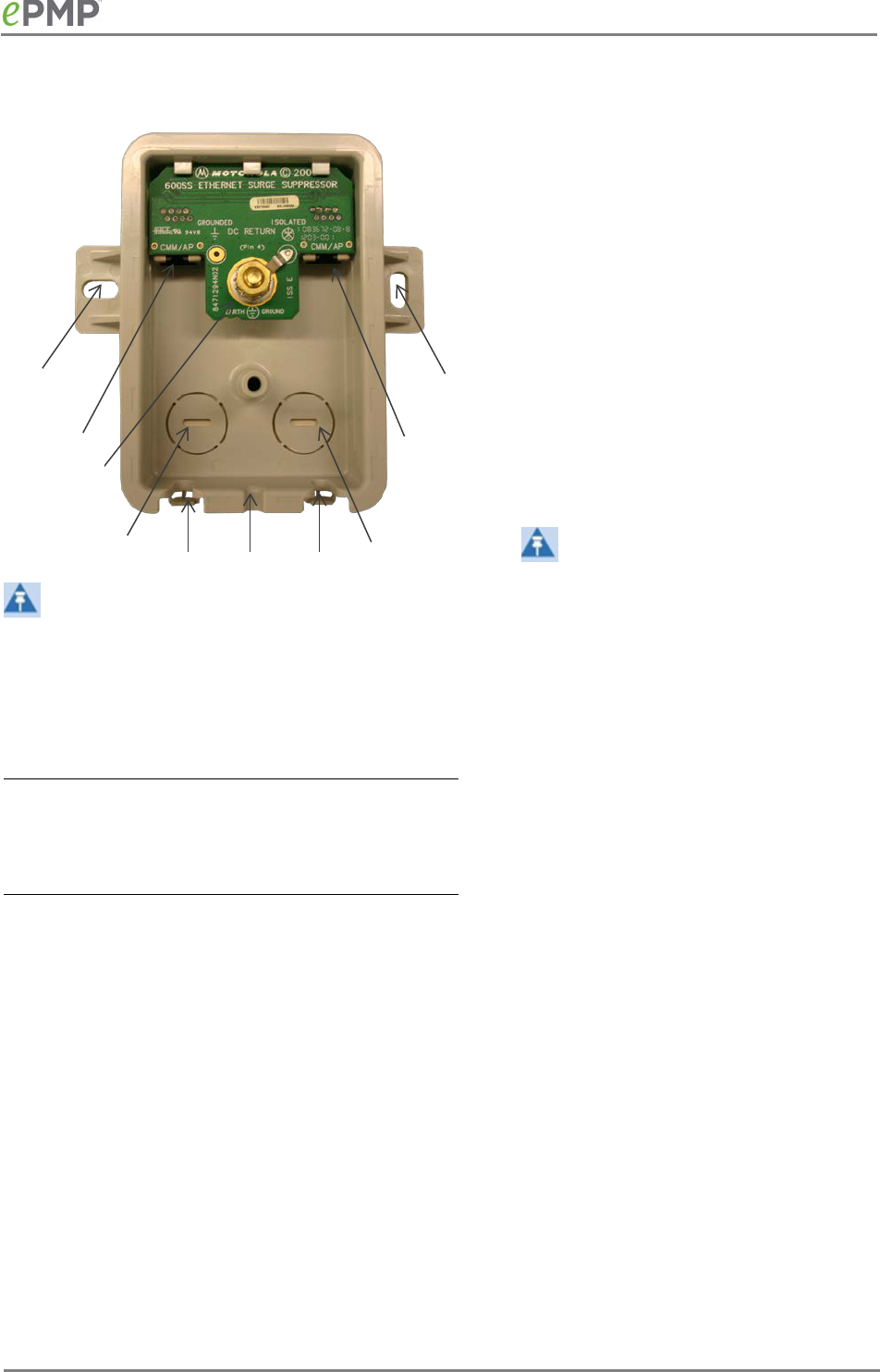
CAMBIUM NETWORKS
CAMBIUM 600SSH DETAILS
Note
For connectorized module installations requiring
Gigabit (1000 Mbit/sec) Ethernet surge suppression,
utilize the following:
Mfr
Part
Description
L-COM AL-
CAT6JW
Outdoor 10/100/1000
Base-T CAT6 PoE
Compatible Lightning
Protector
L-COM AL-
CAT6HPJW
Outdoor 10/100/1000
Base-T CAT6 PoE
Compatible Lightning
Protector – High Power
(protection comparable
to 600SSH)
1 Holes—for mounting the Surge Suppressor to a
flat surface (such as an outside wall). The
distance between centers is 4.25 inches (108
mm).
2 RJ-45 connectors—One side (neither side is
better than the other for this purpose) connects
to the product (AP, SM, or cluster management
module). The other connects to the AC adaptor’s
Ethernet connector.
3 Ground post and washer—use heavy gauge (10
AWG or 6 mm2) copper wire for connection.
Refer to local electrical codes for exact
specifications.
Note The 600SSH surge
suppressor is shipped in the “isolated”
position (pin 4 isolated by 68V from
protective earth). If packet error issues
occur over the Ethernet link (verify by
pinging the device through the
600SSH), configure the 600SSH to
“grounded” position (by moving the
600SSH switch from “isolated” to
“ground”) to avoid ground loops that
may be present in the system.
4 Ground Cable Opening—route the 10 AWG (6
mm2) ground cable through this opening.
5 CAT-5 Cable Knockouts—route the two CAT-5
cables through these openings, or alternatively
through the Conduit Knockouts.
6 Conduit Knockouts—on the back of the case, near
the bottom. Available for installations where
cable is routed through building conduit.
1
2
3
6
5
4
5
6
2
1
59

System planning
This chapter provides information to help the user to plan an ePMP link.
The following topics are described in this chapter:
•
Radio spectrum planning
on page
61
describes how to plan ePMP links to conform to the
regulatory restrictions that apply in the country of operation.
•
Link planning
on page
65
describes factors to be taken into account when planning links, such
as range, path loss and throughput.
•
Planning for connectorized units
on page
66
describes factors to be taken into account when
planning to use connectorized APs with external antennas in ePMP links.
•
Grounding and lightning protection
on page
30
describes the grounding and lightning
protection requirements of a ePMP installation.
•
Data network planning
on page
68
describes factors to be considered when planning ePMP
data networks.
60

CAMBIUM NETWORKS
Radio spectrum planning
This section describes how to plan ePMP links to conform to the regulatory restrictions that apply
in the country of operation.
Caution
It is the responsibility of the user to ensure that the PMP product is operated in accordance with
local regulatory limits.
Note
Contact the applicable radio regulator to find out whether or not registration of the ePMP link is
required.
GENERAL WIRELESS SPECIFICATIONS
Table 36
lists the wireless specifications that apply to all ePMP variants.
Table 37
lists the wireless
specifications that are specific to each frequency variant.
Table 36
ePMP wireless specifications (all variants)
Item
Specification
Channel selection Manual selection (fixed frequency).
Manual power control To avoid interference to other users of the band, maximum
power can be set lower than the default power limit (AP only).
Integrated device antenna
type
Patch antenna
Duplex scheme Adaptive TDD
Range 13 mi (20 MHz channel bandwidth)
9 mi (40 MHz channel bandwidth)
Over-the-air encryption AES
Error Correction FEC
61

CAMBIUM NETWORKS
Table 37
ePMP wireless specifications (per frequency band)
Item
5 GHz
2.4 GHz
RF band (GHz) 5150 - 5875 MHz 2402 - 2472 MHz (20 MHz)
2407 - 2472 MHz (40 MHz)
Channel bandwidth 20 MHz
40 MHz
20 MHz
40 MHz
Typical antenna
gain
Connectorized antenna – 15 dBi
Integrated patch antenna – 13 dBi
Connectorized antenna - 15 dBi
Integrated patch antenna - 11 dBi
Antenna beamwidth
(integrated)
24° azimuth, 12° elevation 24° azimuth, 12° elevation
REGULATORY LIMITS
The local regulator may restrict frequency usage and channel width, and may limit the amount of
conducted or radiated transmitter power. For details of these restrictions, see
Examples of
regulatory limits
on page
267
.
Many countries impose EIRP limits (Allowed EIRP) on products operating in the bands used by the
ePMP Series. For example, in the 5 GHz and 2.4 GHz bands, these limits are calculated as follows:
• In the 5.2 GHz (5250 MHz to 5350 MHz) and 5.4 GHz (5470 MHz to 5725 MHz) band, the EIRP
must not exceed the lesser of 30 dBm or (17 + 10 x Log Channel width in MHz) dBm.
• In the 5.8 GHz band (5725 MHz to 5875 MHz), the EIRP must not exceed the lesser of 36 dBm or
(23 + 10 x Log Channel width in MHz) dBm.
• In the 2.4 GHz band (2400 MHz to 2500 MHz), the EIRP must not exceed the lesser of 36 dBm or
(23 + 10 x Log Channel width in MHz) dBm.
Some countries (for example the USA) impose conducted power limits on products operating in
the 5 GHz and 2.4 GHz band.
CONFORMING TO THE LIMITS
Ensure the link is configured to conform to local regulatory requirements by configuring the
correct country code (located in the web management interface, under
Configure
=>
Radio
). In the
following situations, the country code does not automatically prevent operation outside the
regulations:
• When using connectorized APs with external antennas, the regulations may require the
maximum transmit power to be reduced. To ensure that regulatory requirements are met for
connectorized installations, see
Calculating maximum power level for connectorized units
on
page
66
. When operating in ETSI regions, it is required to enter a license key in the ePMP web
management interface to unlock 5.8 GHz band frequencies. This key may be obtained from
https://support.cambiumnetworks.com/licensekeys/epmp
.
62
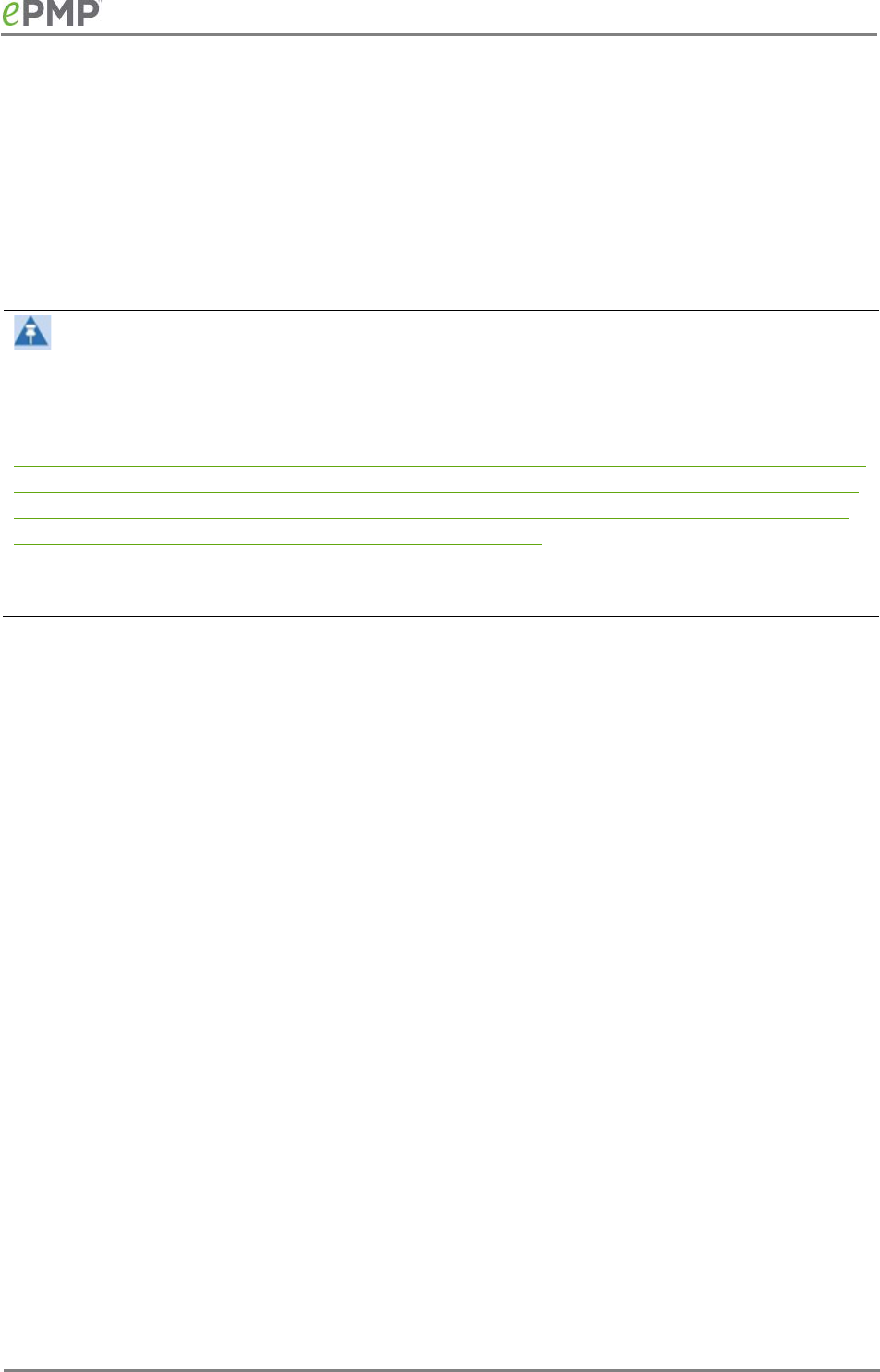
CAMBIUM NETWORKS
• When installing 5.4 GHz links in the USA, it may be necessary to avoid frequencies used by
Terminal Doppler Weather Radar (TDWR) systems. For more information, see
Avoidance of
weather radars
on page
64
.
AVAILABLE SPECTRUM
The available spectrum for operation depends on the region. When configured with the
appropriate country code, the unit will only allow operation on those channels which are permitted
by the regulations.
Note
In Italy, there is a regulation which requires a general authorization of any 5.4 GHz radio link
which is used outside the operator’s own premises. It is the responsibility of the installer or
operator to have the link authorized. For details, see:
http://www.sviluppoeconomico.gov.it/index.php?option=com_content&view=article&idmenu=672
&idarea1=593&andor=AND&idarea2=1052&id=68433§ionid=1,16&viewType=1&showMenu=
1&showCat=1&idarea3=0&andorcat=AND&partebassaType=0&idareaCalendario1=0&MvediT=1
&idarea4=0&showArchiveNewsBotton=0&directionidUser=0
For the form that must be used for general authorization, see:
http://www.sviluppoeconomico.gov.it/images/stories/mise_extra/Allegato%20n19.doc
Certain regulations have allocated certain channels as unavailable for use:
• ETSI has allocated part of the 5.4 GHz band to weather radar.
• UK and some other European countries have allocated part of the 5.8 GHz band to Road
Transport and Traffic Telematics (RTTT) systems.
For details of these restrictions, see
Examples of regulatory limits
on page
267
.
Where regulatory restrictions apply to certain channels, these channels are barred automatically
by the use of the correct country code. For example, at 5.8 GHz in the UK and some other
European countries, the RTTT band 5795 MHz to 5815 MHz is barred. With the appropriate country
code configured for this region, the ePMP will not operate on channels within this band.
The number and identity of channels barred by the license key and country code is dependent on
the channel bandwidth.
For more information about configuring the
Country Code
parameter, see on
AP Radio page
on
page
91
and
STA Radio page
on page
141
.
CHANNEL BANDWIDTH
Select the required channel bandwidth for the link. The selection depends upon the ePMP
frequency variant and country code, as specified in
Examples of regulatory limits
on page
267
.
The wider the channel bandwidth, the greater its capacity. As narrower channel bandwidths take
up lesser spectrum, selecting a narrow channel bandwidth may be a better choice when operating
in locations where the spectrum is very busy.
Both ends of the link must be configured to operate on the same channel bandwidth.
63

CAMBIUM NETWORKS
AVOIDANCE OF WEATHER RADARS
To comply with FCC rules (KDB 443999: Interim Plans to Approve UNII Devices Operating in the
5470 - 5725 MHz Band with Radar Detection and DFS Capabilities), units which are installed within
35 km (22 miles) of a Terminal Doppler Weather Radar (TDWR) system (or have a line of sight
propagation path to such a system) must be configured to avoid any frequency within +30 MHz or
–30 MHz of the frequency of the TDWR device. This requirement applies even if the master is
outside the 35 km (22 miles) radius but communicates with outdoor clients which may be within
the 35 km (22 miles) radius of the TDWRs.
The requirement for ensuring 30 MHz frequency separation is based on the best information
available to date. If interference is not eliminated, a distance limitation based on line-of-sight from
TDWR will need to be used. In addition, devices with bandwidths greater than 20 MHz may require
greater frequency separation.
When planning a link in the USA, visit
http://spectrumbridge.com/udia/home.aspx
, enter the
location of the planned link and search for TDWR radars. If a TDWR system is located within 35 km
(22 miles) or has line of sight propagation to the PMP device, perform the following tasks:
• Register the installation on
http://spectrumbridge.com/udia/home.aspx
.
• Make a list of channel center frequencies that must be barred, that is, those falling within +30
MHz or –30 MHz of the frequency of the TDWR radars.
In ETSI regions, the band 5600 MHz to 5650 MHz is reserved for the use of weather radars.
64

CAMBIUM NETWORKS
Link planning
This section describes factors to be taken into account when planning links, such as range,
obstacles path loss and throughput.
RANGE AND OBSTACLES
Calculate the range of the link and identify any obstacles that may affect radio performance.
Perform a survey to identify all the obstructions (such as trees or buildings) in the path and to
assess the risk of interference. This information is necessary in order to achieve an accurate link
feasibility assessment.
PATH LOSS
Path loss is the amount of attenuation the radio signal undergoes between the two ends of the
link. The path loss is the sum of the attenuation of the path if there were no obstacles in the way
(Free Space Path Loss), the attenuation caused by obstacles (Excess Path Loss) and a margin to
allow for possible fading of the radio signal (Fade Margin). The following calculation needs to be
performed to judge whether a particular link can be installed:
capabilityseasonalfadeexcessspacefree
LLLLL <+++
_
Where: Is:
spacefree
L_
Free Space Path Loss (dB)
excess
L
Excess Path Loss (dB)
fade
L
Fade Margin Required (dB)
seasonal
L
Seasonal Fading (dB)
capability
L
Equipment Capability (dB)
Free space path loss is a major determinant in received (Rx) signal level. Rx signal level, in turn, is
a major factor in the system operating margin (fade margin), which is calculated as follows:
System Operating Margin (fade margin) dB = Rx signal level (dB) – Rx sensitivity (dB)
Thus, the fade margin is the difference between strength of the received signal and the strength
that the receiver requires for maintaining a reliable link.
ADAPTIVE MODULATION
Adaptive modulation ensures that the highest throughput that can be achieved instantaneously
will be obtained, taking account of propagation and interference. When the link has been installed,
web pages provide information about the link loss currently measured by the equipment, both
instantaneously and averaged.
65

CAMBIUM NETWORKS
Planning for connectorized units
This section describes factors to be taken into account when planning to use connectorized APs
with external antennas in ePMP networks.
CALCULATING MAXIMUM POWER LEVEL FOR CONNECTORIZED UNITS
If a connectorized ePMP link is to be installed in a country that imposes an EIRP limit in the
selected band, choose an external antenna and RF cable that will not cause the ePMP to exceed the
EIRP limit. To calculate the highest setting of Maximum Power Level that will be permitted, use
this formula:
Maximum Power Level (dBm) = Allowed EIRP (dBm) – Antenna Gain (dBi) + Cable Loss (dB)
Where:
Is:
Maximum Power
Level (dBm)
the highest permissible setting of the Maximum
Power Level attribute in the Step 2: Wireless
Configuration page,
Allowed EIRP (dBm) the EIRP limit allowed by the regulations,
Antenna Gain (dBi) the gain of the chosen antenna,
Cable Loss (dB) the loss of the RF cable connecting the AP to the
antenna.
As the 2.4 GHz, 5.4 GHz and 5.8 GHz have an operating bandwidth of 20 MHz or 40 MHz then the
maximum allowed EIRP depends on the operating bandwidth of the radio as shown in
Table 38
.
Table 38
Normal EIRP limits with operating channel bandwidth
Operating
bandwidth
(MHz)
Allowed EIRP
(dBm) at 5.2 GHz
Allowed EIRP
(dBm) at 5.4 GHz
Allowed EIRP
(dBm) at 5.8 GHz
Allowed EIRP
(dBm) at 2.4 GHz
20, 40 30 30 36 36
The settings to be used for regions with the EIRP limits in
Table 38
are shown in
Table 39
.
Table 39
Setting maximum transmit power to meet general EIRP limits
Antenna
Maximum
available
antenna
gain (dBi)
Operating
bandwidth
(MHz)
Transmitter Output Power parameter
setting (dBm)
5.2 GHz
5.4
GHz
5.8 GHz
2.4 GHz
Connectori
zed
module
sector
15 20, 40 15 15 21 21
66

CAMBIUM NETWORKS
antenna
Note
Table 39
is calculated on the basis of 0.5 dB cable loss and the highest gain antennas
per size of which Cambium Networks are aware. At these operating frequencies,
antenna cable losses even with short cables are unlikely to ever be below 0.5 dB for
practical installations and cable diameters.
67
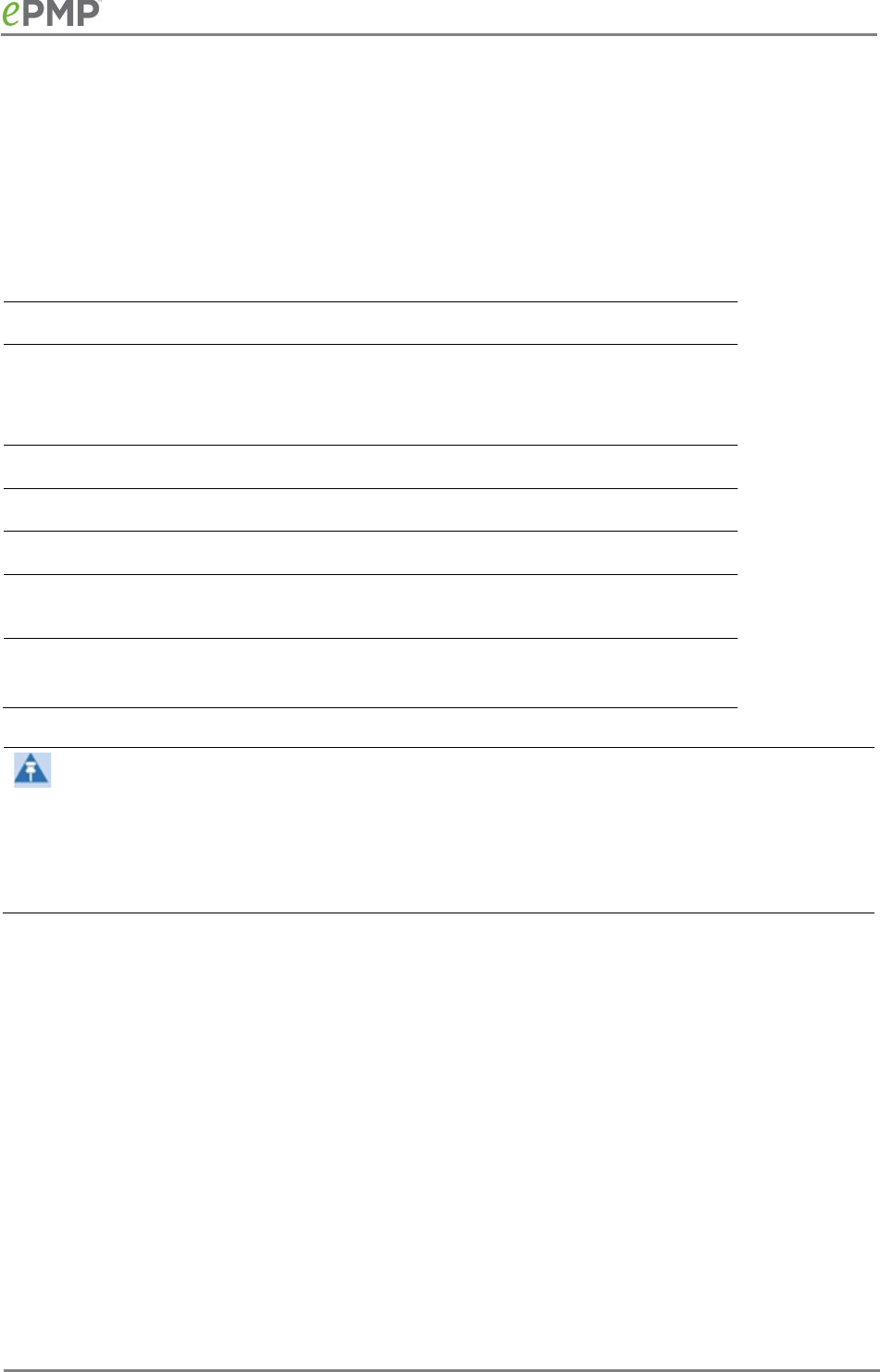
CAMBIUM NETWORKS
Data network planning
This section describes factors to be considered when planning ePMP data networks.
ETHERNET INTERFACES
The ePMP Ethernet ports conform to the specifications listed in
Table 40
.
Table 40
ePMP Ethernet bridging specifications
Ethernet Bridging
Specification
Protocol 10BASE-Te/100BASE-Tx/1000BASE-T IEEE 802.3
IEEE 802.3af (PoE)
IEEE802.3u compliant Auto-negotiation
QoS Proprietary QoS
Interface 10/100/1000BaseT (RJ-45)
Data Rates See
Data throughput tables
on page
287
.
Maximum Ethernet Frame
Size
1700 bytes
Service classes for bridged
traffic
3 classes
Note
Practical Ethernet rates will depend on network configuration, higher layer protocols and
platforms used.
Over the air throughput will be capped to the rate of the Ethernet interface at the receiving end of
the link.
MANAGEMENT VLAN
Decide if the IP interface of the AP/STA management agent will be connected in a VLAN. If so,
decide if this is a standard (IEEE 802.1Q) VLAN or provider bridged (IEEE 802.1ad) VLAN, and select
the VLAN ID for this VLAN.
Use of a separate management VLAN is strongly recommended. Use of the management VLAN
helps to ensure that the AP/STA management agent cannot be accessed by customers.
68

CAMBIUM NETWORKS
QUALITY OF SERVICE FOR BRIDGED ETHERNET TRAFFIC
Decide how quality of service will be configured in ePMP to minimize frame loss and latency for
high priority traffic. Wireless links often have lower data capacity than wired links or network
equipment like switches and routers, and quality of service configuration is most critical at network
bottlenecks.
ePMP provides three priority types for traffic waiting for transmission over the wireless link –
Voice, High, and Low. Low is the lowest priority and Voice is the highest priority. Traffic is
scheduled using strict priority; in other words, traffic in a given priority is transmitted when all
higher-priority transmissions are complete.
69

CAMBIUM NETWORKS
Configuration
This chapter describes all configuration and alignment tasks that are performed when an ePMP
system is deployed.
Configure the units by performing the following tasks:
•
Preparing for configuration
on page
71
•
Connecting to the unit
on page
72
•
Using the web interface
on page
74
•
Configuring connectorized radios using the Quick Start menu
on page
83
•
Configuring STA units using the Quick Start menu
on page
86
•
Using the AP menu options
on page
89
•
Using the STA menu options
on page
139
70

CAMBIUM NETWORKS
Preparing for configuration
This section describes the checks to be performed before proceeding with unit configuration.
SAFETY PRECAUTIONS
All national and local safety standards must be followed while configuring the units.
Warning
Ensure that personnel are not exposed to unsafe levels of RF energy. The units start to radiate as
soon as they are powered up. Respect the safety standards defined in
Compliance with safety
standards
on page
261
, in particular the minimum separation distances.
Observe the following guidelines:
• Never work in front of the antenna when the AP is powered.
• Always power down the power supply before connecting or disconnecting the Ethernet cable
from the module.
REGULATORY COMPLIANCE
All applicable radio regulations must be followed while configuring the units and aligning the
antennas. For more information, see
Compliance with radio regulations
on page
264
.
71
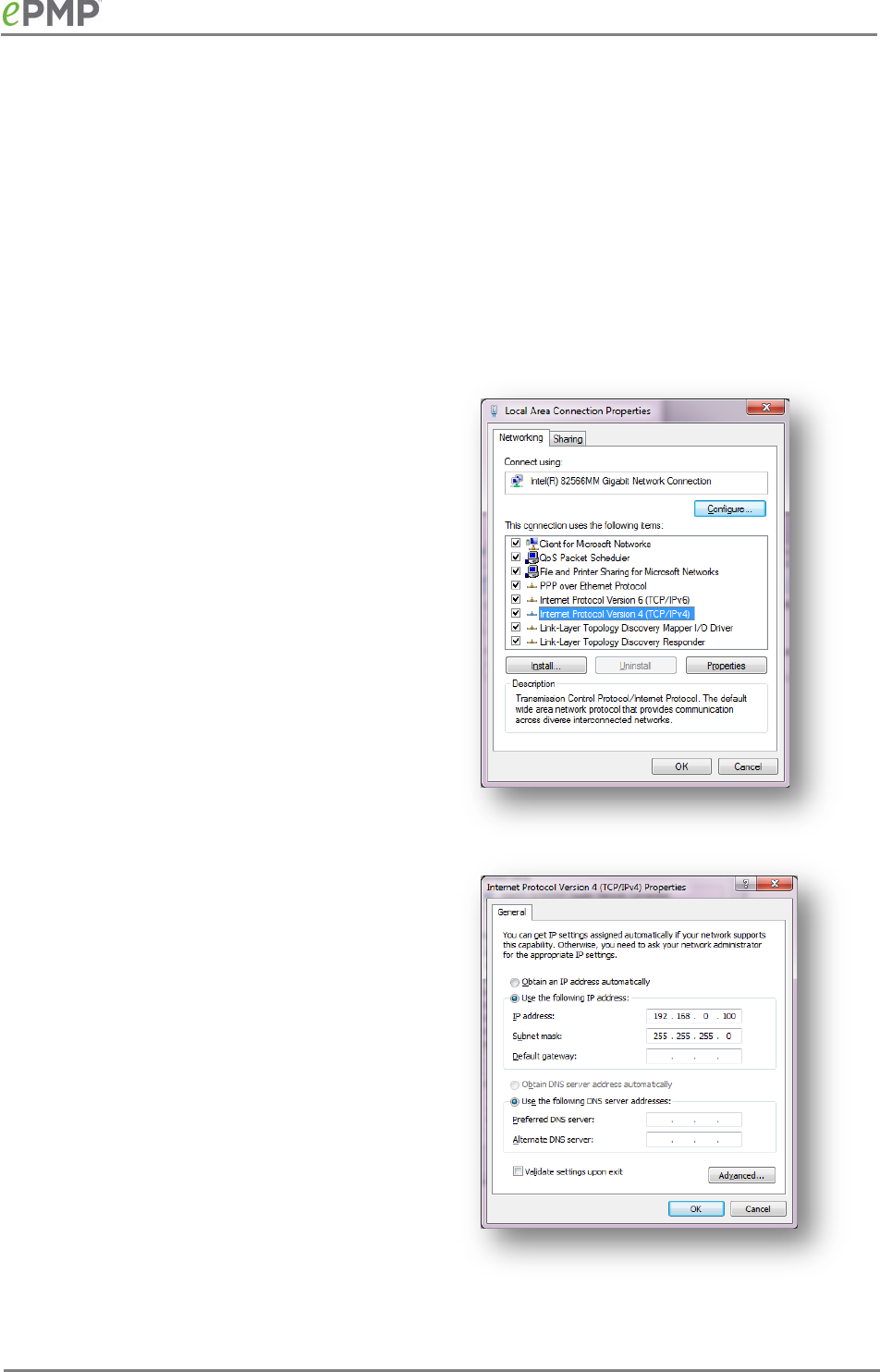
CAMBIUM NETWORKS
Connecting to the unit
To connect the unit to a management PC, use the following procedures:
•
Configuring the management PC
on page
72
•
Connecting to the PC and powering up
on page
73
CONFIGURING THE MANAGEMENT PC
Use this procedure to configure the local management PC to communicate with the ePMP module.
Procedure:
1
Select
Properties
for the Ethernet port.
In Windows 7 this is found in
Control Panel >
Network and Internet >
Network Connections > Local Area
Connection
.
2
Select the Internet Protocol (TCP/IP) item:
3
Click
Properties
.
4
Enter an IP address that is valid for the
192.168.0.X network, avoiding:
192.168.0.1, 192.168.0.2, and 192.168.03
A good example is 192.168.0.100:
5
Enter a subnet mask of 255.255.255.0.
Leave the default gateway blank.
6
Click OK, then click Close
72

CAMBIUM NETWORKS
CONNECTING TO THE PC AND POWERING UP
Use this procedure to connect a management PC directly to the ePMP for configuration and
alignment purposes, and to power up the ePMP device.
Procedure:
1
Check that the device and power supply are correctly connected (the device Ethernet port is
connected to the power supply Ethernet power port – see the ePMP Installation Guide for
more information).
2
Connect the PC Ethernet port to the LAN (AP: “Gigabit Data”, STA: “10/100Mbit Data”) port
of the power supply using a standard (not crossed) Ethernet cable.
3
Apply mains or battery power to the power supply. The green Power LED must illuminate
continuously.
Note
If the Power and Ethernet LEDs do not illuminate correctly, see
Testing hardware
on page
201
.
73

CAMBIUM NETWORKS
Using the web interface
To understand how to use the ePMP web interface, see:
•
Logging into the web interface
on page
75
•
Layout of the web interface
on page
76
•
Configuring connectorized radios using the Quick Start menu
on page
83
•
Configuring STA units using the Quick Start menu
on page
86
•
Using the AP menu options
on page
89
•
Using the STA menu options
on page
139
74
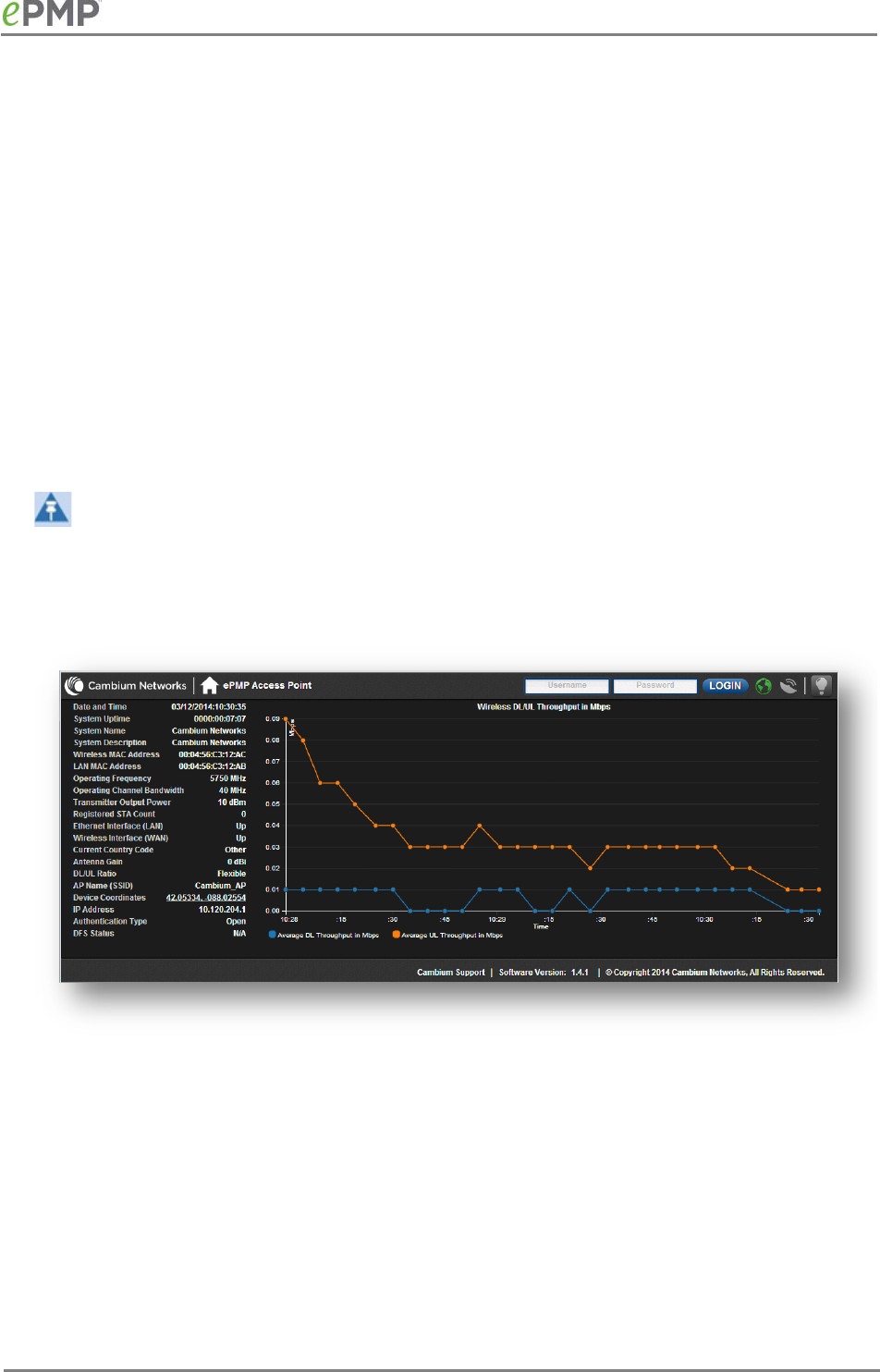
CAMBIUM NETWORKS
LOGGING INTO THE WEB INTERFACE
Use this procedure to log into the web interface as a system administrator.
Equipment and tools:
• Connectorized or integrated device connected to power supply by Ethernet cable.
• PC connected to power supply by Ethernet cable.
• Power Supply powered up.
• Supported browser – Chrome v29, Firefox v24, Internet Explorer 10, Safari v5
Procedure:
1
Start the web browser from the management PC.
2
Type the IP address of the unit into the address bar. The factory default IP address
is either
192.168.0.1
(connectorized radio) or
192.168.0.2
(integrated radio). Press ENTER. The web
interface
dashboard and login input is displayed.
Note
If Device IP address Mode
is set to
DHCP
and the device is unable to retrieve IP address
information via DHCP, the device
management IP is set to fallback IP 192.168.0.1 (AP mode),
192.168.0.2 (STA mode), 192.168.0.3 (Spectrum Analyzer mode) or the previously
-configured
static Device IP Address. Units may always be accessed via the Ethernet port with IP 10.1.1.254.
3
In
the upper-right corner of the GUI, enter Username (default: admin) and Password
(default:admin)
.
4
Click
Login
.
75
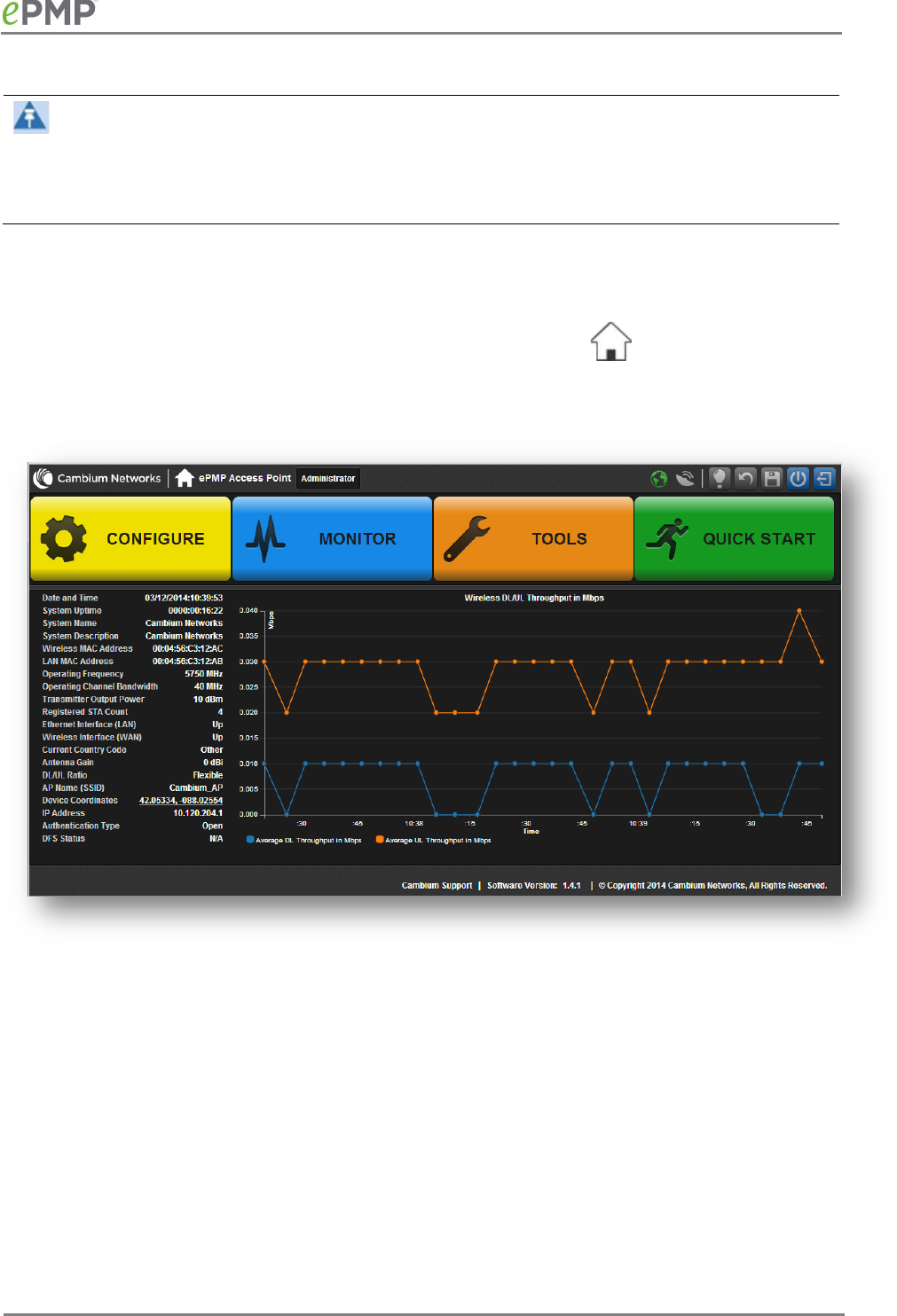
CAMBIUM NETWORKS
Note
New ePMP devices all contain default username and password configurations. It is
recommended to change these password configurations immediately. These passwords may be
configured in the management GUI in section
Configure
,
System
,
User Management
LAYOUT OF THE WEB INTERFACE
After logging in, the web interface first displays a dashboard view of vital system status and
statistics. Also, the first level of navigation is displayed across the top (
Configure
,
Monitor
,
Tools
,
and
Quick Start
). To return to this display at any time, click the Home icon or device name
(i.e. “ePMP Access Point”)
Figure 13
GUI dashboard
76
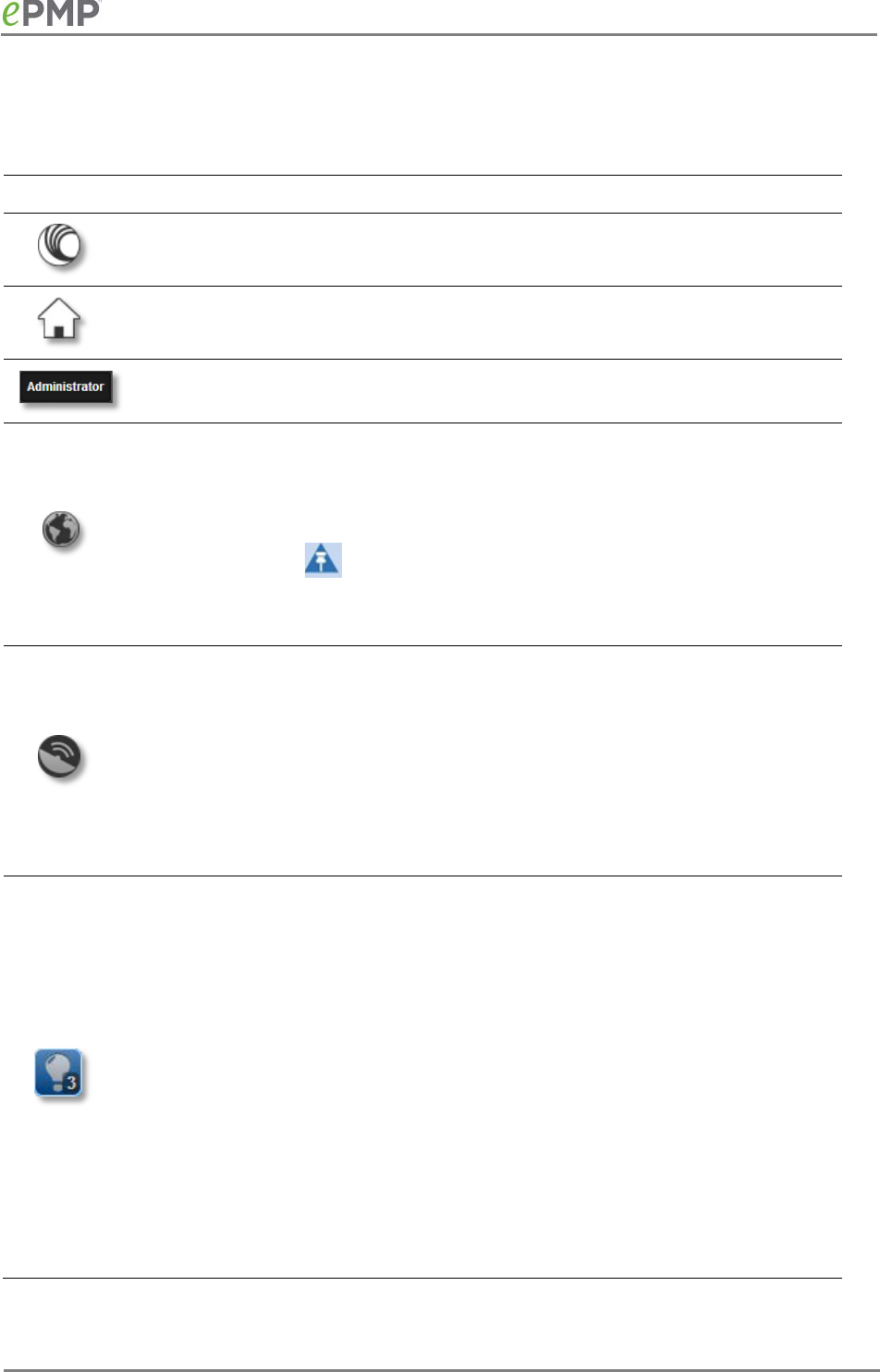
CAMBIUM NETWORKS
The top of the interface contains the following attributes:
Table 41
GUI status bar attributes
Icon
Attribute
Meaning
Cambium
Networks logo
Hyperlink to the Cambium Networks website.
Home Icon Link to the device dashboard.
Login Level
indicator
Displays the current user login level.
Internet
Connectivity
Indicator
Green
indicates that the AP has IP connectivity to the
configured DNS server.
Grey
indicates that the AP has no IP connectivity to the
configured DNS server.
Note
The Internet Connectivity Indicator state is determined by
receipt of ping responses from the configured DNS server.
GPS
Synchronization
Receive Indicator
Green
indicates that the AP is receiving a valid GPS
synchronization timing pulse via a connected GPS antenna
or a CMM.
Red
indicates that the AP is not receiving GPS
synchronization due to lack of satellite fix.
Grey
indicates that the AP is not receiving GPS
synchronization due to configuration of
Synchronization
Source
to
Internal
.
Notifications
Button
The Notifications button may be clicked to display system
messaging. When a new notification is available, the icon is
highlighted and displays the number of notifications
available. The outer icon highlighting indicates the type of
notification pending:
Green
: Successful operation has completed (i.e. Changes
successfully saved)
Grey
: Informational message (i.e. tips regarding GUI
operation)
Blue
: Operations information message (i.e. Initializing
upgrade…)
Orange
: Warning message (i.e. Login session has expired)
Red
: Error message (i.e. Software update file download
failed)
77
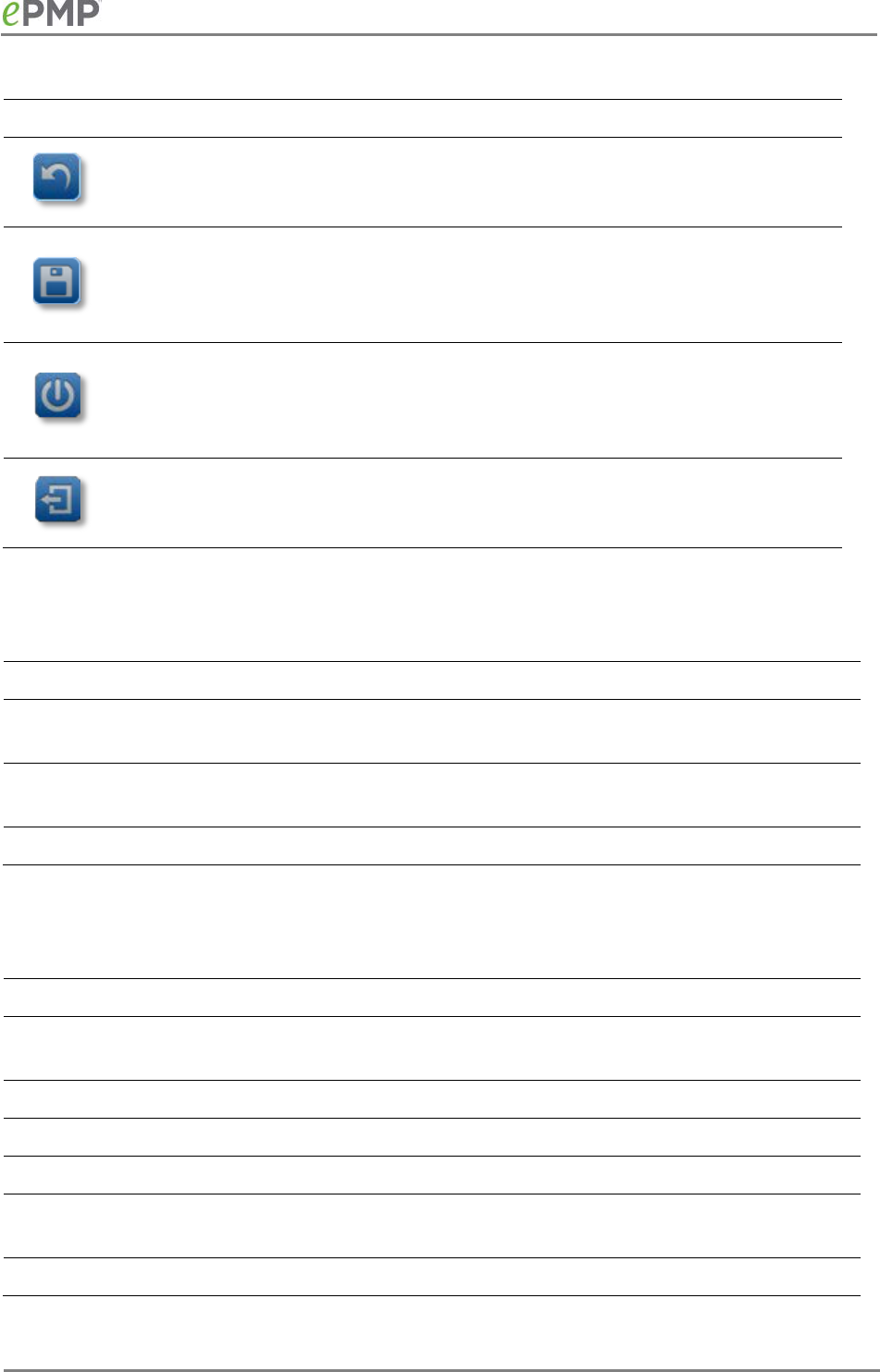
CAMBIUM NETWORKS
Icon
Attribute
Meaning
Undo Button
The Undo button may be used to undo changes prior to a
Save operation. All changes made on any section of the GUI
are undone.
Save Button
The Save button is used to commit configuration changes
to the device. When configuration changes are made, the
outer area of the icon is highlighted blue to indicate that a
save operation is required.
Reset Button
The Reset button is used to reset the device. When a
configuration change requires a radio reset, the outer area
of this icon is highlighted orange to indicate that a reset is
necessary to complete the change.
Logout Button
The Logout button is used to logout from the current
session and return to the initial GUI landing page (login
screen).
The bottom of the interface contains the following attributes:
Table 42
GUI footer attributes
Attribute
Meaning
Cambium Support
link
Hyperlink to the Cambium Networks support website.
Software Version
link
The current software version is reported in the footer bar, and may be
clicked to navigate to the Cambium Networks software support website.
Copyright Copyright information.
The AP dashboard contains the following attributes:
Table 43
AP dashboard attributes
Attribute
Meaning
Date and Time The current date and time on the device, subject to the configuration of
parameter
Time Zone
System Uptime The total uptime of the radio since the last reset.
System Name The current configured system name.
System Description The current configured system description.
Wireless MAC
Address
The MAC address of the device wireless interface.
LAN MAC Address The MAC address of the device LAN (Ethernet) interface.
78

CAMBIUM NETWORKS
Attribute
Meaning
Operating
Frequency
The current frequency carrier used for radio transmission, based on the
configuration of the
Frequency Carrier
parameter (in DFS regions, if a
radar has been detected, this field may display either
DFS Alternate
Frequency Carrier 1
or
DFS Alternate Frequency Carrier 2
).
Operating Channel
Bandwidth
The current channel bandwidth used for radio transmission, based on
the configuration of the
Channel Bandwidth
parameter.
Transmitter Output
Power
The current operating transmit power of the AP.
Registered STA
Count
The total number of STAs currently registered to the STA.
Ethernet Interface
(LAN)
Up
: The Ethernet (LAN) interface is functioning properly
Down
: The Ethernet (LAN) interface has encountered an error and is not
servicing traffic.
Wireless Interface
(LAN)
Up
: The radio (WAN) interface is functioning properly
Down
: The radio (WAN) interface has encountered an error and is not
servicing traffic.
Current Country
Code
The current configured country code, which has an effect on DFS
operation and transmit power restrictions. Registered Stations will
inherit this country code when registration is complete (unless STA is
locked to US region).
Antenna Gain The configured gain of the external antenna.
DL/UL Ratio The current configured schedule of downlink traffic to uplink traffic on
the radio link. In other words, this ratio represents the amount of the
total radio link’s aggregate throughput that will be used for downlink
resources, and the amount of the total radio link’s aggregate throughput
that will be used for uplink resources.
AP Name (SSID) The current configured name/SSID of the AP.
Device Coordinates The current configured Latitude and Longitude coordinates in decimal
format.
IP Address The current configured device IP address (LAN) used for management
access.
Authentication Type The current configured authentication type used for radio link encryption
as well as STA authentication.
DFS Status Current DFS operational status.
79
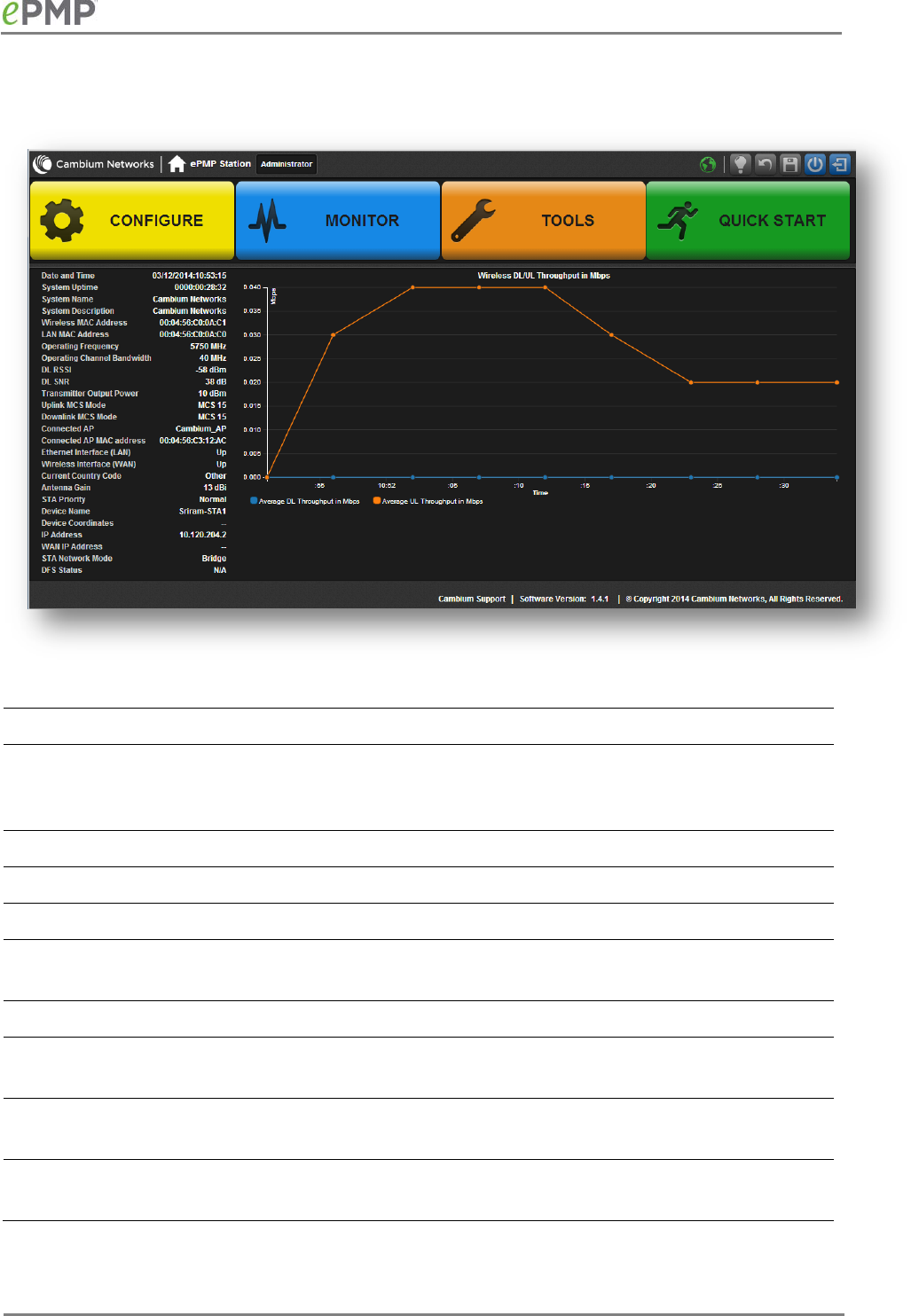
CAMBIUM NETWORKS
The STA dashboard consists of the following attributes:
Table 44
STA dashboard attributes
Attribute
Meaning
Date and Time The current date and time on the device, subject to the configuration of
parameter
Time Zone.
If an NTP server is not specified, the date and time
will begin from factory default upon radio startup.
System Uptime The total uptime of the radio since the last reset.
System Name The current configured system name.
System Description The current configured system description
Wireless MAC
Address
The MAC address of the device Wireless interface.
LAN MAC Address The MAC address of the device LAN (Ethernet) interface.
Operating
Frequency
The current operating frequency.
Operating Channel
Bandwidth
The current operating width of the channel used for the radio link.
DL RSSI The Received Signal Strength Indicator, which is a measurement of the
power level being received by the STA’s antenna.
80

CAMBIUM NETWORKS
Attribute
Meaning
DL SNR The Signal to Noise Ratio, which is an expression of the carrier signal
quality with respect to signal noise and co-channel interference (or both).
Transmitter Output
Power
The current power level at which the STA is transmitting (which is
adjusted dynamically by the AP based on radio conditions).
Uplink MCS Mode Modulation and Coding Scheme – indicates the modulation mode used
for the radio uplink, based on radio conditions (MCS 1-7, 9-15).
Downlink MCS
Mode
Modulation and Coding Scheme – indicates the modulation mode used
for the radio downlink, based on radio conditions (MCS 1-7, 9-15).
Connected AP The AP Name or SSID of the AP to which the STA is registered
Connected AP MAC
Address
The Wireless MAC Address of the AP to which the STA is registered.
Ethernet Interface
(LAN)
Up
: The Ethernet (LAN) interface is functioning properly.
Down
: The Ethernet (LAN) interface has encountered an error and is not
servicing traffic.
Wireless Interface
(WAN)
Up
: The radio (WAN) interface is functioning properly.
Down
: The radio (WAN) interface has encountered an error and is not
servicing traffic.
Current Country
Code
The current configured country code, which has an effect on DFS
operation and transmit power restrictions. Registered Stations will inherit
this country code when registration is complete (unless STA is locked to
US region).
Antenna Gain The configured gain of the external antenna.
STA Priority The configured priority of the STA in the sector.
Device Name The configured device name of the STA, used for identifying the device in
an NMS such as the Cambium Network Services Server (CNSS).
Device Coordinates The current configured Latitude and Longitude coordinates in decimal
format.
IP Address The current configured device IP address (LAN, Ethernet interface) used
for management access.
WAN IP Address The current configured device IP address (Wireless interface).
STA Network Mode
Bridge:
The STA will act as a switch, and packets are forwarded or filtered
based on their MAC destination address.
NAT:
The STA will act as a router, and packets are forwarded or filtered
based on their IP header (source or destination) which can be grouped
into subnets for finer granularity.
DFS Status Current DFS operational status.
81
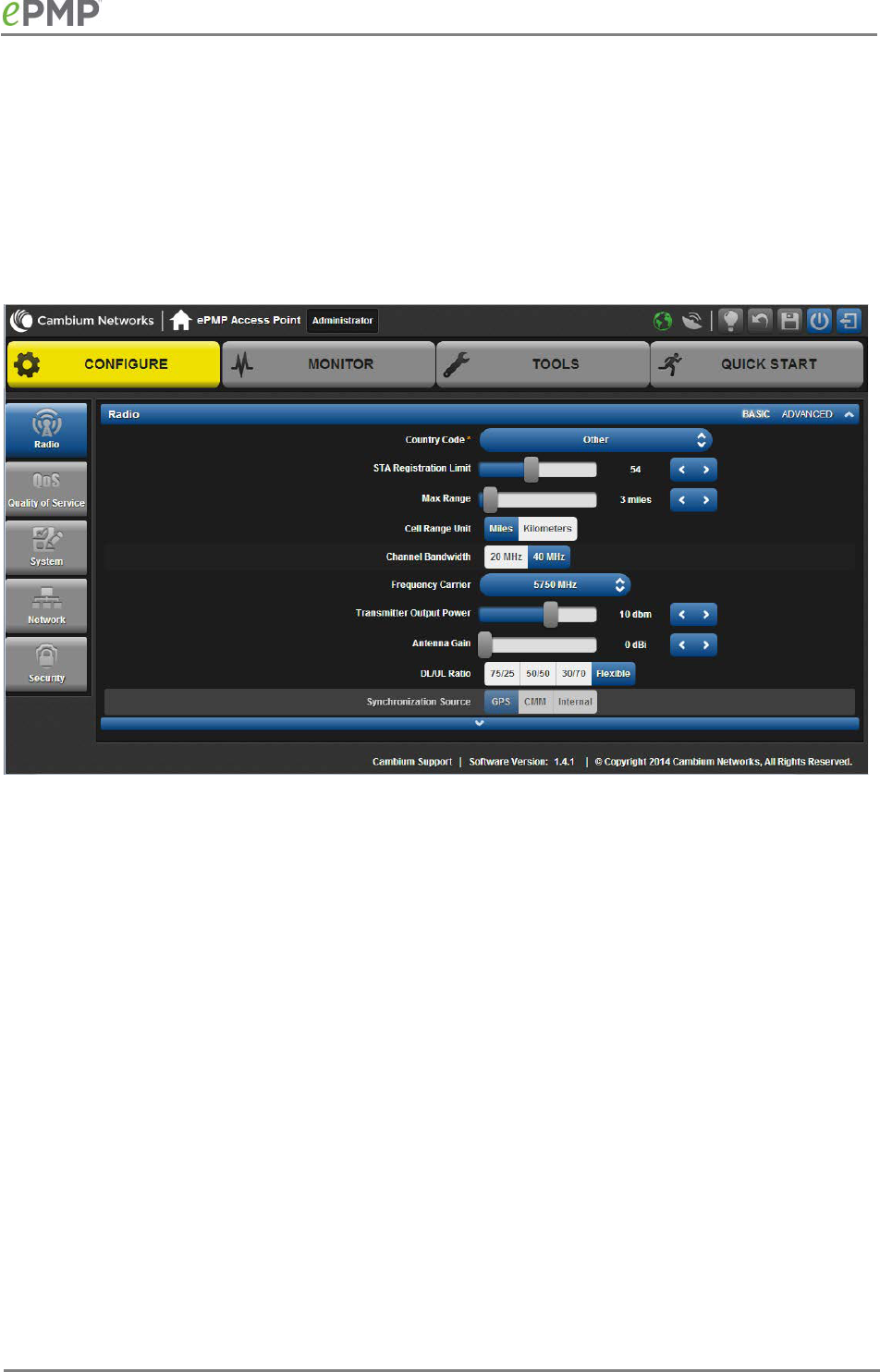
CAMBIUM NETWORKS
The GUI interface consists of two levels of navigation – the first-level navigation buttons on the top
(
Configure
,
Monitor
,
Tools
, and
Quick Start
) as well as the context-based second-level navigations
on the left-hand side of the interface. After a second-level navigation section has been chosen, the
resulting configuration parameters are displayed in the main GUI pane. Each subsection of
parameters may be configured to display a clean view of only basic parameters, or the display
may also be configured to display a comprehensive listing of advanced parameters.
Figure 14
GUI first-level and second-level navigation
82
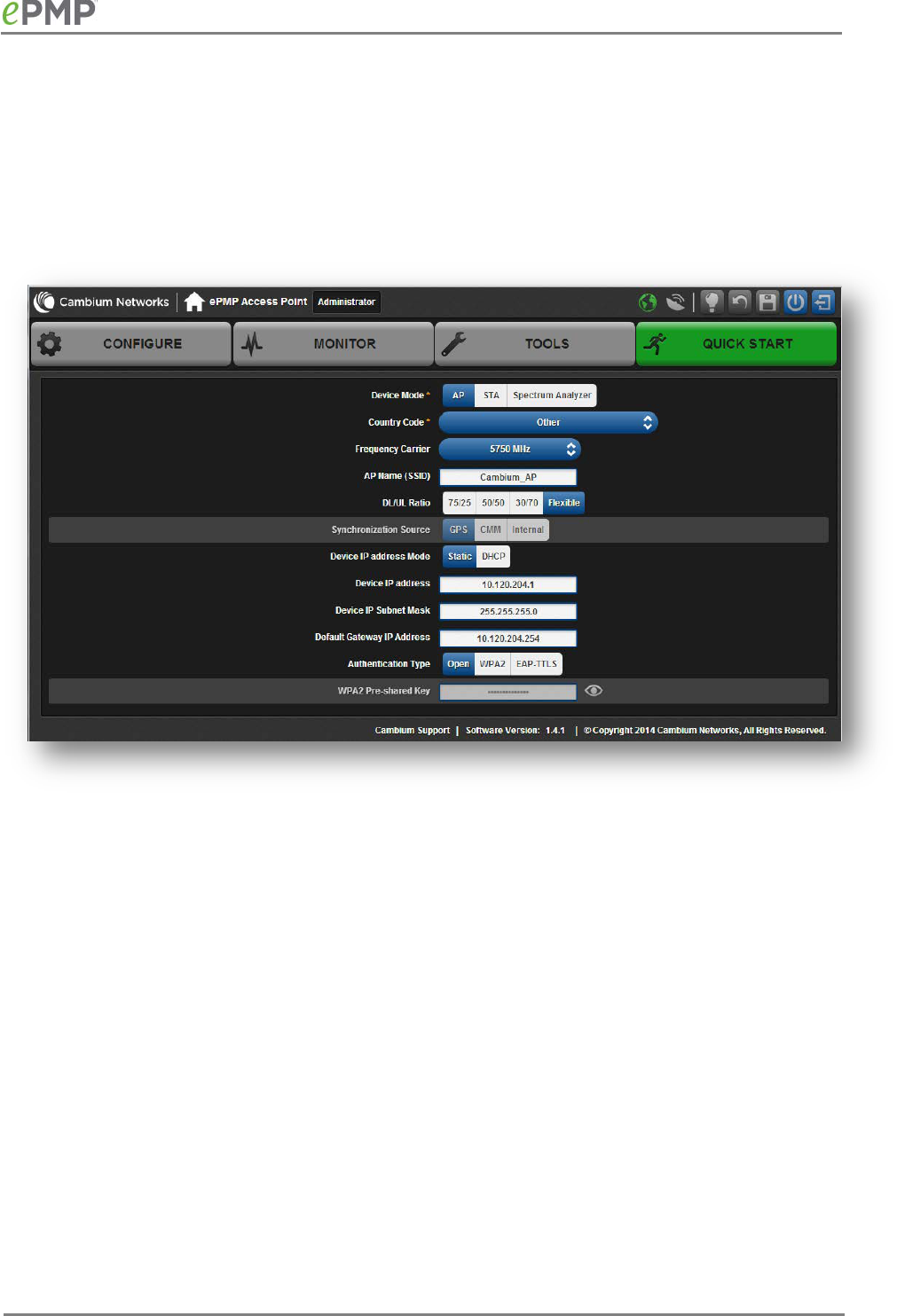
CAMBIUM NETWORKS
Configuring connectorized radios using the Quick Start menu
The Quick Start tab contains a listing of parameters required to configure a simple radio link and to
configure requisite networking parameters. After configuring an AP and STA and resetting both
devices, the STA will be ready to associate (register) to the AP.
Figure 15
AP Quick Start menu
To configure an AP via the Quick Start menu, follow this:
Procedure:
1
Start the web browser from the management PC.
2
Navigate to menu Quick Start
3
Configure parameter
Device Mode:
This parameter controls the function of the device
– all ePMP devices may be configured to
operate as an Access Point (AP), Station (STA), or
as a Spectrum Analyzer. For initial link
bring
-up, choose
AP
83

CAMBIUM NETWORKS
4
Configure parameter Country Code
:
Country Code
settings affect the radios in the following ways:
•
Maximum transmit power limiting (based on radio transmitter power plus configured
antenna gain)
• DFS operation is enabled based on the configured country code, if applicable
• Frequency selection limiting (based on valid frequencies for the configured
Country
Code
)
Select the country in which your network will be operating.
5
Configure parameter Frequency Carrier
:
Configure the frequency carrier for RF transmission. This list is dynamically adjusted to the
regional restrictions based on the setting of the Country Code
parameter. Ensure that a
thorough spectrum analysis has be
en completed prior to configuring this parameter.
6
Configure parameter AP Name (SSID)
:
The AP Name (SSID)
is used to identify the AP, and is used to configure the STA with the
appropriate AP with which to register.
Ensure that this parameter is configured uniquely for
each AP in the network.
7
Configure parameter DL/UL Ratio
:
Specify the percentage of the aggregate throughput for the downlink (frames transmitted
from the AP to the STA). For example, if the aggregate (uplink and downlink total)
throughput on the AP is 90 Mb, then 75/25 specified for this parameter allocates 67.5 Mb for
the downlink and 22.5 Mb for the uplink. The default for this parameter is 75/25.
Caution
You must set this parameter exactly the same for all APs in a cluster.
8
Configure parameter Synchronization Source
:
This parameter defines the timing source for the device which can be GPS
-based or
internally generated. Select GPS
if the AP will receive synchronization pulses from a
connected GPS antenna. Select CMM
if the device will receive GPS synchronization pulses
from a co
-located Cambium Cluster Management Module (see PMP Synchronization
Solutions User Guide
). Select
Internal
if no GPS synchronization source is available (in this
mode, transmission between co
-located devices will create radio interference). If
Flexible
is
chosen as the DL/UL Ratio
, then this parameter will be greyed out.
9
Configure parameter Device IP address Mode
:
If DHCP
is selected, the DHCP server automatically assigns the IP configuration (Ethernet
(LAN) IP Address, Ethernet (LAN) IP Subnet Mask, Gateway IP Address (LAN)) and the values
of those individual parameters (below) are not used. To configure a simple test network,
select mode Static
.
10
Configure parameter Device IP address
:
Internet Protocol (IP) address. This address is used by the family of Internet protocols to
uniquely identify this unit on a network. To configure a simple test network, this field may be
left at default (192.168.0.1).
84

CAMBIUM NETWORKS
11
Configure parameter Device IP Subnet Mask
:
The Subnet Mask defines the address range of the connected IP network.
To configure a
simple test network, this field may be left at default (255.255.255.0).
12
Configure parameter Device
Gateway IP Address
:
The IP address of a computer
on the current network that acts as a gateway. A gateway acts
as an entrance and exit to packets from and to other networks.
To configure a simple test
network, this parameter may be left at default (blank).
13
Configure para
meter
Authentication Type
Open
: All STAs requesting network entry are allowed registration.
WPA2:
The WPA2 mechanism provides AES radio link encryption and STA network entry
authentication.
When enabled, the STA must register using the
Authentication Pre-shared
Key
configured on the AP and STA.
14
Configure parameter Authentication Pre-shared Key
Configure this key on the AP, then configure each of the network STAs with this key to
complete the authentication configuration.
This key must be between 8 to 128 symbols. Click
the visibility icon
to toggle the display of the key’s contents.
15
Click the Save
icon, then click the
Reset
icon
85
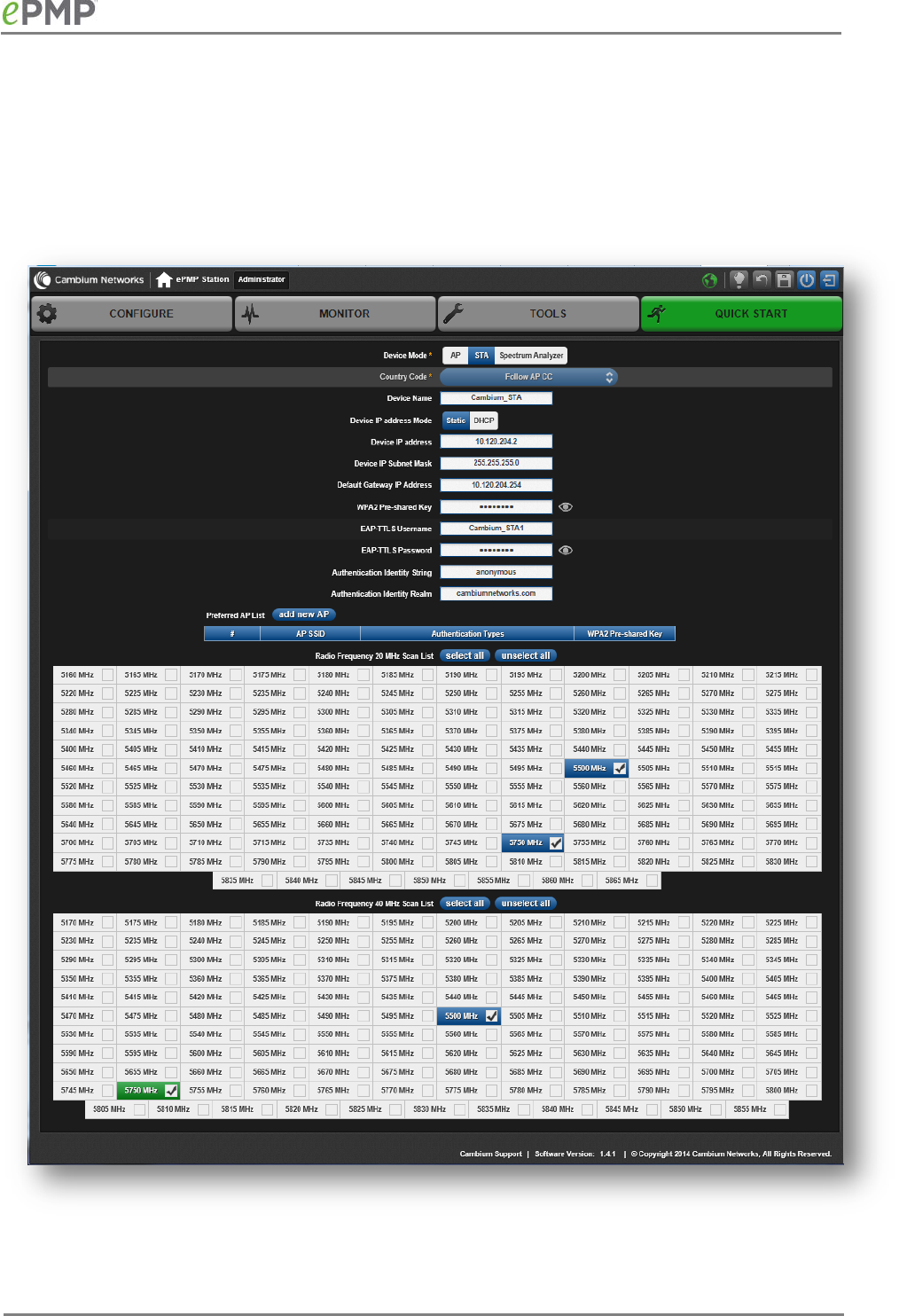
CAMBIUM NETWORKS
Configuring STA units using the Quick Start menu
The Quick Start tab contains a simple listing of parameters required to configure a simple radio
link and to configure requisite networking parameters.
Figure 16
STA Quick Start menu
86

CAMBIUM NETWORKS
To configure an STA via the Quick Start menu, follow this:
Procedure:
1
Start the web browser from the management PC.
2
Navigate to menu Quick Start
3
Configure parameter Device Mode
:
This parameter controls the function of the device
– all ePMP devices may be configured to operate
as an Access Point (AP), Station (STA), or as a Spectrum Analyzer. For initial link bring
-up, choose
STA
4
The Country Code
is automatically retrieved from the AP, and does not require configuration.
Country Code
settings affect the radios in the following ways:
• Maximum transmit power limiting (based on radio transmitter power plus configured
antenna gain)
• DFS operation is enabled based on the configured country code, if applicable
• Frequency range of operation depending on local limitations
5
Configure parameter Device Name
:
The STA Device Name is used to identify the device on the network. This parameter may be
modified or left at the default value of Cambium-STA
.
6
Configure parameter Device
IP Address Mode
:
If DHCP
is selected, the DHCP server automatically assigns the IP configuration (Ethernet (LAN) IP
Address, Ethernet (LAN) IP Subnet Mask, Gateway IP Address (LAN)) and the values of those
individual parameters (below) are not used. To configure a simple test net
work, this parameter must
be configured to Static.
7
Configure parameter Device IP Address
:
Internet Protocol (IP) address
. This address is used by the family of Internet protocols to uniquely
identify this unit on a network.
To configure a simple test network, this field must be configured to
192.168.0.2.
8
Configure parameter Device IP Subnet Mask
:
The Subnet Mask defines the address range of the connected IP network.
To configure a simple test
network, this field may be left at
default (255.255.255.0).
9
Configure parameter Device Gateway IP Address
:
The IP address of a computer
on the current network that acts as a gateway. A gateway acts as an
entrance and exit to packets from and to other networks.
To configure a simple test network, this
parameter may be left at default (blank).
10
Configure parameter WPA2 Pre-shared Key:
Configure each of the network STAs with this key
(matching the AP’s configured key) to complete
the authentication configuration.
This key must be between 8 to 128 symbols. Click the visibility icon
to toggle the display of the key’s contents.
87

CAMBIUM NETWORKS
11
Configure parameter EAP-TTLS Username:
Configure each of the network STAs with this
EAP-TTLS Username (matching the credentials on the
Radius server being use
d for the network).
12
Configure parameter EAP-TTLS Password:
Configure each of the network STAs with this
EAP-TTLS Password (matching the credentials on the
Radius server being used for the network). Click the visibility icon
to toggle the display of the
password’s contents.
13
Configure parameter Authentication Identity String:
Configure each of the network STAs with this
Identity string (matching the credentials on the Radius
server being used for the network
). Default value for this parameter is “anonymous”.
14
Configure parameter Authentication Identity Realm:
Configure each of the network STAs with this
Identity realm (matching the credentials on the Radius
server being used for the network)
. Default value for this parameter is “cambiumnetworks.com”.
15
Configure the Preferred AP List
The Preferred AP List
is comprised of a list of up to 16 APs to which the STA sequentially attempts
registration. For each AP configured, if authentication is required, enter a Pre-shared Key
associated
with the configured AP SSID
.
If this list is empty, or if none of the configured APs are found, the STA
will scan and register to the first AP found (with matching radio and/or authentication settings).
16
Configure parameter Radio Frequency 20 MHz and 40MHz Scan List
:
The Radio Scan List determines the frequencies for which the STA will scan for AP signaling. For a
simple radio network setup, click Select All
to scan all frequencies.
17
Click the Save
icon, then click the
Reset
icon
88

CAMBIUM NETWORKS
Using the AP menu options
Use the menu navigation bar in the top and left panels to navigate to each web page.
Table 45
lists
the functional areas that may be accessed from each menu option. Some of the parameters are
only displayed for specific system configurations.
Table 45
Functional areas accessed from each menu option
Menu option
Menu Details
Configure
AP Configure menu
on page
90
Radio
AP Radio page
on page
91
Quality of Service
AP Quality of Service page
on page
100
System
AP System page
on page
104
Network
AP Network page
on page
108
Security
AP Security page
on page
111
Monitor
AP Monitor menu
on page
116
Performance
AP Performance page
on page
117
System Status
AP System Status page
on page
120
Wireless Status
AP Wireless Status page
on page
122
GPS Status
AP GPS Status page
on page
124
Network Status
AP Network Status page
on page
126
System Log
AP System Log page
on page
128
Tools
AP Tools menu
on page
129
Software Upgrade
AP Software Upgrade page
on page
130
Factory Default
AP Factory Default page
on page
132
Spectrum Analyzer
AP Spectrum Analyzer page
on page
133
Throughput Test
AP Throughput Test page
on page
136
Ping
AP Ping page
on page
137
Traceroute
AP Traceroute page
on page
138
Quick Start
Configuring connectorized radios using the Quick Start menu
on page
83
89

CAMBIUM NETWORKS
AP CONFIGURE MENU
Use the Configure menu to access all applicable device configuration parameters. The
configuration menu contains the following pages:
•
AP Radio page
on page
91
•
AP Quality of Service page
on page
100
•
AP System page
on page
104
•
AP Network page
on page
108
•
AP Security page
on page
111
90
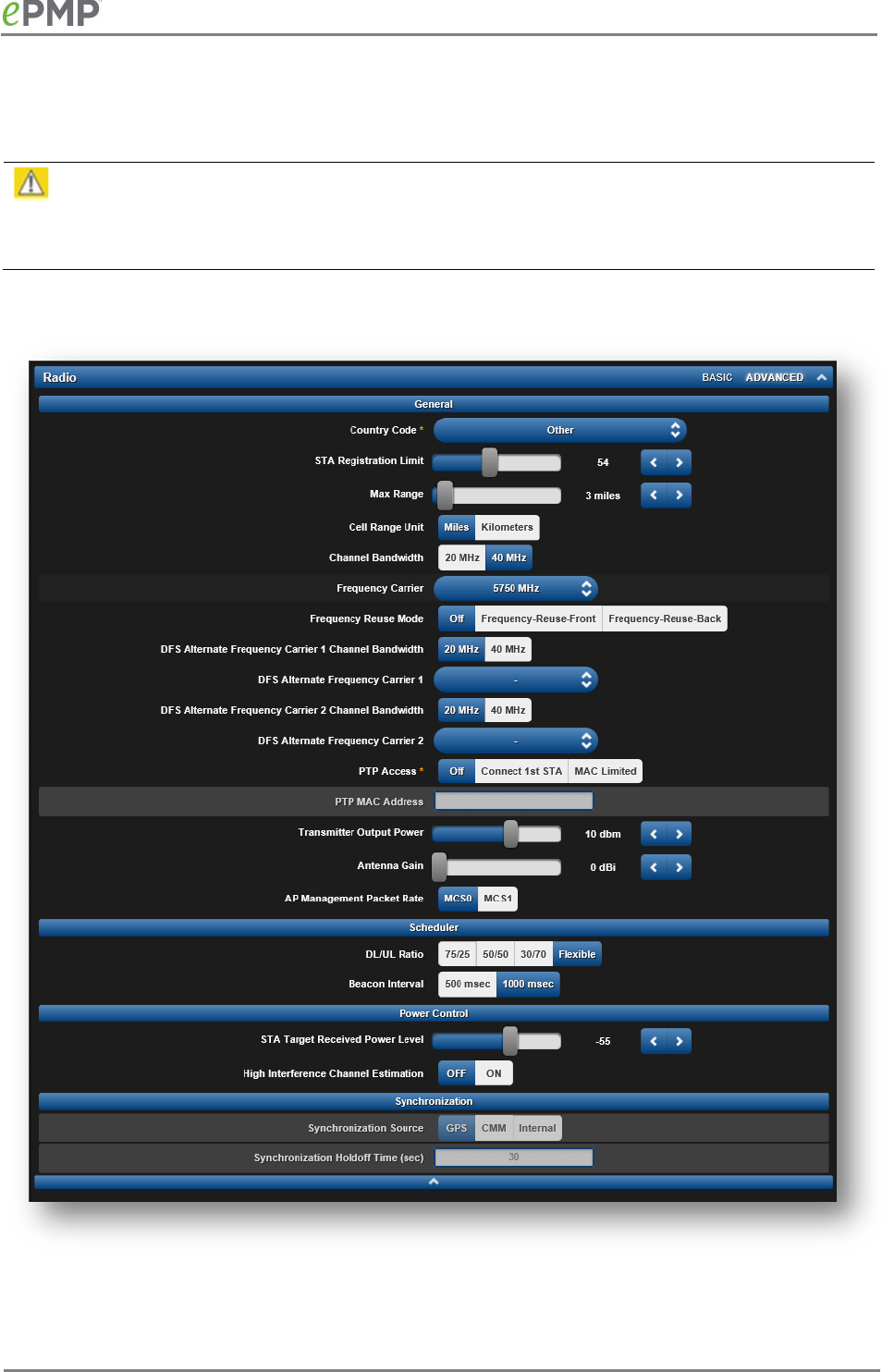
CAMBIUM NETWORKS
AP Radio page
Use the Radio page to configure the device radio interface parameters.
Caution
Modifying radio parameters may result in a wireless outage. Plan configuration modifications
accordingly.
Figure
17
AP Radio page
91

CAMBIUM NETWORKS
Table 46
AP Radio Configuration attributes
Attribute
Meaning
Country Code From the drop-down list, select the country in which the radio is
operating.
Country Code settings affect the radios in the following ways:
• Maximum transmit power limiting (based on radio transmitter power
plus configured antenna gain)
• DFS operation is enabled based on the configured country code, if
applicable
• Frequency selection limiting, based on regional limitations
STA Registration
Limit
Based on sector/network planning and STA service level
implementations, set the
STA Registration Limit
to the maximum
allowed number of STAs that are allowed network entry. Default 60.
Max Range Enter a number of miles or kilometers for the furthest distance from
which an STA is allowed to register to this AP. Do not set the distance to
any greater number of miles. A greater distance
• does not increase the power of transmission from the AP.
• can reduce aggregate throughput.
Regardless of this distance, the STA must meet the minimum
requirements for an acceptable link. The AP will reject any STA network
entry attempts from outside the configured maximum range. Default 3
miles.
Caution
If the AP is in cluster or is in range of another AP, then you must set this
parameter on all other APs in the cluster and in range exactly the same.
Otherwise, overlapping RF transmissions will introduce system
interference.
Cell Range Unit
Miles
: The
Max Range
setting and resulting frame calculations are
configured in units of miles
Kilometers
: The
Kilometers
setting and resulting frame calculations are
configured in units of kilometers
Channel Bandwidth Configure the channel size used by the radio for RF transmission. This
value must match between the AP and STAs.
Frequency Carrier Configure the frequency carrier for RF transmission. This list is
dynamically adjusted to the regional restrictions based on the setting of
the
Country Code
parameter.
92

CAMBIUM NETWORKS
Frequency Reuse
Mode
The Frequency Reuse Mode parameter allows operators to define which
APs are co-located (or within radio range) with other APs. This definition
results in an automatic radio network modification such that self-
interference is reduced amongst the co-located sectors.
Figure 18
depicts a network in which two frequencies “F`1” and “F2” are
reused throughout the deployment.
Figure 18
Frequency reuse deployment
F1
F1
F2
F2
F1
F1
F2
F2
F1
F1
F2
F2
F1
F1
F2
F2
F1
F1
F2
F2
The set of APs to configure the
Frequency Reuse Mode
option on is
dependent on the GPS synchronization sources in the whole network,
CMM3, CMM4 or “onboard GPS” (GUI options are:
GPS
or
CMM
).
The GPS sync source is the same on all APs or is a
combination of “onboard GPS” and CMM4
In this configuration the GPS synchronization source in the whole
network is one of the following:
1- “onboard GPS” or
2- CMM4 or
3- CMM3 or
4- Mix of “onboard GPS” and CMM4 (but NOT CMM3)
Figure 19
demonstrates how to configure
Frequency Reuse Mode
to
ensure that interference is reduced throughout the deployment:
93

CAMBIUM NETWORKS
Figure 19
Frequency reuse configuration example
F1
F1
F2
F2
F1
F1
F2
F2
F1
F1
F2
F2
FR: Front
FR: Front
FR: Front
FR: Back
FR: Front
FR: Front
FR: Back
FR: Front
FR: Back FR: Back
FR: Back
FR: Back
F1
F1
F2
F2
FR: Back
FR: Front
FR: Back
FR: Front
F1
F1
F2
F2
FR: Front
FR: Front
FR: Back
FR: Back
The rules in selecting the APs to enabling the
Frequency Reuse Mode
in
this deployment are:
1- Only ONE of the APs on the same tower configured with the
same frequency must be configured with the
Frequency Reuse
Mode
parameter set to
Frequency-Reuse-Back
; the other AP shall
be configured with
Frequency Reuse Mode
set to
Frequency-
Reuse-Front
.
2- Only ONE of the APs on different towers facing each other with
overlapped coverage must be configured with
Frequency Reuse
Mode
set to
Frequency-Reuse-Back.
The GPS sync source is a mixture of all types (CMM3, CMM4
& “onboard GPS”)
In this configuration the GPS sync source in the whole network is one of
the following:
1- (CMM3 and “onboard GPS”) or
2- (CMM3 and CMM4) or
3- (CMM3 and CMM4 and “onboard GPS”)
Figure 20
and
Figure 21
show examples of which APs to enable the
Frequency Reuse Mode
feature in this mixture of sync sources.
94
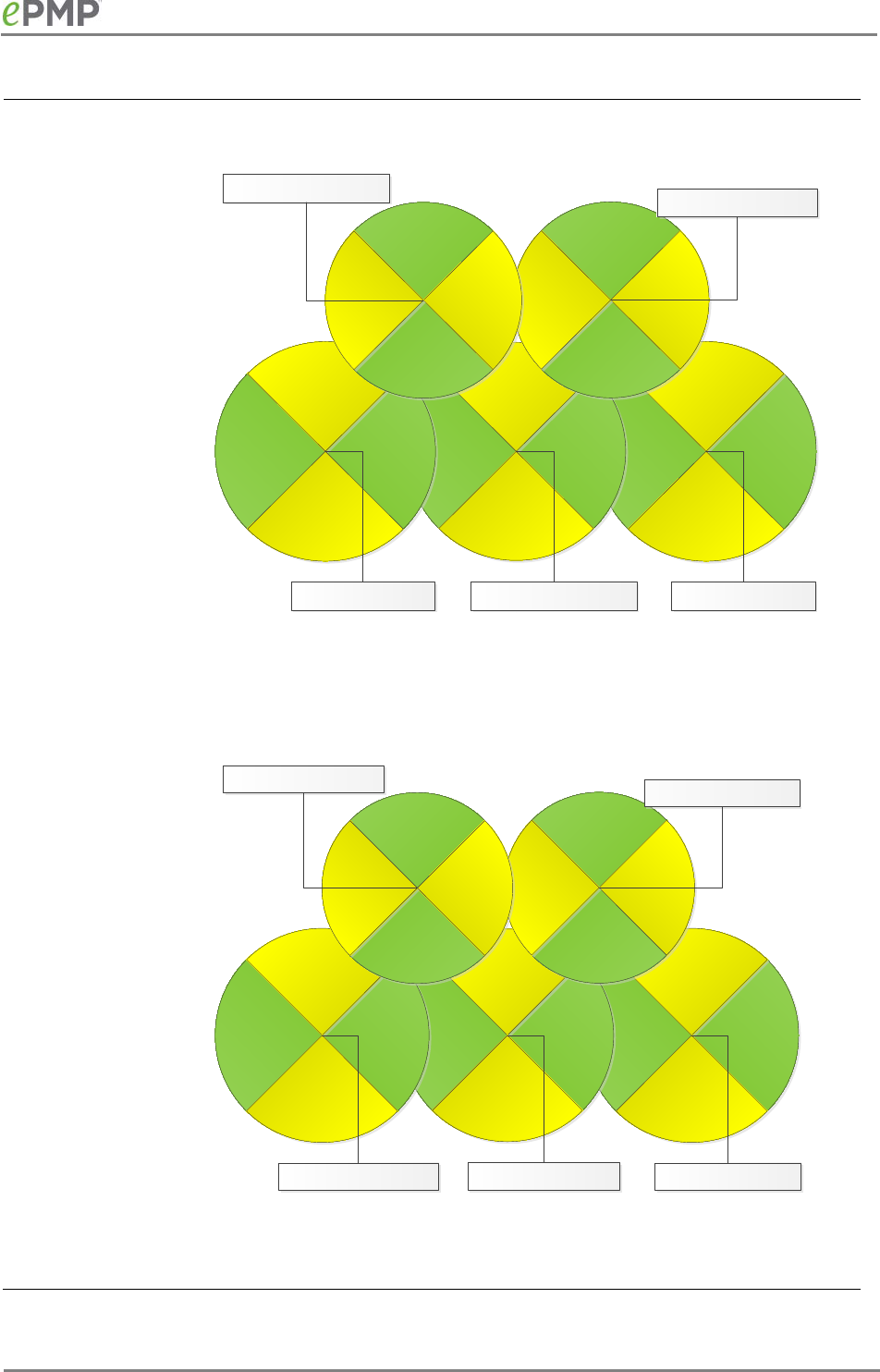
CAMBIUM NETWORKS
Figure 20
Example 1 - Frequency reuse configuration, mixture of GPS
synchronization sources
F1
F1
F2
F2
F1
F1
F2
F2
F1
F1
F2
F2
FR: Front
FR: Front
FR: Back
FR: Front
FR: Front
FR: Back
FR: Front
FR: Front
FR: Back FR: Back
FR: Back
FR: Back
SYNC Source = GPS/CMM4
SYNC Source = CMM3
SYNC Source = GPS/CMM4
F1
F1
F2
F2
SYNC Source = CMM3
FR: Back
FR: Front
FR: Back
FR: Front
F1
F1
F2
F2
SYNC Source = GPS/CMM4
FR: Front FR: Back
FR: Front FR: back
Figure 21
Example 2 - Frequency Reuse Configuration with Mixture of
GPS sources
F1
F1
F2
F2
F1
F1
F2
F2
F1
F1
F2
F2
FR: Front
FR: Front
FR: Front
FR: Back
FR: Front
FR: Back
FR: Front
FR: Front
FR: Back FR: Back
FR: Back
FR: Back
SYNC Source = GPS/CMM4
SYNC Source = CMM3
SYNC Source = CMM3
F1
F1
F2
F2
SYNC Source = GPS/CMM4
FR: Front
FR: Back
FR: Back
FR: Front
F1
F1
F2
F2
SYNC Source = GPS/CMM4
FR: Front FR: Back
FR: Front FR: Back
95

CAMBIUM NETWORKS
The rules in selecting the APs to configure Frequency Reuse Mode to
Frequency Reuse Mode
to
Frequency-Reuse-Front
or
Frequency-Reuse-
Back
in a mixture of sync sources deployments are:
1- Only ONE of the APs on the same tower configured with the
same frequency must have
Frequency Reuse Mode
set to
Frequency-Reuse-Back
if the sync source of both APs is the same
or the sync is a combination of “onboard GPS” and CMM4; the
other AP shall have the
Frequency-Reuse-Front
ON.
2- For the APs on different towers facing each other with
overlapped coverage:
a. If both APs have the same sync source then only ONE of
them must have the
Frequency-Reuse-Back
ON; the other
AP shall have the
Frequency-Reuse–Front
ON.
b. If one AP has “onboard GPS” as sync source and the
other one has CMM4 then only ONE of them must have
Frequency-Reuse - Back
ON; the other AP shall have
Frequency-Reuse-Front
ON.
c. If one AP has “onboard GPS” or CMM4 as sync source
and the other one has CMM3 then:
i. If the AP with CMM3 sync source has
Frequency-
Reuse-Back
ON, then the other AP (with “onboard
GPS” or CMM4 sync source) must have the
Frequency-Reuse-Back
ON.
ii. If the AP with CMM3 sync source has
Frequency
Reuse Mode
set to
Off
, then the other AP (with
“onboard GPS” or CMM4 sync source) must have
Frequency Reuse Mode
set to
Off.
DFS Alternate
Frequency Carrier 1
Channel Bandwidth
Configure the first channel bandwidth configuration that will be used for
RF transmission if DFS detection causes the radio to switch from using
the channel bandwidth configured in
Channel Bandwidth
.
DFS Alternate
Frequency Carrier 1
Configure the first frequency that will be used for RF transmission if DFS
detection causes the radio to switch from using the frequency
configured in
Frequency Carrier
. It is important to set this frequency
also in the
STA
Scan List
.
DFS Alternate
Frequency Carrier 2
Configure the second channel bandwidth configuration that will be used
for RF transmission if a DFS detection causes the radio to switch from
96

CAMBIUM NETWORKS
Channel Bandwidth using the channel bandwidth configured in
Channel Bandwidth
.
DFS Alternate
Frequency Carrier 2
Configure the second frequency that will be used for RF transmission if a
DFS detection causes the radio to switch from using the frequencies
configured in
Frequency Carrier
and
DFS Alternate Frequency Carrier 2
.
It is important to set this frequency also in the
STA
Scan List
.
PTP Access
Off
: The system is configured to operate in PMP mode (i.e. more than
one STA may connect to the AP)
Connect 1st STA
: The system is configured to accept only the 1st
registered STA. Network entry will be denied for all subsequent STA
network entry requests.
MAC Limited
: The system is configured to accept only one STA
registration, and this registration is limited by STA MAC Address (the
STA Wireless MAC Address).
PTP MAC Address Configure the Wireless MAC Address of the sole STA which will be
granted registration to the AP. All other network entry attempts will be
rejected by the AP. The STA’s
Preferred AP List
may be configured with
the destination point-to-point AP to ensure that the STA connects with
the intended AP.
Transmitter Output
Power
This value represents the combined power of the AP’s two transmitters.
This value may be automatically adjusted based on the configuration of
the parameter
Country Code.
Nations and regions may regulate transmitter output power. For
example
• 2.4 GHz and 5 GHz modules are available as connectorized radios,
which require the operator to adjust power to ensure regulatory
compliance.
The professional installer of the equipment has the responsibility to
• maintain awareness of applicable regulations.
• calculate the permissible transmitter output power for the module.
• confirm that the initial power setting is compliant with national or
regional regulations
• confirm that the power setting is compliant following any reset of
the module to factory defaults.
Antenna Gain This value represents the amount of gain introduced by an external
antenna (minus cable loss). This value is used in calculating the unit’s
Equivalent Isotropic Radiated Power (EIRP) level. For certain
Country
Code
configurations, the unit’s EIRP may be limited based on regional
regulations.
AP Management
Packet Rate
MCS0
: The system is configured to use MCS0 rate for all management
messages. This allows for improved link stability and range in high
interference environment.
97

CAMBIUM NETWORKS
MCS1
: The system is configured to use MCS1 rate for all management
messages. This allows for slightly higher sector throughput. This is the
default setting.
DL/UL Ratio Configure the schedule of downlink traffic to uplink traffic on the radio
link. The first three options,
75/25
,
50/50
and
30/70
, allow the radio to
operate in a fixed ratio on every frame. In other words, this ratio
represents the amount of the total radio link’s aggregate throughput that
will be used for downlink resources, and the amount of the total radio
link’s aggregate throughput that will be used for uplink resources. The
fourth option,
Flexible
, allows the radio to dynamically choose the
amount of the total radio’s aggregate throughput that will be used for
downlink and uplink resources, every frame.
Caution
Setting this parameter to
Flexible
causes the radio to operate in
unsychronized mode. For all other settings, if the AP is in cluster or is in
range of another AP, then you must set this parameter on all other APs
in the cluster and in range exactly the same. Otherwise, overlapping RF
transmissions will introduce system interference.
Beacon Interval
500 msec
: Radio beacons will be sent by the AP every 500 milliseconds.
Effectively, this configuration allows quicker STA network entry since
more beacons are available when the STA is scanning. In large network
deployments, a 500 millisecond beacon interval configuration will allow
STAs to enter the network more quickly.
1000 msec
: (Default) Radio beacons will be sent by the AP every 1000
milliseconds. In small network deployments, this setting may be
applicable as beacons are scheduled half as often as a 500 millisecond
configuration. This reduction in beacon scheduling results in a minor
increase in user data traffic rates (by ~1 packet per second).
STA Target
Received Power
Level
Each STA’s transmitter output power is automatically set by the AP. The
AP monitors the received power from each STA, and adjusts each STA’s
transmitter output power so that the received power at the AP from the
STA is not greater what is configured in
STA Target Received Power
Level
. These automatic power adjustments ensure that the STA is not
transmitting excessive energy (raising system noise level) and that the
STA is able to achieve an optimal modulation state (and maximum
achievable throughput). Target receive levels must be set to lesser than -
60 dBm nominally in order to prevent interference from co-located co-
channel sectors.
High Interference
Channel Estimation
When this feature is enabled, the receiver uses alternate channel
estimation method to improve receiver sensitivity especially at lower
MCSs in high interference environment.
Synchronization
GPS: Synchronization timing is received via the AP’s connected GPS
98

CAMBIUM NETWORKS
Source antenna. Co-located or in-range APs receiving synchronization via GPS
or CMM will transmit and receive at the same time, thereby reducing
self-interference.
CMM
: Synchronization timing is received via the AP’s Ethernet port via
a connected Cambium Cluster Management Module (CMM). Co-located
or in-range APs receiving synchronization via GPS or CMM will transmit
and receive at the same time, thereby reducing self-interference. For
more information on CMM configuration, see the PMP Synchronization
Solutions User Guide.
Caution
Verify that the cables from the CMM to the network switch are at most
30 ft (shielded) or 10 ft (unshielded) and that the network switch is not
PoE (802.3af).
Internal
: Synchronization timing is generated by the AP, and timing is
not based on GPS pulses.
Caution
APs using
Synchronization Source
of
Internal
will not transmit and
receive in sync with other co-located or in-range APs, which introduces
interference into the system.
Synchronization
Holdoff Time (sec)
The
Synchronization Holdoff Time
is designed to gracefully handle
fluctuations/losses in the GPS synchronization signaling. After the AP
has received a reliable synchronization pulse for at least 60 seconds, if
there is a loss of synchronization signal, the
Synchronization Holdoff
timer is started. During the holdoff interval, all STA registrations are
maintained. If a valid GPS synchronization pulse is regained during the
holdoff interval, then the AP continues to operate normally. If a valid
synchronization pulse is not regained from the GPS source during the
holdoff interval, then the AP ceases radio transmission. Default 30
seconds.
99
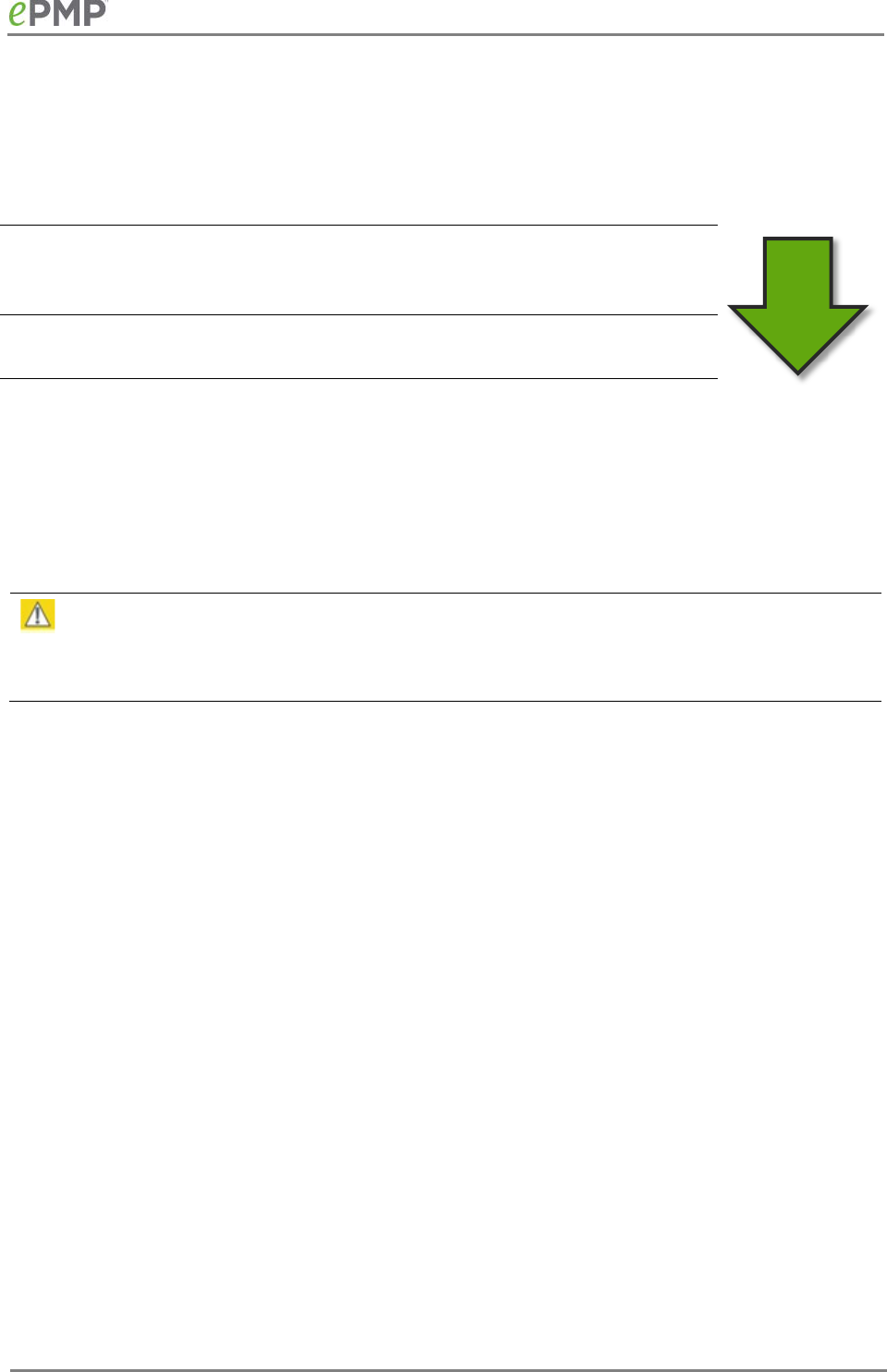
CAMBIUM NETWORKS
AP Quality of Service page
The ePMP platform supports three QoS priority levels using air fairness, priority-based starvation
avoidance scheduling algorithm:
Priority Level
ePMP Traffic Priority Label
Highest Priority (Served first) VOIP (only utilized when
VOIP Enable
is set to
Enabled
)
Medium Priority (Served once highest priority
traffic is sent)
High
Lowest Priority (Serviced once Highest and
Medium priority traffic is sent)
Low
By default, all traffic passed over the air interface is low priority. The AP’s Quality of Service page
may be utilized to map traffic to certain priority levels using QoS classification rules. The rules
included in the table are enforced starting with the first row of the table.
Caution
Each additional traffic classification rule increases device CPU utilization. Careful network traffic
planning is required to efficiently use the device processor.
The ePMP platform also supports radio data rate limiting (Maximum Information Rate, or MIR)
based on the configuration of the MIR table. Operators may add up to 16 MIR profiles on the AP,
each with unique limits for uplink and downlink data rates. The STA field
MIR Profile Setting
is
used to configure the appropriate MIR profile for limiting the STA’s data rate.
Priority
100
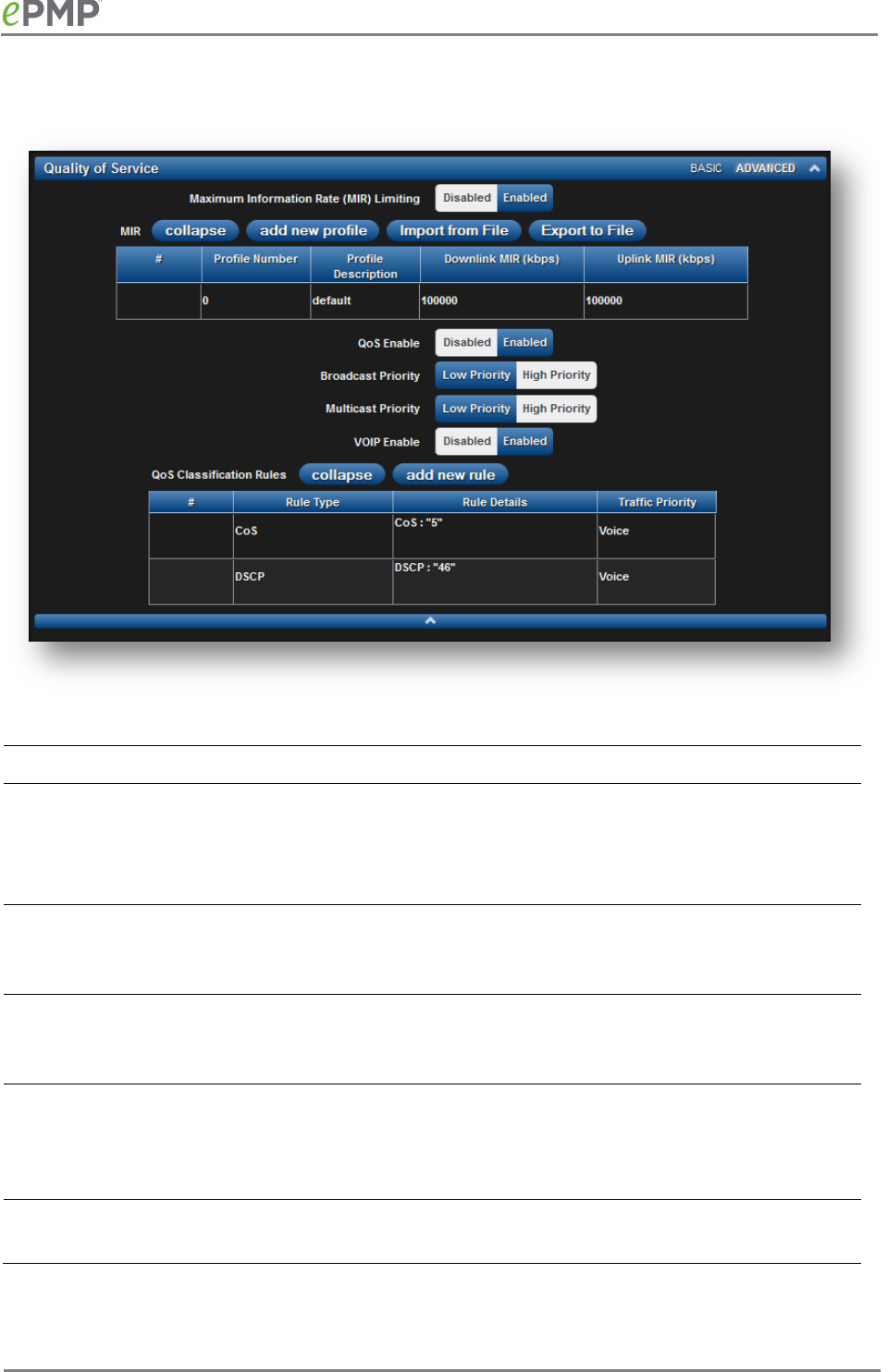
CAMBIUM NETWORKS
Figure 22
AP Quality of Service page
Table 47
AP Radio Configuration attributes
Attribute
Meaning
Maximum Information
Rate (MIR) Limiting
Disabled:
When disabled, RF transmission is only limited by the
capacity of the link (and any active QoS classification rules).
Enabled:
When enabled, all downlink and uplink traffic is limited
based on the profiles configured in the MIR table.
MIR The MIR (Maximum Information Rate) table is comprised of up to
sixteen profiles which, after configured, may be set on the STA to
employ a certain service level or data rate.
Profile Number Assign a profile number to each row in the AP MIR table. This profile
number is then set on each STA to limit data transfer rates based on
the operator’s configuration of the MIR table and its profiles.
Profile Description Assign a logical description for each service level. For example, a
tiered service-level provider may deploy service levels “Gold”,
“Silver” and “Bronze” or “20 Mbps”, “10 Mbps”, and “5 Mbps” to
offer a clear description.
Downlink MIR (kbps) Specify the downlink rate at which the AP is allowed to transmit for
this configured profile.
101

CAMBIUM NETWORKS
Attribute
Meaning
Uplink MIR (kbps) Specify the uplink rate at which the AP is allowed to transmit for this
configured profile.
QoS Enable
Enabled
: The QoS Classification Rules table is editable and is
utilized by the device to classify traffic.
Disabled
: The QoS Classification Rules table is greyed-out and all
traffic is sent at one priority level.
Broadcast Priority
Low Priority
: All Broadcast traffic sent over the downlink is
prioritized as low priority, and will be delivered to the STA after
scheduled high priority and VoIP traffic.
High Priority
: All Broadcast traffic sent over the downlink is
prioritized as high priority, and will be scheduled for delivery to
STAs before low priority traffic but after VoIP traffic.
Multicast Priority
Low Priority
: All Multicast traffic sent over the downlink is prioritized
as low priority, and will be delivered to the STA after scheduled high
priority and VoIP traffic.
High Priority
: All Multicast traffic sent over the downlink is
prioritized as high priority, and will be scheduled for delivery to
STAs before low priority traffic but after VoIP traffic.
VOIP Enable
Enabled
: When enabled, two entries are automatically added to the
first and second rows of the QoS Classification Rules table, one with
Rule Type CoS
(5) and one with
Rule Type DSCP
(46). The addition of
these rules ensures that VoIP traffic passed over the radio downlink
is given highest priority. The
CoS
and
DSCP
values may be modified
to accommodate non-standard VoIP equipment.
Disabled
: When disabled, VoIP traffic is scheduled normally along
with all other user data.
QoS Classification
Rules
The QoS Classification Rules table contains all of the rules enforced
by the device when passing traffic over the radio downlink. Traffic
passed through the device is matched against each rule in the table;
when a match is made the traffic is sent over the radio link using the
priority defined in column
Traffic Priority
.
102

CAMBIUM NETWORKS
Attribute
Meaning
Rule Type
CoS
: Class of Service; traffic prioritization is based on the 3-bit
header present in the 802.1Q VLAN-tagged Ethernet frame header in
the packet ingressing the AP’s Ethernet port.
VLAN ID:
traffic prioritization is based on the VLAN ID of the packet
ingressing the AP’s Ethernet port.
EtherType:
traffic prioritization is based on the two octet Ethertype
field in the Ethernet frame ingressing the AP’s Ethernet port. The
Ethertype is used to identify the protocol of the data in the payload
of the Ethernet frame.
IP:
traffic prioritization is based on the source and (or) destination IP
address of the packet ingressing the AP’s Ethernet port. A subnet
mask may be included to define a range of IP addresses to match.
MAC:
traffic prioritization is based on the source and (or) destination
MAC address of the packet ingressing the AP’s Ethernet port. A mask
may be included to define a range of MAC addresses to match. The
mask is made up of a hex representation of a series of 1s to start the
mask and 0s that end the mask. A 1 may not follow a 0. Thus,
FF:FF:FF:FF:00:00 is allowed, but FF:00:FF:FF:FF:FF is not. The MAC
address is combined with the mask to define the range of allowed
MAC addresses.
Rule Details The
Rule Details
column is used to configure each classification rule
specified in column
Rule Type
.
Traffic Priority
High
: Traffic ingressing the AP’s Ethernet port is prioritized as “high
priority” for sending over the radio link (traffic will be sent after
VOIP-classified traffic, but before Low-classified traffic).
Low:
Traffic ingressing the AP’s Ethernet port is prioritized as “low
priority” for sending over the radio link (traffic will be sent after
VOIP-classified and High-classified traffic is sent).
Voice: VoIP Traffic ingressing the AP’s Ethernet port is given highest
priority for sending over the radio link.
103
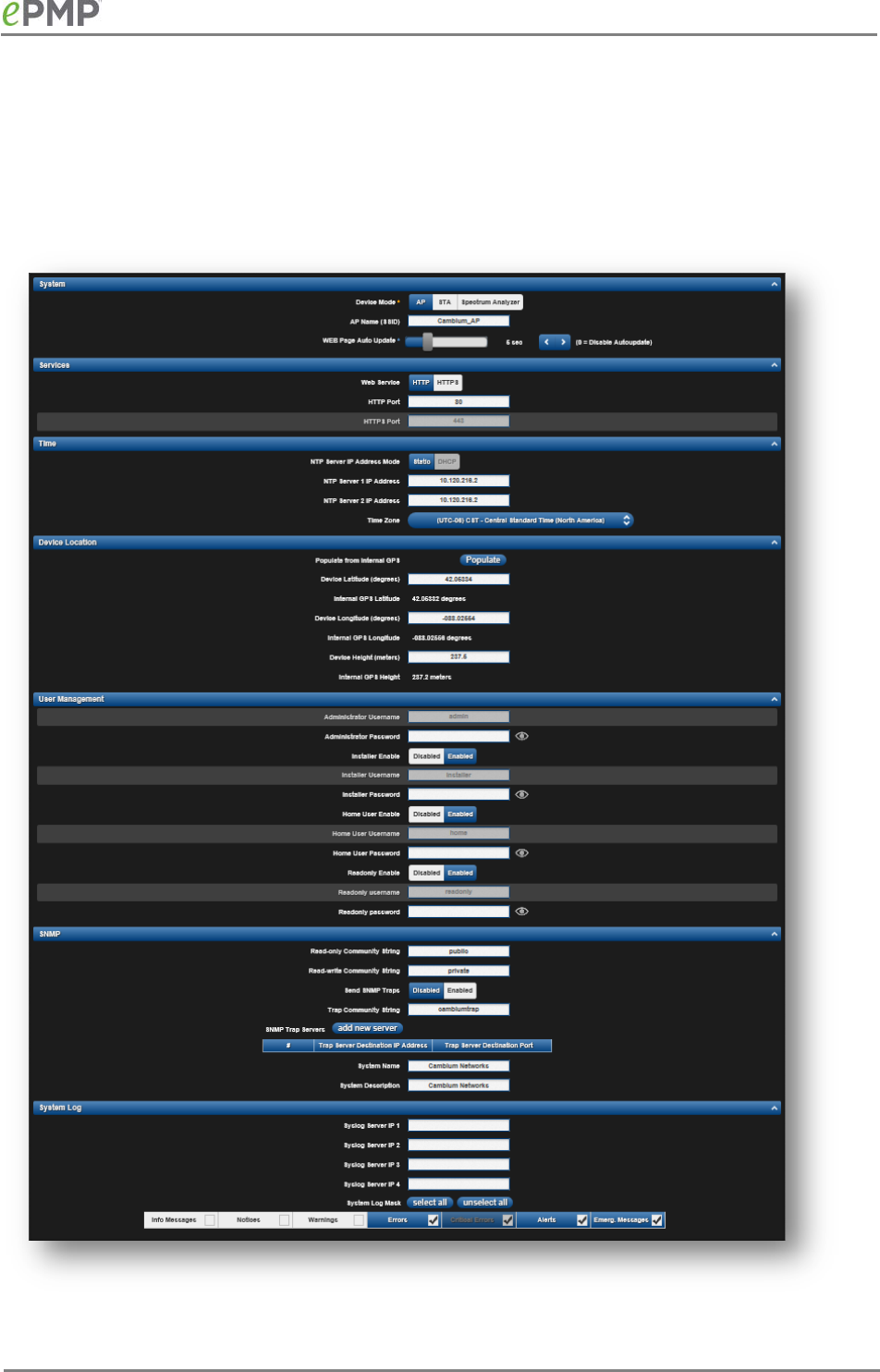
CAMBIUM NETWORKS
AP System page
The AP’s System page is used to configure system parameters, services, time settings, SNMP, and
syslog.
Figure 23
AP System page
104

CAMBIUM NETWORKS
Table 48
AP System attributes
Attribute
Meaning
Device Mode All ePMP devices (integrated or connectorized) may be configured to
operate in one of three modes:
AP:
The device will operate as an AP.
STA
: The device will operate as an STA.
Spectrum Analyzer
: The devices will operate in Spectrum Analyzer
mode, allowing the operator to download the spectrum analyzer tool.
AP Name (SSID) The AP Name (SSID) is used to identify the AP to STAs. This value is
configured in the STA to select an AP with which to register. Ensure that
this parameter is configured uniquely for each AP in the network.
WEB Page Auto
Update
Configure the interval for which the device retrieves system statistics for
display on the management interface. For example, if this setting is
configured to 5 seconds, the statistics and status parameters displayed
on the management interface will be refreshed every 5 seconds (default).
Web Service
HTTP
: Access to the device management GUI is conducted via HTTP.
HTTPS
: Access to the device management GUI is conducted via HTTPS.
HTTP Port If
Web Service
is set to
HTTP
, configure the port which the device uses
to service incoming HTTP requests for management GUI access.
HTTPS Port If
Web Service
is set to
HTTPS
, configure the port which the device uses
to service incoming HTTPS requests for management GUI access.
NTP Server IP
Address Mode
Static
: The device retrieves NTP time data from the servers configured
in fields
NTP Server IP Address.
DHCP
: The device retrieves NTP time data from the server IP issued via
a network DHCP server.
NTP Server 1,2 IP
Address
Configure primary and secondary NTP server IP addresses from which
the device will retrieve time and date information.
Time Zone The
Time Zone
option may be used to offset the received NTP time to
match the operator’s local time zone.
Populate from
Internal GPS
On a GPS Synchronized ePMP radio, the Device coordinates can be
populated using the information retrieved from the on-board GPS chip.
Device Latitude
(degrees)
Configure Latitude information for the device in decimal format.
Internal GPS
Latitude
On a GPS Synchronized ePMP radio, the field is automatically populated
with the Device Latitude information from the on-board GPS chip.
Device Longitude
(degrees)
Configure Longitude information for the device in decimal format.
105

CAMBIUM NETWORKS
Attribute
Meaning
Internal GPS
Longitude
On a GPS Synchronized ePMP radio, the field is automatically populated
with the Device Longitude information from the on-board GPS chip.
Device Height
(meters)
Configure height above sea level for the device in meters.
Internal GPS Height On a GPS Synchronized ePMP radio, the field is automatically populated
with the Device height above sea level from the on-board GPS chip.
Administrator,
Installer, Home
User, Readonly
Username
Read-only listing of available login levels.
• ADMINISTRATOR, full read write permissions.
• INSTALLER, permissions to read and write parameters applicable to
unit installation and monitoring.
• HOME, permissions only to access pertinent information for support
purposes.
• READONLY, only has permissions to view the Monitor page.
Installer, Home
User, Readonly
Enable
Disabled
: The disabled user will not be granted access to the device
management interface. The administrator user level cannot be disabled.
Enabled
: The user is granted access to the device management interface.
Administrator,
Installer, Home
User, Readonly
Password
Configure a custom password configuration for each user to secure the
device. The password character display may be toggled using the
visibility icon .
Read-only
Community String
Specify a control string that can allow a Network Management Station
(NMS) such as the Cambium Networks Services Server (CNSS) to read
SNMP information. No spaces are allowed in this string. This password
will never authenticate an SNMP user or an NMS to read/write access.
The
SNMP Read-only Community String
value is clear text and is
readable by a packet monitor.
Read-write
Community String
Specify a control string that can allow a Network Management Station
(NMS) to access SNMP information. No spaces are allowed in this string.
Send SNMP Traps
Disabled
: SNMP traps for system events will not be sent from the
device.
Enabled
: SNMP traps for system events will be sent to the servers
configured in table
SNMP Trap Servers
.
Trap Community
String
Configure an SNMP Trap Community String which is processed by the
servers configured in
SNMP Trap Servers
. This string is used by the trap
server to decide whether or not to process the traps incoming from the
device (i.e. for traps to successfully be received by the trap server, the
community string must match).
106

CAMBIUM NETWORKS
Attribute
Meaning
SNMP Trap Servers The
SNMP Trap Servers
table is used to configure trap destinations for
SNMP traps generated by the device.
Trap Server
Destination IP
Address
Configure the IP address of each SNMP trap server target.
Trap Server
Destination Port
Configure the port to which SNMP traps are sent from the ePMP device.
System Name Specify a string to associate with the physical module. This parameter
can be polled by the Cambium Networks Services Server (CNSS) or an
NMS.
System Description Specify a description string to associate with the physical module. This
parameter can be polled by the Cambium Networks Services Server
(CNSS) or an NMS.
Syslog Server IP 1-4 Specify up to four syslog servers to which the device will send syslog
messages.
System Log Mask Configure the levels of syslog messages which the devices send to the
servers configured in parameters
Syslog Server IP 1-4.
Caution
Choose only the syslog levels appropriate for your deployment.
Excessive logging can cause the device log file to fill and begin
overwriting previous entries.
107
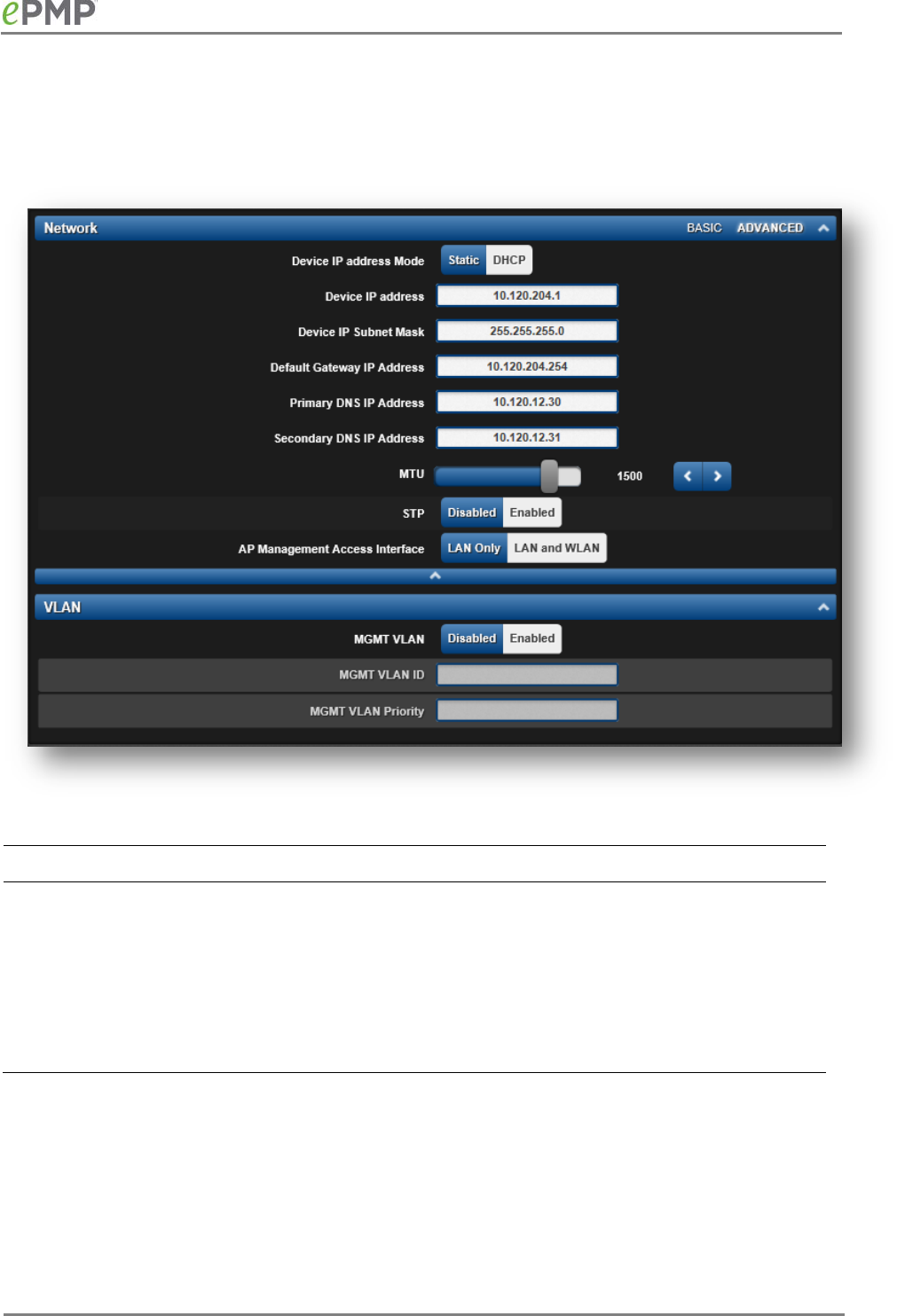
CAMBIUM NETWORKS
AP Network page
The AP’s Network page is used to configure system networking parameters and VLAN parameters.
Figure 24
AP Network page
Table 49
AP Network attributes
Attribute
Meaning
Device IP address
Mode
Static
: Device management IP addressing is configured manually in
fields
Device IP Address (LAN)
,
IP Subnet Mask (LAN)
,
Gateway IP
Address (LAN)
, and
DNS Server IP Address (LAN).
DHCP
: Device management IP addressing (IP address, subnet mask,
gateway, and DNS server) is assigned via a network DHCP server, and
parameters
Device IP Address (LAN)
,
IP Subnet Mask (LAN)
,
Gateway IP
Address (LAN)
, and
DNS Server IP Address (LAN)
are unused.
108

CAMBIUM NETWORKS
Device IP address Internet protocol (IP) address. This address is used by the family of
Internet protocols to uniquely identify this unit on a network.
Note
If
Device IP address Mode
is set to
DHCP
and the device is unable to
retrieve IP address information via DHCP, the device management IP is
set to fallback IP 192.168.0.1 (AP mode), 192.168.0.2 (STA mode),
192.168.0.3 (Spectrum Analyzer mode) or the previously-configured
static Device IP Address. Units may always be accessed via the Ethernet
port with IP 10.1.1.254.
Device IP Subnet
Mask
Defines the address range of the connected IP network. For example, if
Device IP Address (LAN)
is configured to 192.168.2.1 and
IP Subnet Mask
(LAN)
is configured to 255.255.255.0, the device will belong to subnet
192.168.2.X.
Device Gateway IP
Address
Configure the IP address of a computer on the current network that acts
as a gateway. A gateway acts as an entrance and exit to packets from
and to other networks.
Primary DNS Server
IP Address
Configure the primary IP address of the server used for DNS resolution.
Secondary DNS
Server IP Address
Configure the secondary IP address of the server used for DNS
resolution.
MTU Maximum Transmission Unit; the size in bytes of the largest data unit
that the device is configured to process. Larger MTU configurations can
enable the network to operate with greater efficiency, but in the case of
retransmissions due to packet errors, efficiency is reduced since large
packets must be resent in the event of an error. Packets received by the
device larger than the configured MTU will be dropped.
STP
Disabled
: When disabled, Spanning Tree Protocol (802.1d) functionality
is disabled at the AP.
Enabled
: When enabled, Spanning Tree Protocol (802.1d) functionality
is enabled at the AP, allowing for the prevention of Ethernet bridge
loops.
109

CAMBIUM NETWORKS
AP Management
Access Interface
LAN Only:
Only allow access to the AP’s web management interface via
a local Ethernet (LAN) connection. In this configuration, the AP’s web
management interface may not be accessed from over the air (i.e. from a
device situated below the STA).
LAN and WLAN:
Allow access to the AP’s web management interface
via a local Ethernet (LAN) connection and from over the air (i.e. from a
device situated below the STA).
Caution
APs configured with AP Management Access Interface set to LAN and
WLAN are susceptible to unauthorized access.
MGMT VLAN
Enabled
: The AP management interface can be assigned to a
Management VLAN to separate management traffic (remote module
management via SNMP or HTTP) from user traffic (such as internet
browsing, voice, or video. Once the management interface is enabled for
a VLAN, an AP’s management interface can be accessed only by packets
tagged with a VLAN ID matching the management VLAN ID.
A VLAN configuration establishes a logical group within the network.
Each computer in the VLAN, regardless of initial or eventual physical
location, has access to the same data based on the VLAN architecture.
For the network operator, this provides flexibility in network
segmentation, simpler management, and enhanced security.
Disabled
: When disabled, all IP management traffic is allowed to the
device.
MGMT VLAN ID Configure this parameter to include the device’s management traffic on
a separate VLAN network. For example, if
MGMT VLAN ID
is set to 2,
GUI access will only be allowed from IP packets tagged with VLAN ID 2.
MGMT VLAN
Priority
ePMP radios can prioritize VLAN traffic based on the eight priorities
described in the IEEE 802.1p specification.
MGMT VLAN Priority
represents the VLAN Priority or Class of Service (CoS). Operators may
use this prioritization field to give precedence to device management
traffic.
If the
MGMT VLAN Priority
field
is configured, to access the AP GUI the
accessing switch or end device must be configured to tag Ethernet
frames with the
MGMT VLAN ID
value and the same priority values as
configured in field
MGMT VLAN Priority
. For example, if
MGMT VLAN
ID
is set to 100 and
MGMT VLAN Priority
is set to 5, the Ethernet frames
sent to the AP to access the GUI must be tagged with a VLAN ID value of
100 and Class of Service priority set to 5.
If
MGMT VLAN Priority
is not configured (blank), to access the AP GUI
the accessing switch or end device only needs to tag Ethernet frames
with the same VLAN ID as is configured in the
MGMT VLAN ID
field.
110
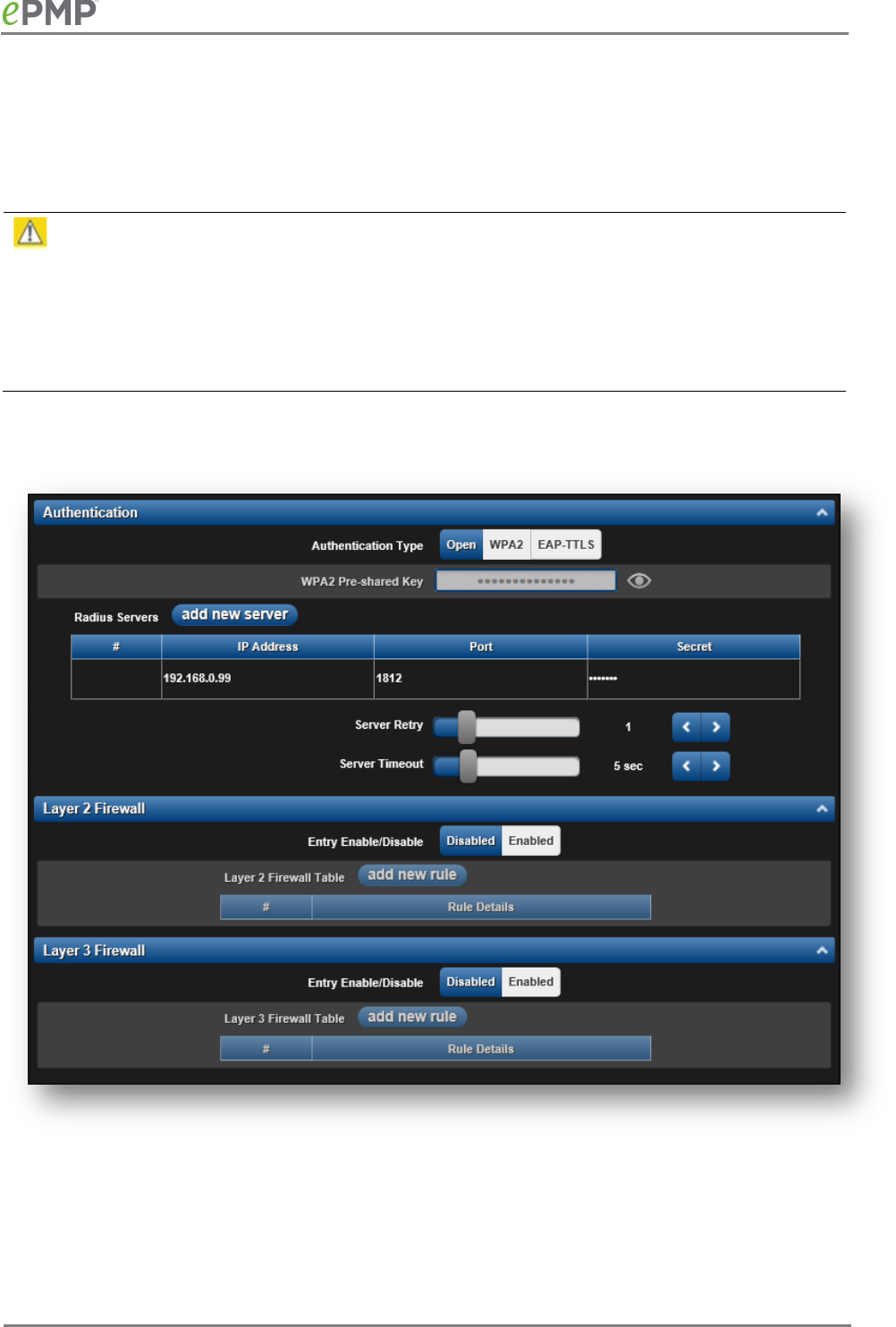
CAMBIUM NETWORKS
AP Security page
The AP’s Security page is used to configure system security features including STA authentication
and Layer2/Layer3 Firewall rules.
Caution
If a device firewall rule is added with
Action
set to
Deny
and
Interface
set to
LAN
or
WAN
and no
other rule attribute are configured, the device will drop all Ethernet or wireless traffic,
respectively. Ensure that all firewall rules are specific to the type of traffic which must be denied,
and that no rules exist in the devices with only
Action
set to
Deny
and
Interface
set to
LAN
or
WAN.
To regain access to the device, perform a factory default.
Figure 25
AP Security page
111

CAMBIUM NETWORKS
Table 50
AP Security attributes
Attribute
Meaning
Authentication Type
Open
: All STAs requesting network entry are allowed registration.
WPA2:
The WPA2 mechanism provides AES radio link encryption and
STA network entry authentication. When enabled, the STA must register
using the
Authentication Pre-shared Key
configured on the AP and STA.
WPA2 Pre-shared Key Configure this key on the AP, then configure each of the network STAs
with this key to complete the authentication configuration. This key must
be between 8 to 128 symbols.
Radius Servers Up to 3 Radius servers can be configured on the device with the
following attributes:
IP Address
: IP Address of the Radius server on the network.
Port:
The Radius server port. Default is 1812.
Secret
: The secret key that will be used to communicate with the Radius
server.
Server Retry Number of times the radio will retry authentication with the configured
Radius server before it fails authentication of the STA.
Server Timeout Timeout between each retry with the configured Radius server before it
fails authentication of the STA.
Layer 2 Firewall Entry
Enable/Disable
Enabled
: Modifications to the Layer 2 Firewall Table are allowed and
rules are enforced.
Disabled
: Modifications to the Layer 2 Firewall Table are not allowed
and rules are not enforced.
Layer 2 Firewall Table When the STA is configured with
STA Network Mode
set to
Bridge
,
the
Layer 2 firewall table may be used to configure rules matching layer 2
(MAC layer) traffic which result in forwarding or dropping the traffic over
the radio link or Ethernet interface.
Rule Details, Name Assign a logical name to the firewall rule based on the intended rule
operation (i.e. “Deny all WLAN traffic from VLAN ID 100”).
Rule Details, Action
Accept
: Layer 2 traffic matching the rule details is forwarded.
Deny
: Layer 2 traffic matching the rule details is dropped at the device.
112

CAMBIUM NETWORKS
Rule Details, Interface
WLAN
: When this option is selected, firewall rules will be applied to
traffic incoming on the device radio interface (WLAN). Depending on the
setting of the
Action
parameter, traffic matching the rule details will
either be forwarded to the LAN (Ethernet) interface or dropped at the
device.
LAN
: When this option is selected, firewall rules will be applied to traffic
incoming on the device Ethernet interface (LAN). Depending on the
setting of the
Action
parameter, traffic matching the rule details will be
either forwarded to the WAN (radio) interface or dropped at the device.
Rule Details, Log
On
: When a firewall rule is matched, a resulting system log message
will be generated.
Off
: When a firewall rule is matched, no system log messaging will be
generated.
Rule Details,
EtherType
Rule matching is based on the two octet Ethertype field in the Ethernet
frame. The Ethertype is used to identify the protocol of the data in the
payload of the Ethernet frame.
Rule Details, VLAN ID Rule matching is based on the VLAN ID of the packet.
Rule Details, Src MAC Firewall rule matching is based on the source MAC address of the
packet.
Rule Details, Src Mask A mask may be included to define a range of MAC addresses to match.
The mask is made up of a hex representation of a series of 1s to start the
mask and 0s that end the mask. A 1 may not follow a 0. Thus,
FF:FF:FF:FF:00:00 is allowed, but FF:00:FF:FF:FF:FF is not. The MAC
address is combined with the mask to define the range of allowed MAC
addresses.
Rule Details, Dest
MAC
Firewall rule matching is based on the destination MAC address of the
packet.
Rule Details, Dest
Mask
A mask may be included to define a range of MAC addresses to match.
The mask is made up of a hex representation of a series of 1s to start the
mask and 0s that end the mask. A 1 may not follow a 0. Thus,
FF:FF:FF:FF:00:00 is allowed, but FF:00:FF:FF:FF:FF is not. The MAC
address is combined with the mask to define the range of allowed MAC
addresses.
Layer 3Firewall Entry
Enable/Disable
Enabled
: Modifications to the Layer 3 Firewall Table are allowed and
rules are enforced.
Disabled
: Modifications to the Layer 3 Firewall Table are not allowed
and rules are not enforced.
113

CAMBIUM NETWORKS
Layer 3 Firewall Table When the STA is configured with
STA Network Mode
set to
NAT
, the
Layer 3 firewall table may be used to configure rules matching layer 3 (IP
layer) traffic which result in forwarding or dropping the traffic over the
radio link or Ethernet interface.
Rule Details, Name Assign a logical name to the firewall rule based on the intended rule
operation (i.e. “Deny all WLAN traffic from Src IP 192.168.2.111”).
Rule Details, Action
Accept
: Layer 3 traffic matching the rule details will be forwarded
Deny
: Layer 3 traffic matching the rule details will be dropped at the
device.
Rule Details, Interface
WLAN
: When this option is selected, firewall rules will be applied to
traffic incoming on the device radio interface (WLAN). Depending on the
setting of the
Action
parameter, traffic matching the rule details will
either be forwarded to the LAN (Ethernet) interface or dropped at the
device.
LAN
: When this option is selected, firewall rules will be applied to traffic
incoming on the device Ethernet interface (LAN). Depending on the
setting of the
Action
parameter, traffic matching the rule details will be
either forwarded to the WAN (radio) interface or dropped at the device.
Rule Details, Log
On
: When a firewall rule is matched, a resulting system log message
will be generated.
Off
: When a firewall rule is matched, no system log messaging will be
generated.
Rule Details, Protocol
TCP
: Only TCP packets are matched by the configured rule.
UDP
: Only UDP packets are matched by the configured rule.
TCP+UDP
: Both TCP and UDP packets are matched by the configured
rule.
ICMP
: Only ICMP packets are matched by the configured rule.
IP
: Only IP packets are matched by the configured rule.
Rule Details, Port Rule matching is based on the port value in the incoming packet.
Rule Details, Src IP Rule matching is based on the Source IP address of the incoming packet.
Rule Details, Src Mask A subnet mask may be included to define a range of IP addresses to
match. For example, if
Src IP
is configured to 192.168.2.0 and
Src Mask
is configured to 255.255.255.0, the rule will match all IP addresses from
subnetwork 192.168.2.X.
Rule Details, Dest IP Rule matching is based on the Destination IP address of the incoming
packet.
114

CAMBIUM NETWORKS
Rule Details, Dest
Mask
A subnet mask may be included to define a range of IP addresses to
match. For example, if
Dest IP
is configured to 192.168.2.0 and
Dest
Mask
is configured to 255.255.255.0, the rule will match all IP addresses
from subnetwork 192.168.2.X.
Rule Details, DSCP Rule matching is based on the DiffServ CodePoint value of the incoming
packet.
Rule Details, TOS Rule matching is based on the Type Of Service value of the incoming
packet.
115

CAMBIUM NETWORKS
AP MONITOR MENU
Use the Monitor menu to access device and network statistics and status information. This section
may be used to analyze and troubleshoot network performance and operation.
The Monitor menu contains the following pages:
•
AP Performance page
on page
117
•
AP System Status page
on page
120
•
AP Wireless Status page
on page
122
•
AP GPS Status page
on page
124
•
AP Network Status page
on page
126
•
AP System Log page
on page
128
116
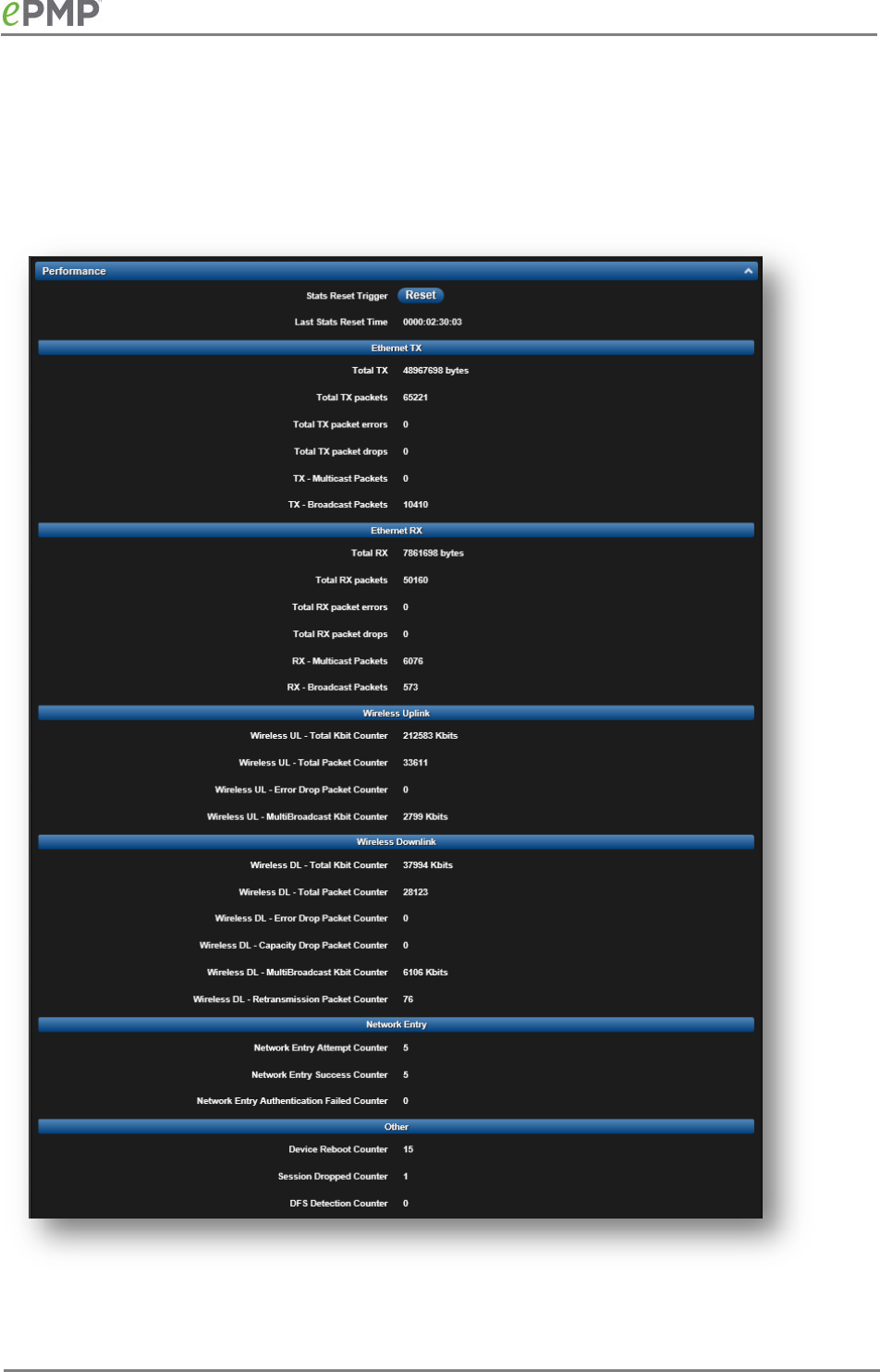
CAMBIUM NETWORKS
AP Performance page
Use the Performance page to monitor system status and statistics to analyze and troubleshoot
network performance and operation.
Figure 26
AP Performance page
117
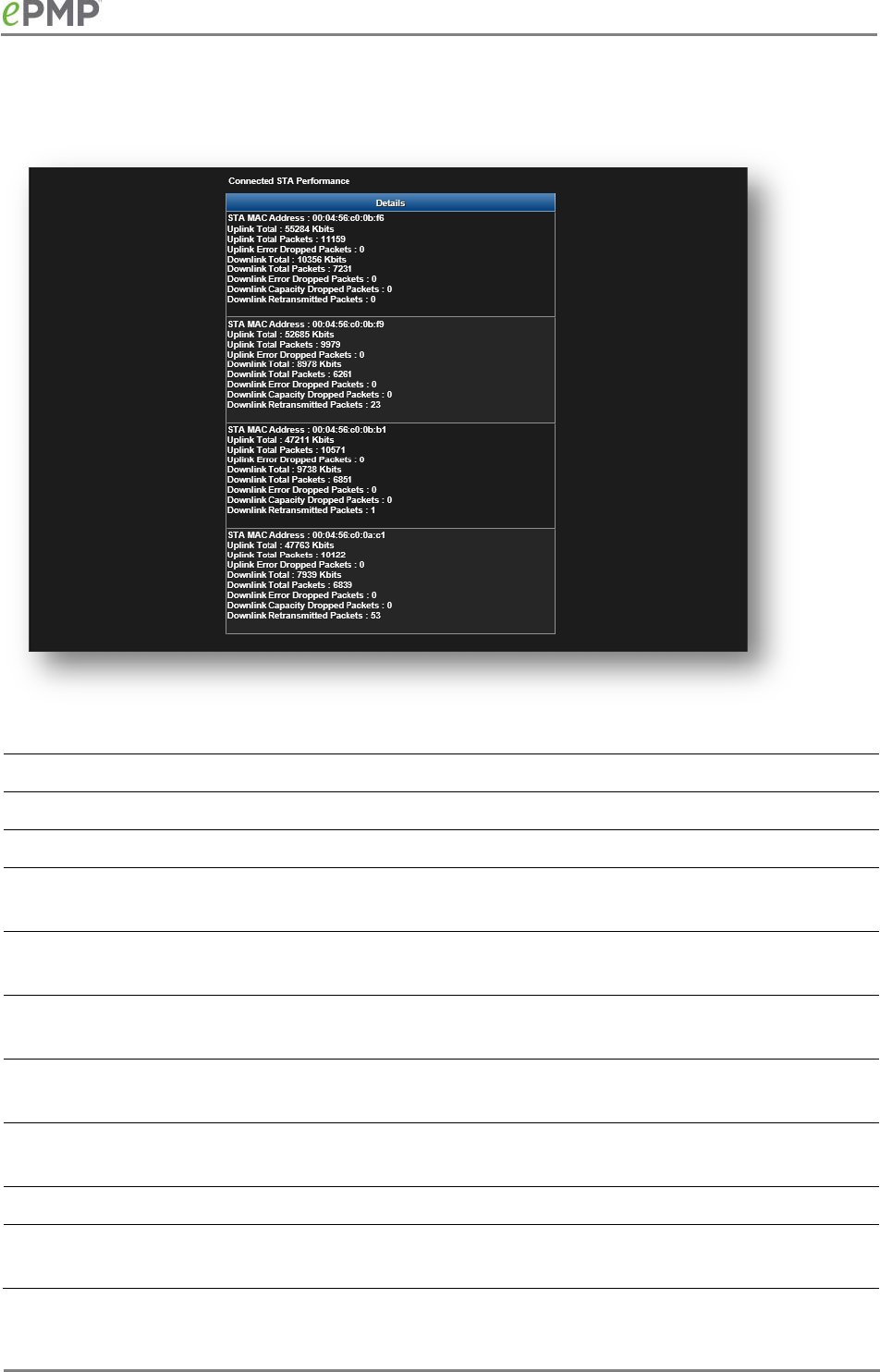
CAMBIUM NETWORKS
Figure 27
AP Performance page – contd.
Table 51
AP Performance page attributes
Attribute
Meaning
Stats Reset Trigger Reset all statistics
Ethernet TX, Total TX Total count of bytes transferred from the AP’s Ethernet interface
Ethernet TX, Total TX
packets
Total count of packets transferred from the AP’s Ethernet interface
Ethernet TX, Total TX
packet errors
Total count of packets transmitted out of the AP’s Ethernet interface with
errors due to collisions, CRC errors, or irregular packet size.
Ethernet TX, Total TX
packet drops
Total count of packets dropped prior to sending out of the AP’s Ethernet
interface due to Ethernet setup or filtering issues.
Ethernet TX, TX –
Multicast Packets
Total count of multicast packets sent via the AP’s Ethernet interface
Ethernet TX, TX –
Broadcast Packets
Total count of broadcast packets sent via the AP’s Ethernet interface
Ethernet RX, Total RX Total count of bytes received by the AP’s Ethernet interface
Ethernet RX, Total RX
packets
Total count of packets received by the AP’s Ethernet interface
118

CAMBIUM NETWORKS
Attribute
Meaning
Ethernet RX, Total RX
packet errors
Total count of packets received by the AP’s Ethernet interface with errors
due to collisions, CRC errors, or irregular packet size.
Ethernet RX, Total RX
packet drops
Total count of packets dropped prior to sending out of the AP’s wireless
interface due to Ethernet setup or filtering issues.
Ethernet RX, RX –
Multicast Packets
Total count of multicast packets received via the AP’s Ethernet interface.
Ethernet RX, RX –
Broadcast Packets
Total count of broadcast packets received via the AP’s Ethernet interface.
Wireless Uplink, Total
Kbit Counter
Total count of packets received via the AP’s wireless interface in Kbits.
Wireless Uplink, Total
Packet Counter
Total count of packets received via the AP’s wireless interface.
Wireless Uplink, Error
Drop Packet Counter
Total count of packets dropped prior to sending out of the AP’s Ethernet
interface due to RF errors (packet integrity error and other RF related
packet error).
Wireless Uplink,
MultiBroadcast Kbit
Counter
Total count of multicast and broadcast packets received on the AP’s
wireless interface in Kbits.
Wireless Downlink,
Total Kbit Counter
Total count of packets transmitted out of the AP’s wireless interface in
Kbits.
Wireless Downlink,
Total Packet Counter
Total count of packets transmitted out of the AP’s wireless interface.
Wireless Downlink,
Error Drop Packet
Counter
Total count of packets dropped after transmitting out of the AP’s
Wireless interface due to RF errors (No acknowledgement and other RF
related packet error).
Wireless Downlink,
Capacity Drop Packet
Counter
Total count of packets dropped after transmitting out of the AP’s
Wireless interface due to capacity issues (data buffer/queue overflow or
other performance or internal packet errors).
Wireless Downlink,
MultiBroadcast Kbit
Counter
Total count of multicast and broadcast packets transmitted out of the
AP’s wireless interface in Kbits.
Wireless Downlink,
Retransmission Packet
Counter
Total count of packets retransmitted after transmitting out of the AP’s
Wireless interface due to RF errors (No acknowledgement and other RF
related packet error).
119
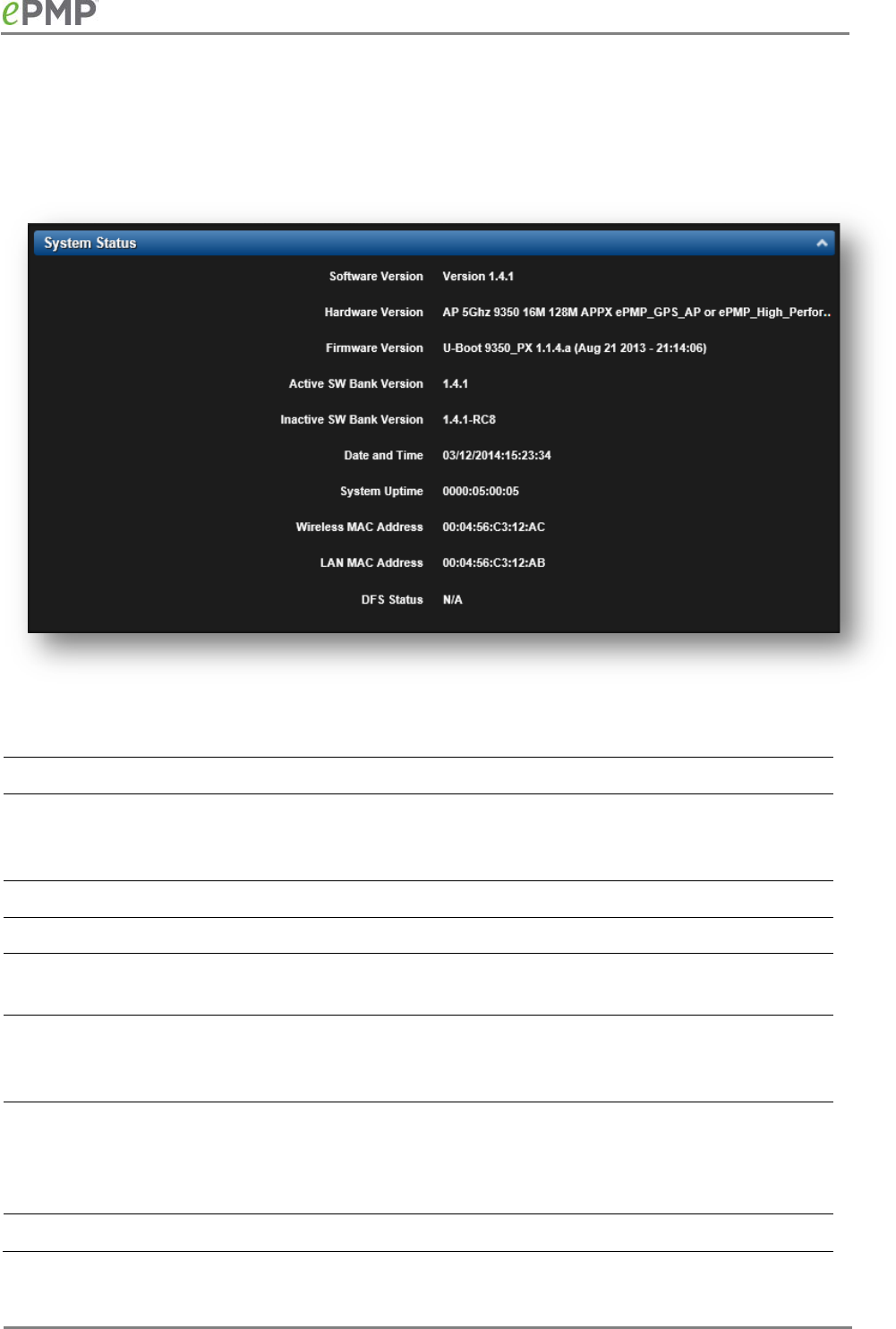
CAMBIUM NETWORKS
AP System Status page
Use the System Status page to reference key system information.
Figure 28
AP System Status page
Table 52
AP System Status page attributes
Attribute
Meaning
Software Version Current operating version of software on the device. This listing is also
present on the GUI footer bar (which contains a hyperlink to download
new system software).
Hardware Version Board hardware version information.
Firmware Version U-Boot version information.
Active SW Bank
Version
The currently operating version of software on the ePMP device.
Inactive SW Bank
Version
The backup software version on the ePMP device, used upon failure of
the active bank. Two software upgrades in sequence will update both the
Active SW Bank Version
and the
Inactive SW Bank Version
.
Date and Time Current date and time, subject to time zone offsets introduced by the
configuration of the device
Time Zone
parameter. Until a valid NTP
server is configured, this field will display the time configured from the
factory.
System Uptime The total system uptime since the last device reset.
120

CAMBIUM NETWORKS
Attribute
Meaning
Wireless MAC
Address
The hardware address of the device wireless interface.
LAN MAC Address The hardware address of the device LAN (Ethernet) interface.
DFS Status
N/A:
DFS operation is not required for the region configured in
parameter
Country Code.
Channel Availability Check
: Prior to transmitting, the device must check
the configured
Frequency Carrier
for radar pulses for 60 seconds). If no
radar pulses are detected, the device transitions to state
In-Service
Monitoring.
In-Service Monitoring
: Radio is transmitting and receiving normally
while monitoring for radar pulses which require a channel move.
Radar Signal Detected
: The receiver has detected a valid radar pulse and
is carrying out detect-and-avoid mechanisms (moving to an alternate
channel).
In-Service Monitoring at Alternative Channel
: The radio has detected a
radar pulse and has moved operation to a frequency configured in
DFS
Alternative Frequency Carrier 1
or
DFS Alternative Frequency Carrier 2.
System Not In Service due to DFS
: The radio has detected a radar pulse
and has failed channel availability checks on all alternative frequencies.
The non-occupancy time for the radio frequencies in which radar was
detected is 30 minutes.
121
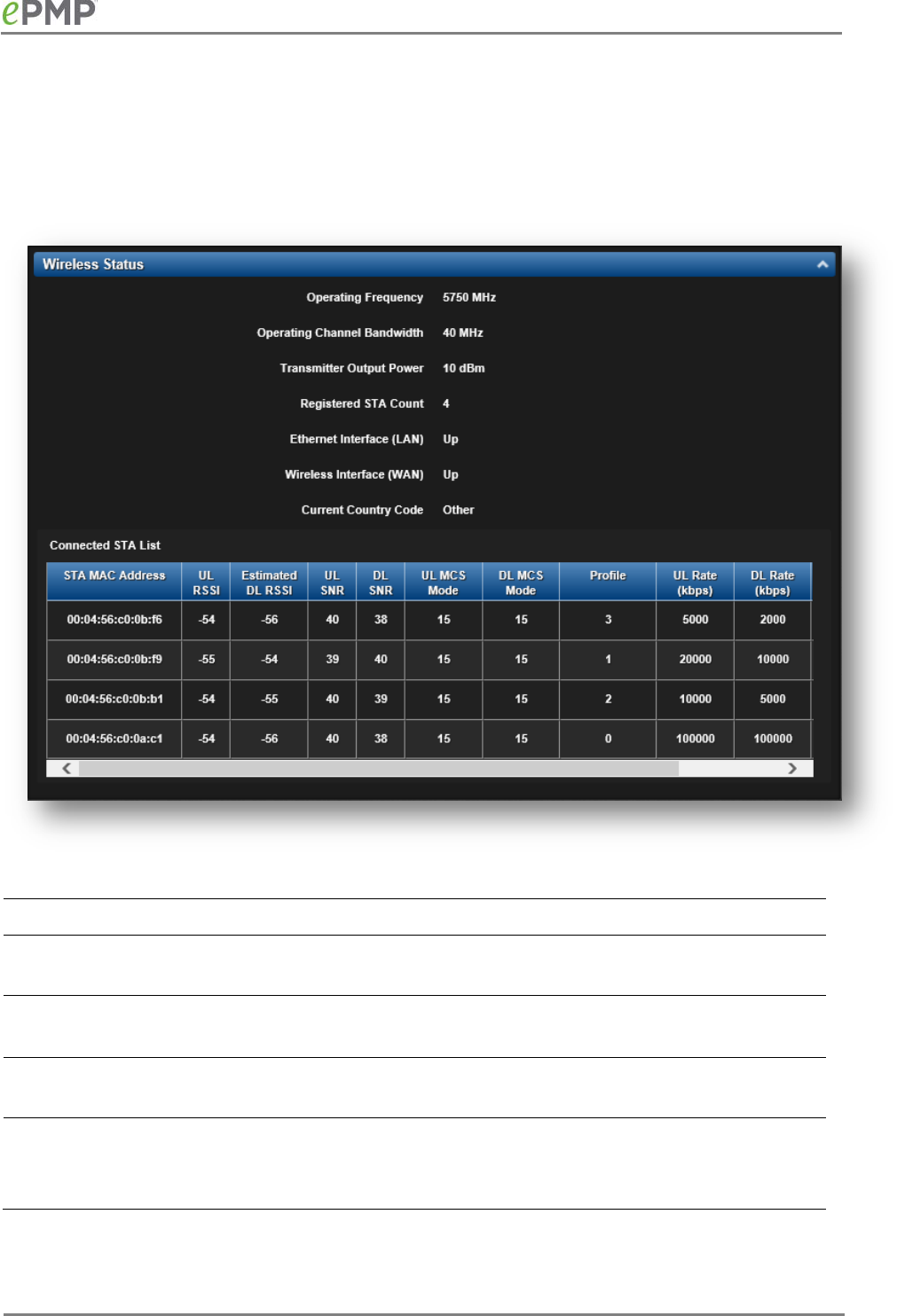
CAMBIUM NETWORKS
AP Wireless Status page
Use the Wireless Status page to reference key information about the radio’s wireless interface and
connected STAs.
Figure 29
AP Wireless Status page
Table 53
AP Wireless Status page attributes
Attribute
Meaning
Operating
Frequency
The current frequency at which the AP is operating.
Transmitter Output
Power
The current power level at which the AP is transmitting.
Registered STA
Count
The total count of STAs which are currently registered to the AP.
Ethernet Interface
(LAN)
Up
: The Ethernet (LAN) interface is functioning properly.
Down
: The Ethernet (LAN) interface has encountered an error and is not
servicing traffic.
122

CAMBIUM NETWORKS
Attribute
Meaning
Wireless Interface
(WAN)
Up
: The radio (WAN) interface is functioning properly.
Down
: The radio (WAN) interface has encountered an error and is not
servicing traffic.
Current Country
Code
The current country code at which the AP is operating.
Connected STA List Use the
Connected STA List
table to monitor registered STAs and their
key RF status and statistics information.
STA MAC Address The address of the STA wireless interface.
UL RSSI The uplink Received Signal Strength Indicator, which is a measurement
of the power level being received by the AP’s antenna.
Estimated DL RSSI The downlink Received Signal Strength Indicator, which is an estimated
measurement of the power level being received by the STA’s antenna.
UL SNR The uplink Signal to Noise Ratio, which is an expression of the carrier
signal quality with respect to signal noise.
DL SNR The downlink Signal to Noise Ratio, which is an expression of the carrier
signal quality with respect to signal noise.
UL MCS Mode Modulation and Coding Scheme – indicates the modulation mode used
for the radio uplink, based on radio conditions (MCS 1, 9-15).
DL MCS Mode Modulation and Coding Scheme – indicates the modulation mode used
for the radio downlink, based on radio conditions (MCS 1, 9-15).
Profile The current MIR profile number to which the STA is configured.
UL Rate The current Maximum Information Rate (in Kbps) on the Uplink to which
the STA is configured.
DL Rate The current Maximum Information Rate (in Kbps) on the Downlink to
which the STA is configured.
123
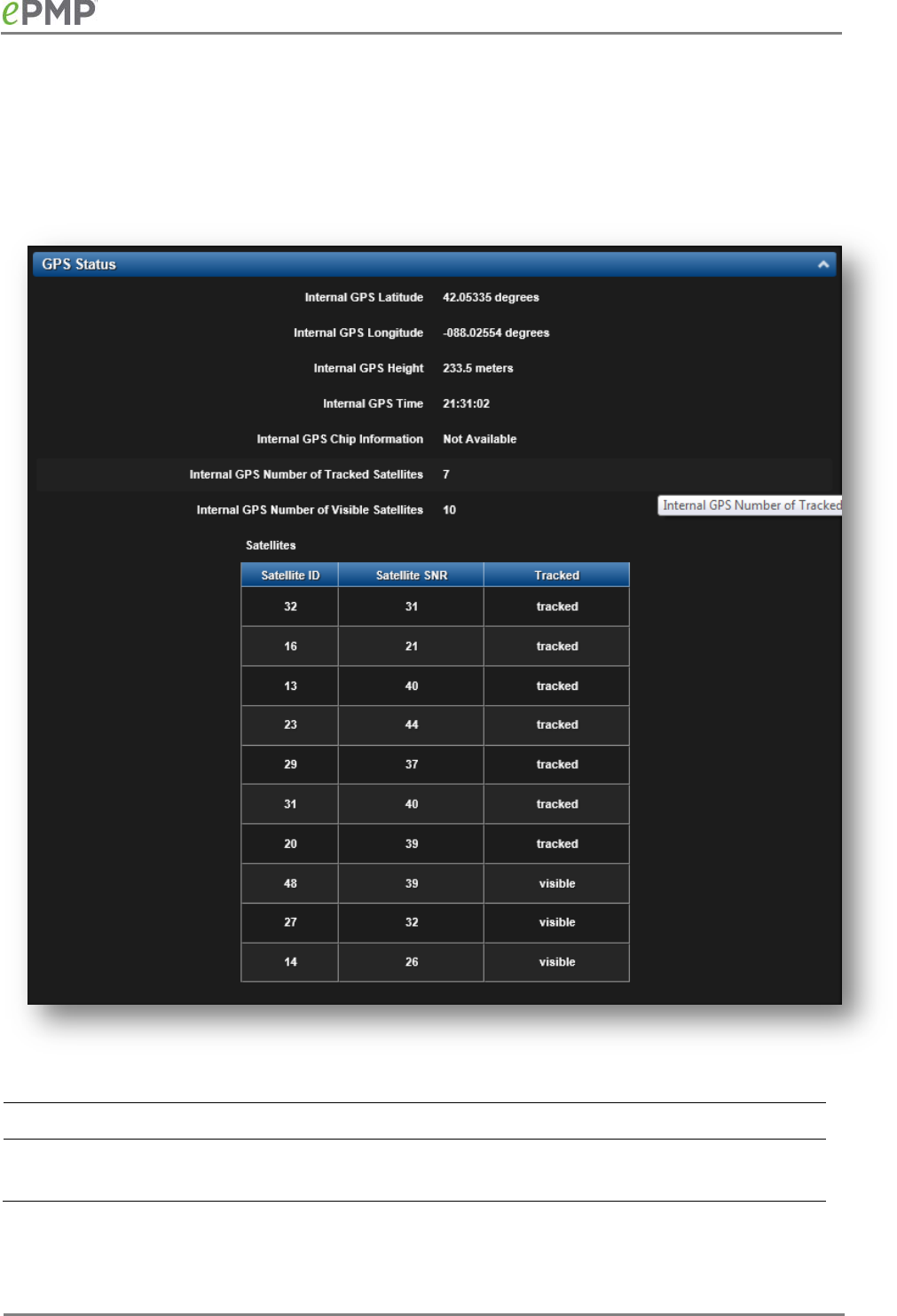
CAMBIUM NETWORKS
AP GPS Status page
Use the GPS Status page to reference key information about the radio’s configured GPS
coordinates.
Figure 30
AP GPS Status page
Table 54
AP GPS Status page attributes
Attribute
Meaning
Internal GPS
Latitude
On a GPS Synchronized ePMP radio, the field is automatically populated
with the Device Latitude information from the on-board GPS chip.
124

CAMBIUM NETWORKS
Attribute
Meaning
Internal GPS
Longitude
On a GPS Synchronized ePMP radio, the field is automatically populated
with the Device Longitude information from the on-board GPS chip.
Internal GPS Height On a GPS Synchronized ePMP radio, the field is automatically populated
with the Device height above sea level from the on-board GPS chip.
Internal GPS Time On a GPS Synchronized ePMP radio, the field is automatically populated
with the time from the on-board GPS chip.
Internal GPS
Number of Tracked
Satellites
On a GPS Synchronized ePMP radio, the field indicates the number of
satellites current tracked by the on-board GPS chip.
Internal GPS
Number of Visible
Satellites
On a GPS Synchronized ePMP radio, the field indicates the number of
satellites visible to the on-board GPS chip.
Satellites The
Satellites
table provides information about each satellite that is
visible or tracked along with the Satellite ID and Signal to Noise Ratio
(SNR) of the satellite.
125
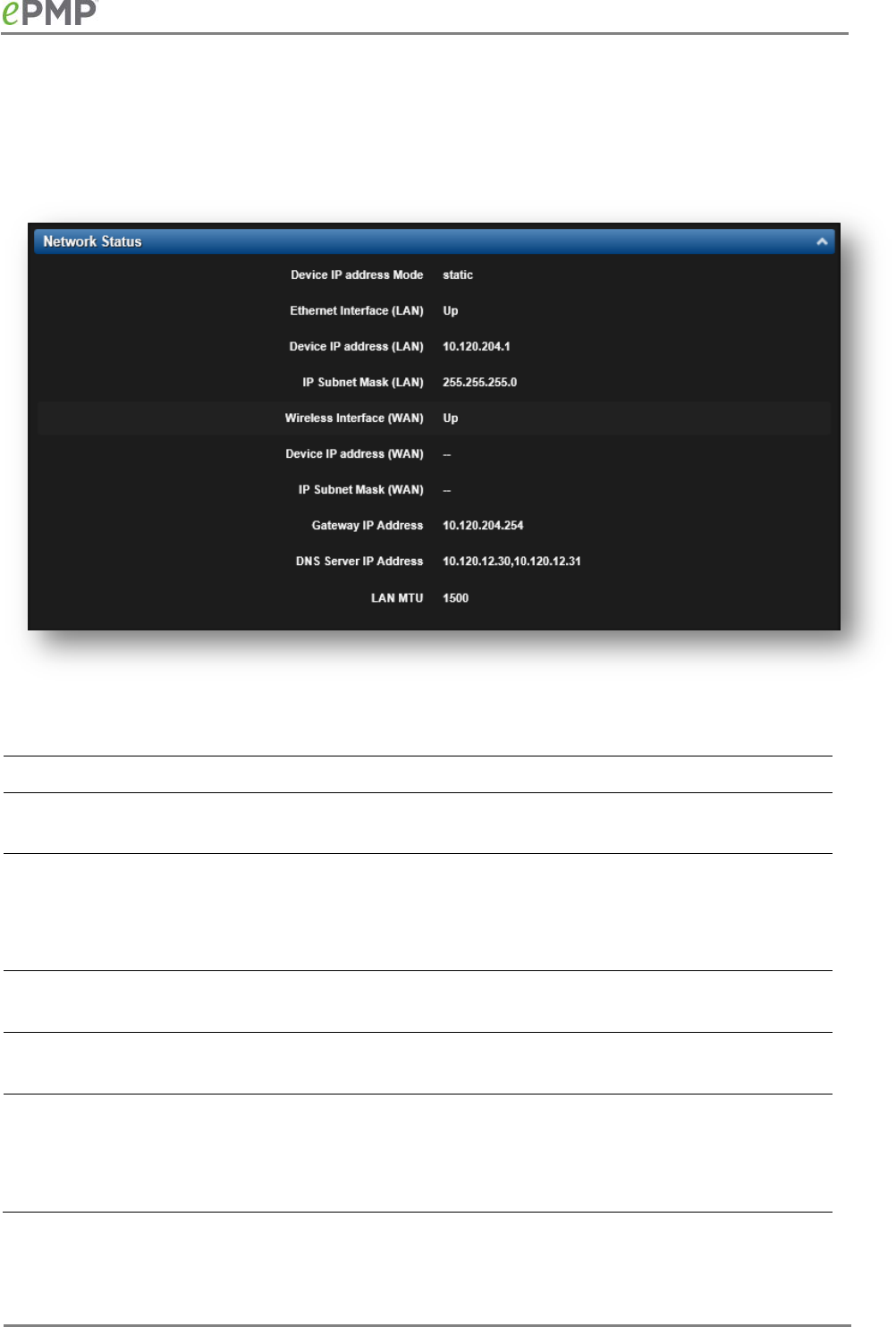
CAMBIUM NETWORKS
AP Network Status page
Use the AP Network Status page to reference key information about the device network status.
Figure 31
AP Network Status page
Table 55
AP Network Status page attributes
Attribute
Meaning
Device IP Address
Mode
The current IP Address mode of the device (static or DHCP).
Ethernet Interface
(LAN)
Up
: The device Ethernet interface is functioning and passing data.
Down
: The device Ethernet interface has encountered an error
disallowing full operation. Reset the device to reinitiate the Ethernet
interface.
Device IP address
(LAN)
The currently configured Ethernet IP address, used for device
management.
IP Subnet Mask
(LAN)
The currently configured device IP subnet mask.
Wireless Interface
(WAN)
Up
: The device wireless interface is functioning and passing data
Down
: The device wireless interface has encountered an error
disallowing full operation. Reset the device to reinitiate the wireless
interface.
126

CAMBIUM NETWORKS
Attribute
Meaning
Device IP address
(WAN)
Currently unused.
IP Subnet Mask
(WAN)
Currently unused.
Gateway IP Address The IP address of a computer on the current network that acts as a
gateway. A gateway acts as an entrance and exit to packets from and to
other networks.
DNS Server IP
Address
The IP address of the server used for DNS resolution.
LAN MTU The currently configured Maximum Transmission Unit for the AP’s
Ethernet (LAN) interface. Larger MTU configurations can enable the
network to operate with greater efficiency, but in the case of
retransmissions due to packet errors, efficiency is reduced since large
packets must be resent in the event of an error.
127
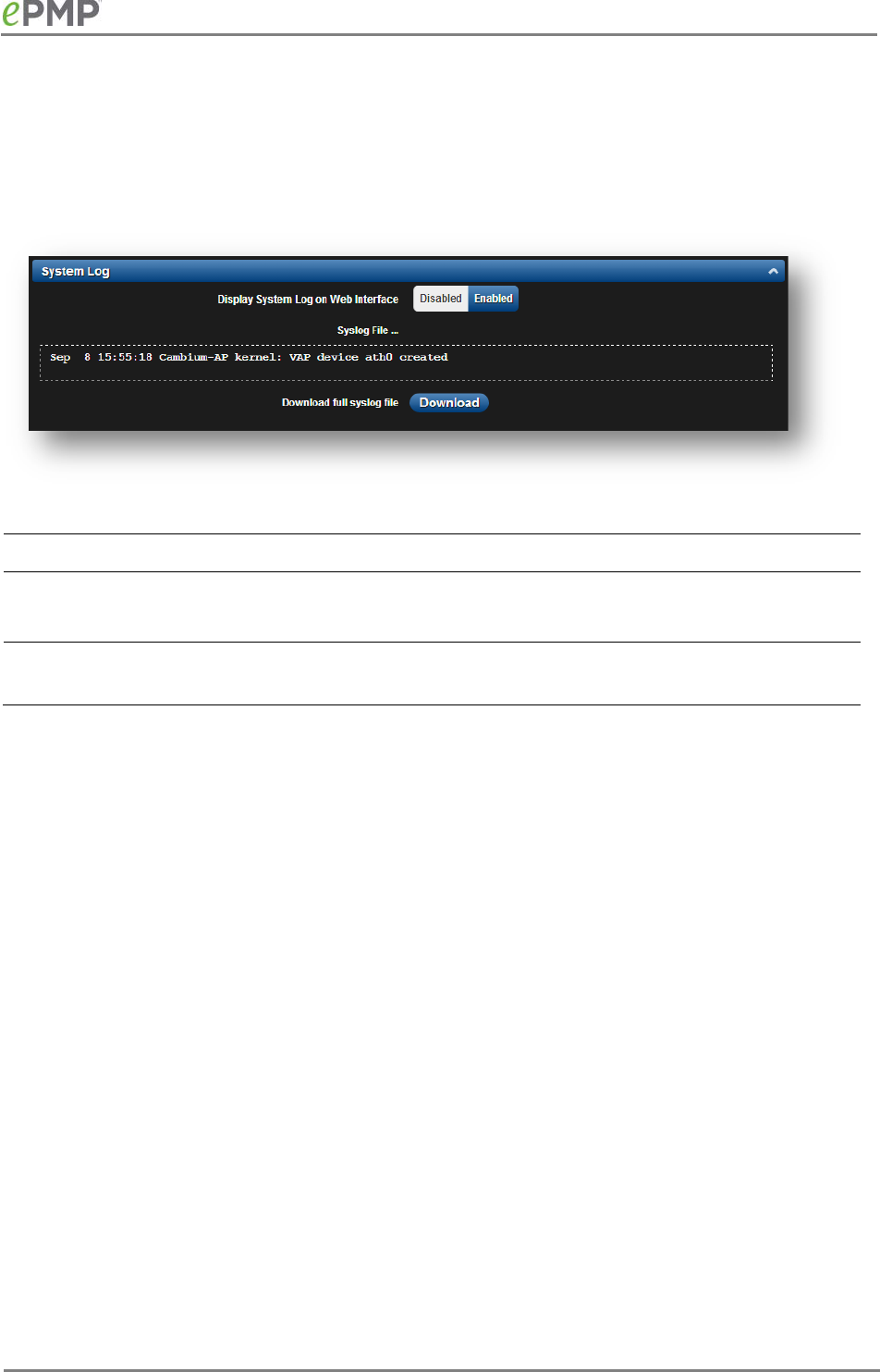
CAMBIUM NETWORKS
AP System Log page
Use the AP System Log page to view the device system log and to download the log file to the
accessing PC/device.
Figure 32
AP System Log page
Table 56
AP System Log attributes
Attribute
Meaning
Display System Log
on Web Interface
Enabled
: The system log file is displayed on the management GUI.
Disabled
: The system log file is hidden on the management GUI.
Download full
syslog file
Use this button to download the full system log file to a connected
PC/device.
128

CAMBIUM NETWORKS
AP TOOLS MENU
The AP Tools menu provides several options for upgrading device software, configuration
backup/restore, analyzing RF spectrum, testing device throughput, and running ping and
traceroute tests.
•
AP Software Upgrade page
on page
130
•
AP Factory Default page
on page
132
•
AP Spectrum Analyzer page
on page
133
•
AP Throughput Test page
on page
136
•
AP Ping page
on page
137
•
AP Traceroute page
on page
138
129
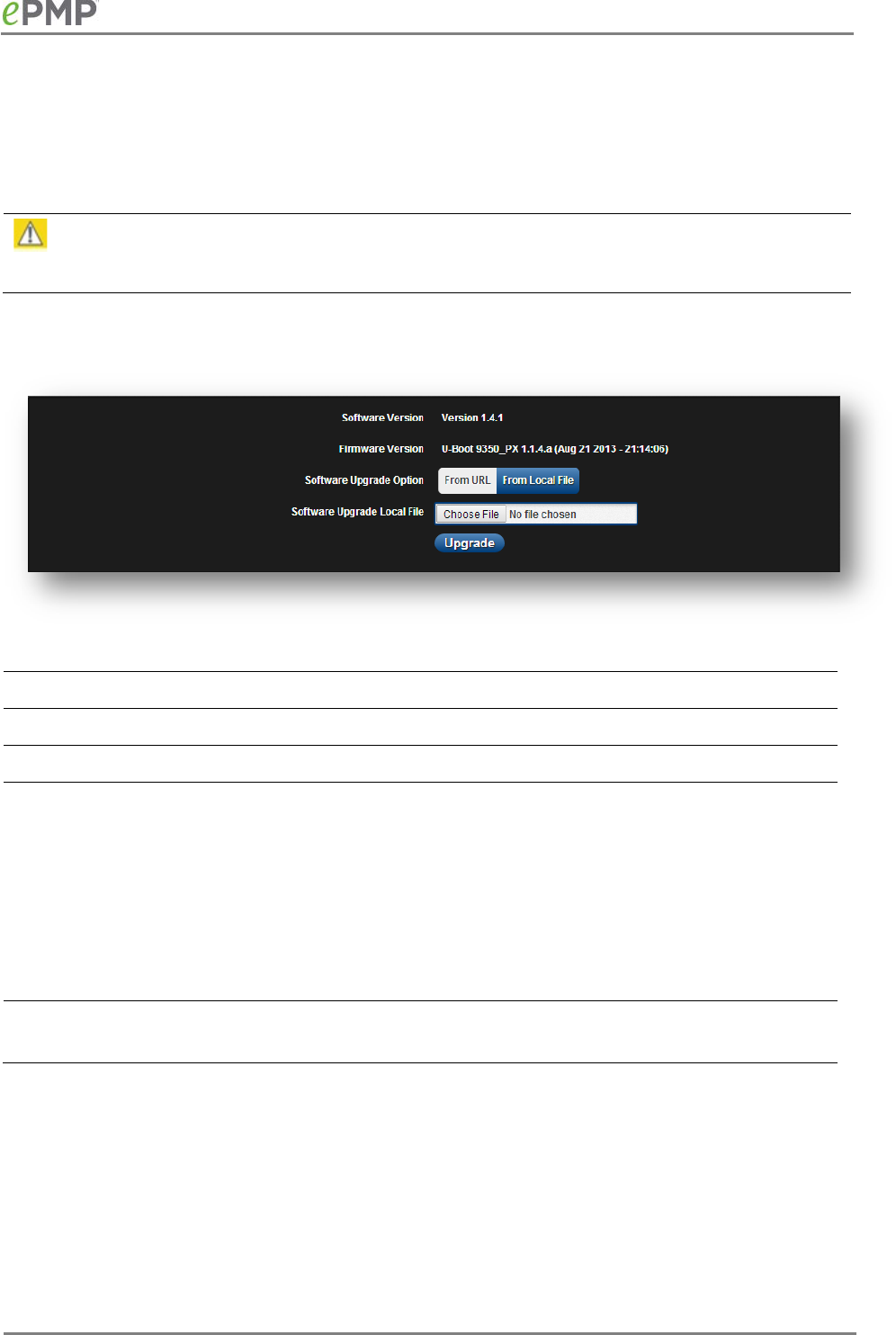
CAMBIUM NETWORKS
AP Software Upgrade page
Use the AP Software Upgrade page to update the device radio software to take advantage of new
software features and improvements.
Caution
Read the Release Notes associated with each software release.
Figure 33
AP Software Upgrade page
Table 57
AP Software Upgrade attributes
Attribute
Meaning
Software Version The current operating software version
Firmware Version The current U-Boot version
SW Upgrade Option
From URL
: A webserver may be used to retrieve software upgrade
packages (downloaded to the device via the webserver). For example, if
a webserver is running at IP address 192.168.2.1 and the software
upgrade packages are located in the home directory, an operator may
select option
From URL
and configure the
Software Upgrade Source Info
field to
http://192.168.2.1/<software_upgrade_package>
From Local File
: Click Browse to select the local file containing the
software upgrade package.
Software Upgrade
Local File
Click
Browse
to select a local file (located on the device accessing the
web management interface) for upgrading the device software.
To upgrade the device software from a local file (or network-accessible file), follow this:
Procedure:
1
Download the software upgrade packages from
https://support.cambiumnetworks.com/files/epmp
130

CAMBIUM NETWORKS
2
Clear the accessing browser cache
3
On the device GUI, navigate to
Tools
=>
Software Upgrade
4
Select the
SW Upgrade Option
which represents the location of your software upgrade
packages
5
Based on the configuration of
SW Upgrade Option
, enter either the
Software Upgrade
Source Info
or click the
Browse
button and locate the software package
6
Click
Upgrade
7
When the upgrade completes successfully, click the
Reset
icon
131
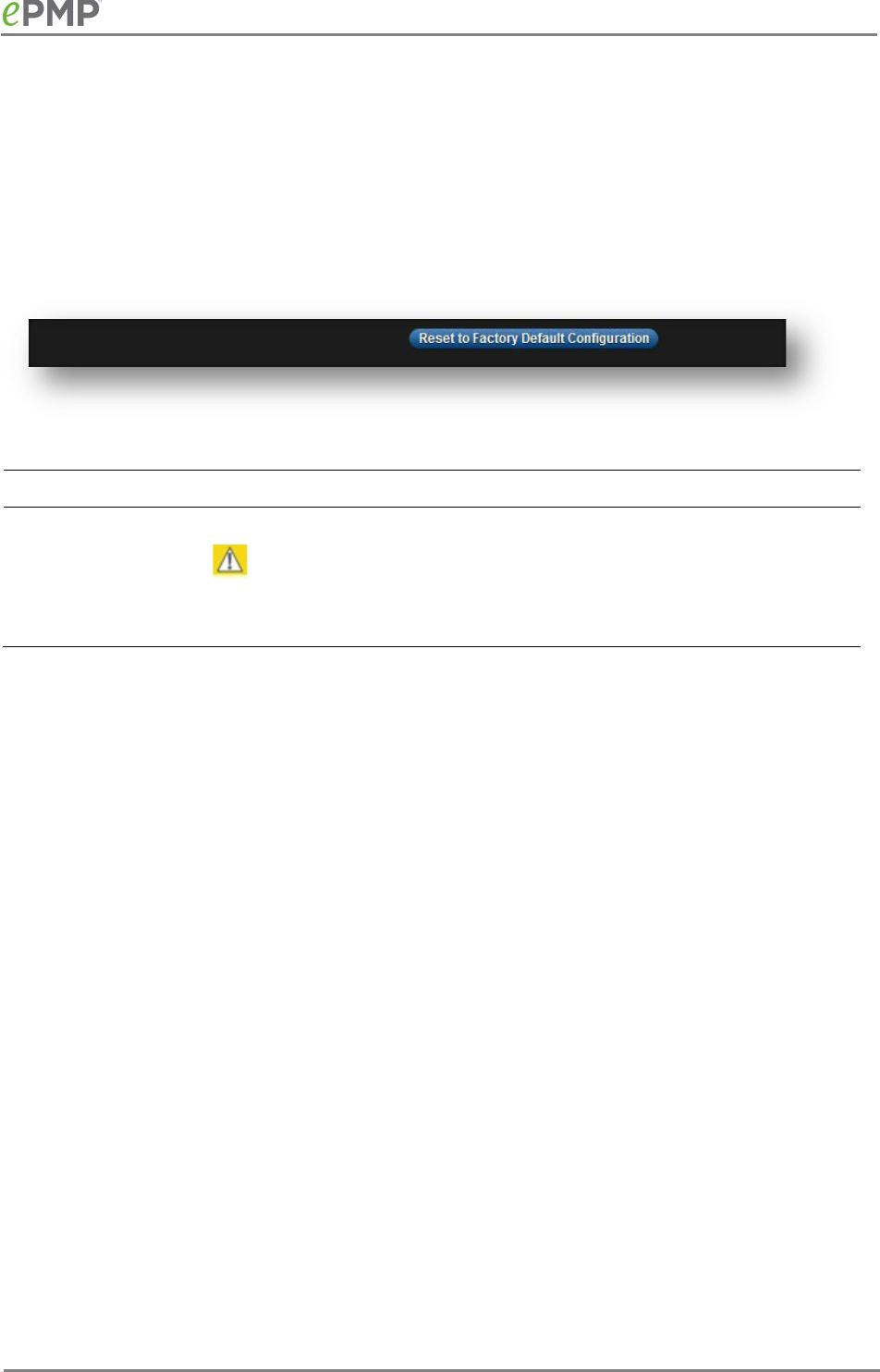
CAMBIUM NETWORKS
AP Factory Default page
Use the AP Factory Default page to reset the device to its factory default configuration. For more
factory defaulting methods, see:
•
Using the device external reset button
on page
206
•
Resetting the AP or STA to factory defaults by power cycling
on page
207
Figure 34
AP Factory Default page
Table 58
AP Software Upgrade attributes
Attribute
Meaning
Reset to Factory
Default
Configuration
Use this button to reset the device to its factory default configuration
Caution
A reset to factory default configuration resets all device parameters. The
AP will cease to transmit and any registered STAs will lose their session.
132

CAMBIUM NETWORKS
AP Spectrum Analyzer page
Use the AP Spectrum Analyzer page to configure AP spectrum analyzer parameters and to
download the spectrum analyzer tool.
To download the spectrum analyzer tool, the AP
Device Mode
must be set to
Spectrum Analyzer
.
Java Runtime Environment is required to run the AP spectrum analyzer.
Caution
Conducting spectrum analysis causes the AP to enter scan mode and the AP drops all RF
connections.
Vary the days and times when you analyze the spectrum in an area. The RF environment can
change throughout the day or throughout the week.
To conduct a spectrum analysis, follow this:
Required Software:
• Java Run-time Environment (JRE)
Procedure:
1
On the AP GUI, navigate to
Configure
=>
System
2
Configure
Device
mode to
Spectrum Analyzer
3
Click the
Save
button
4
Click the
Reset
button
5
Login to the AP GUI, then navigate to
Tools
=>
Spectrum Analyzer
6
Click
Download Spectrum Analyzer Tool
7
Locate the folder to which the spectrum analyzer tool was saved, and double-click on file
csa.jnlp
to launch the tool
8
If a security warning window appears, tick the checkbox next to “I accept the risk and want
to run this application”
133
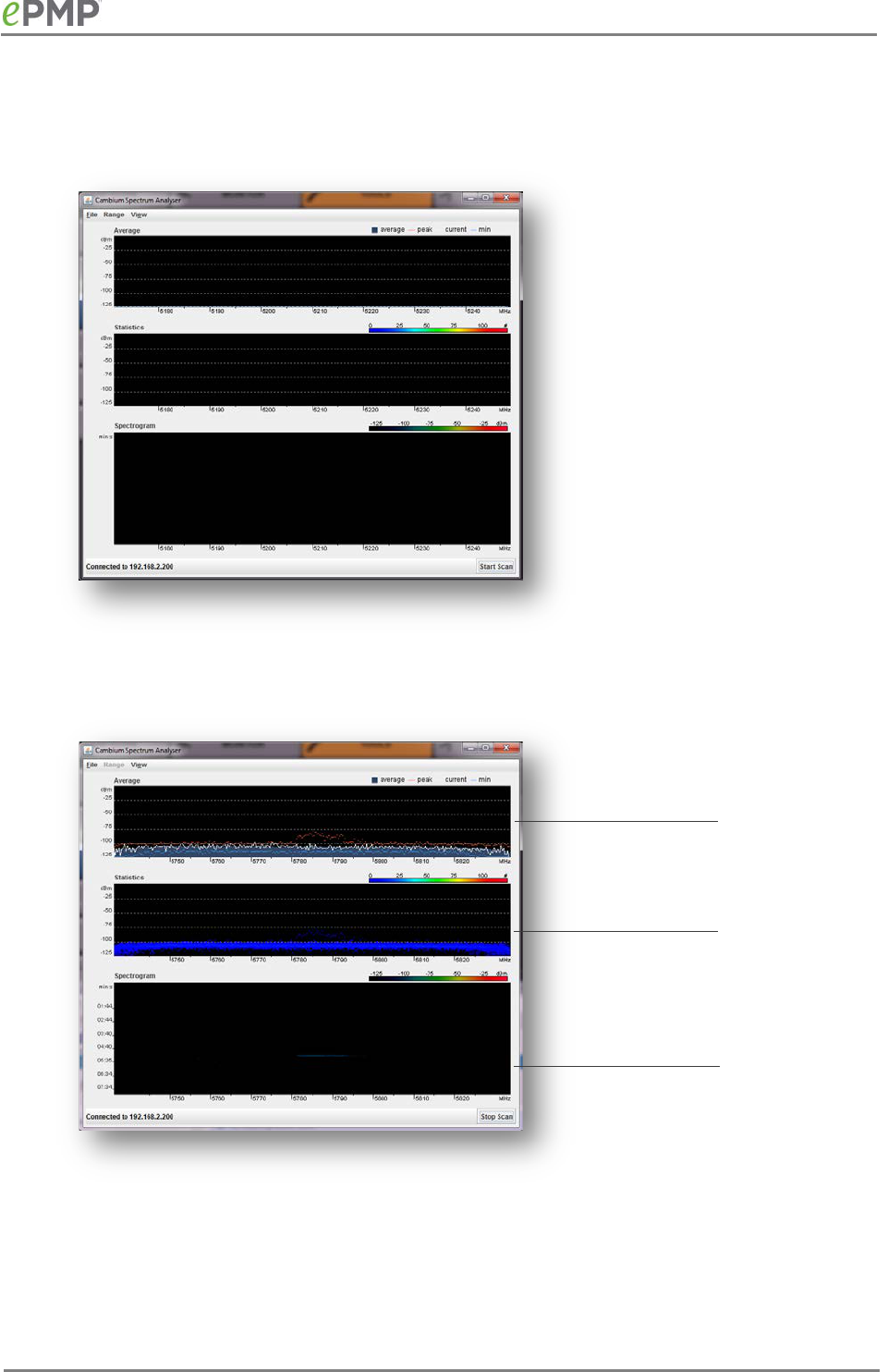
CAMBIUM NETWORKS
9
In the security warning window, click
Run
The spectrum analyzer interface is displayed
10
Click
Range
to configure the range of frequencies to scan.
11
Click
Start Scan
to begin scanning
Display of the
average, peak,
current, and
minimum
power levels for
the configured
range
Statistical
display of the
number of
times each
frequency in the
range was
scanned
Spectrogram
display of the
energy levels
detected
throughout the
configured
range, over
time
134

CAMBIUM NETWORKS
Once the scanning completes, follow these steps to return the device to AP operation:
Procedure:
1
In the spectrum analyzer application, click
Stop Scan
2
Close the spectrum analyzer application by clicking
File
=>
Exit
3
On the AP GUI, navigate to
Configure
=>
System
4
Configure
Device Mode
to
AP
5
Click the
Save
button
6
Click the
Reset
button
135
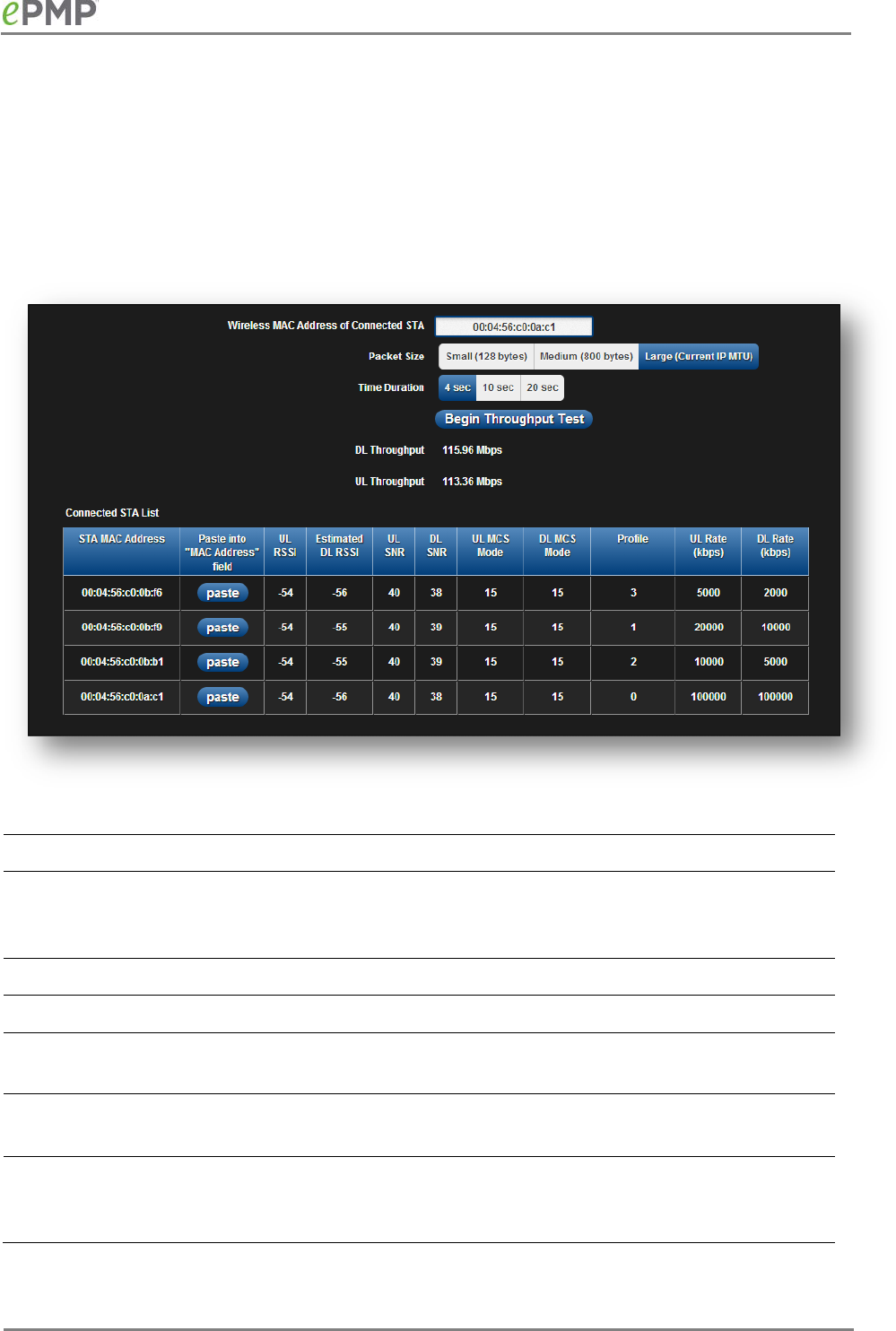
CAMBIUM NETWORKS
AP Throughput Test page
Use the AP Throughput Test page to conduct a simple test of AP wireless throughput to any one of
the connected STAs. This allows you to determine the throughput that can be expected on a
particular link without having to use external tools.
Figure 35
AP Throughput Test page
Table 59
AP Throughput Test attributes
Attribute
Meaning
Wireless MAC
Address of
Connected STA
Enter the MAC Address of one of the connected STAs or simply click the
“paste” button of the STA desired in the “Connected STA List”.
Packet Size Choose the Packet Size to use for the throughput test.
Time Duration Choose the Time Duration in seconds to use for the throughput test.
DL Throughput This field indicates the result of the throughput test on the downlink, in
Mbps.
UL Throughput This field indicates the result of the throughput test on the uplink, in
Mbps.
Connected STA list Use the Connected STA List table to monitor registered STAs and their
key RF status and statistics information. Click “paste” on the STA that is
desired to be used in the throughput test.
136
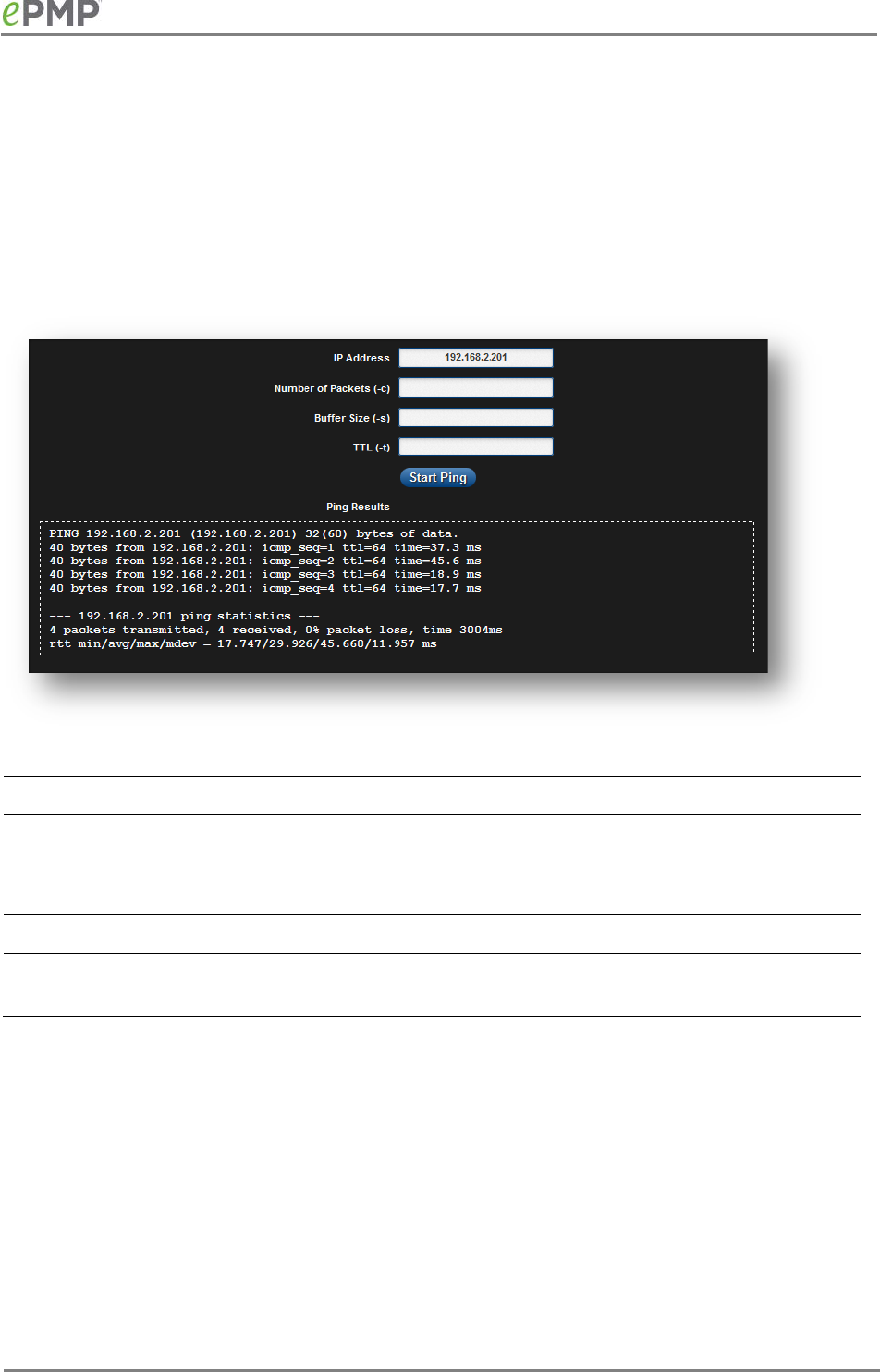
CAMBIUM NETWORKS
AP Ping page
Use the AP Ping page to conduct a simple test of AP IP connectivity to other devices which are
reachable from the network. If no ping response is received or if “Destination Host Unreachable” is
reported, the target may be down, there may be no route back to the AP, or there may be a failure
in the network hardware (i.e. DNS server failure).
Figure 36
AP Ping page
Table 60
AP Ping attributes
Attribute
Meaning
IP Address Enter the IP address of the ping target.
Number of packets
(-c)
Enter the total number of ping requests to send to the target.
Buffer size (-s) Enter the number of data bytes to be sent.
TTL (-t) Set the IP Time-To-Live (TTL) for multicast packets. This flag applies if
the ping target is a multicast address.
137
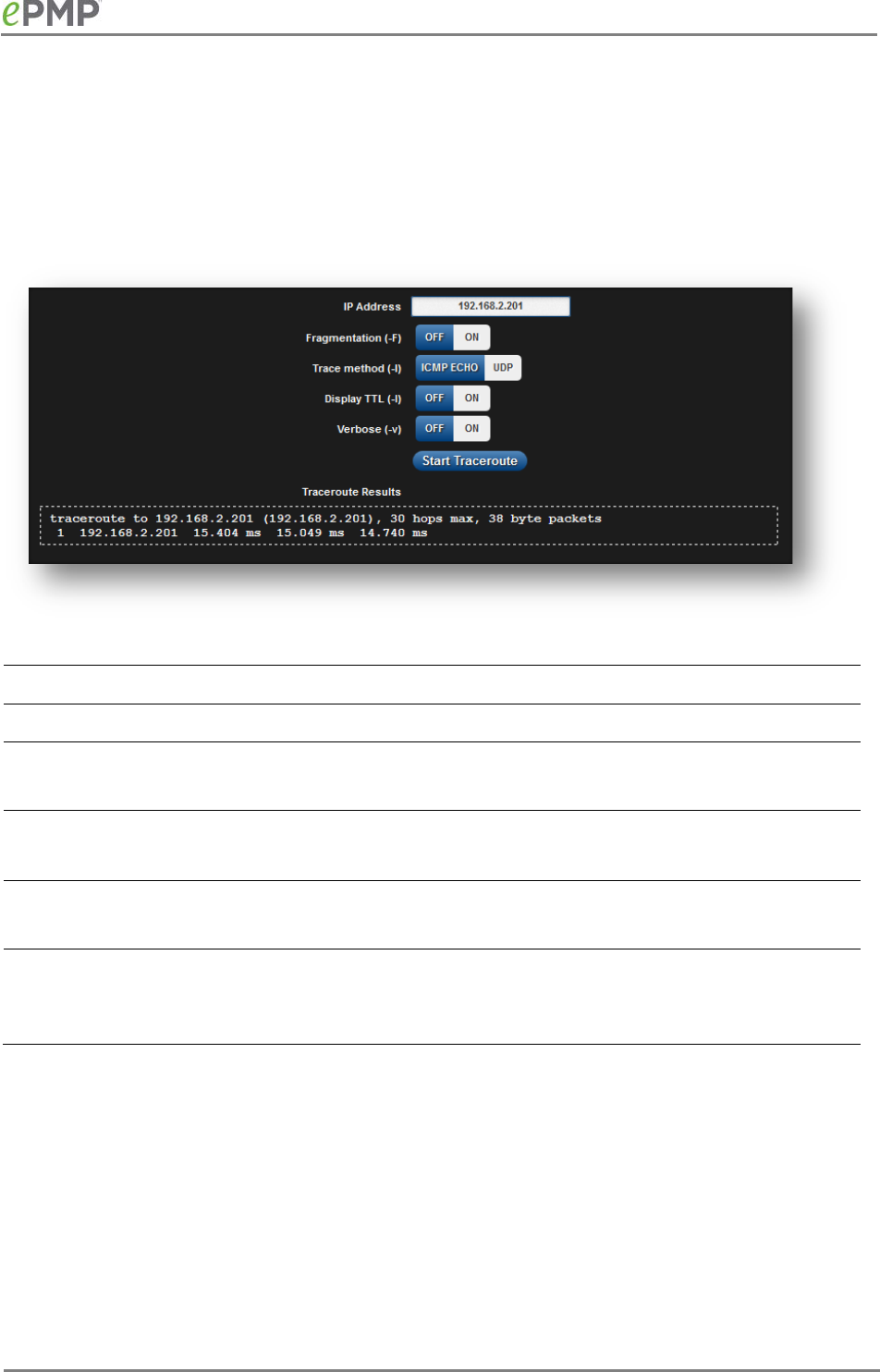
CAMBIUM NETWORKS
AP Traceroute page
Use the AP Traceroute page to display the route (path) and associated diagnostics for IP
connectivity between the AP and the destination specified.
Figure 37
AP Traceroute page
Table 61
AP Traceroute attributes
Attribute
Meaning
IP Address Enter the IP address of the target of the traceroute diagnostic.
Fragmentation (-F)
ON
: Allow source and target to fragment probe packets.
OFF
: Do not fragment probe packets (on source or target).
Trace method (-l)
ICMP ECHO
: Use ICMP ECHO for traceroute probes.
UDP
: Use UDP for traceroute probes.
Display TTL (-l)
ON
: Display TTL values for each hop on the route.
OFF
: Suppress display of TTL values for each hop on the route.
Verbose (-v)
ON
: ICMP packets other than TIME_EXCEEDED and UNREACHABLE are
displayed in the output.
OFF
: Suppress display of extraneous ICMP messaging.
138

CAMBIUM NETWORKS
Using the STA menu options
Use the menu navigation bar in the top and left panels to navigate to each web page.
Table 45
lists
the functional areas that may be accessed from each menu option. Some of the parameters are
only displayed for specific system configurations.
Table 62
Functional areas accessed from each menu option
Menu option
Menu Details
Configure
STA Configuration menu
on page
140
Radio
STA Radio page
on page
141
Quality of Service
STA Quality of Service page
on page
144
System
STA System page
on page
148
Network
STA Network page
on page
152
Security
STA Security page
on page
161
Monitor
STA Monitor menu
on page
165
Performance
STA Performance page
on page
166
System Status
STA System Status page
on page
169
Wireless Status
STA Wireless Status page
on page
171
Network Status
STA Network Status page
on page
174
System Log
STA System Log page
on page
176
Tools
STA Tools menu
on page
177
Software Upgrade
STA Software Upgrade page
on page
178
Factory Default
STA Factory Default page
on page
180
Spectrum Analyzer
STA Spectrum Analyzer page
on page
181
Throughput Test
STA Throughput Test page
on page
184
Ping
STA Ping page
on page
185
Traceroute
STA Traceroute page
on page
186
Quick Start
Configuring STA units using the Quick Start menu
on page
86
139

CAMBIUM NETWORKS
STA CONFIGURATION MENU
Use the Configuration menu to access all applicable device configuration parameters. The
configuration menu contains the following pages:
•
STA Radio page
on page
141
•
STA Quality of Service page
on page
144
•
STA System page
on page
148
•
STA Network page
on page
152
•
STA Security page
on page
161
140
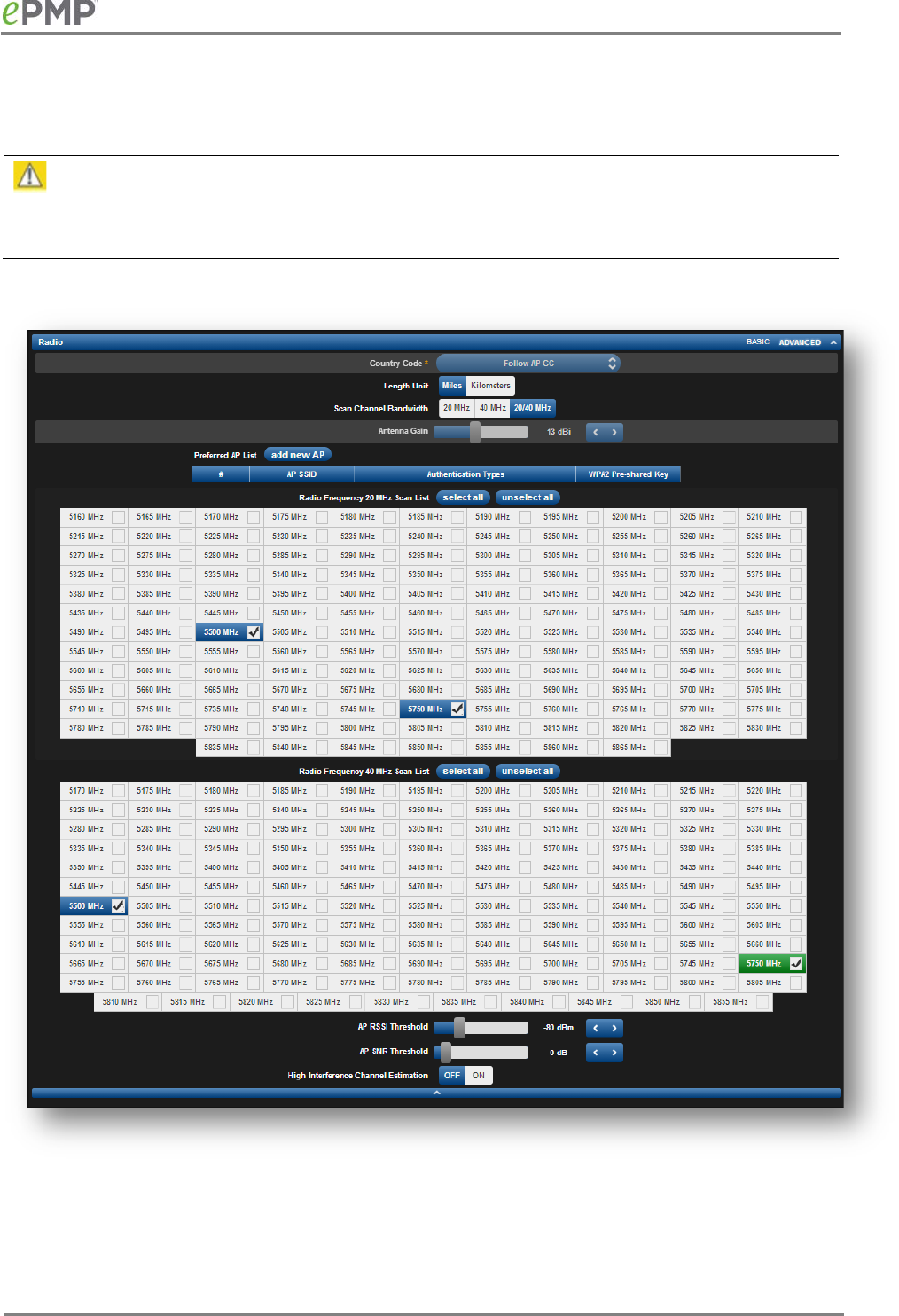
CAMBIUM NETWORKS
STA Radio page
Use the Radio page to configure the device radio interface parameters.
Caution
Modifying radio parameters may result in a wireless outage. Plan configuration modifications
accordingly.
Figure 38
STA Radio page
141

CAMBIUM NETWORKS
Table 63
STA Radio Configuration attributes
Attribute
Meaning
Country Code The STA automatically inherits the Country Code setting of the AP
(except for US-locked devices).
Country Code
settings affect the radios in the following ways:
• Maximum transmit power limiting (based on radio transmitter power
plus configured antenna gain)
• DFS operation is enabled based on the configured country code, if
applicable
• Frequency selection is based on local regulatory limits
Length Unit The unit of measurement used for reporting
Distance from AP
.
Scan Channel
Bandwidth
20 MHz
: The STA scans and operates with a 20 MHz-wide channel. To
associate to an AP, the AP must have the same channel bandwidth as
the STA.
40 MHz:
The STA scans and operates with a 40 MHz-wide channel. To
associate to an AP, the AP must have the same channel bandwidth as
the STA.
20/40 MHz:
The STA scans both 20 MHz and 40 MHz wide channels,
based on the configured
Radio Frequency 20 MHz Scan List
and the
configured
Radio Frequency 40 MHz Scan List
.
Antenna Gain This value represents the amount of gain introduced by the units internal
antenna. This parameter is read-only.
Preferred AP List The
Preferred AP List
is comprised of a list of up to 16 APs to which the
STA sequentially attempts registration. For each AP configured, if
authentication is required, enter a
Pre-shared Key
associated with the
configured
AP SSID
.
AP SSID Enter the AP Name (SSID) of the AP to which registration will be
attempted.
Authentication
Types
Enter the type of authentication preferred, whether
EAP-TTLS
,
WPA2
,
Open
or a combination of the three.
WPA2 Pre-shared
Key
If encryption is enabled on the AP, enter the Pre-shared Key which
matches the Pre-shared Key configured on the AP.
142
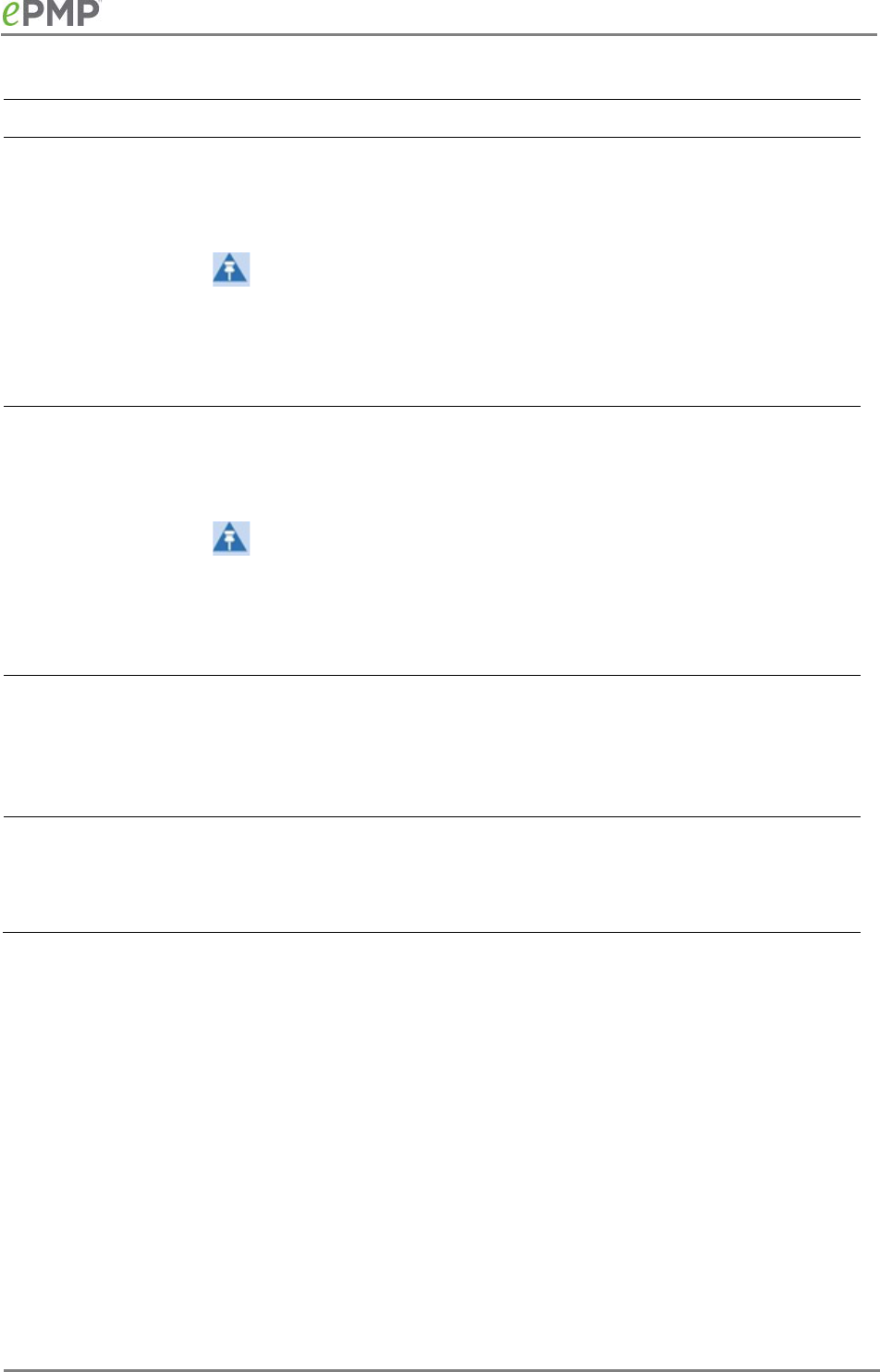
CAMBIUM NETWORKS
Attribute
Meaning
Radio Frequency 20
MHz Scan List
Select the frequencies for the STA to scan to attempt AP network entry
(with 20 MHz wide channel). To register to an AP, the STA must be
configured with the same frequency that is configured on the AP (AP
parameter
Frequency Carrier
).
Note
If operating in a DFS-required region, ensure that the STA is also
configured with the same frequencies as are configured in the AP’s
DFS
Alternate Frequency Carrier 1
and
DFS Alternate Frequency Carrier 2
parameters.
Radio Frequency 40
MHz Scan List
Select the frequencies for the STA to scan to attempt AP network entry
(with 40 MHz wide channel). To register to an AP, the STA must be
configured with the same frequency that is configured on the AP (AP
parameter
Frequency Carrier
).
Note
If operating in a DFS-required region, ensure that the STA is also
configured with the same frequencies as are configured in the AP’s
DFS
Alternate Frequency Carrier 1
and
DFS Alternate Frequency Carrier 2
parameters.
AP RSSI Threshold Set this parameter to the minimum Received Signal Strength Indicator
(RSSI) at the STA required for the STA to attempt registration to an AP.
For example, if the
AP RSSI Threshold
is set to -80 dBm, and the STA is
receiving the AP signal at -85 dBm (RSSI = -85 dBm), the STA will not
attempt to register to the AP.
AP SNR Threshold Set this parameter to the minimum Signal-to-Noise Ratio (SNR) at the
STA required for the STA to attempt registration to an AP. For example,
if the
AP SNR Threshold
is set to 30 dB and the STA is calculating its DL
CINR as 25 dB, the STA will not attempt to register to the AP.
143
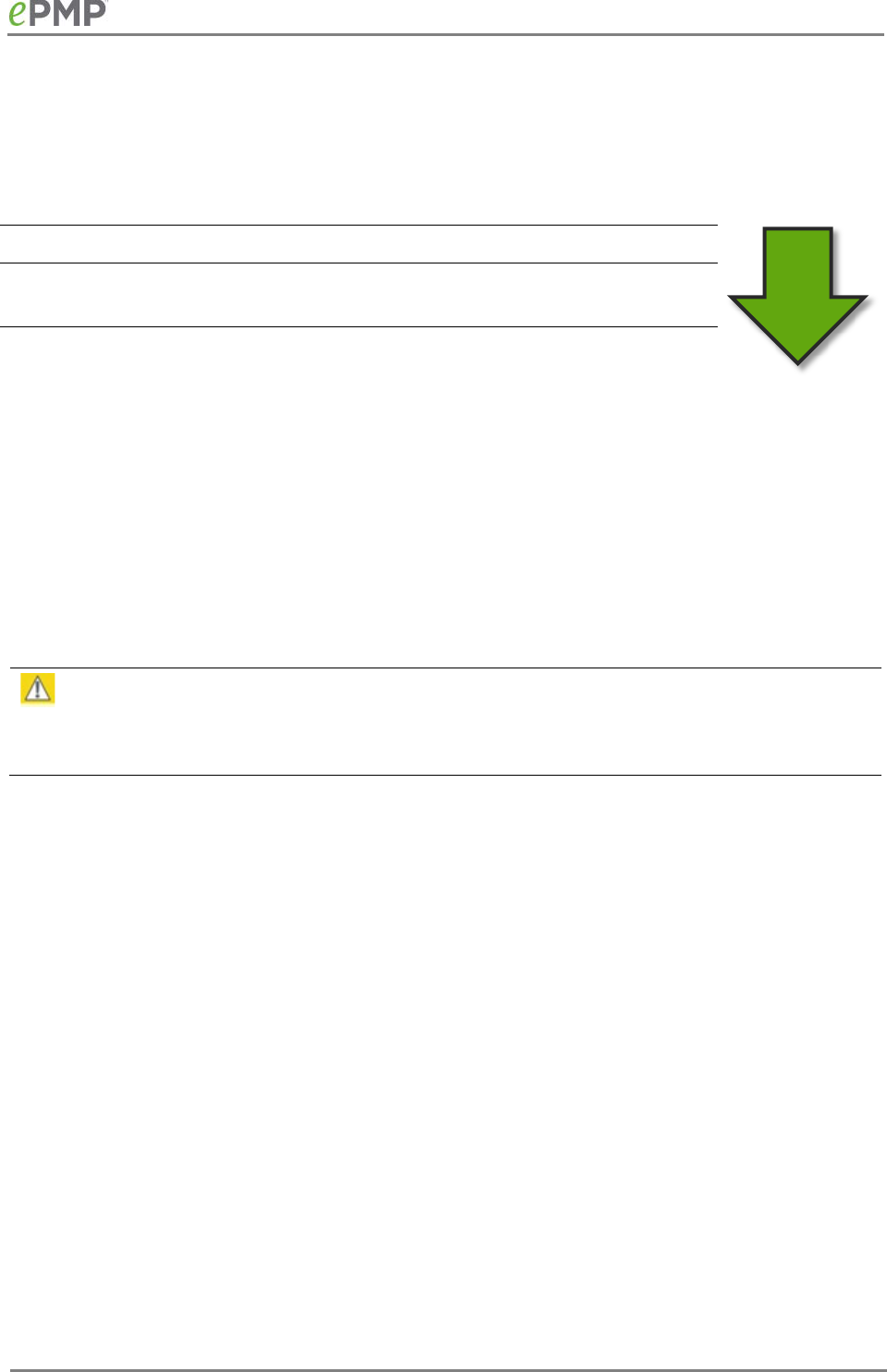
CAMBIUM NETWORKS
STA Quality of Service page
The ePMP platform supports three QoS priority levels using an air-fairness, priority-based
starvation avoidance scheduling algorithm:
Priority Level ePMP Traffic Priority Label
Highest Priority (Served first) VOIP
Medium Priority (Served once highest priority
traffic is sent)
High
Lowest Priority (Serviced once Highest and
Medium priority traffic is sent)
Low
• VoIP Priority (only utilized when
VOIP Enable
is set to
Enabled
)
• High Priority
• Low Priority
By default, all traffic passed over the air interface is low priority. The STA’s Quality of Service page
may be utilized to map traffic to certain priority levels using QoS classification rules. The rules
included in the table are enforced starting with the first row of the table.
Caution
Each additional traffic classification rule increases device CPU utilization. Careful network
planning is required to efficiently use the device processor.
The ePMP platform also supports radio data rate limiting (Maximum Information Rate, or MIR)
based on the configuration of the MIR table. Operators may add up to 16 MIR profiles on the AP,
each with unique limits for uplink and downlink data rates. The STA field
MIR Profile Setting
is
used to configure the appropriate MIR profile for limiting the STA’s data rate.
Priority
144
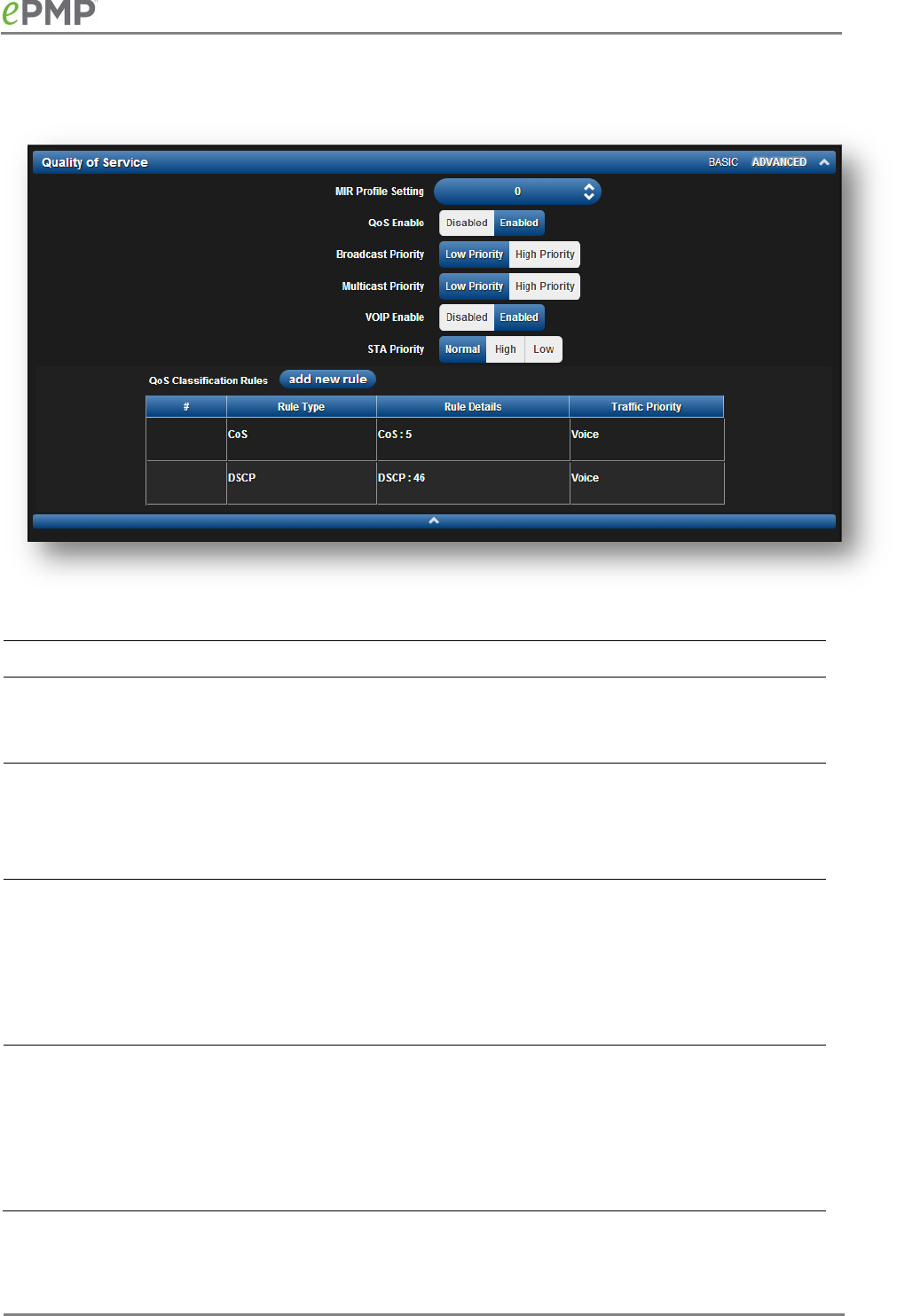
CAMBIUM NETWORKS
Figure 39
STA Quality of Service page
Table 64
STA Radio Configuration attributes
Attribute
Meaning
MIR Profile Setting Configure the desired MIR (Maximum Information Rate) profile for STA
operation. This profile must be configured on the AP, otherwise the
default profile (0) is used.
QoS Enable
Enabled
: The QoS Classification Rules table is editable and is utilized by
the device to classify traffic.
Disabled
: The QoS Classification Rules table is greyed-out and all traffic
is sent at one priority level.
Broadcast Priority
Low Priority
: All Broadcast traffic sent over the uplink is prioritized as
low priority, and will be delivered to the AP after scheduled high priority
and VoIP traffic.
High Priority
: All Broadcast traffic sent over the uplink is prioritized as
high priority, and will be scheduled for delivery to the AP before low
priority traffic but after VoIP traffic.
Multicast Priority
Low Priority
: All Multicast traffic sent over the uplink is prioritized as
low priority, and will be delivered to the AP after scheduled high priority
and VoIP traffic.
High Priority
: All Multicast traffic sent over the uplink is prioritized as
high priority, and will be scheduled for delivery to the AP before low
priority traffic but after VoIP traffic.
145

CAMBIUM NETWORKS
Attribute
Meaning
VOIP Enable
Enabled
: When enabled, two entries are automatically added to the first
and second rows of the QoS Classification Rules table, one with
Rule
Type CoS
(5) and one with
Rule Type DSCP
(46). The addition of these
rules ensures that VoIP traffic passed over the radio downlink is given
highest priority. The
CoS
and
DSCP
values may be modified to
accommodate non-standard VoIP equipment.
STA Priority
Normal
: STA will give priority to the packets as defined in the rules
which could be "Low", "High", or "VoIP". "Normal" priority will allow data
to be added to the appropriate "High", "Low", and "VoIP" queues based
on the QoS rules. This is the default setting. If no rule is defined for a
packet, then the packet priority will be “Low”.
High
: STA will place all data other than VoIP in the "High" queue. It will
be given higher priority than STAs configured with “Low” and “Normal”
when there is contention for bandwidth under the AP.
Low
: "Low" priority will place all data that is not VoIP in "Low" priority
queue. It will be given lower priority than STAs configured with “High”
when there is contention for bandwidth under the same AP.
"VoIP" queue is the highest priority queue followed by "High" queue and
then by "Low" queue. Higher priority queues have preference over lower
priority queues, but will not starve them.
QoS Classification
Rules
The QoS Classification Rules table contains all of the rules enforced by
the device when passing traffic over the radio downlink. Traffic passed
through the device is matched against each rule in the table; when a
match is made the traffic is sent over the radio link using the priority
defined in column
Traffic Priority
.
146

CAMBIUM NETWORKS
Attribute
Meaning
Rule Type
DSCP
: Differentiated Services Code Point; traffic prioritization is based
on the 6-bit Differentiated Services field in the IP header present in the
Ethernet frame header in the packet ingress of the Ethernet port.
CoS
: Class of Service; traffic prioritization is based on the 3-bit header
present in the 802.1Q VLAN-tagged Ethernet frame header in the packet
ingressing the STA’s Ethernet port.
VLAN ID:
Traffic prioritization is based on the VLAN ID of the packet
ingressing the STA’s Ethernet port.
EtherType:
Traffic prioritization is based on the two octet Ethertype field
in the Ethernet frame ingressing the STA’s Ethernet port. The Ethertype
is used to identify the protocol of the data in the payload of the Ethernet
frame.
IP:
Traffic prioritization is based on the source and/or destination IP
addresses of the packet ingress of the STA’s Ethernet port. A sub.net
mask may be included to define a range of IP addresses to match.
MAC:
Traffic prioritization is based on the source and/or destination
MAC addresses of the packet ingress of the STA’s Ethernet port. A mask
may be included to define a range of MAC addresses to match. The
mask is made up of a hex representation of a series of 1s to start the
mask and 0s that end the mask. A 1 may not follow a 0. Thus,
FF:FF:FF:FF:00:00 is allowed, but FF:00:FF:FF:FF:FF is not. The MAC
address is combined with the mask to define the range of allowed MAC
addresses.
Rule Details The
Rule Details
column is used to configure each classification rule
specified in column
Rule Type
.
Traffic Priority
High
: Traffic ingressing the STA’s Ethernet port is prioritized as “high
priority” for sending over the radio link (traffic will be sent after VOIP-
classified traffic, but before Low-classified traffic)
Low:
Traffic ingressing the STA’s Ethernet port is prioritized as “low
priority” for sending over the radio link (traffic will be sent after VOIP-
classified and High-classified traffic is sent).
147
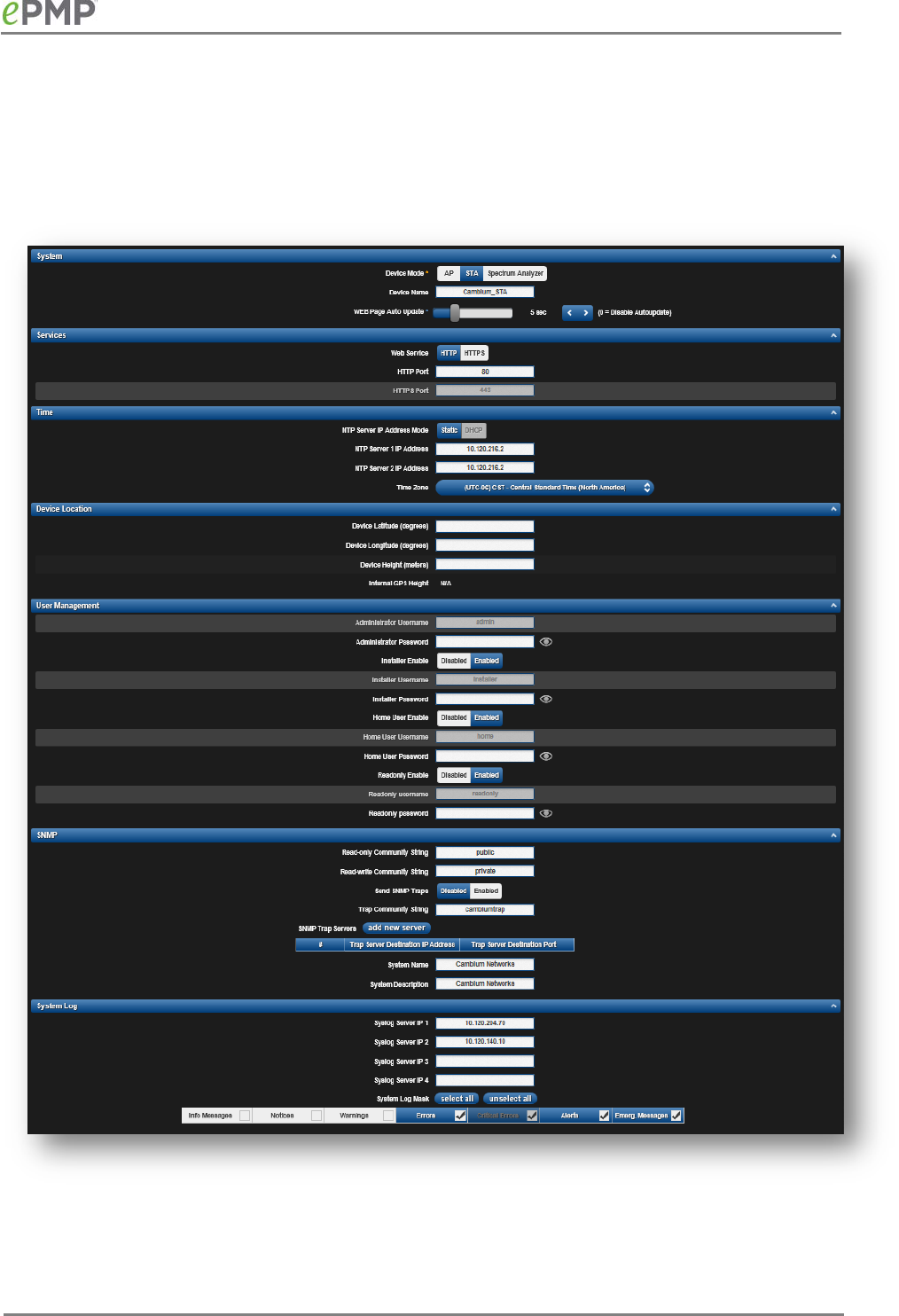
CAMBIUM NETWORKS
STA System page
The STA’s System page is used to configure system parameters, services, time settings, SNMP,
and syslog.
Figure 40
STA System page
148

CAMBIUM NETWORKS
Table 65
STA System attributes
Attribute
Meaning
Device Mode All ePMP devices may be configured to operate in one of three modes:
AP:
The device will operate as an AP
STA
: The device will operate as an STA
Spectrum Analyzer
: The devices will operate in Spectrum Analyzer
mode, allowing the operator to download the spectrum analyzer tool.
Device Name The
Device Name
is used to identify the STA on the network, and may
be retrieved by a NMS such as the Cambium Network Services Server
(CNSS).
WEB Page Auto
Update
Configure the interval for which the device retrieves system statistics for
display on the management interface. For example, if this setting is
configured to 5 seconds, the statistics and status parameters displayed
on the management interface will be refreshed every 5 seconds.
Web Service
HTTP
: Access to the device management GUI is conducted via HTTP
HTTPS
: Access to the device management GUI is conducted via HTTPS
HTTP Port If
Web Service
is set to
HTTP
, configure the port which the device uses
to service incoming HTTP requests for management GUI access.
HTTPS Port If
Web Service
is set to
HTTPS
, configure the port which the device uses
to service incoming HTTPS requests for management GUI access.
NTP Server IP
Address Mode
Static
: The device retrieves NTP time data from the servers configured
in fields
NTP Server IP Address
DHCP
: The device retrieves NTP time data from the server IP issued via
a network DHCP server.
NTP Server 1,2 IP
Address
Configure primary and secondary NTP server IP addresses from which
the device will retrieve time and date information.
Time Zone The
Time Zone
option may be used to offset the received NTP time to
match the operator’s local time zone.
Device Latitude Configure Latitude information for the device in decimal format.
Device Longitude Configure Longitude information for the device in decimal format.
Device Height Configure the Height above sea level information for the device, in
meters.
Internal GPS Height On a GPS Synchronized ePMP radio, the field is automatically populated
with the Device height above sea level from the on-board GPS chip.
149

CAMBIUM NETWORKS
Attribute
Meaning
Administrator,
Installer, Home
User, Readonly
Username
Read-only listing of available login levels.
• ADMINISTRATOR, full read write permissions.
• INSTALLER, permissions to read and write parameters applicable to
unit installation and monitoring.
• HOME USER, permissions only to access pertinent information for
support purposes.
• READONLY, permissions only to view the Monitor page.
Administrator,
Installer, Home User
Disabled
: The disabled user is not granted access to the device
management interface. The administrator user level cannot be disabled.
Enabled
: The user is granted access to the device management
interface.
Administrator,
Installer, Home
User, Readonly
Password
Configure a custom password configuration for each user to secure the
device. The password character display may be toggled using the
visibility icon .
Read-only
Community String
Specify a control string that can allow a Network Management Station
(NMS) such as the Cambium Networks Services Server (CNSS) to read
SNMP information. No spaces are allowed in this string. This password
will never authenticate an SNMP user or an NMS to read/write access.
The
SNMP Read-only Community String
value is clear text and is
readable by a packet monitor.
Read-write
Community String
Specify a control string that can allow a Network Management Station
(NMS) to access SNMP information. No spaces are allowed in this string.
Send SNMP Traps
Disabled
: With this setting, the radio will not send traps
Enabled
: Setting this will enable the radio to send SNMP traps to the
configured SNMP Trap Server.
Trap Community
String
Specify a control string to match the Trap Community String on the
SNMP Trap server. No spaces are allowed in this string.
SNMP Trap Servers The SNMP Trap Servers table contains all of the SNMP Trap servers the
radio can send SNMP traps.
Configure the IP Address which the device uses to send SNMP traps.
Trap Server
Destination IP
Address
Specify up to four SNMP Trap Servers to which the device will send
SNMP traps.
Trap Server
Destination Port
Configure port which the device uses to send SNMP traps.
150

CAMBIUM NETWORKS
Attribute
Meaning
System Name Specify a string to associate with the physical module. This parameter
can be polled by the Cambium Networks Services Server (CNSS) or an
NMS.
System Description Specify a description string to associate with the physical module. This
parameter can be polled by the Cambium Networks Services Server
(CNSS) or an NMS.
Syslog Server IP 1-4 Specify up to four syslog servers to which the device sends syslog
messages.
System Log Mask Configure the levels of syslog messages which the devices send to the
servers configured in parameters
Syslog Server IP 1-4
151
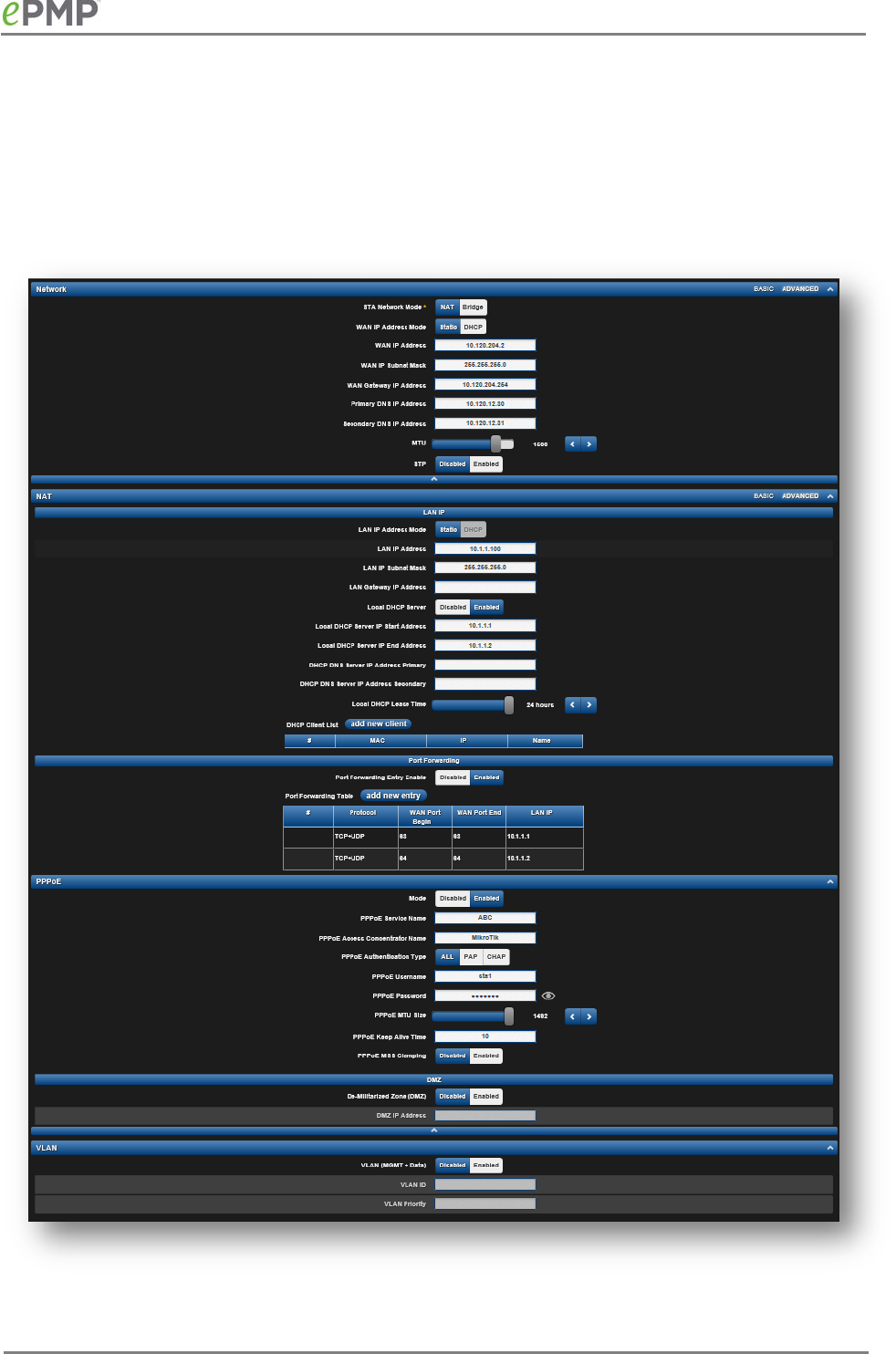
CAMBIUM NETWORKS
STA Network page
The STA’s Network page is used to configure system networking parameters and VLAN
parameters. Parameter availability is based on the configuration of the
STA Network Mode
parameter.
Figure 41
STA Network page, NAT mode
152

CAMBIUM NETWORKS
Table 66
STA Network attributes, NAT mode
Attribute
Meaning
STA Network Mode
NAT
: The STA acts as a router and packets are forwarded or filtered
based on their IP header (source or destination).
Bridge
: The STA acts as a switch, and packets are forwarded or filtered
based on their MAC destination address.
Device IP Address
Mode
Static
: Wireless IP addressing is configured manually in fields
Device IP
Address, Device IP Subnet Mask, Device Gateway IP Address, Primary
DNS IP Address
and
Secondary DNS IP Address
DHCP
: Device management IP addressing (IP address, subnet mask,
gateway, and DNS server) is assigned via a network DHCP server.
Device IP Address Wireless Internet protocol (IP) address. This address is used by the
family of Internet protocols to uniquely identify this unit on a network.
Device IP Subnet
Mask
Defines the address range of the connected IP network. For example, if
Device IP Address
is configured to 192.168.2.1 and
Device IP Subnet
Mask
is configured to 255.255.255.0, the device wireless interface will
belong to subnet 192.168.2.X.
Device Gateway IP
Address
Configure the IP address of a computer on the current network that acts
as a gateway. A gateway acts as an entrance and exit to packets from
and to other networks.
Primary DNS IP
Address
Configure The IP address of the primary server used for DNS resolution.
Secondary DNS IP
Address
Configure The IP address of the secondary server used for DNS
resolution.
MTU Maximum Transmission Unit; the size in bytes of the largest data unit
that the device is configured to process. Larger MTU configurations can
enable the network to operate with greater efficiency, but in the case of
retransmissions due to packet errors, efficiency is reduced since large
packets must be resent in the event of an error.
STP
Disabled
: When disabled, Spanning Tree Protocol (802.1d) functionality
is disabled at the STA.
Enabled
: When enabled, Spanning Tree Protocol (802.1d) functionality
is enabled at the STA, allowing for the prevention of Ethernet bridge
loops.
LAN IP Address
Mode
Static
: Device management IP addressing is configured manually in
fields
Device IP Address (LAN)
,
IP Subnet Mask (LAN)
,
Gateway IP
Address (LAN)
, and
DNS Server IP Address (LAN)
LAN IP Addess Internet protocol (IP) address. This address is used by the family of
Internet protocols to uniquely identify this unit on a network.
153

CAMBIUM NETWORKS
LAN IP Subnet Mask Defines the address range of the connected IP network. For example, if
Device IP Address (LAN)
is configured to 192.168.2.1 and
IP Subnet Mask
(LAN)
is configured to 255.255.255.0, the device will belong to subnet
192.168.2.X.
LAN Gateway IP
Address
Configure the IP address of a computer on the current network that acts
as a gateway. A gateway acts as an entrance and exit to packets from
and to other networks.
Local DHCP Server
Disabled
: Use this setting when STA is in NAT mode, to use the DHCP
server to hand out IP addresses to its clients.
Enabled
: Use this setting when STA is in NAT mode, to use the STA’s
local/onboard DHCP server to hand out IP addresses to its clients.
Local DHCP Server
IP Start Address
Configure the first address which will be issued to a DHCP client. Upon
additional DHCP requests, the
Local DHCP Server IP Start Address
will
be incremented until
Local DHCP Server IP End Address
is reached.
Local DHCP Server
IP End Address
Configure the final address which will be issued to a DHCP client.
DHCP DNS Server
IP Address Primary
Configure the primary DNS Server IP address which will be used to
configure DHCP clients (if
Local DHCP Server
is set to
Enabled
)
DHCP DNS Server
IP Address
Secondary
Configure the secondary DNS Server IP address which will be used to
configure DHCP clients (if
Local DHCP Server
is set to
Enabled
)
Local DHCP Lease
Time
Configure the time for which a DHCP IP address is leased. When the
lease time expires, the DHCP client must renew IP addressing via DHCP
request.
DHCP Client List The DHCP Client List table identifies hardware situated below the STA
which shall be issued DHCP IP addressing information. The STA acts as
a DHCP server, responding to requests from hardware connected to the
STA.
MAC Configure the physical address of the device which will retrieve DHCP IP
addressing information from the STA.
IP Configure the IP address which will be assigned to the device.
Name Configure a logical name for the device configured (i.e. VoIP Phone1, or
Network Camera1).
Port Forwarding
Entry Enable
The STA port forwarding functionality may be used to configure the STA
to route external network services to an internal IP address so that end
devices (situated below the STA) are reachable from external networks.
Caution
Opening ports for forwarding may introduce a network security risk.
154

CAMBIUM NETWORKS
Port Forwarding
Table
The
Port Forwarding Table
is used to define which range of wireless
ports are forwarded to which LAN (STA local network) IP addresses.
Protocol
UDP
: Packet forwarding decisions are based on UDP packets
TCP
: Packet forwarding decisions are based on TCP packets
WAN Port Begin Configure the beginning of the range of wireless ports to match for
forwarding to
LAN IP
WAN Port End Configure the end of the range of wireless ports to match for forwarding
to
LAN IP
LAN IP Configure the LAN IP of the device situated below the STA which will
receive the packets forwarded based on the
Port Forwarding Table
configuration.
PPPoE
Point-to-Point Protocol over Ethernet
: Used for encapsulating PPP
frames inside Ethernet frames.
Mode
Disabled:
Default.
Enabled
: Configure this field to “Enabled” to setup a PPPoE tunnel on
the STA.
PPPoE Service
Name
An optional entry to set a specific service name to connect to for the
PPPoE session. If this is left blank the STA will accept the first service
option that comes back from the Access Concentrator specified below, if
any. This is limited to 32 characters.
PPPoE Access
Concentrator Name
An optional entry to set a specific Access Concentrator to connect to for
the PPPoE session. If this is blank, the STA will accept the first Access
Concentrator which matches the service name (if specified). This is
limited to 32 characters.
PPPoE
Authentication Type
ALL
: This means that CHAP authentication will be attempted first, then
PAP authentication. The same password is used for both types.
CHAP
: This means that CHAP authentication will be attempted.
PAP
:
This means that PAP authentication will be attempted.
PPPoE Username This is the CHAP/PAP username that will be used. This is limited to 32
characters.
PPPoE Password This is the CHAP/PAP password that will be used. This is limited to 32
characters.
PPPoE MTU Size Maximum Transmission Unit; the size in bytes of the largest data unit
that the device is configured to process inside the PPPoE tunnel. This
field allows the operator to specify the largest MTU value to use in the
PPPoE session, if
PPPoE MSS Clamping
is
Enabled
. The user will be able
to enter an MTU value up to 1492. However, if the MTU determined in
LCP negotiations is less than this user-specified value, the SM will use
the smaller value as its MTU for the PPPoE link.
155

CAMBIUM NETWORKS
PPPoE Keep Alive
Time
Configure the Keep Alive Time to allow the radio to keep the PPPoE
session up after establishment. As an example, if this field is set to 5, the
PPPoE client will send a keep alive message to the PPPoE server every 5
seconds. If there is no acknowledgement, it will send the keep alive
message to the server 4 more times (for a total or 5 times) before tearing
down the PPPoE session. Setting this to 12 will mean the keep alive
message will be sent every 12 seconds and when there is no
acknowledgement, the client will try for a total of 12 times every 12
seconds before tearing down the PPPoE session.
PPPoE MSS
Clamping
Disabled
: The STA PPPoE session will allow any MTU size determined
by other devices in the PPPoE session during the LCP negotiations.
Enabled
: The STA PPPoE session will enforce a max MTU size
determined by the
PPPoE MTU Size
setting for all devices in the PPPoE
session during the LCP negotiations, unless one of the devices enforces
a MTU setting that is smaller in value.
De-Militarized Zone
(DMZ)
Disabled
: No devices are configured to expose services to the local area
network as well as the wide-area network.
Enabled
: When enabled, the device configured in
DMZ IP Address
may
provide network services (web servers or FTP servers) to the network
internal to the STA as well as the wide-area network (Internet).
DMZ IP Address Configure the IP address of an STA-connected device which will be
allowed to provide network services to the wide-area network.
VLAN
Enabled
: A VLAN configuration establishes a logical group within the
network. Each computer in the VLAN, regardless of initial or eventual
physical location, has access to the same data based on the VLAN
architecture. For the network operator, this provides flexibility in
network segmentation, simpler management, and enhanced security.
When the STA is in NAT mode, the VLAN configuration is applicable to
both management and user data.
Disabled
: When disabled, all IP management and data traffic is allowed
to the device.
VLAN ID Configure this parameter to include the device’s management and user
traffic on a separate VLAN network.
156
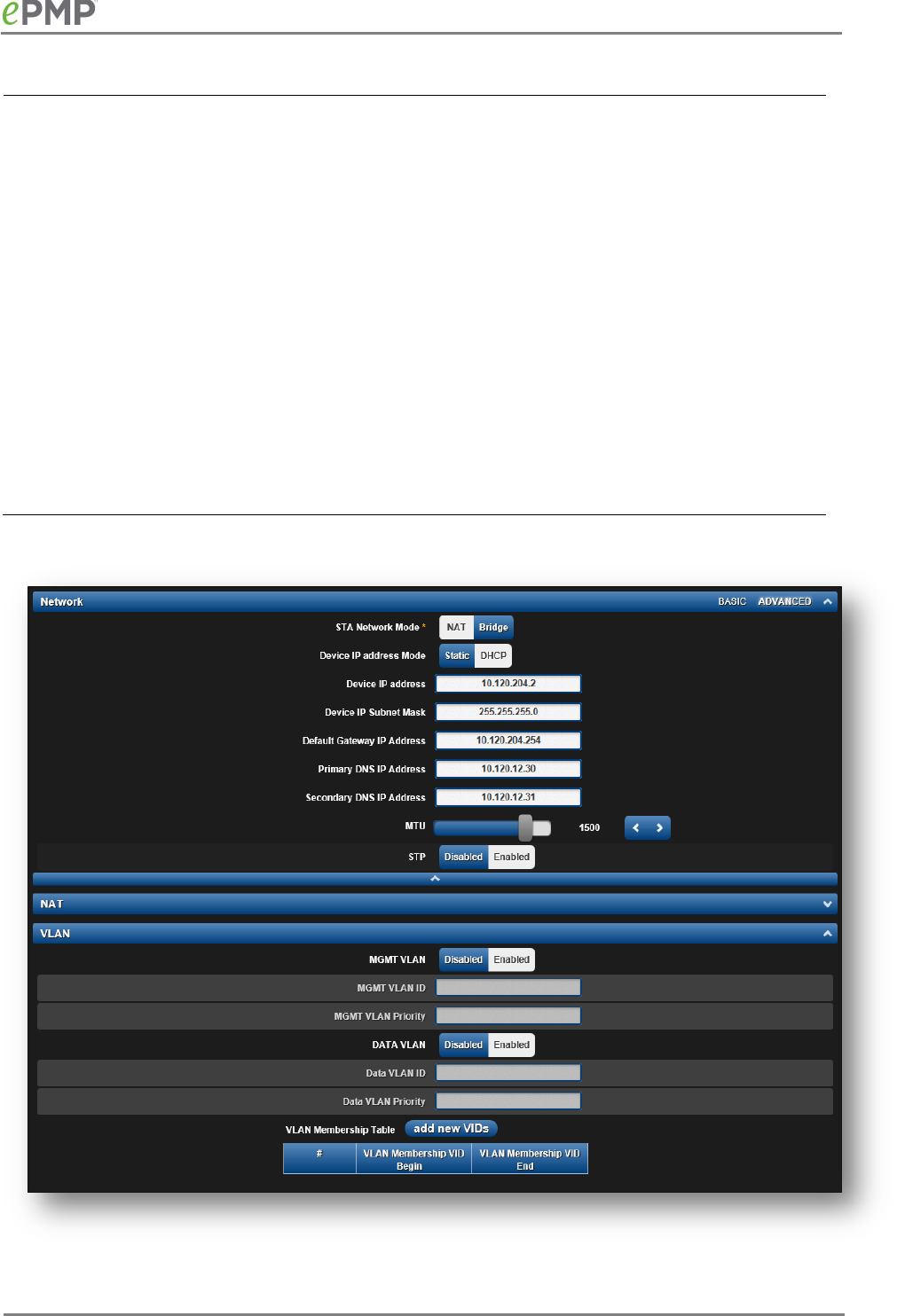
CAMBIUM NETWORKS
VLAN Priority ePMP radios can prioritize VLAN traffic based on the eight priorities
described in the IEEE 802.1p specification.
Data VLAN Priority
represents the VLAN Priority or Class of Service (CoS). Operators may
use this prioritization field to give precedence to device user and
management data.
If the
VLAN Priority
field
is configured, for traffic to traverse the device
the accessing switch or end device must be configured to tag Ethernet
frames with the
VLAN ID
value and the same priority values as
configured in field
VLAN Priority
. For example, if
VLAN ID
is set to 100
and
VLAN Priority
is set to 5, the Ethernet frames sent to the STA to
from a PC situated below the STA must be tagged with a VLAN ID value
of 100 and Class of Service priority set to 5 to be sent over the air to the
AP.
If
VLAN Priority
is not configured (blank), for traffic to traverse the device
the accessing switch or end device only needs to tag Ethernet frames
with the same VLAN ID as is configured in the
VLAN ID
field.
Figure 42
STA Network page, Bridge mode
157

CAMBIUM NETWORKS
Table 67
STA Network attributes, Bridge mode
Attribute
Meaning
STA Network Mode
NAT
: The STA acts as a router, and packets are forwarded or filtered
based on their IP header (source or destination).
Bridge
: The STA acts as a switch, and packets are forwarded or filtered
based on their MAC destination address
Device IP address
Mode
Static
: Device management IP addressing is configured manually in
fields
Device IP Address (LAN)
,
IP Subnet Mask (LAN)
,
Gateway IP
Address (LAN)
, and
DNS Server IP Address (LAN)
DHCP
: Device management IP addressing (IP address, subnet mask,
gateway, and DNS server) is assigned via a network DHCP server, and
parameters
Device IP Address (LAN)
,
IP Subnet Mask (LAN)
,
Gateway IP
Address (LAN)
, and
DNS Server IP Address (LAN)
are unused.
Device IP Address Internet protocol (IP) address. This address is used by the family of
Internet protocols to uniquely identify this unit on a network.
Note
If
Device IP address Mode
is set to
DHCP
and the device is unable to
retrieve IP address information via DHCP, the device management IP is
set to fallback IP 192.168.0.1 (AP mode), 192.168.0.2 (STA mode),
192.168.0.3 (Spectrum Analyzer mode) or the previously-configured
static Device IP Address. Units may always be accessed via the Ethernet
port with IP 10.1.1.254.
Device IP Subnet
Mask
Defines the address range of the connected IP network. For example, if
Device IP Address (LAN)
is configured to 192.168.2.1 and
IP Subnet Mask
(LAN)
is configured to 255.255.255.0, the device will belong to subnet
192.168.2.X.
Device Gateway IP
Address
Configure the IP address of a computer on the current network that acts
as a gateway. A gateway acts as an entrance and exit to packets from
and to other networks.
Primary DNS IP
Address
Configure The IP address of the primary server used for DNS resolution.
Secondary DNS IP
Address
Configure The IP address of the secondary server used for DNS
resolution.
MTU Maximum Transmission Unit; the size in bytes of the largest data unit
that the device is configured to process. Larger MTU configurations can
enable the network to operate with greater efficiency, but in the case of
retransmissions due to packet errors, efficiency is reduced since large
packets must be resent in the event of an error.
158

CAMBIUM NETWORKS
STP
Disabled
: When disabled, Spanning Tree Protocol (802.1d) functionality
is disabled at the STA.
Enabled
: When enabled, Spanning Tree Protocol (802.1d) functionality
is enabled at the STA, allowing for the prevention of Ethernet bridge
loops.
MGMT VLAN
Enabled
: The STA management interface can be assigned to a
Management VLAN to separate management traffic (remote module
management via SNMP or HTTP) from user traffic (such as internet
browsing, voice, or video. Once the management interface is enabled for
a VLAN, an STA’s management interface can be accessed only by
packets tagged with a VLAN ID matching the management VLAN ID.
A VLAN configuration establishes a logical group within the network.
Each computer in the VLAN, regardless of initial or eventual physical
location, has access to the same data based on the VLAN architecture.
For the network operator, this provides flexibility in network
segmentation, simpler management, and enhanced security.
Disabled
: When disabled, all IP management traffic is allowed to the
device.
MGMT VLAN ID Configure this parameter to include the device’s management traffic on
a separate VLAN network. For example, if
MGMT VLAN ID
is set to 2,
GUI access will only be allowed from IP packets tagged with VLAN ID 2.
MGMT VLAN
Priority
ePMP radios can prioritize VLAN traffic based on the eight priorities
described in the IEEE 802.1p specification.
MGMT VLAN Priority
represents the VLAN Priority or Class of Service (CoS). Operators may
use this prioritization field to give precedence to device management
traffic.
If the
MGMT VLAN Priority
field
is configured, to access the STA GUI
the accessing switch or end device must be configured to tag Ethernet
frames with the
MGMT VLAN ID
value and the same priority values as
configured in field
MGMT VLAN Priority
. For example, if
MGMT VLAN
ID
is set to 100 and
MGMT VLAN Priority
is set to 5, the Ethernet frames
sent to the STA to access the GUI must be tagged with a VLAN ID value
of 100 and Class of Service priority set to 5.
If
MGMT VLAN Priority
is not configured (blank), to access the STA GUI
the accessing switch or end device only needs to tag Ethernet frames
with the same VLAN ID as is configured in the
MGMT VLAN ID
field.
Data VLAN ID Configure this parameter to include the device’s user traffic (i.e. Internet
browsing, VoIP, or video) on a separate VLAN network. For example, if
Data VLAN ID
is set to 2, user data (i.e. Internet browsing, video) is
allowed only from IP packets tagged with VLAN ID 2.
159

CAMBIUM NETWORKS
Data VLAN Priority ePMP radios can prioritize VLAN traffic based on the eight priorities
described in the IEEE 802.1p specification.
Data VLAN Priority
represents
the VLAN Priority or Class of Service (CoS). Operators may use this
prioritization field to give precedence to device user data.
If the
Data VLAN Priority
field
is configured, for user traffic to traverse
the device the accessing switch or end device must be configured to tag
Ethernet frames with the
Data VLAN ID
value and the same priority
values as configured in field
Data VLAN Priority
. For example, if
Data
VLAN ID
is set to 100 and
Data VLAN Priority
is set to 5, the user traffic
Ethernet frames sent to the STA to from a PC situated below the STA
must be tagged with a VLAN ID value of 100 and Class of Service priority
set to 5 to be sent over the air to the AP.
If
Data VLAN Priority
is not configured (blank), for user traffic to traverse
the device the accessing switch or end device only needs to tag Ethernet
frames with the same VLAN ID as is configured in the
Data VLAN ID
field.
VLAN Membership
Table
Configure the STA
VLAN Membership Table
to include the STA in one or
more VLANs. When the STA receives a packet tagged with a VLAN ID
which is contained in the STA
VLAN Membership Table
, the packet is
forwarded over the air interface to the AP. When the STA receives a
packet tagged with a VLAN ID which is not present in the STA
VLAN
Membership Table
, the frame is dropped.
160
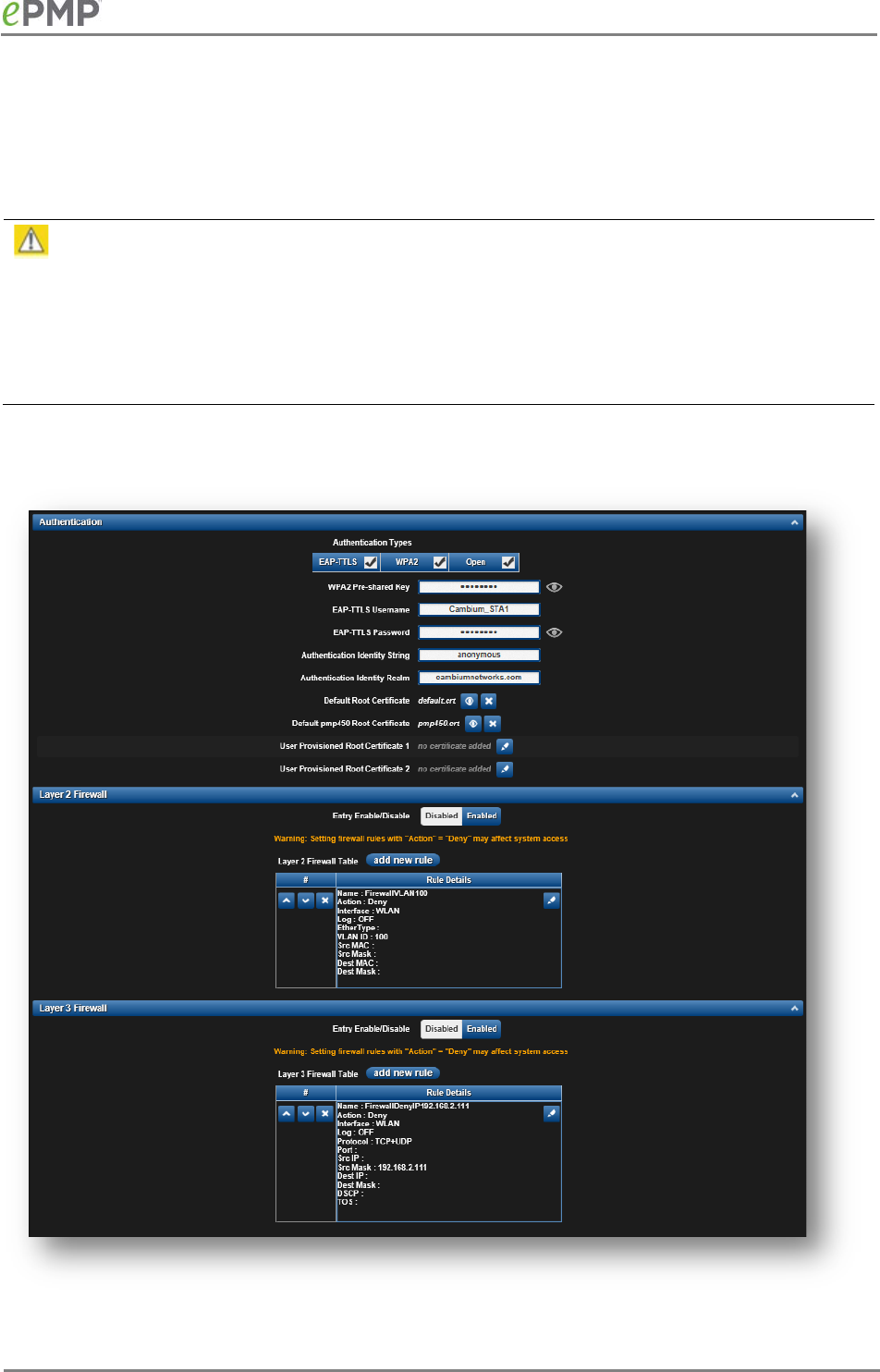
CAMBIUM NETWORKS
STA Security page
The STA’s Security page is used to configure system security features including STA
authentication and Layer2/Layer3 Firewall rules.
Caution
If a device firewall rule is added with
Action
set to
Deny
and
Interface
set to
LAN
or
WAN
and no
other rule attribute are configured, the device will drop all Ethernet or wireless traffic,
respectively. Ensure that all firewall rules are specific to the type of traffic which must be denied,
and that no rules exist in the devices with only
Action
set to
Deny
and
Interface
set to
LAN
or
WAN.
To regain access to the device, perform a factory default.
Figure 43
STA Security page
161

CAMBIUM NETWORKS
Table 68
STA Security attributes
Attribute
Meaning
Authentication Types Enter the type of authentication preferred, whether
EAP-TTLS
,
WPA2
,
Open
or a combination of the three.
WPA2 Pre-shared Key Configure this key on the AP, and then configure each of the network
STAs with this key to complete the authentication configuration. This key
must be between 8 to 128 symbols.
EAP-TTLS Username Configure the EAP-TTLS Username to match the credentials on the
Radius server being used for the network.
EAP-TTLS Password Configure the EAP-TTLS Password to match the credentials on the
Radius server being used for the network.
Authentication
Identity String
Configure this Identity string to match the credentials on the Radius
server being used for the network. Default value for this parameter is
“anonymous”.
Authentication
Identity Realm
Configure this Identity string to match the credentials on the Radius
server being used for the network. Default value for this parameter is
“cambiumnetworks.com”.
Default Root
Certificate
Default EAP-TTLS root certificate that must match the certificate on the
Radius server
Default pmp450 Root
Certificate
PMP 450 default EAP-TTLS root certificate to match the certificate on the
Radius server used with current PMP 450 deployments.
User Provisioned
Root Certificate 1
Import a user certificate if a certificate different from the default
certificates is needed.
User Provisioned
Root Certificate 2
Import a second user certificate if a certificate different from the default
or 1st user provisioned certificate is needed.
Layer 2 Firewall Entry
Enable/Disable
Enabled
: Modifications to the Layer 2 Firewall Table are allowed and
rules are enforced.
Disabled
: Modifications to the Layer 2 Firewall Table are not allowed
and rules are not enforced.
Layer 2 Firewall Table The Layer 2 firewall table may be used to configure rules matching layer
2 (MAC layer) traffic which result in forwarding or dropping the traffic
over the radio link or Ethernet interface.
Rule Details, Name Assign a logical name to the firewall rule based on the intended rule
operation (i.e. “Deny all WLAN traffic from VLAN ID 100”).
Rule Details, Action
Accept
: Layer 2 traffic matching the rule details are forwarded.
Deny
: Layer 2 traffic matching the rule details are dropped at the device.
162

CAMBIUM NETWORKS
Rule Details, Interface
WLAN
: When this option is selected, firewall rules are applied to traffic
incoming on the device radio interface (WLAN). Depending on the
setting of the
Action
parameter, traffic matching the rule details will
either be forwarded to the LAN (Ethernet) interface or dropped at the
device.
LAN
: When this option is selected, firewall rules are applied to traffic
incoming on the device Ethernet interface (LAN). Depending on the
setting of the
Action
parameter, traffic matching the rule details will be
either forwarded to the WAN (radio) interface or dropped at the device
Rule Details, Log
On
: When a firewall rule is matched, a resulting system log message is
generated
Off
: When a firewall rule is matched, no system log messaging is
generated
Rule Details,
EtherType
Rule matching is based on the two octet Ethertype field in the Ethernet
frame. The Ethertype is used to identify the protocol of the data in the
payload of the Ethernet frame.
Rule Details, VLAN ID Rule matching is based on the VLAN ID of the packet
Rule Details, Src MAC Firewall rule matching is based on the source MAC address of the packet
Rule Details, Src Mask A mask may be included to define a range of MAC addresses to match.
The mask is made up of a hex representation of a series of 1s to start the
mask and 0s that end the mask. A 1 may not follow a 0. Thus,
FF:FF:FF:FF:00:00 is allowed, but FF:00:FF:FF:FF:FF is not. The MAC
address is combined with the mask to define the range of allowed MAC
addresses.
Rule Details, Dest
MAC
Firewall rule matching is based on the destination MAC address of the
packet
Rule Details, Dest
Mask
A mask may be included to define a range of MAC addresses to match.
The mask is made up of a hex representation of a series of 1s to start the
mask and 0s that end the mask. A 1 may not follow a 0. Thus,
FF:FF:FF:FF:00:00 is allowed, but FF:00:FF:FF:FF:FF is not. The MAC
address is combined with the mask to define the range of allowed MAC
addresses.
Layer 3 Firewall Entry
Enable/Disable
Enabled
: Modifications to the Layer 3 Firewall Table are allowed and
rules are enforced
Disabled
: Modifications to the Layer 3 Firewall Table are not allowed
and rules are not enforced
Layer 3 Firewall Table The Layer 3 firewall table may be used to configure rules matching layer
3 (IP layer) traffic which result in forwarding or dropping the traffic over
the radio link or Ethernet interface.
163

CAMBIUM NETWORKS
Rule Details, Name Assign a logical name to the firewall rule based on the intended rule
operation (i.e. “Deny all WLAN traffic from Src IP 192.168.2.111”).
Rule Details, Action
Accept
: Layer 3 traffic matching the rule details are forwarded.
Deny
: Layer 3 traffic matching the rule details are dropped at the device.
Rule Details, Interface
WLAN
: When this option is selected, firewall rules are applied to traffic
incoming on the device radio interface (WLAN). Depending on the
setting of the
Action
parameter, traffic matching the rule details will
either be forwarded to the LAN (Ethernet) interface or dropped at the
device.
LAN
: When this option is selected, firewall rules are applied to traffic
incoming on the device Ethernet interface (LAN). Depending on the
setting of the
Action
parameter, traffic matching the rule details will be
either forwarded to the WAN (radio) interface or dropped at the device.
Rule Details, Log
On
: When a firewall rule is matched, a resulting system log message is
generated.
Off
: When a firewall rule is matched, no system log messaging is
generated.
Rule Details, Protocol
TCP
: Only TCP packets will be matched by the configured rule
UDP
: Only UDP packets will be matched by the configured rule
TCP+UDP
: Only TCP and UDP packets will be matched by the configured
rule
ICMP
: Only ICMP packets will be matched by the configured rule
IP
: All IP packets will be matched by the configured rule
Rule Details, Port Rule matching is based on the port value in the incoming packet.
Rule Details, Src IP Rule matching is based on the Source IP address of the incoming packet.
Rule Details, Src Mask A subnet mask may be included to define a range of IP addresses to
match. For example, if
Src IP
is configured to 192.168.2.0 and
Src Mask
is configured to 255.255.255.0, the rule matches all IP addresses from
subnetwork 192.168.2.X.
Rule Details, Dest IP Rule matching is based on the Destination IP address of the incoming
packet.
Rule Details, Dest
Mask
A subnet mask may be included to define a range of IP addresses to
match. For example, if
Dest IP
is configured to 192.168.2.0 and
Dest
Mask
is configured to 255.255.255.0, the rule matches all IP addresses
from subnetwork 192.168.2.X.
Rule Details, DSCP Rule matching is based on the DiffServ CodePoint value of the incoming
packet
Rule Details, TOS Rule matching is based on the Type Of Service value of the incoming
packet.
164

CAMBIUM NETWORKS
STA MONITOR MENU
Use the Monitor menu to access device and network statistics and status information. This section
may be used to analyze and troubleshoot network performance and operation.
The Monitor menu contains the following pages:
•
STA Performance page
on page
166
•
STA System Status page
on page
169
•
STA Wireless Status page
on page
171
•
STA Network Status page
on page
174
•
STA System Log page
on page
176
165
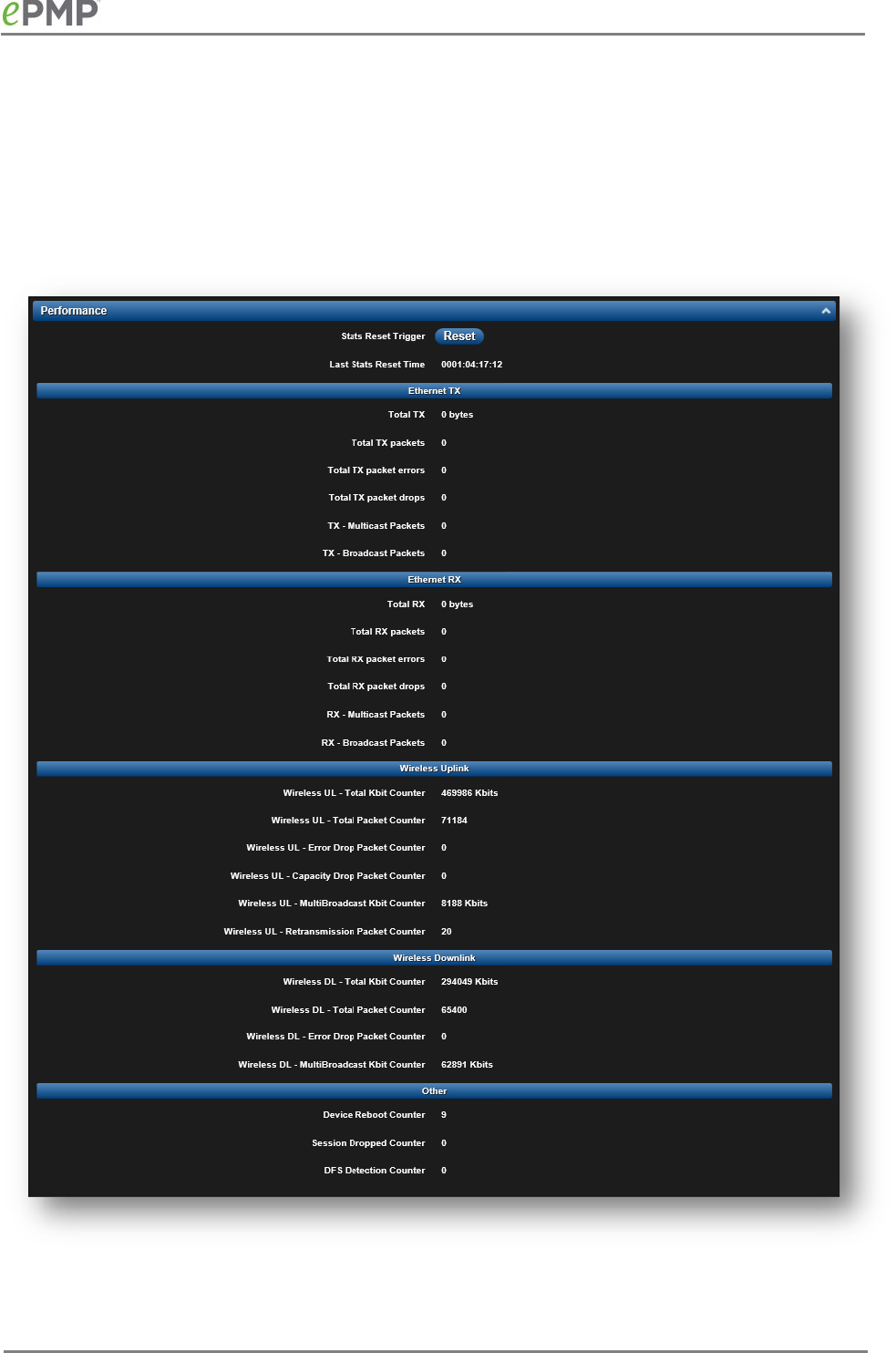
CAMBIUM NETWORKS
STA Performance page
Use the Performance page to monitor system status and statistics to analyze and troubleshoot
network performance and operation.
Figure 44
STA Performance page
166

CAMBIUM NETWORKS
Table 69
STA Performance page attributes
Attribute
Meaning
Stats Reset Trigger Reset all statistics.
Ethernet TX, Total TX Total count of bytes transferred from the STA’s Ethernet interface.
Ethernet TX, Total TX
packets
Total count of packets transferred from the STA’s Ethernet interface.
Ethernet TX, Total TX
packet errors
Total count of packets transmitted out of the STA’s Ethernet interface
with errors due to collisions, CRC errors, or irregular packet size.
Ethernet TX, Total TX
packet drops
Total count of packets dropped prior to sending out of the AP’s Ethernet
interface due to Ethernet setup or filtering issues.
Ethernet TX, TX –
Multicast Packets
Total count of multicast packets sent via the STA’s Ethernet interface.
Ethernet TX, TX –
Broadcast Packets
Total count of broadcast packets sent via the STA’s Ethernet interface.
Ethernet RX, Total RX Total count of bytes received by the STA’s Ethernet interface.
Ethernet RX, Total RX
packets
Total count of packets received by the STA’s Ethernet interface.
Ethernet RX, Total RX
packet errors
Total count of packets received by the STA’s Ethernet interface with
errors due to collisions, CRC errors, or irregular packet size.
Ethernet RX, Total RX
packet drops
Total count of packets dropped prior to sending out of the STA’s
wireless interface due to Ethernet setup or filtering issues.
Ethernet RX, RX –
Multicast Packets
Total count of multicast packets received via the STA’s Ethernet
interface.
Ethernet RX, RX –
Broadcast Packets
Total count of broadcast packets received via the STA’s Ethernet
interface.
Wireless Uplink, Total
Kbit Counter
Total count of packets transmitted out of the STA’s wireless interface in
Kbits.
Wireless Uplink, Total
Packet Counter
Total count of packets transmitted out of the STA’s wireless interface.
Wireless Uplink, Error
Drop Packet Counter
Total count of packets dropped after transmitting out of the STA’s
wireless interface due to RF errors (No acknowledgement and other RF
related packet error).
Wireless Uplink,
Capacity Drop Packet
Counter
Total count of packets dropped after transmitting out of the STA’s
wireless interface due to capacity issues (data buffer/queue overflow or
other performance or internal packet errors).
167

CAMBIUM NETWORKS
Attribute
Meaning
Wireless Uplink,
MultiBroadcast Kbit
Counter
Total count of multicast and broadcast packets transmitted out of the
STA’s wireless interface in Kbits.
Wireless Uplink,
Retransmission Packet
Counter
Total count of packets retransmitted after transmitting out of the STA’s
Wireless interface due to RF errors (No acknowledgement and other RF
related packet error).
Wireless Downlink,
Total Kbit Counter
Total Kbits received via the STA’s wireless interface.
Wireless Downlink,
Total Packet Counter
Total count of packets received via the STA’s wireless interface.
Wireless Downlink,
Error Drop Packet
Counter
Total count of packets dropped prior to sending out of the STA’s
Ethernet interface due to RF errors (packet integrity error and other RF
related packet error).
Wireless Downlink,
MultiBroadcast Kbit
Counter
Total count of multicast and broadcast packets received on the STA’s
wireless interface in Kbits.
Device Reboot
Counter
Count of the number of reboots on the device since it has been powered
up.
Session Dropped
Counter
Count of the number of times the STA deregistered with the AP since
the first registration.
DFS Detection
Counter
Count of the number of times the STA triggered a DFS event.
168
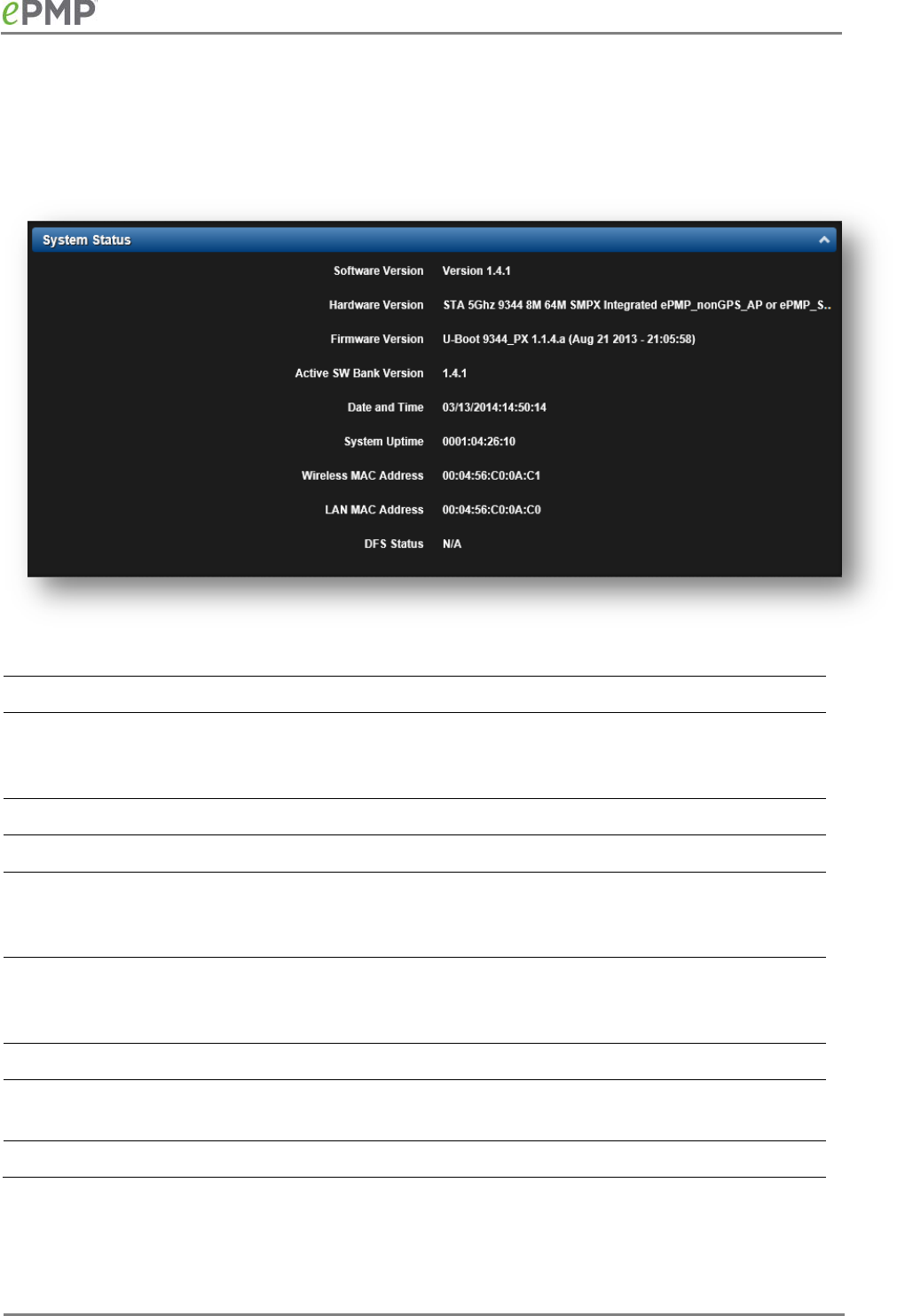
CAMBIUM NETWORKS
STA System Status page
Use the System Status page to reference key system information.
Figure 45
STA System Status page
Table 70
STA System Status page attributes
Attribute
Meaning
Software Version Current operating version of software on the device. This listing is also
present on the GUI footer bar (which contains a hyperlink to download
new system software).
Hardware Version Board hardware version information.
Firmware Version U-Boot version information.
Active SW Bank
Version
Current operating version of software on the device in the active
partition. This must be the same as the Software Version field above
when the device is under normal operation.
Date and Time Current date and time, subject to time zone offsets introduced by the
configuration of the device
Time Zone
parameter. This shows a factory-
configured time until a valid NTP server is configured.
System Uptime The total system uptime since the last device reset.
Wireless MAC
Address
The hardware address of the device wireless interface.
LAN MAC Address The hardware address of the device LAN (Ethernet) interface.
169

CAMBIUM NETWORKS
Attribute
Meaning
DFS Status
N/A:
DFS operation is not required for the region configured in
parameter
Country Code
Channel Availability Check
: Prior to transmitting, the device must check
the configured
Frequency Carrier
for radar pulses for 60 seconds). If no
radar pulses are detected, the device transitions to state
In-Service
Monitoring
In-Service Monitoring
: Radio is transmitting and receiving normally
while monitoring for radar pulses which require a channel move
Radar Signal Detected
: The receiver has detected a valid radar pulse and
is carrying out detect-and-avoid mechanisms (moving to an alternate
channel).
In-Service Monitoring at Alternative Channel
: The radio has detected a
radar pulse and has moved operation to a frequency configured in
DFS
Alternative Frequency Carrier 1
or
DFS Alternative Frequency Carrier 2
System Not In Service due to DFS
: The radio has detected a radar pulse
and has failed channel availability checks on all alternative frequencies.
The non-occupancy time for the radio frequencies in which radar was
detected is 30 minutes
170
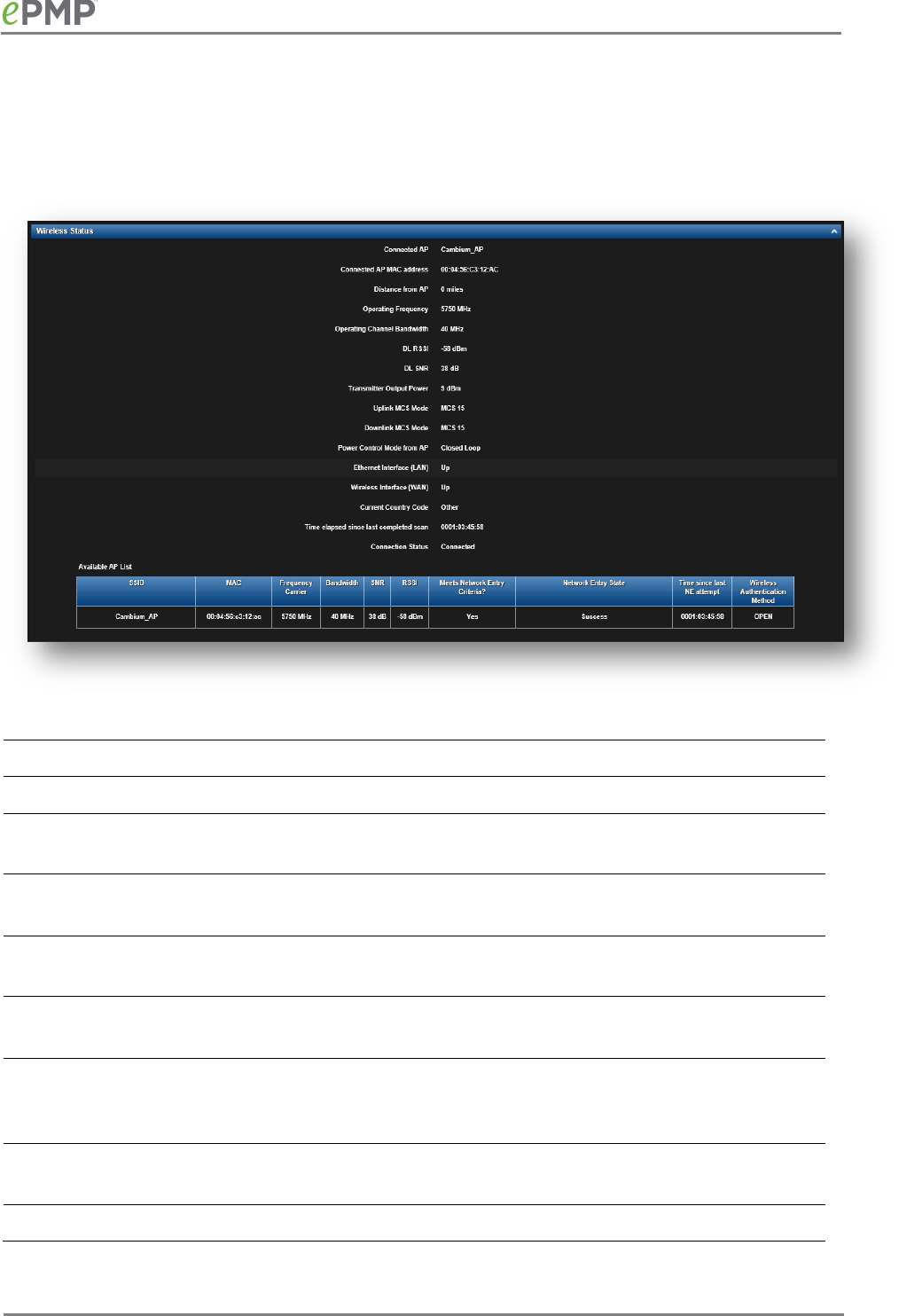
CAMBIUM NETWORKS
STA Wireless Status page
Use the Wireless Status page to reference key information about the radio’s wireless interface.
Figure 46
STA Wireless Status page
Table 71
STA Wireless Status page attributes
Attribute
Meaning
Connected AP SSID of the AP to which the STA is registered.
Connected AP MAC address Wireless MAC address of the AP to which the STA is
registered.
Distance from AP The distance from the AP, determined by radio signal
propagation delay.
Operating Frequency The current frequency at which the STA is transmitting and
receiving.
Operating Channel
Bandwidth
The current channel size at which the STA is transmitting and
receiving.
DL RSSI The Received Signal Strength Indicator, which is a
measurement of the power level being received by the STA’s
antenna.
DL SNR The Signal to Noise Ratio, which is an expression of the carrier
signal quality with respect to signal noise.
Transmitter Output Power The current power level at which the STA is transmitting.
171

CAMBIUM NETWORKS
Attribute
Meaning
Uplink MCS Mode Modulation and Coding Scheme – indicates the modulation
mode used for the radio uplink, based on radio conditions
(MCS 1-7, 9-15).
Downlink MCS Mode Modulation and Coding Scheme – indicates the modulation
mode used for the radio downlink, based on radio conditions
(MCS 1-7, 9-15).
Power Control Mode from the
AP
Open Loop
: In this mode, the STA will not receive any power
change information in the Group Poll Frame. STA calculates
the UL transmit power based on path loss calculations only.
Closed Loop
: In closed loop UL power control, station will get
the AP actual transmit power of beacon frame and
STA Target
Received Power Level
in the beacon. Based on these two
values, STA will calculate the path loss. Based on path loss and
TRL values it will calculate it’s transmit power such that the
signal from STA arrives at AP at the configured target level.
Path loss calculation will be updated by STA every time there
is a change in values of AP actual TX power or TRL in the
Beacon.
Ethernet Interface (LAN)
Up
: The radio (LAN) interface is functioning properly.
Down
: The radio (LAN) interface has encountered an error and
is not servicing traffic.
Wireless Interface (WAN)
Up
: The radio (WAN) interface is functioning properly.
Down
: The radio (WAN) interface has encountered an error and
is not servicing traffic.
Current Country Code The current code the STA is operating under.
Time elapsed since last
completed scan
Amount of time elapsed since the last scan was completed by
the STA for available APs.
Connection Status The current registration status of the STA.
Available AP List The
Available AP List
may be referenced to view which APs are
available for STA network entry, and also to view the status of
the current AP to STA radio link.
SSID The SSID of the visible AP.
MAC The MAC address of the visible AP.
Frequency Carrier The current operating frequency of the visible AP.
Bandwidth The current operating channel bandwidth of the visible AP.
SNR The current measured Signal-to-Noise Ratio of the STA to AP
link.
172

CAMBIUM NETWORKS
Attribute
Meaning
RSSI The current measured Received Signal Strength Indicator at
the AP.
Meets Network Entry Attempt
Criteria
Yes
: The scanned AP meets the Network Entry criteria defined
by the internal Network Algorithm.
No:
The scanned AP does not meet the Network Entry criteria
defined by the internal Network Algorithm.
Network Entry State The indication of the result of the STA’s network entry attempt:
Successful
: STA registration is successful
Failed
:
Out of Range
: The STA is out of the AP’s configured
maximum range (
Max Range
parameter)
Failed
:
Capacity limit reached at AP
: The AP is no longer
allowing STA network entry due to capacity reached
Failed: No Allocation on AP
: The STA to AP handshaking
failed due to a misconfigured pre-shared key between the STA
and AP
Failed: SW Version Incompatibility:
The version of software
resident on the AP is older than the software version on the
STA
Failed: PTP Mode: ACL Policy
: The AP is configured with
PTP
Access
set to
MAC Limited
and the STA’s MAC address is not
configured in the AP’s
PTP MAC Address
field
Failed: Other
: The AP does not have the required available
memory to allow network entry
Time since last NE attempt This timer indicates the last time that the STA attempted
network entry to the AP.
Security Mode This field indicates the security state of the AP to STA link.
173
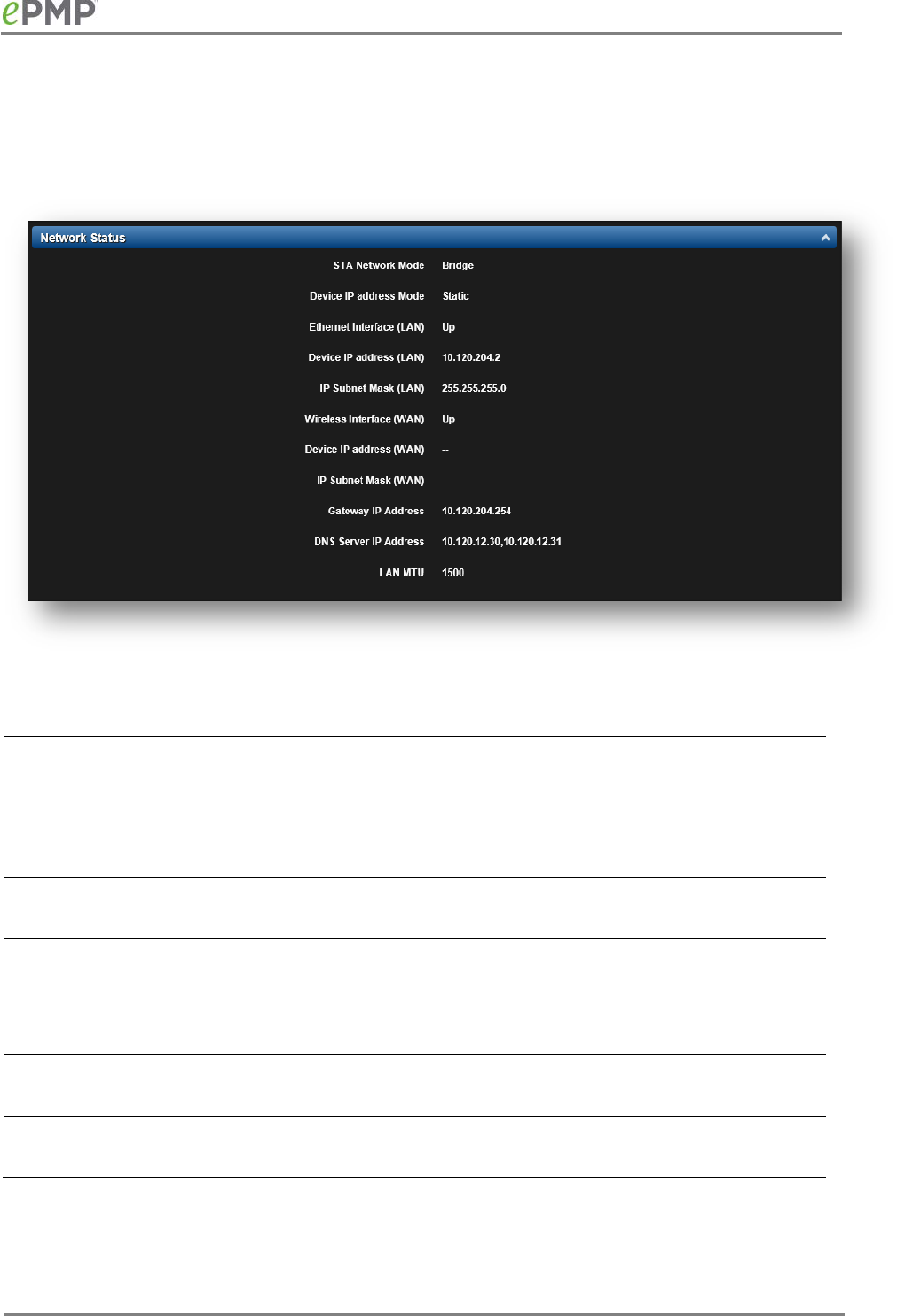
CAMBIUM NETWORKS
STA Network Status page
Use the STA Network Status page to reference key information about the device network status.
Figure 47
STA Network Status page
Table 72
STA Network Status page attributes
Attribute
Meaning
STA Network Mode
Bridge:
The STA will act as a switch, and packets are forwarded or
filtered based on their MAC destination address.
NAT:
The STA will act as a router, and packets are forwarded or filtered
based on their IP header (source or destination) which can be grouped
into subnets for finer granularity.
Device IP Address
Mode
The current IP Address mode of the device (Static or DHCP)
Ethernet Interface
(LAN)
Up
: The device Ethernet interface is functioning and passing data
Down
: The device Ethernet interface has encountered an error
disallowing full operation. Reset the device to reinitiate the Ethernet
interface.
Device IP address
(LAN)
The currently configured Ethernet IP address, used for device
management.
IP Subnet Mask
(LAN)
The currently configured device IP subnet mask.
174

CAMBIUM NETWORKS
Attribute
Meaning
Wireless Interface
(WAN)
Up
: The device wireless interface is functioning and passing data
Down
: The device wireless interface has encountered an error
disallowing full operation. Reset the device to reinitiate the wireless
interface.
Device IP address
(WAN)
The IP address for the wireless interface is displayed only when the STA
is in NAT Mode.
IP Subnet Mask
(WAN)
The subnet for the wireless interface is displayed only when the STA is
in NAT Mode.
Gateway IP Address The IP address of a computer on the current network that acts as a
gateway. A gateway acts as an entrance and exit to packets from and to
other networks.
DNS Server IP
Address
The IP addresses of the primary and secondary (if configured) servers
used for DNS resolution.
LAN MTU The currently configured Maximum Transmission Unit for the AP’s
Ethernet (LAN) interface. Larger MTU configurations can enable the
network to operate with greater efficiency, but in the case of
retransmissions due to packet errors, efficiency is reduced since large
packets must be resent in the event of an error.
175
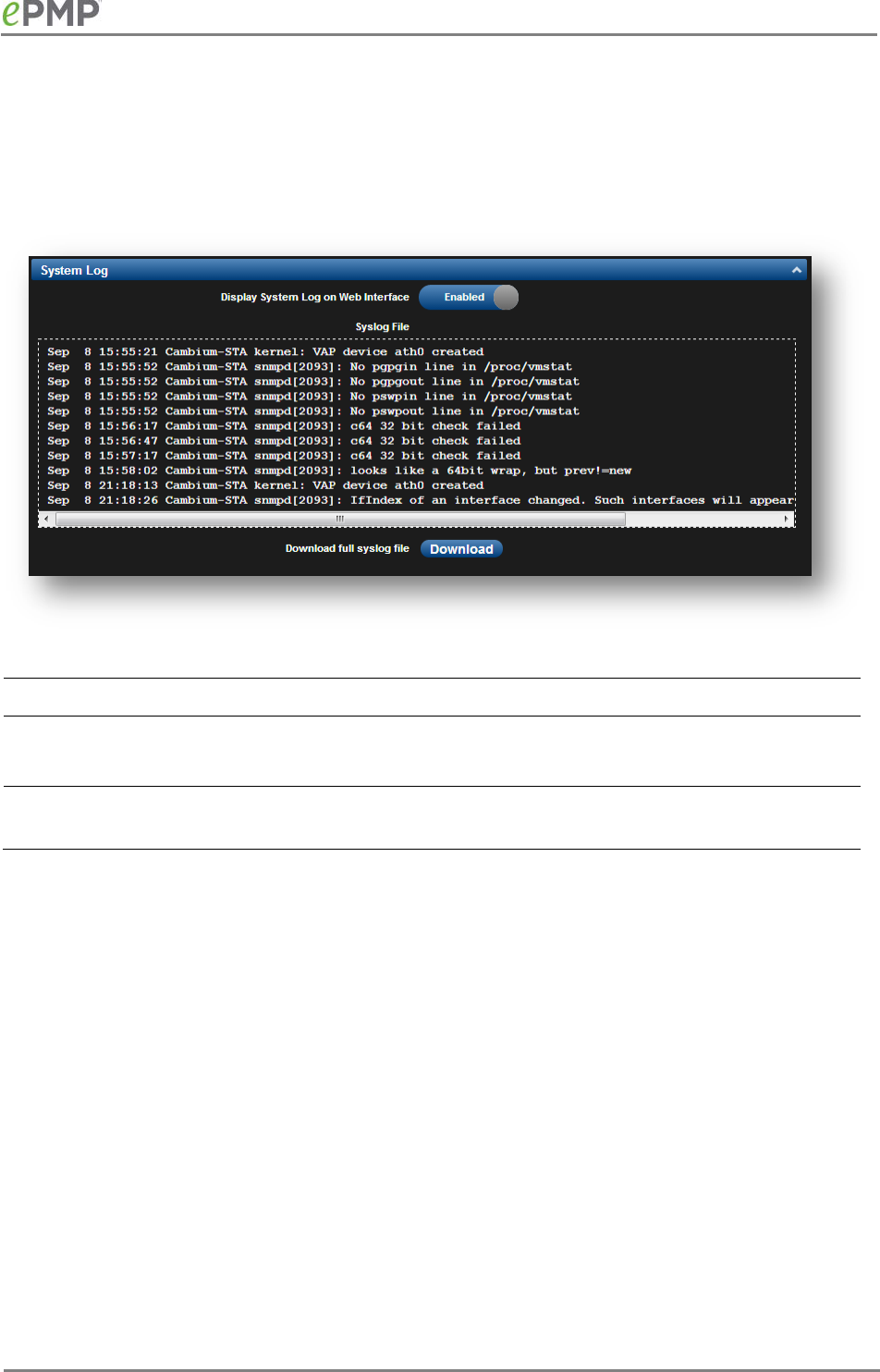
CAMBIUM NETWORKS
STA System Log page
Use the STA System Log page to view the device system log and to download the log file to the
accessing PC/devlce.
Figure 48
STA System Log page
Table 73
STA System Log attributes
Attribute
Meaning
Display System Log
on Web Interface
Enabled
: The system log file is displayed on the management GUI
Disabled
: The system log file is hidden on the management GUI
Download full
syslog file
Use this button to download the full system log file to a connected
PC/device
176

CAMBIUM NETWORKS
STA TOOLS MENU
The STA Tools menu provides several options for upgrading device software, configuration
backup/restore, analyzing RF spectrum, testing device throughput, and running ping and
traceroute tests.
•
STA Software Upgrade page
on page
178
•
STA Factory Default page
on page
180
•
STA Spectrum Analyzer page
on page
181
•
STA Throughput Test page
on page
184
•
STA Ping page
on page
185
•
STA Traceroute page
on page
186
177
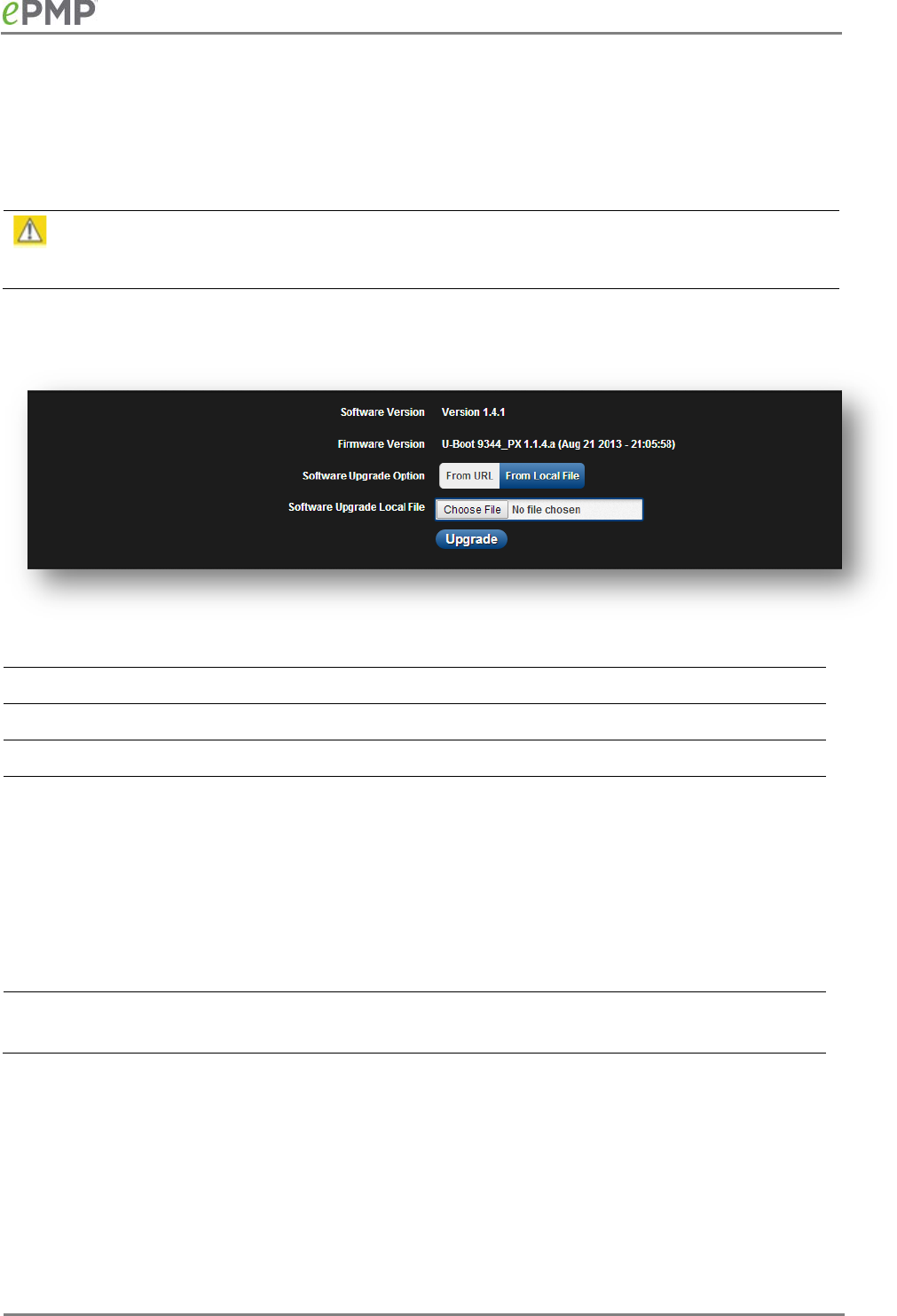
CAMBIUM NETWORKS
STA Software Upgrade page
Use the STA Software Upgrade page to update the device radio software to take advantage of new
software features and improvements.
Caution
Read the Release Notes associated with each software release.
Figure 49
STA Software Upgrade page
Table 74
STA Software Upgrade attributes
Attribute
Meaning
Software Version The current operating software version.
Firmware Version The current operating U-Boot version.
SW Upgrade Option
From URL
: A webserver may be used to retrieve software upgrade
packages (downloaded to the device via the webserver). For example, if
a webserver is running at IP address 192.168.2.1 and the software
upgrade packages are located in the home directory, an operator may
select option
From URL
and configure the
Software Upgrade Source Info
field to
http://192.168.2.1/<software_upgrade_package>
From Local File
: Click Browse to select the local file containing the
software upgrade package
Software Upgrade
Local File
Click
Browse
to select a local file (located on the device accessing the
web management interface) for upgrading the device software.
To upgrade the device software, follow this:
Procedure:
1
Download the software upgrade packages from
https://support.cambiumnetworks.com/files/epmp
178

CAMBIUM NETWORKS
2
Clear the cache of the accessing browser
3
On the device GUI, navigate to
Tools
=>
Software Upgrade
4
Select the
SW Upgrade Option
which represents the location of your software upgrade
packages
5
Based on the configuration of
SW Upgrade Option
, enter either the
Software Upgrade
Source Info
or click the
Browse
button and locate the software package
6
Click
Upgrade
7
When the upgrade is completed successfully, click the
Reset
icon
179
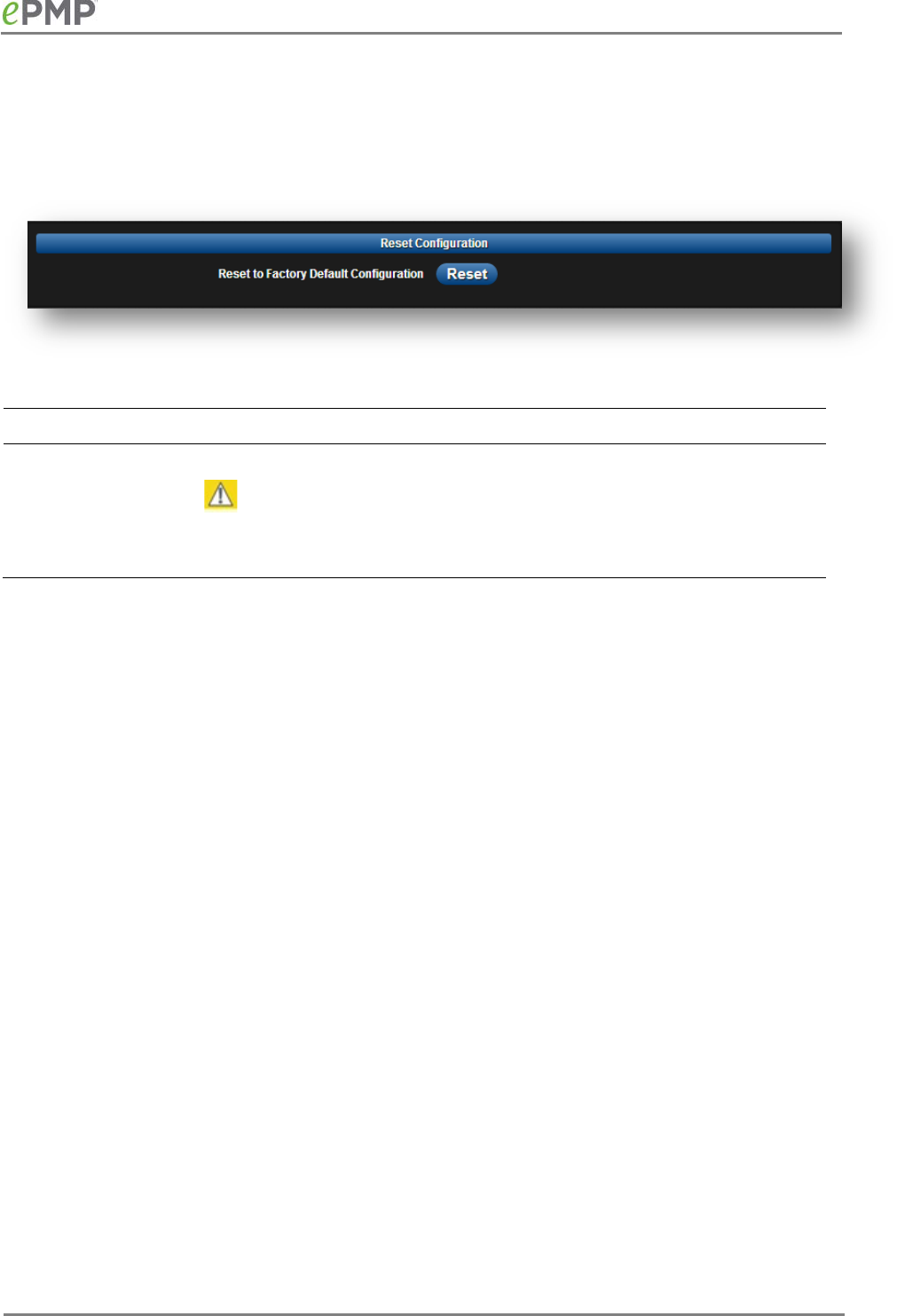
CAMBIUM NETWORKS
STA Factory Default page
Use the STA Backup/Restore page to reset the device to its factory default configuration.
Figure 50
STA Factory Default page
Table 75
STA Software Upgrade attributes
Attribute
Meaning
Reset to Factory
Default
Configuration
Use this button to reset the device to its factory default configuration
Caution
A reset to factory default configuration resets all device parameters. The
STA ceases to transmit and any registered STAs lose their session.
180

CAMBIUM NETWORKS
STA Spectrum Analyzer page
Use the STA Spectrum Analyzer page to configure STA spectrum analyzer parameters and to
download the spectrum analyzer tool.
To download the spectrum analyzer tool, the AP
Device Mode
must be set to
Spectrum Analyzer
.
Java Runtime Environment is required to run the AP spectrum analyzer.
Caution
Conducting spectrum analysis causes the STA to enter scan mode and the STA drops all RF
connections.
Vary the days and times when you analyze the spectrum in an area. The RF environment can
change throughout the day or throughout the week.
To conduct a spectrum analysis, follow these steps:
Required Software:
• Java Run-time Environment (JRE)
Procedure:
1
On the STA GUI, navigate to
Configure
=>
System
2
Configure
Device
mode to
Spectrum Analyzer
3
Click the
Save
button
4
Click the
Reset
button
5
Login to the STA GUI, then navigate to
Tools
=>
Spectrum Analyzer
6
Click
Download Spectrum Analyzer Tool
7
Locate the folder to which the spectrum analyzer tool was saved, and double-click on file
csa.jnlp
to launch the tool
8
If a security warning window is presented, tick the checkbox next to “I accept the risk and
want to run this application”
181
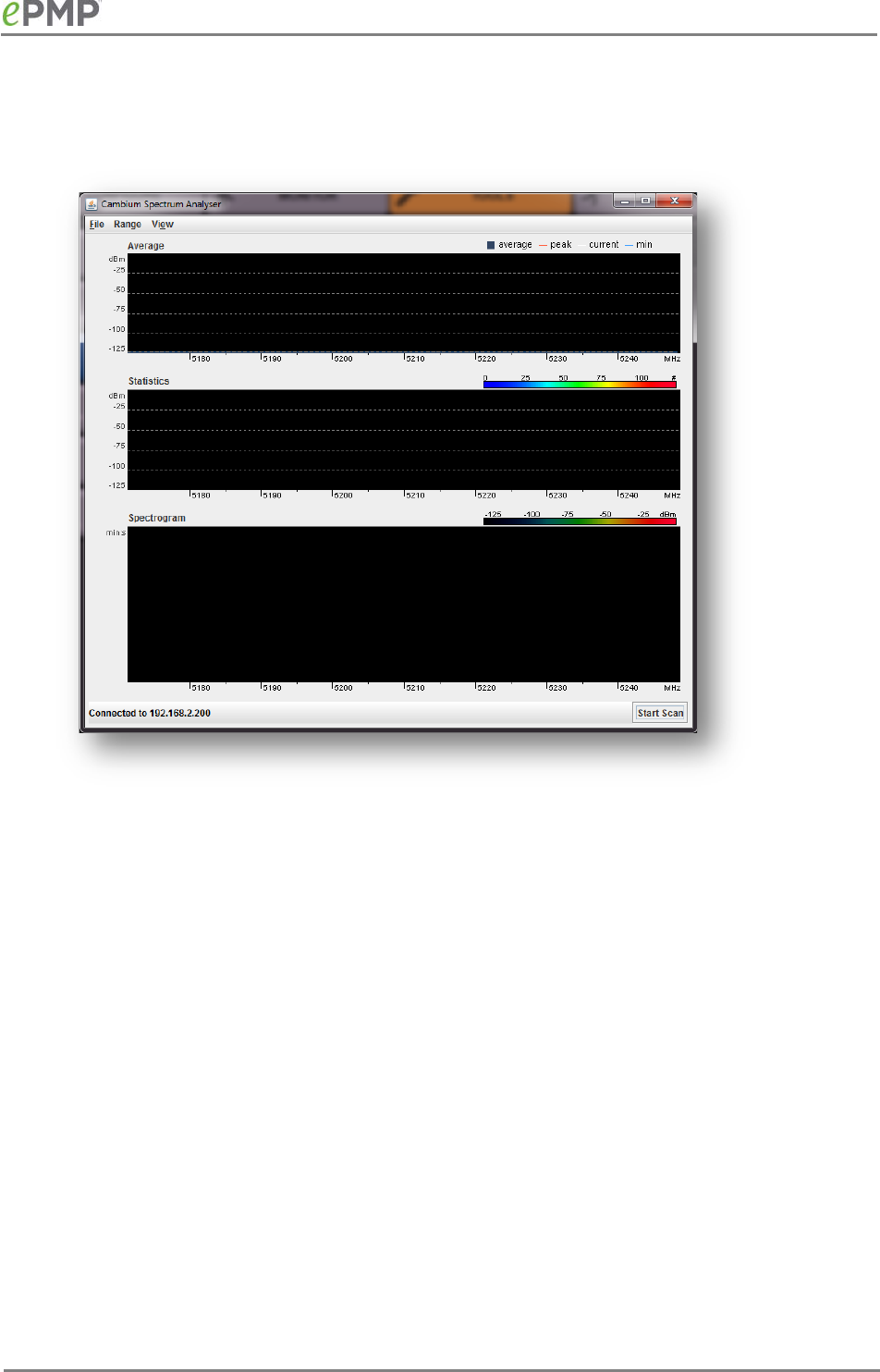
CAMBIUM NETWORKS
9
In the security warning window, click
Run
The spectrum analyzer interface is displayed
10
Click
Range
to configure the range of frequencies to scan.
182
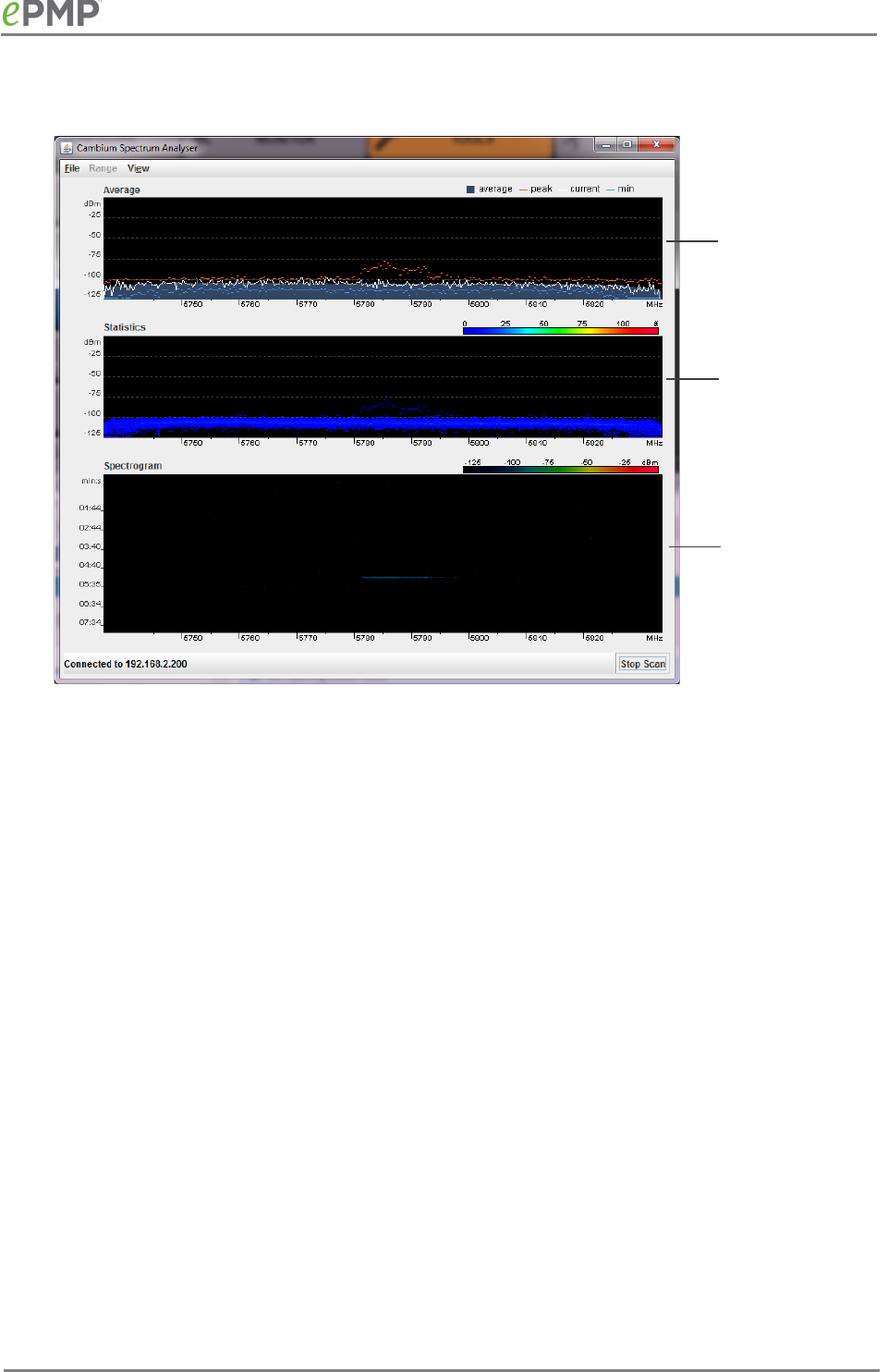
CAMBIUM NETWORKS
11
Click
Start Scan
to begin scanning
When scanning is complete, follow these steps to return the device to AP operation:
Procedure:
1
In the spectrum analyzer application, click
Stop Scan
2
Close the spectrum analyzer application by clicking
File
=>
Exit
3
On the STA GUI, navigate to
Configure
=>
System
4
Configure
Device Mode
to
STA
5
Click the
Save
button
6
Click the
Reset
button
Display of the
average, peak,
current, and
minimum
power levels for
the configured
range
Statistical
display of the
number of
times each
frequency in the
range was
scanned
Spectrogram
display of the
energy levels
detected
throughout the
configured
range, over
time
183
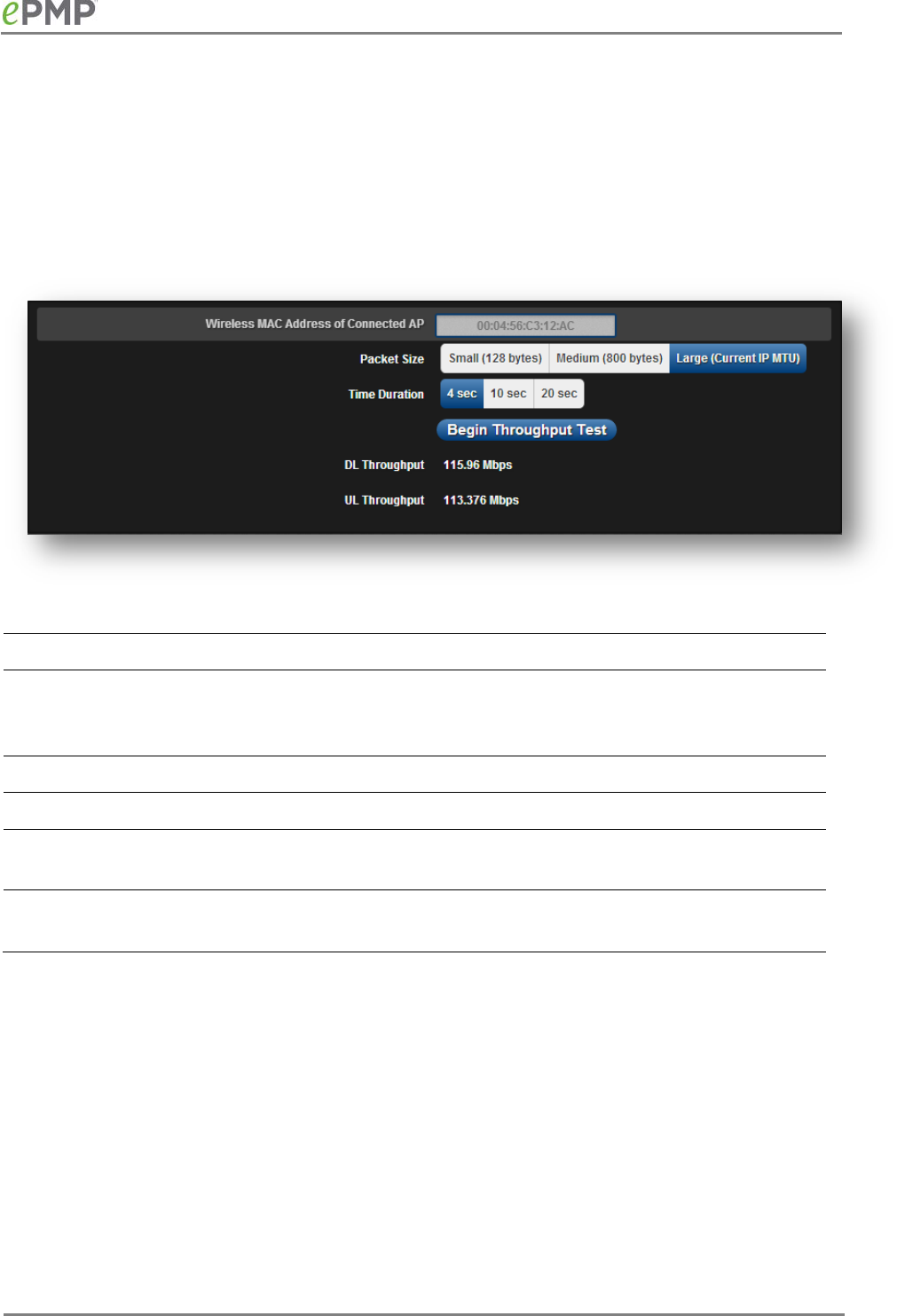
CAMBIUM NETWORKS
STA Throughput Test page
Use the STA Throughput Test page to conduct a simple test of STA wireless throughput to the AP
to which it is registered. This allows you to determine the throughput that can be expected on a
particular link without having to use external tools.
Figure 51
STA Throughput Test page
Table 76
STA Throughput Test attributes
Attribute
Meaning
Wireless MAC
Address of
Connected AP
This is not an editable field. It is automatically populated with the
wireless MAC address of the AP to which the STA is registered.
Packet Size Choose the Packet Size to use for the throughput test.
Time Duration Choose the Time Duration in seconds to use for the throughput test.
DL Throughput This field indicates the result of the throughput test on the downlink, in
Mbps.
UL Throughput This field indicates the result of the throughput test on the uplink, in
Mbps.
184
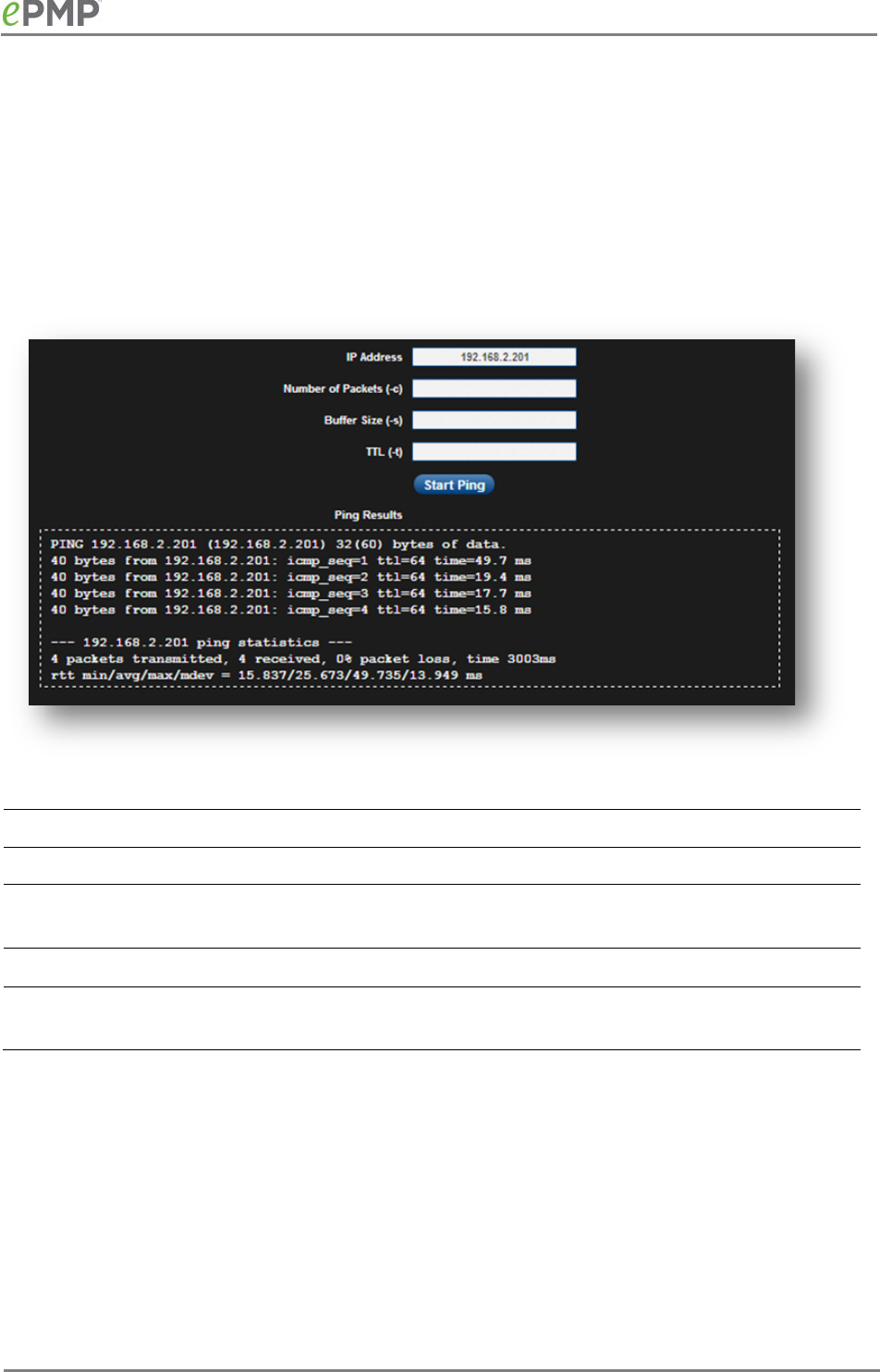
CAMBIUM NETWORKS
STA Ping page
Use the STA Ping page to conduct a simple test of STA IP connectivity to other devices which are
reachable from the network. If no ping response is received or if “Destination Host Unreachable” is
reported, the target may be down, there may be no route back to the STA, or there may be a
failure in the network hardware (i.e. DNS server failure).
Figure 52
STA Ping page
Table 77
STA Ping attributes
Attribute
Meaning
IP Address Enter the IP address of the ping target
Number of packets
(-c)
Enter the total number of ping requests to send to the target
Buffer size (-s) Enter the number of data bytes to be sent
TTL (-t) Set the IP Time-To-Live (TTL) for multicast packets. This flag applies if
the ping target is a multicast address
185
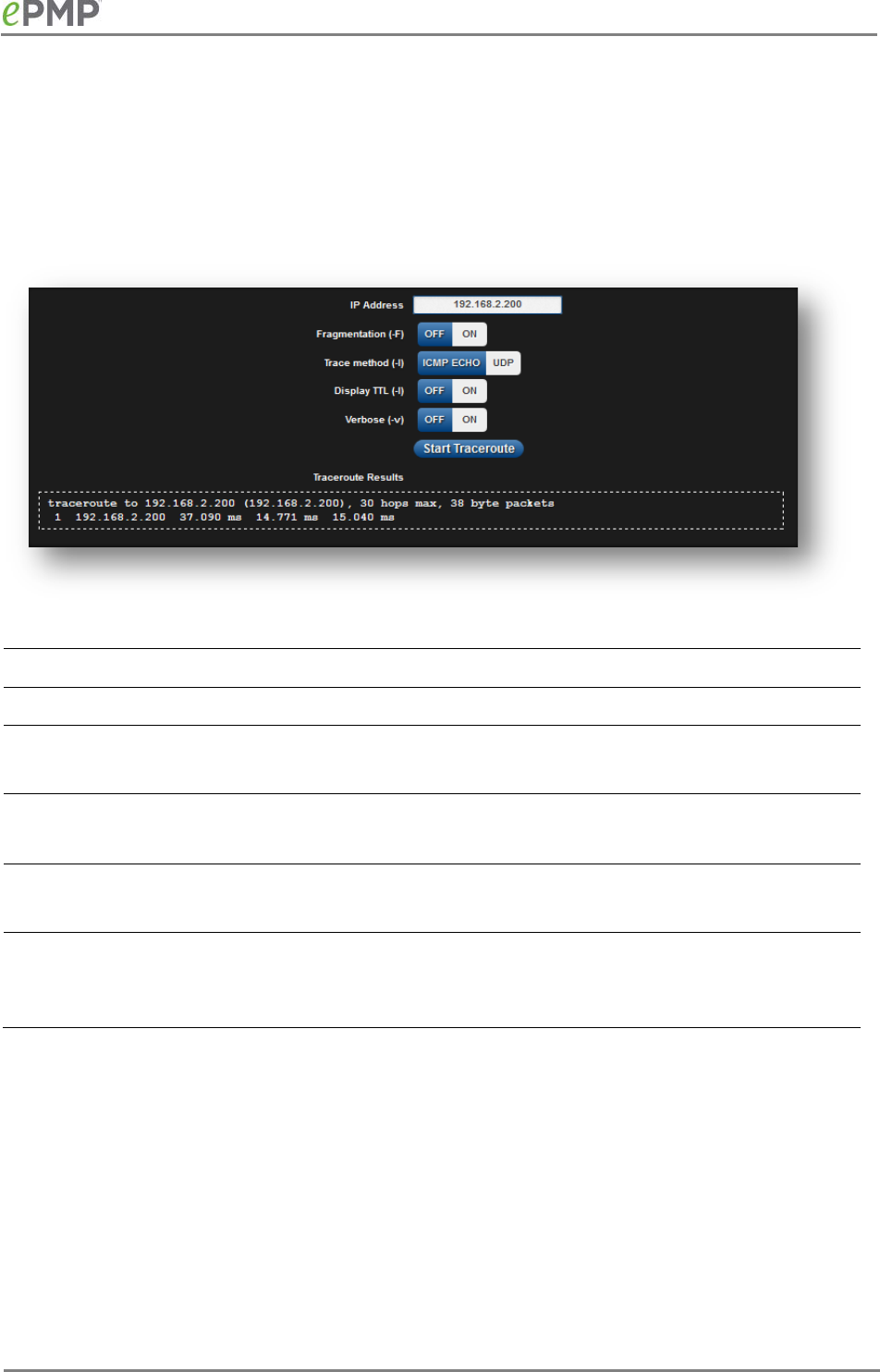
CAMBIUM NETWORKS
STA Traceroute page
Use the STA Traceroute page to display the route (path) and associated diagnostics for IP
connectivity between the STA and the destination specified.
Figure 53
STA Traceroute page
Table 78
STA Traceroute attributes
Attribute
Meaning
IP Address Enter the IP address of the target of the traceroute diagnostic
Fragmentation (-F)
ON
: Allow source and target to fragment probe packets
OFF
: Do not fragment probe packets (on source or target)
Trace method (-l)
ICMP ECHO
: Use ICMP ECHO for traceroute probes
UDP
: Use UDP for traceroute probes
Display TTL (-l)
ON
: Display TTL values for each hop on the route
OFF
: Suppress display of TTL values for each hop on the route
Verbose (-v)
ON
: ICMP packets other than TIME_EXCEEDED and UNREACHABLE are
displayed in the output
OFF
: Suppress display of extraneous ICMP messaging
186

CAMBIUM NETWORKS
Radius Server
INSTALLING FREE-RADIUS ON UBUNTU 12.04 LTS
To install the Radius server on Ubuntu 12.04 LTS, follow these instructions:
1. On the free-radius web page http://freeradius.org, download the latest package (currently
3.0.0), either from the main page or the download page.
2. Extract the archive file by using the command line as shown below:
• To extract a tar.bz2 file, use the command (note the j option)
tar -jxvf freeradius-server-x.x.x.tar.bz2
• To extract a tar.gz file, use the command (note the z option)
tar -zxvf freeradius-server-x.x.x.tar.gz
3. Once the files are extracted to a folder (cd freeradius-server-x.x.x), execute these
commands:
sudo apt-get install libssl-dev
sudo apt-get install libtalloc-dev
./configure
make
make install
CONFIGURING FREE-RADIUS SERVER
Note
IP address or subnet of the client must be configured in the clients.conf file.
Ex. – For the examples listed in the document, the subnet of the external machine is 172.22.121.0
or 192.168.0.0.
To configure Free-Radius server, follow these steps:
1. For testing from external machines, edit /usr/local/etc/raddb/clients.conf and add an entry.
For example:
client 172.22.121.0/24 {
ipaddr = 172.22.121.0
netmask = 24
secret = cambium
proto = *
shortname = epmp1
}
client 127.0.0.0/24 {
ipaddr = 172.22.121.0
netmask = 24
secret = cambium
proto = *
shortname = epmp1
}
client 192.168.0.0/16 {
ipaddr = 192.168.0.0
187
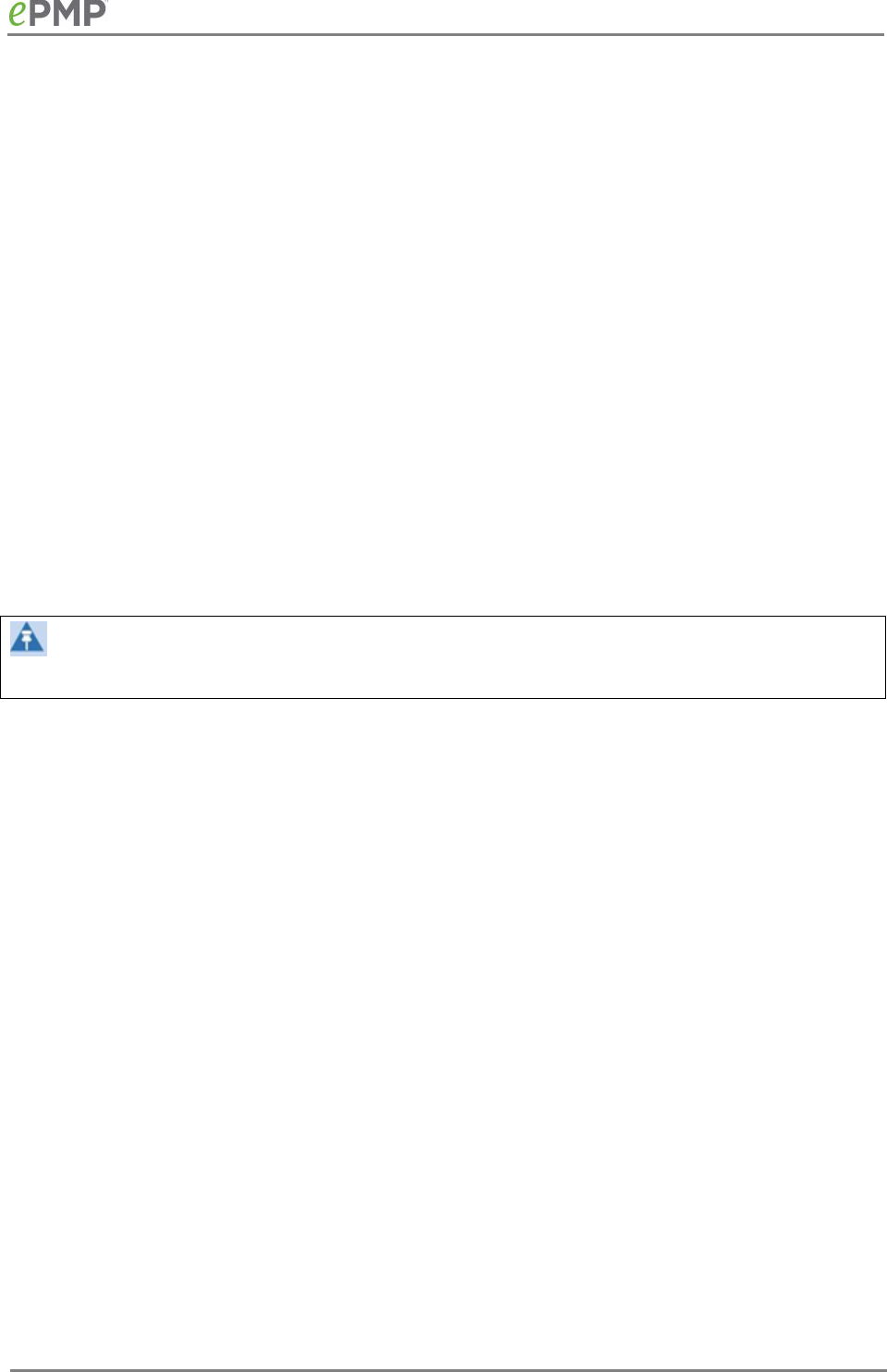
CAMBIUM NETWORKS
netmask = 16
secret = cambium
proto = *
}
2. To add EAP-TTLS Username and EAP-TTLS Password, edit usr/local/etc/raddb/user.
For example put this string at the end of file:
cambium-station Cleartext-Password := "cambium",
where cambium-station - EAP-TTLS Username and “cambium” - EAP-TTLS Password.
3. To configure free-radius key and certificate, edit /usr/local/etc/raddb/mods-available/eap
and add your certificates to folder /usr/local/etc/raddb/certs.
Locate a string such as default_eap_type, private_key_file, certificate_file
in eap file and change the value to:
default_eap_type = ttls
private_key_password = *** - according to your certificate
private_key_file = ${certdir}/***.key
certificate_file = ${certdir}/***.crt
Under the ttls section, change the following:
copy_request_to_tunnel=yes
use_tunnel_reply=yes
Note
Once these steps are performed, free-radius in debug mode can be initiated: $ radiusd –X.
188
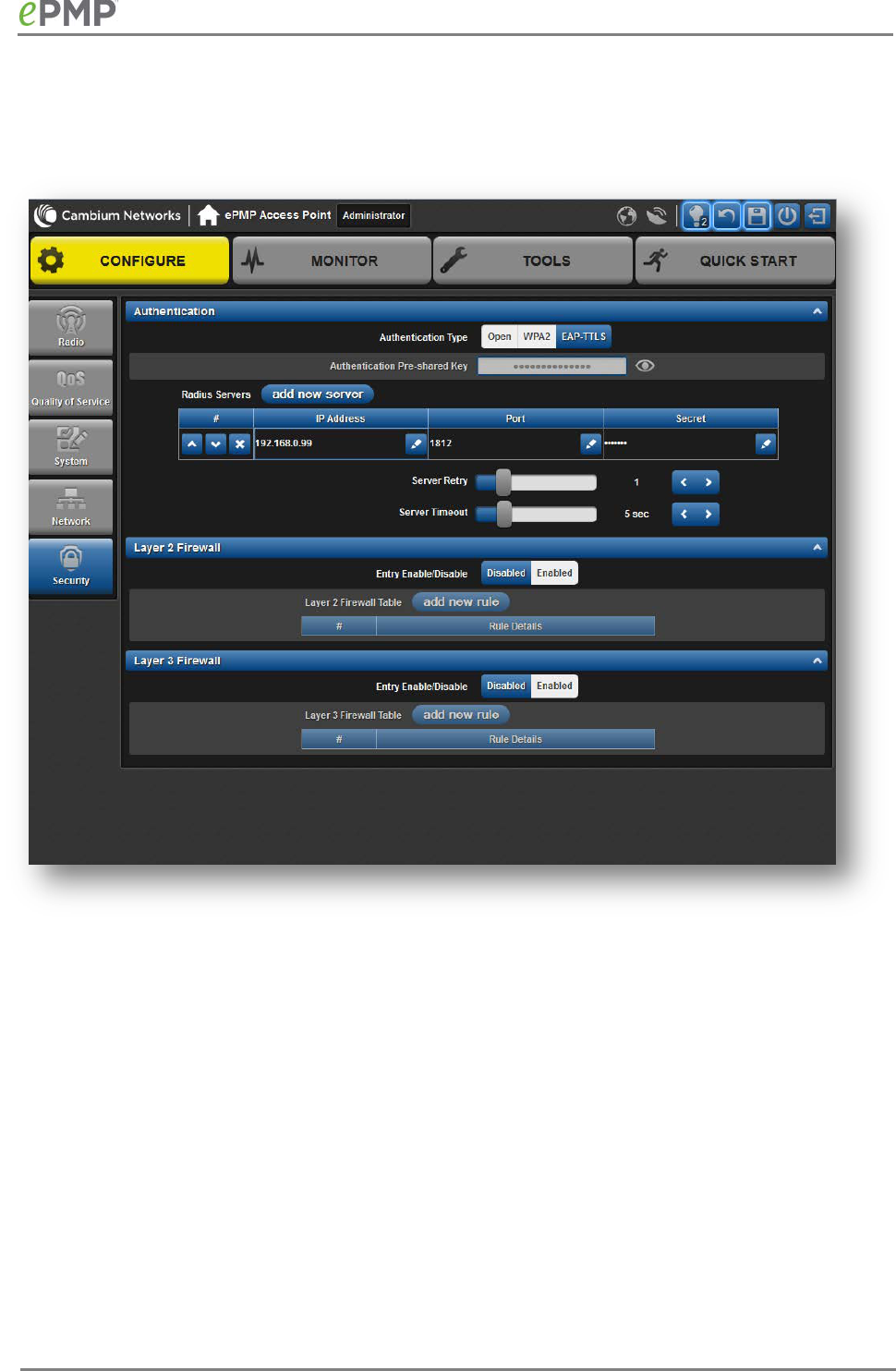
CAMBIUM NETWORKS
CONFIGURING RADIUS PARAMETERS ON AP
Figure 54
AP Radius configuration
To configure Radius parameters on AP, follow these steps:
1.
Open the GUI and login as admin.
2.
Navigate to
Configure
->
Security
->
Authentication.
3.
Change
Authentication Type
value to EAP-TTLS.
4.
Add IP Address of your RADIUS Server in the Radius Servers table.
5.
Also configure Port (you may use default 1812) and Secret which has to be the same as in
clients.conf
file.
6.
Click
Save
, to keep the changes.
189
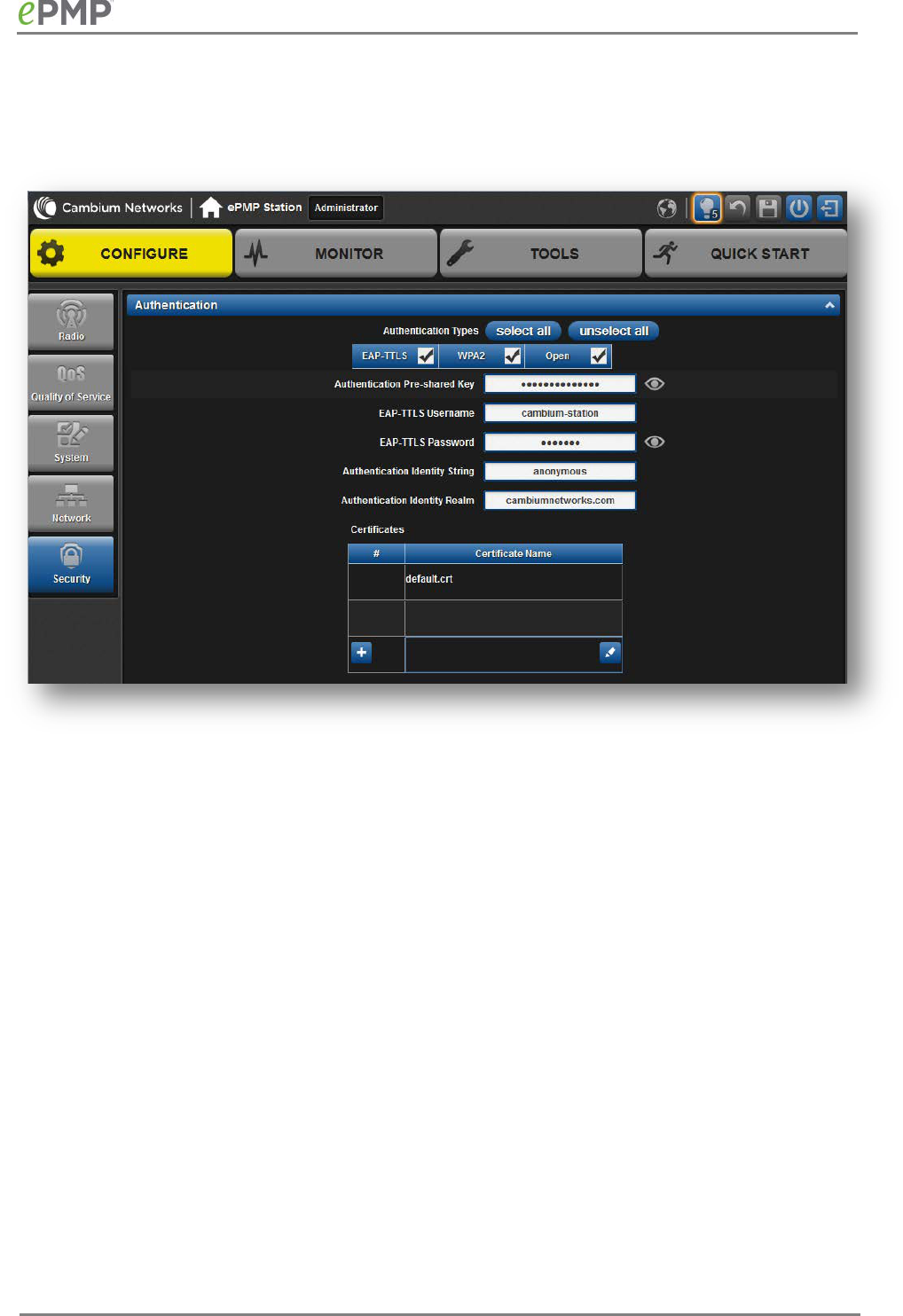
CAMBIUM NETWORKS
CONFIGURING RADIUS PARAMETERS ON STA
Figure 55
STA Radius configuration
To configure Radius parameters on STA, follow these steps:
1.
Select
EAP-TTLS
Authentication Type.
2.
Configure EAP-TTLS Username and EAP-TTLS Password, as configured in file
users
.
3.
Add Certificates to the
Certificates
table.
4.
Click
Save
, to keep the changes.
190

CAMBIUM NETWORKS
CONFIGURING MIR PROFILES
To configure the MIR profiles, follow these steps:
• Create a dictionary file with the MIR Profiles:
# touch dictionary.cambium
• Edit dictionary.cambium according to the instructions that you can find under
/usr/local/etc/raddb directory in file
dictionary
.
For example:
ATTRIBUTE Cambium-Canopy-ULMB 110 integer #Max Burst Uplink Rate
ATTRIBUTE Cambium-Canopy-DLMB 110 integer #Max Burst Downlink Rate
VENDOR Cambium 17713
#
# Cambium vendor-specific attributes.
#
BEGIN-VENDOR Cambium
ATTRIBUTE Cambium-Canopy-VLIGVID 21 integer #VLAN Ingress VLAN ID
ATTRIBUTE Cambium-Canopy-VLMGVID 22 integer #VLAN Management VLAN ID
ATTRIBUTE Cambium-Canopy-ULMB 26 integer #Max Burst Uplink Rate
ATTRIBUTE Cambium-Canopy-DLMB 27 integer #Max Burst Downlink Rate
• Create link on your dictionary:
#ln -s dictionary.cambium dictionary.local
• To configure MIR profiles, edit usr/local/etc/raddb/users and add profiles for each client
below users configuration :
station33 Cleartext-Password := "cambium33"
Cambium-Canopy-ULMB = 100,
Cambium-Canopy-DLMB = 100
station34 Cleartext-Password := "cambium34"
Cambium-Canopy-ULMB = 110,
Cambium-Canopy-DLMB = 110
station35 Cleartext-Password := "cambium35"
Cambium-Canopy-ULMB = 120,
Cambium-Canopy-DLMB = 120
191

CAMBIUM NETWORKS
A few example scenarios of MIR and RADIUS configurations are described in
Table 79
.
Table 79
Example scenarios of MIR and RADIUS configurations
Scenario
Description
No MIR control via
Radius
In a scenario where Radius is not in use for MIR profiles, the GUI will be
the only place to configure MIR profiles and apply them to the
corresponding STAs. Configure the MIR profiles in the
Configure
=->
Quality of Service
menu option on the AP GUI and apply the
corresponding profile # in the STA under the same menu option on STA.
MIR control using
only Radius
In the case where only the Radius server is being used for MIR profiles,
all settings in the GUI will be overridden for any STA being managed by
the Radius Server. In this case, create the MIR profile with Station
usernames and password on the Radius server. At the time of
registration, the AP will use the radius information and apply the
corresponding profile to the STA. In the wireless statistics page (
=>
Wireless Status
), the MIR profile # from the Radius server along with UL
and DL rate information will show up. In this scenario the QOS profiles
in the AP GUI are irrelevant. Multiple STAs across multiple APs can then
be managed via Radius.
Hybrid control using
both Radius and
MIR profile on the
AP GUI
The system will also support a hybrid mode where Radius and the GUI
QOS profiles can be used simultaneously as long as the same STA does
not have a profile # associated from the AP & Radius. In case where it is
redundant, Radius server setting will override the MIR profile settings
from the GUI.
CREATING CERTIFICATE FOR RADIUS SERVER AND STA DEVICE
Create your own certification center
Creating a CA private key
1. Create a root (self-signed) certificate from our private certificate. Go to the directory
where the database is stored for our certificates and start generating.
2. Create a private key CA (my own Certificate Authority). RSA key length of 2048 bits
encryption algorithm 3DES. File name with a key - cambium-ca.key
openssl genrsa-des3-out cambium-ca.key 2048
Generating RSA private key, 2048 bit long modulus
...................... + + +
........... + + +
e is 65537 (0x10001)
Enter pass phrase for cambium.key:
Verifying - Enter pass phrase for cambium-ca.key:
3. While creating the private key, you must enter a passphrase, which will be closed by
key (and confirm it). Content key, can viewed from the following command:
openssl rsa-noout-text-in cambium-ca.key
In this case you must enter the private key again.
Creating a CA certificate
Generate a self-signed certificate CA:
192

CAMBIUM NETWORKS
openssl req-new-x509-days 3650 -key cambium-ca.key-out cambium-ca.crt
Enter pass phrase for cambium.key:
You are asked to enter information that will be incorporated into your certificate request.
What you enter is called a Distinguished Name or a DN. There are quite a few fields of which you
can leave some blank. For some fields there is a default value,
If you enter '.', field is left blank.
-----
Country Name (2 letter country code)
State or Province Name (full name)
Locality Name (Ex. City)
Organization Name (Ex, Cambium Networks)
Organizational Unit Name (Ex. Cambium)
Common Name (Ex. cambium root CA)
Email Address (Ex. admin@cambium.com)
Generating the certificate, you must enter a passphrase, with a closed key CA, and then - to fill in
the required fields (company name, email, etc.); the most important of these is the Common Name
- the unique name of the certification center.
In this case, as the Common name was chosen "cambium root CA", view the resulting certificate
command as shown below:
openssl x509-noout-text-in cambium-ca.crt
As a result, we see:
Certificate:
Data:
Version: 3 (0x2)
Serial Number:
ea: 30:7 b: 69 : a2: 13:0 c: 70
Signature Algorithm: md5WithRSAEncryption
Issuer: C = UA, ST = Euro, L = Kiev, O = Cambium Networks, OU = Cambium,
CN = cambium root CA / email address = admin@cambium.com
# Issued to (by us, that is self-signed)
Validity
Not Before: Dec 9, 2005 11:34:29 GMT
Not After: Dec 7, 2015 11:34:29 GMT
# Validity of the certificate
Subject: C = UA, ST = Euro, L = Kiev, O = Cambium Networks, OU = Cambium,
CN = cambium root CA / email address = admin@cambium.com
# Filter (field) certificate
Subject Public Key Info:
Public Key Algorithm: rsaEncryption
RSA Public Key: (2048 bit)
Modulus (2048 bit):
00: c0: ff: 50 : fd: a8: eb: 07:9 b: 17 : d1: a9: e2: a5: dc:
59: a7: 97:28:9 f: bc: a4: 01:16:45:37: f5: 8d: ca: 1e:
12: ca: 25:02:8 a: cf: ee: ae: 35:59: ed: 57:89: c7: 2b:
17:9 f: 8b: de: 60 : db: e5: eb: b3: de: 09:30:3 b: a9: 68:
40: f7: f8: 84 : f4: 6c: b2: 24:3 d: ed: 45 : a3: 8a: 66:99:
40: a9: 53:0 c: 75 : e3: df: f3: ef: 20:0 c: a6: 3f: f2: dd:
e9: 1c: f5: d1: c1: 32:4 c: 44 : fd: c1: a2: d9: e6: e0: dc:
04:0 c: f8: dd: 9e: 31 : aa: 9d: 60 : b0: 84 : d2: e0: b7: a5:
193

CAMBIUM NETWORKS
eb: 82:31:4 f: 71 : c4: ee: ab: 5c: 8e: ef: 8c: a1: 1a: 2a:
62: e9: e9: 36 : ff: 12 : b9: c9: ac: 0e: 4d: ac: 08:97:87:
d2: 30:2 f: 41 : a1: 9e: ef: 8b: bf: c6: cf: 66:70:02: ab:
2d: b0: 9c: 56 : b8: 13 : e8: 92:59: f5: d9: 33 : d7: 33:6 a:
7c: cb: 9b: 92 : ee: 4b: 22:32:73:59:70:3 f: b1: f6: 1b:
67:1 d: 28 : eb: bb: 4b: 5e: 61:95:43:78: d5: 3b: db: e1:
37 : f1: ec: 0d: db: 50:65:22: cb: f4: f9: b8: 2a: c6: 1f:
2b: e9: f8: 64:03:4 f: 36 : dc: 72:8 e: be: 3d: 12:8 a: ca:
8b: 95
Exponent: 65537 (0x10001)
X509v3 extensions:
X509v3 Subject Key Identifier:
4C: 80 : F5: 82:4 C: A4: 52 : DF: 9E: 0C: 0D: 64:74:68:1 E: 45 : F6: C1: C7: 68
X509v3 Authority Key Identifier:
keyid: 4C: 80 : F5: 82:4 C: A4: 52 : DF: 9E: 0C: 0D: 64:74:68:1 E: 45 : F6: C1: C7: 68
DirName :/ C = UA / ST = Euro / L = Kiev / O = Cambium Networks / OU = Cambium /
CN = cambium root CA / emailAddress = admin@cambium.com
serial: EA: 30:7 B: 69 : A2: 13:0 C: 70
X509v3 Basic Constraints:
CA: TUAE
Signature Algorithm: md5WithRSAEncryption
57 : db: 0d: 2b: 27 : eb: 0a: 97:7 f: b1: 37 : b3: d1: d7: 14 : a6: 80:66:
3d: 7c: 00:4 a: 45:1 f: 7c: 2b: 5e: 30 : b2: 72:74:9 f: 6d: 33:82: f7:
f7: de: 54 : a9: 2b: e7: ea: 1b: 93 : bd: cc: 74:4 f: 11 : ed: 94:0 b: b9:
b2: 1f: b1: 86:6 e: c6: 48:71:48:9 b: 2b: 0a: 36 : f3: ab: d6: f9: 75 :
c9: 0d: 1b: e9: 2c: 85:04: fc: 17:9 a: 94 : b9: 14:0 d: 15 : d1: 1e: 8b:
bb: 9e: 91 : ca: 40:8 c: d8: ef: dd: 4a: 75 : d0: b9: 62 : d4: ee: 1b: e5:
b5: 7e: fa: f1: 5d: 62 : d1: 78 : b0: 34:04: bb: 60:37:8 a: a8: 74:88:
f6: 94:3 b: c8: fb: c0: 98 : f4: 94 : e9: d5: 53:8 e: 31 : e6: 25:56: c3:
84:7 c: 46 : b9: 09:5 f: e3: 43 : a8: 57 : c9: 3a: d9: 3d: a7: b0: 41 : db:
ea: ca: 60:28:0 b: a3: f0: 0b: e6: d6: c0: 5b: 15:0 c: f8: 19:36:26:
d3: 2a: 8d: c9: 67 : fe: 04:6 f: e9: bf: f9: 55 : de: 2c: 92:04:81:6 f:
43 : d5: 94:25: af: 83 : b8: 01:22: c8: 1a: 7e: 2e: a9: 10 : b0: e5: 35 :
a7: 17 : bf: 65 : a1: 31:55:85: ba: 10:24:71:03:3 b: d6: 71 : a4: ad:
48:28:46:8 f: 7e: e6: b3: 8c: 37:97:4 f: 36:05:8 c: f6: d1: 40 : a8:
c4: 58:9 b: 28
Now copy the certificate and key of the CA in a public place, for example, in /etc/ssl/cambium:
mkdir /etc /ssl /cambium
cp cambium-ca. * /etc/ssl/cambium/
Issuance of certificates
Script certificate generation
Download (from the Cambium support web-site) the script
sign_cert.sh
. It allows you to create
server/user.
Edit the following lines in it:
ROOTCA = "cambium"
root CA name - Filename of the root certificate (without the suffix '-ca')
O = "Cambium Networks" - Name of the organization
C = "UA" - country
194

CAMBIUM NETWORKS
ST = "Euro" - staff
L = "Kiev" - city
OU = "Cambium" - unit
EMAIL = email@cambium.com - email
BITS = 2048 - Size of the generated key in bits
CLIENT_DAYS = 730 - Client certificate validity period in days
SERVER_DAYS = 1461 - Server certificate validity period in days
Lines related to the country, city, department, email, etc must be fixed (though not necessarily, this
is default values that can be changed in the process of creating the certificate). Variables related to
the terms of validity of the certificate can be left without changes.
Creating a server certificate (for RADIUS)
Create a server certificate (option cerver_cert), file name (and certificate) radius.cambium.com.
. / sign_cert.sh server_cert radius.cambium.com
create certificate key: radius.cambium.com.key
Generating RSA private key, 2048 bit long modulus
....... + + +
.................................. + + +
e is 65537 (0x10001)
# First generates key, it is necessary enter the password which will close the key
Enter pass phrase for radius.cambium.com.key:
Verifying - Enter pass phrase for radius.cambium.com.key:
decrypt certificate key: radius.cambium.com.crt
Enter pass phrase for radius.cambium.com.key:
writing RSA key
# Create a certificate request
Create certificate request: radius.cambium.com.csr
. / sign_cert.sh radius.cambium.com server_cert
You are about to be asked to enter information that will be incorporated
into your certificate request.
What you are about to enter is what is called a Distinguished Name or a DN.
There are quite a few fields but you can leave some blank
For some fields there will be a default value,
If you enter '.', the field will be left blank.
Then you must specify the fields you want, like for the root certificate. Default values have already
crammed in square brackets. To use them simply click ENTER.
1. Your Country Name (2 letter country code):
2. State or Province Name (full name):
3. Locality Name (Ex.- city)
4. Organization Name (Ex.- Cambium Networks):
5. Organizational Unit Name (Ex.- Cambium):
6. Common Name (Ex.- radius.cambium.com):
7. Email Address (Ex.- email@cambium.com):
# Sign the certificate request
sign certificate by CA: radius.cambium.com.crt
195

CAMBIUM NETWORKS
sign ca is: cambium-ca
CA signing: radius.cambium.com.csr -> radius.cambium.com.crt:
Using configuration from ca.config
Since we sign new created certificate with root certificate, we must enter the password which we
used to close root certificate of our center CA
Enter pass phrase for. /.. / cambium-ca.key:
Check that the request matches the signature
Signature ok
The Subject's Distinguished Name is as follows
countryName: PRINTABLE: 'UA'
stateOrProvinceName: PRINTABLE: 'Euro'
localityName: PRINTABLE: 'Kiev'
organizationName: PRINTABLE: 'Cambium Networks'
organizationalUnitName: PRINTABLE: 'Cambium'
commonName: T61STRING: 'radius.cambium.com'
emailAddress: IA5STRING: 'email@cambium.com'
Certificate is to be certified until Dec 25 12:05:18 2013 GMT (730 days)
Everything is OK, completing work
Server certificate is created.
196

CAMBIUM NETWORKS
Operation and Troubleshooting
This chapter provides instructions for operators of ePMP networks. The following topics are
described in this chapter:
•
General Planning for Troubleshooting
on page
198
•
Upgrading device software
on page
200
•
Testing hardware
on page
201
•
Troubleshooting the radio link
on page
204
•
Using the device external reset button
on page
206
•
Resetting the AP or STA to factory defaults by power cycling
on page
207
197

CAMBIUM NETWORKS
General Planning for Troubleshooting
Effective troubleshooting depends in part on measures that you take before you experience
trouble in your network. Cambium recommends the following measures for each site:
Procedure:
1
Identify troubleshooting tools that are available at your site (such as a protocol analyzer).
2
Identify commands and other sources that can capture baseline data for the site. These may
include:
• Ping
• tracert or traceroute
• Throughput Test results
• Throughput data
• Configure GUI page captures
• Monitor GUI page captures
• Session logs
3
Start a log for the site, including:
• Operating procedures
• Site-specific configuration records
• Network topology
• Software releases
• Types of hardware deployed
• Site-specific troubleshooting process
• Escalation procedures
• GPS latitude/longitude of each network element
GENERAL FAULT ISOLATION PROCESS
Effective troubleshooting also requires an effective fault isolation methodology that includes
• attempting to isolate the problem to the level of a system, subsystem, or link, such as
o AP to STA
o AP to CMM
o AP to GPS
o CMM to GPS
o power
• researching System Logs of the involved equipment.
• answering the questions listed in the following section.
• reversing the last previous corrective attempt before proceeding to the next.
• performing only one corrective attempt at a time.
198

CAMBIUM NETWORKS
QUESTIONS TO HELP ISOLATE THE PROBLEM
When a problem occurs, attempt to answer the following questions:
1
What is the history of the problem?
• Have we changed something recently?
• Have we seen other symptoms before this?
2
How wide-spread is the symptom?
• Is the problem on only a single STA? (If so, focus on that STA.)
• Is the problem on multiple STAs? If so
o is the problem on one AP in the cluster? (If so, focus on that AP)
o is the problem on multiple, but not all, APs in the cluster? (If so, focus on those
APs)
o is the problem on all APs in the cluster? (If so, focus on the CMM and the GPS
signal.)
3
Based on data in the System Log
• is intermittent connectivity indicated? (If so, verify your configuration, power level, CINR,
cables and connections, and the speed duplex of both ends of the link).
• does the problem correlate to loss-of-sync events?
4
Are connections made via shielded cables?
5
Does the GPS antenna have an unobstructed view of the entire horizon?
199
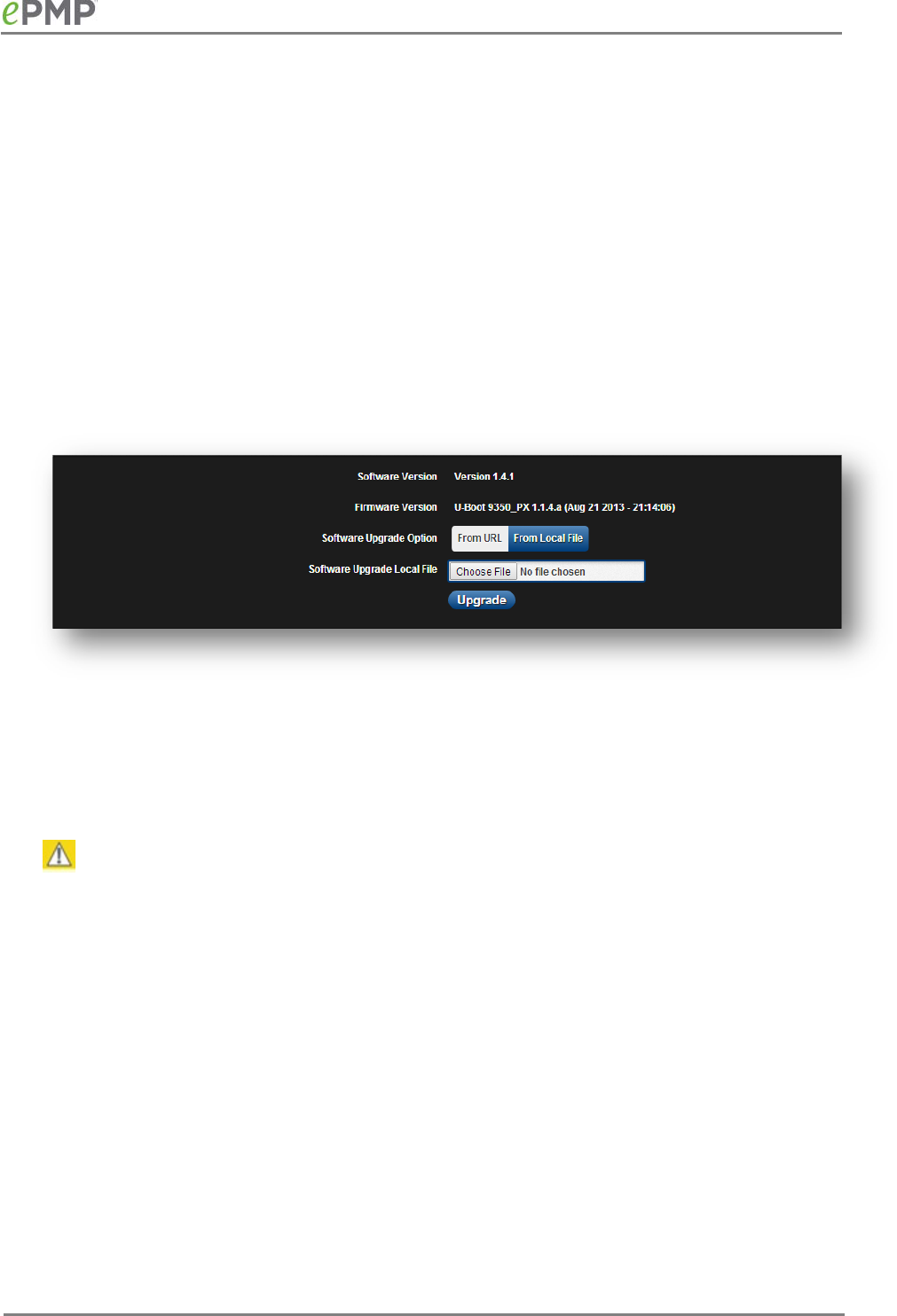
CAMBIUM NETWORKS
Upgrading device software
To take advantage of new features and software improvements for the ePMP system, monitor the
Cambium Networks PMP Software website:
https://support.cambiumnetworks.com/files/epmp
To upgrade the device software (AP or STA), follow this:
Procedure:
1
When upgrading multiple v1.0.3 integrated devices, ensure that the browser cache is cleared at the
beginning of the upgrade process.
2
Log in to the device GUI via the management IP
3
Navigate to page
Tools
,
Software Upgrade
4
Set
SW Upgrade Option
to
From URL
to pull the software file from a network software server, or
select
From Local File
to upload a file from the accessing device.
5
If
From URL
is selected, enter the server IP address, server port, and file path. If
From Local File
is
selected, click
Browse
to launch the file selection dialogue
6
Click
Upgrade
Caution
Do not power off the unit in the middle of an upgrade process.
7
Once the software upgrade is complete, click the
Reset
icon.
200

CAMBIUM NETWORKS
Testing hardware
This section describes how to test the hardware when it fails on startup or during operation.
Before testing hardware, confirm that all outdoor cables, that is those that connect the AP or STA
to equipment inside the building, are of the supported type, as defined in
Ethernet cabling
on page
57
CHECKING THE POWER SUPPLY LED
When the power supply is connected to the main power supply, the expected LED behavior is:
• The Power (green) LED illuminates steadily.
If the expected LED operation does not occur, or if a fault is suspected in the hardware, check the
LED states and choose the correct test procedure:
•
Power LED is off
on page
201
•
Ethernet LED is off
on page
201
POWER LED IS OFF
Meaning
: Either the power supply is not receiving power from the AC/DC outlet, or there is a
wiring fault in the unit.
Action
: Remove the AP/STA cable from the PSU and observe the effect on the Power LED. If the
Power LED does not illuminate, confirm that the mains power supply is working, for example,
check the plug. If the power supply is working, report a suspected power supply fault to Cambium
Networks.
ETHERNET LED IS OFF
Meaning
: There is no Ethernet traffic between the AP/STA and power supply.
Action
: The fault may be in the LAN or AP/STA cable:
• Remove the LAN cable from the power supply, examine it and confirm it is not faulty.
• If the PC connection is working, remove the AP/STA cable from the power supply, examine it,
and check that the wiring to pins 1&2 and 3&6 is correct and not crossed.
201
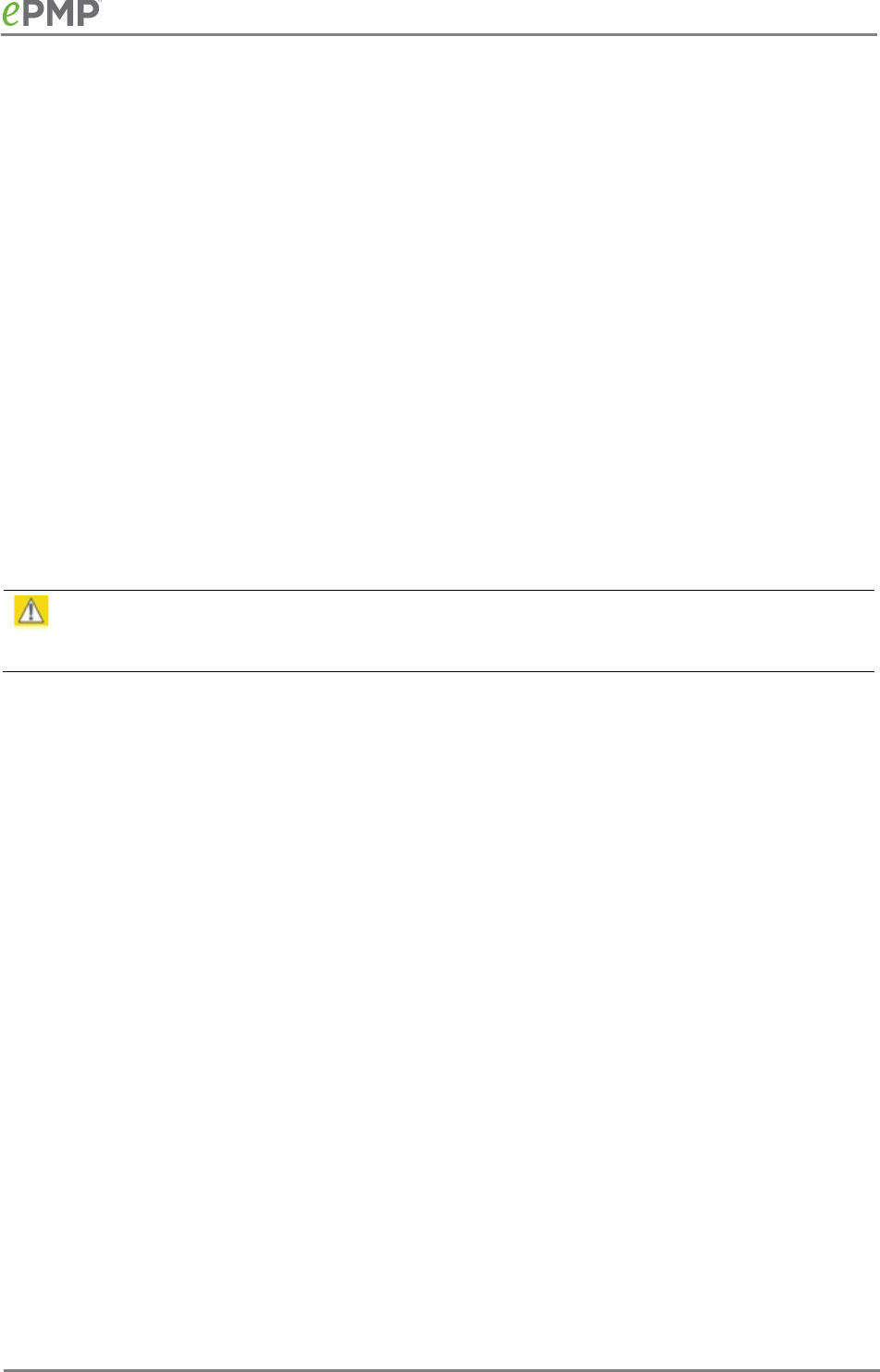
CAMBIUM NETWORKS
Test Ethernet packet errors reported by AP/STA
Log into the AP or STA and click
Monitor
,
Performance
. Click
Reset System Counters
at the bottom
of the page and wait until
LAN RX – Total Packet Counter
has reached 1 million. If the counter
does not increment or increments too slowly, because for example the ePMP system is newly
installed and there is no offered Ethernet traffic, then abandon this procedure and consider using
the procedure
Test ping packet loss
on page
202
.
Check the
LAN RX – Error Packet Counter
statistic. The test has passed if this is less than 10.
Test Ethernet packet errors reported by managed switch or router
If the AP/STA is connected to a managed Ethernet switch or router, it may be possible to monitor
the error rate of Ethernet packets. Please refer to the user guide of the managed network
equipment. The test has passed if the rate of packet errors reported by the managed Ethernet
switch or router is less than 10 in 1 million packets.
Test ping packet loss
Using a computer, it is possible to generate and monitor packets lost between the power supply
and the AP/STA. This can be achieved by executing the Command Prompt application
which is supplied as standard with Windows and Mac operating systems.
Caution
This procedure disrupts network traffic carried by the AP or STA under test:
Procedure:
1
Ensure that the IP address of the computer is configured appropriately for connection to
the AP or STA under test, and does not conflict with other devices connected to the network.
2
If the power supply is connected to an Ethernet switch or router then connect the computer to
a spare port, if available.
3
If it is not possible to connect the computer to a spare port of an Ethernet switch or router,
then the power supply will need to be disconnected from the network in order to execute this
test:
• Disconnect the power supply from the network.
• Connect the computer directly to the LAN port of the power supply.
4
On the computer, open the Command Prompt application.
5
Send 1000 ping packets of length 1500 bytes. The process will take 1000 seconds, which is
approximately 17 minutes.
If the computer is running a Windows operating system, this is achieved by typing (for an IPv6
address, use the ping6 command):
ping –n 1000 –l 1500 <ipaddress>
where <ipaddress> is the IP address of the AP or STA under test.
If the computer is running a MAC operating system, this is achieved by typing:
ping –c 1000 –s 1492 <ipaddress>
202

CAMBIUM NETWORKS
where <ipaddress> is the IP address of the AP/STA under test.
6
Record how many Ping packets have been lost. This is reported by Command Prompt on
completion of the test.
The test has passed if the number of lost packets is less than 2.
203

CAMBIUM NETWORKS
Troubleshooting the radio link
This section describes how to test the link when there is no radio communication, when it is
unreliable, or when the data throughput rate is too low. It may be necessary to test both the AP
and the STA.
MODULE HAS LOST OR DOES NOT ESTABLISH RADIO CONNECTIVITY
If there is no wireless activity, follow this:
Procedure:
1
Check that the AP and STAs are configured with the same
Frequency Carrier
. Also, if
operating in a region where DFS is required, ensure that the STA’s
Frequency Carrier List
contains the frequencies configured in the AP’s
DFS Alternate Frequency Carrier 1
and
DFS
Alternate Frequency Carrier 2
fields.
2
Check that the
Channel Bandwidth
is configured the same at the AP and at the STA
3
On the AP, verify that the
Max Range
setting is configured to a distance slightly greater than
the distance between the AP and the furthest STA that must register to the AP.
4
Check that the AP’s
Synchronization Source
is configured properly based on the network
configuration.
5
Verify the authentication settings on the AP and STA. if
Authentication Type
is set to
WPA2
,
verify that the
Pre-shared Key
matches between the AP and the STA
Preferred AP List
6
Check that the software at each end of the link is the same version.
7
Check that the desired AP’s SSID is configured in the STA
Preferred AP List
.
8
On the STA, check the
DL RSSI
and
DL CINR
values. Verify that for the STA installed distance,
that the values are consistent with
Table 80 5 GHz threshold, power and link loss
on page
260
and
Table 81 2.4 GHz threshold, power and link loss
on page
260
.
9
Check Tx Power on the AP and STA
10
Check that the link is not obstructed or the AP/STA misaligned.
11
Check the DFS status page (
Monitor
,
System Status
) at each end of the link and establish that
there is a quiet wireless channel to use.
12
If there are no faults found in the configuration and there is absolutely no wireless signal,
retry the installation procedure.
13
If this does not work then report a suspected AP/STA fault to Cambium Networks.
204

CAMBIUM NETWORKS
LINK IS UNRELIABLE OR DOES NOT ACHIEVE DATA RATES REQUIRED
If there is some activity but the link is unreliable or does not achieve the data rates required,
proceed as follows:
Procedure:
1
Check that the interference has not increased by monitoring the uplink and downlink CINR
values reported in the AP page
Monitor
,
Wireless Status
2
Check that the RSSI values reported at the AP an STA are proper based on the distance of the
link – see
Table 80 5 GHz threshold, power and link loss
on page
260
and
Table 81 2.4 GHz
threshold, power and link loss
on page
260.
3
Check that the path loss is low enough for the communication rates required.
4
Check that the AP or STA has not become misaligned.
5
Review your Quality of Service configuration and ensure that traffic is properly classified and
prioritized.
MODULE HAS LOST OR DOES NOT GAIN GPS SYNCHRONIZATION
To troubleshoot a loss of sync, perform the following steps.
Procedure:
1
If the AP is receiving synchronization via CMM, verify that the CMM is properly receiving sync
via its attached GPS antenna (see PMP Synchronization Solutions User Guide). Verify that the
cables from the CMM to the network switch are at most 30 ft (shielded) or 10 ft (unshielded)
and that the network switch is not PoE (802.3af) capable.
2
If the CMM is receiving GPS synchronization pulses, verify that the AP’s
Synchronization
Source
is set to
CMM
and that the AP’s GPS status bar icon is lit green.
3
If the AP is receiving synchronization via its internal GPS module and an external GPS
antenna, verify the cabling from the AP to the GPS antenna, and verify that the AP’s
Synchronization Source
is set to
GPS
.
205
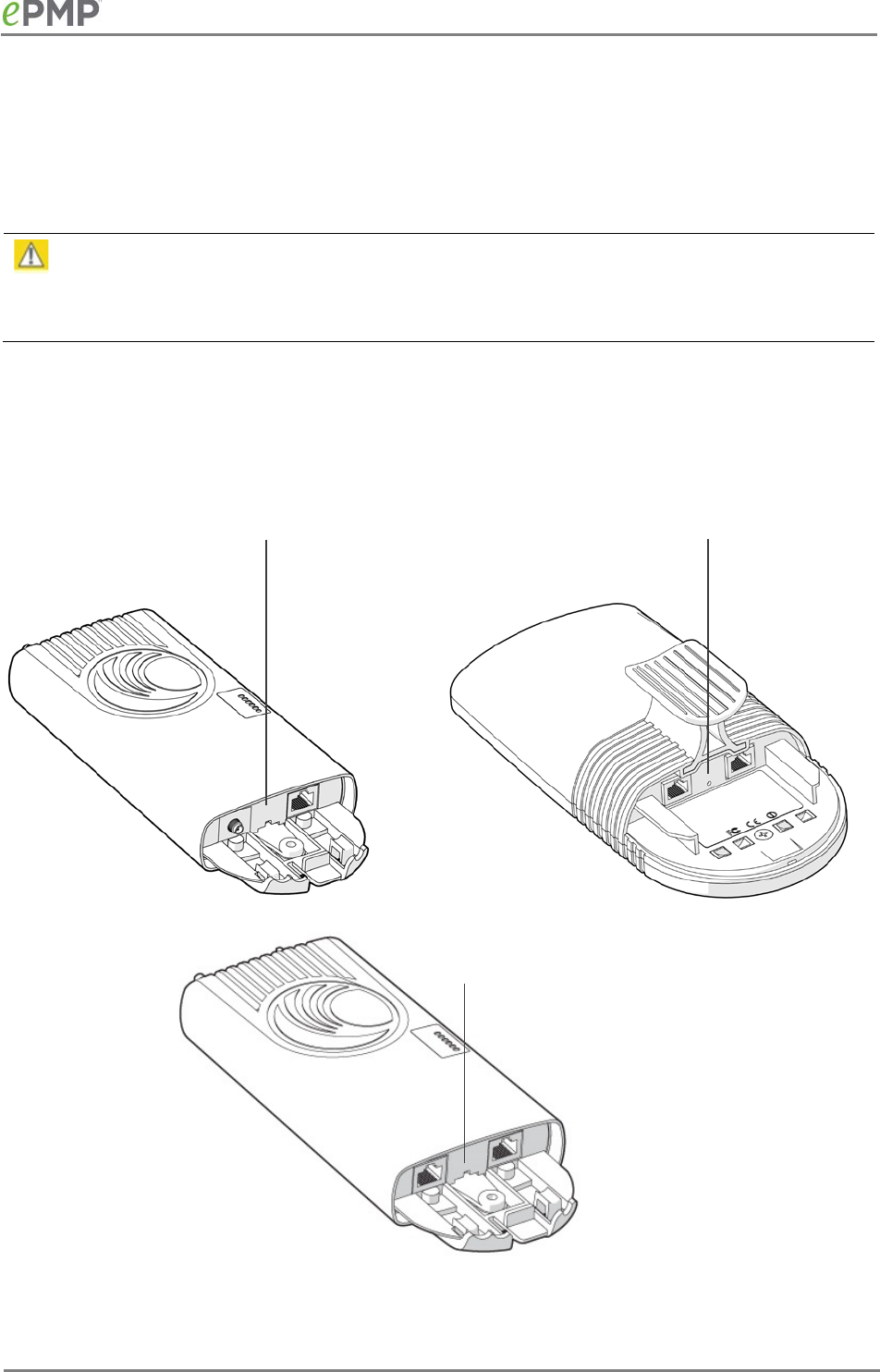
CAMBIUM NETWORKS
Using the device external reset button
ePMP APs and STAs feature an external button which serves two purposes:
• To reset the device (briefly depress the button for more than two seconds but less than ten
seconds then release)
Caution
If the reset button is pressed for more than ten seconds while powered on, the device will reset
back to its factory default configuration
• To reset the device to its factory default configuration (depress the button for more than ten
seconds then release)
Integrated Radio
Reset Button
Connectorized Radio
Reset Button
Un-synced
Connectorized Radio
Reset Button
206
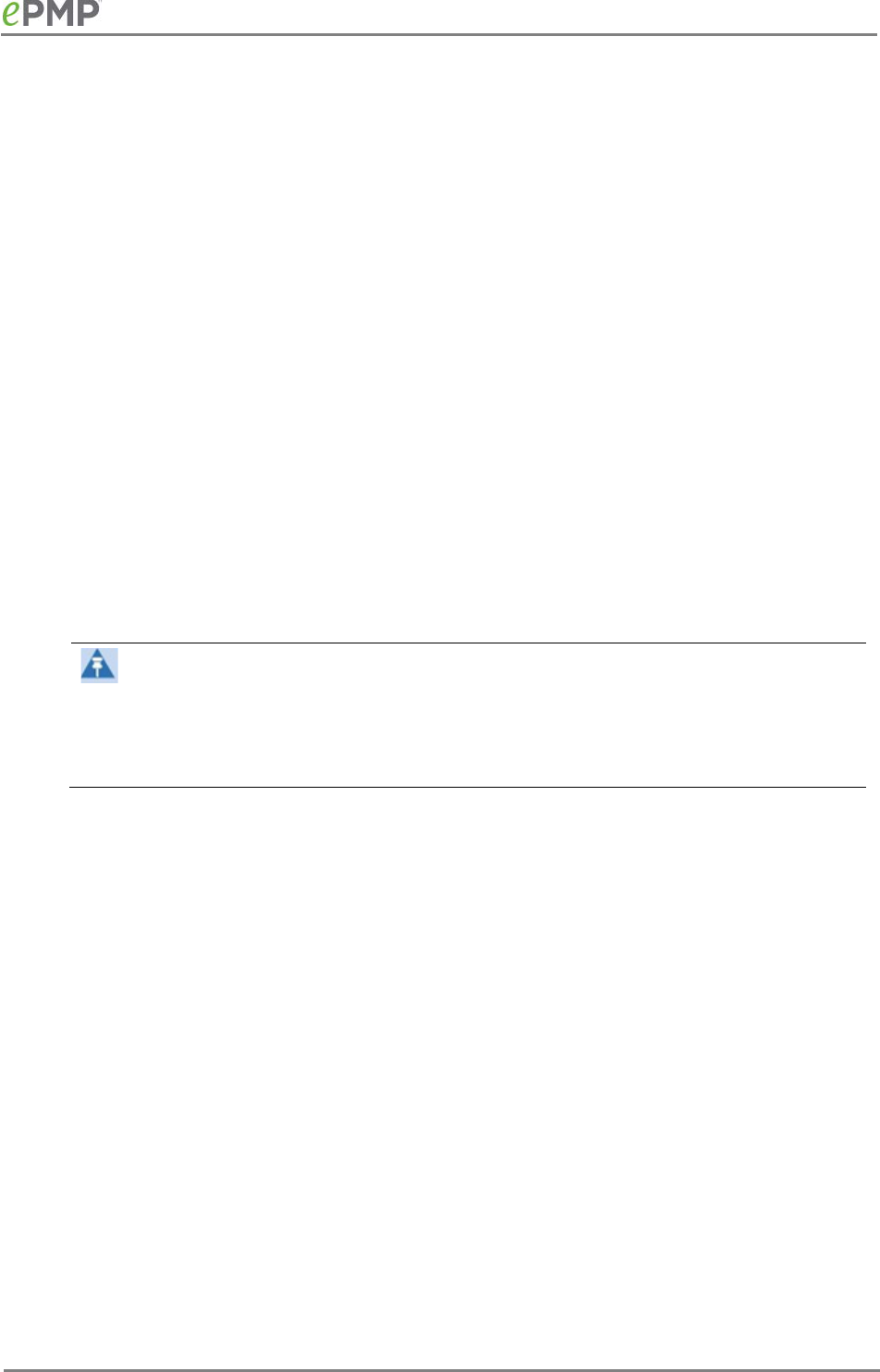
CAMBIUM NETWORKS
Resetting the AP or STA to factory defaults by power cycling
Operators may reset an AP or STA to default factory configuration by a sequence of power cycling
(removing power to the device. This procedure allows operators to perform a factory default reset
without a tower climb or additional tools.
Procedure:
1
Remove the AP or STA’s Ethernet cable from the power supply, then reconnect the Ethernet
cable to re-supply power to the AP or STA device (1st power cycle)
2
Remove the AP or STA’s Ethernet cable from the power supply, then reconnect the Ethernet
cable to re-supply power to the AP or STA device (2nd power cycle)
3
Remove the AP or STA’s Ethernet cable from the power supply, then reconnect the Ethernet
cable to re-supply power to the AP or STA device (3rd power cycle)
4
Remove the AP or STA’s Ethernet cable from the power supply, then reconnect the Ethernet
cable to re-supply power to the AP or STA device (4th power cycle)
5
Remove the AP or STA’s Ethernet cable from the power supply, then reconnect the Ethernet
cable to re-supply power to the AP or STA device (5th power cycle) to bring it all the way up.
The AP or STA will now come up with the factory default settings.
Note
Steps 1 through 4 above will have to be done within 10 seconds to reset the radio to its
factory default settings. This is to reduce the risk of the radio resetting to factory default
settings during normal, repeated power outages.
207

CAMBIUM NETWORKS
Legal and reference information
This chapter provides legal notices including software license agreements.
Caution
Intentional or unintentional changes or modifications to the equipment must not be made unless
under the express consent of the party responsible for compliance. Any such modifications
could void the user’s authority to operate the equipment and will void the manufacturer’s
warranty.
The following topics are described in this chapter:
•
Cambium Networks end user license agreement
on page
209
•
Hardware warranty
on page
258
•
Limit of liability
on page
259
•
Compliance with safety standards
on page
261
lists the safety specifications against which the
ePMP has been tested and certified. It also describes how to keep RF exposure within safe
limits.
•
Compliance with radio regulations
on page
264
describes how the ePMP complies with the
radio regulations that are enforced in various countries.
•
Notifications
on page
278
contain notes made to regulatory bodies for the ePMP.
•
Data throughput tables
on page
287
contain tables and graphs to support calculation of the
data rate capacity that can be provided by ePMP configurations.
208

CAMBIUM NETWORKS
Cambium Networks end user license agreement
ACCEPTANCE OF THIS AGREEMENT
In connection with Cambium Networks’ delivery of certain proprietary software or products
containing embedded or pre-loaded proprietary software, or both, Cambium Networks is willing to
license this certain proprietary software and the accompanying documentation to you only on the
condition that you accept all the terms in this End User License Agreement (“Agreement”).
IF YOU DO NOT AGREE TO THE TERMS OF THIS AGREEMENT, DO NOT USE THE PRODUCT OR
INSTALL THE SOFTWARE. INSTEAD, YOU MAY, FOR A FULL REFUND, RETURN THIS PRODUCT
TO THE LOCATION WHERE YOU ACQUIRED IT OR PROVIDE WRITTEN VERIFICATION OF
DELETION OF ALL COPIES OF THE SOFTWARE. ANY USE OF THE SOFTWARE, INCLUDING BUT
NOT LIMITED TO USE ON THE PRODUCT, WILL CONSTITUTE YOUR ACCEPTANCE TO THE
TERMS OF THIS AGREEMENT.
DEFINITIONS
In this Agreement, the word “Software” refers to the set of instructions for computers, in
executable form and in any media, (which may include diskette, CD-ROM, downloadable internet,
hardware, or firmware) licensed to you. The word “Documentation” refers to electronic or printed
manuals and accompanying instructional aids licensed to you. The word “Product” refers to
Cambium Networks’ fixed wireless broadband devices for which the Software and Documentation
is licensed for use.
GRANT OF LICENSE
Cambium Networks Limited (“Cambium”) grants you (“Licensee” or “you”) a personal,
nonexclusive, non-transferable license to use the Software and Documentation subject to the
Conditions of Use set forth in “
Conditions of use
” and the terms and conditions of this Agreement.
Any terms or conditions relating to the Software and Documentation appearing on the face or
reverse side of any purchase order, purchase order acknowledgment or other order document that
are different from, or in addition to, the terms of this Agreement will not be binding on the parties,
even if payment is accepted.
CONDITIONS OF USE
Any use of the Software and Documentation outside of the conditions set forth in this Agreement
is strictly prohibited and will be deemed a breach of this Agreement.
1. Only you, your employees or agents may use the Software and Documentation. You will take all
necessary steps to insure that your employees and agents abide by the terms of this Agreement.
2. You will use the Software and Documentation (i) only for your internal business purposes; (ii)
only as described in the Software and Documentation; and (iii) in strict accordance with this
Agreement.
3. You may use the Software and Documentation, provided that the use is in conformance with the
terms set forth in this Agreement.
209

CAMBIUM NETWORKS
4. Portions of the Software and Documentation are protected by United States copyright laws,
international treaty provisions, and other applicable laws. Therefore, you must treat the Software
like any other copyrighted material (for example, a book or musical recording) except that you may
either: (i) make 1 copy of the transportable part of the Software (which typically is supplied on
diskette, CD-ROM, or downloadable internet), solely for back-up purposes; or (ii) copy the
transportable part of the Software to a PC hard disk, provided you keep the original solely for back-
up purposes. If the Documentation is in printed form, it may not be copied. If the Documentation
is in electronic form, you may print out 1 copy, which then may not be copied. With regard to the
copy made for backup or archival purposes, you agree to reproduce any Cambium Networks
copyright notice, and other proprietary legends appearing thereon. Such copyright notice(s) may
appear in any of several forms, including machine-readable form, and you agree to reproduce
such notice in each form in which it appears, to the extent it is physically possible to do so.
Unauthorized duplication of the Software or Documentation constitutes copyright infringement,
and in the United States is punishable in federal court by fine and imprisonment.
5. You will not transfer, directly or indirectly, any product, technical data or software to any
country for which the United States Government requires an export license or other governmental
approval without first obtaining such license or approval.
TITLE AND RESTRICTIONS
If you transfer possession of any copy of the Software and Documentation to another party outside
of the terms of this agreement, your license is automatically terminated. Title and copyrights to
the Software and Documentation and any copies made by you remain with Cambium Networks
and its licensors. You will not, and will not permit others to: (i) modify, translate, decompile,
bootleg, reverse engineer, disassemble, or extract the inner workings of the Software or
Documentation, (ii) copy the look-and-feel or functionality of the Software or Documentation;
(iii) remove any proprietary notices, marks, labels, or logos from the Software or Documentation;
(iv) rent or transfer all or some of the Software or Documentation to any other party without
Cambium’s prior written consent; or (v) utilize any computer software or hardware which is
designed to defeat any copy protection device, should the Software and Documentation be
equipped with such a protection device. If the Software and Documentation is provided on
multiple types of media (such as diskette, CD-ROM, downloadable internet), then you will only use
the medium which best meets your specific needs, and will not loan, rent, lease, or transfer the
other media contained in the package without Cambium’s written consent. Unauthorized copying
of the Software or Documentation, or failure to comply with any of the provisions of this
Agreement, will result in automatic termination of this license.
210

CAMBIUM NETWORKS
CONFIDENTIALITY
You acknowledge that all Software and Documentation contain valuable proprietary information
and trade secrets and that unauthorized or improper use of the Software and Documentation will
result in irreparable harm to Cambium Networks for which monetary damages would be
inadequate and for which Cambium Networks will be entitled to immediate injunctive relief. If
applicable, you will limit access to the Software and Documentation to those of your employees
and agents who need to use the Software and Documentation for your internal business purposes,
and you will take appropriate action with those employees and agents to preserve the
confidentiality of the Software and Documentation, using the same degree of care to avoid
unauthorized or improper disclosure as you use for the protection of your own proprietary
software, but in no event less than reasonable care.
You have no obligation to preserve the confidentiality of any proprietary information that: (i) was
in the public domain at the time of disclosure; (ii) entered the public domain through no fault of
yours; (iii) was given to you free of any obligation to keep it confidential; (iv) is independently
developed by you; or (v) is disclosed as required by law provided that you notify Cambium
Networks prior to such disclosure and provide Cambium Networks with a reasonable opportunity
to respond.
RIGHT TO USE CAMBIUM’S NAME
Except as required in “
Conditions of use
”, you will not, during the term of this Agreement or
thereafter, use any trademark of Cambium Networks, or any word or symbol likely to be confused
with any Cambium Networks trademark, either alone or in any combination with another word or
words.
TRANSFER
The Software and Documentation may not be transferred to another party without the express
written consent of Cambium Networks, regardless of whether or not such transfer is accomplished
by physical or electronic means. Cambium’s consent may be withheld at its discretion and may be
conditioned upon transferee paying all applicable license fees and agreeing to be bound by this
Agreement.
UPDATES
During the first 12 months after purchase of a Product, or during the term of any executed
Maintenance and Support Agreement for the Product, you are entitled to receive Updates. An
“Update” means any code in any form which is a bug fix, patch, error correction, or minor
enhancement, but excludes any major feature added to the Software. Updates are available for
download at the support website.
Major features may be available from time to time for an additional license fee. If Cambium
Networks makes available to you major features and no other end user license agreement is
provided, then the terms of this Agreement will apply.
MAINTENANCE
Except as provided above, Cambium Networks is not responsible for maintenance or field service
of the Software under this Agreement.
211

CAMBIUM NETWORKS
DISCLAIMER
CAMBIUM NETWORKS DISCLAIMS ALL WARRANTIES OF ANY KIND, WHETHER EXPRESS,
IMPLIED, STATUTORY, OR IN ANY COMMUNICATION WITH YOU. CAMBIUM NETWORKS
SPECIFICALLY DISCLAIMS ANY WARRANTY INCLUDING THE IMPLIED WARRANTIES OF
MERCHANTABILTY, NONINFRINGEMENT, OR FITNESS FOR A PARTICULAR PURPOSE. THE
SOFTWARE AND DOCUMENTATION ARE PROVIDED “AS IS.” CAMBIUM NETWORKS DOES NOT
WARRANT THAT THE SOFTWARE WILL MEET YOUR REQUIREMENTS, OR THAT THE OPERATION
OF THE SOFTWARE WILL BE UNINTERRUPTED OR ERROR FREE, OR THAT DEFECTS IN THE
SOFTWARE WILL BE CORRECTED. CAMBIUM NETWORKS MAKES NO WARRANTY WITH
RESPECT TO THE CORRECTNESS, ACCURACY, OR RELIABILITY OF THE SOFTWARE AND
DOCUMENTATION. Some jurisdictions do not allow the exclusion of implied warranties, so the
above exclusion may not apply to you.
LIMITATION OF LIABILITY
IN NO EVENT SHALL CAMBIUM NETWORKS BE LIABLE TO YOU OR ANY OTHER PARTY FOR ANY
DIRECT, INDIRECT, GENERAL, SPECIAL, INCIDENTAL, CONSEQUENTIAL, EXEMPLARY OR OTHER
DAMAGE ARISING OUT OF THE USE OR INABILITY TO USE THE PRODUCT (INCLUDING,
WITHOUT LIMITATION, DAMAGES FOR LOSS OF BUSINESS PROFITS, BUSINESS
INTERRUPTION, LOSS OF BUSINESS INFORMATION OR ANY OTHER PECUNIARY LOSS, OR
FROM ANY BREACH OF WARRANTY, EVEN IF CAMBIUM NETWORKS HAS BEEN ADVISED OF
THE POSSIBILITY OF SUCH DAMAGES. (Some states do not allow the exclusion or limitation of
incidental or consequential damages, so the above exclusion or limitation may not apply to you.)
IN NO CASE SHALL CAMBIUM’S LIABILITY EXCEED THE AMOUNT YOU PAID FOR THE PRODUCT.
U.S. GOVERNMENT
If you are acquiring the Product on behalf of any unit or agency of the U.S. Government, the
following applies. Use, duplication, or disclosure of the Software and Documentation is subject to
the restrictions set forth in subparagraphs (c) (1) and (2) of the Commercial Computer Software –
Restricted Rights clause at FAR 52.227-19 (JUNE 1987), if applicable, unless being provided to the
Department of Defense. If being provided to the Department of Defense, use, duplication, or
disclosure of the Products is subject to the restricted rights set forth in subparagraph (c) (1) (ii) of
the Rights in Technical Data and Computer Software clause at DFARS 252.227-7013 (OCT 1988), if
applicable. Software and Documentation may or may not include a Restricted Rights notice, or
other notice referring specifically to the terms and conditions of this Agreement. The terms and
conditions of this Agreement will each continue to apply, but only to the extent that such terms
and conditions are not inconsistent with the rights provided to you under the aforementioned
provisions of the FAR and DFARS, as applicable to the particular procuring agency and
procurement transaction.
212

CAMBIUM NETWORKS
TERM OF LICENSE
Your right to use the Software will continue in perpetuity unless terminated as follows. Your right
to use the Software will terminate immediately without notice upon a breach of this Agreement by
you. Within 30 days after termination of this Agreement, you will certify to Cambium Networks in
writing that through your best efforts, and to the best of your knowledge, the original and all
copies, in whole or in part, in any form, of the Software and all related material and
Documentation, have been destroyed, except that, with prior written consent from Cambium
Networks, you may retain one copy for archival or backup purposes. You may not sublicense,
assign or transfer the license or the Product, except as expressly provided in this Agreement. Any
attempt to otherwise sublicense, assign or transfer any of the rights, duties or obligations
hereunder is null and void.
GOVERNING LAW
This Agreement is governed by the laws of the United States of America to the extent that they
apply and otherwise by the laws of the State of Illinois.
ASSIGNMENT
This agreement may not be assigned by you without Cambium’s prior written consent.
SURVIVAL OF PROVISIONS
The parties agree that where the context of any provision indicates an intent that it survives the
term of this Agreement, then it will survive.
ENTIRE AGREEMENT
This agreement contains the parties’ entire agreement regarding your use of the Software and
may be amended only in writing signed by both parties, except that Cambium Networks may
modify this Agreement as necessary to comply with applicable laws.
THIRD PARTY SOFTWARE
The software may contain one or more items of Third-Party Software supplied by other third-party
suppliers. The terms of this Agreement govern your use of any Third-Party Software UNLESS A
SEPARATE THIRD-PARTY SOFTWARE LICENSE IS INCLUDED, IN WHICH CASE YOUR USE OF THE
THIRD-PARTY SOFTWARE WILL THEN BE GOVERNED BY THE SEPARATE THIRD-PARTY LICENSE.
Aquila Copyright (c) 2002-2010, Atheros Communications Inc.
Copyright (c) 2002-2005 Sam Leffler, Errno Consulting
Copyright (C) 2011 Denali Software Inc. All rights reserved
Permission to use, copy, modify, and/or distribute this software for any
purpose with or without fee is hereby granted, provided that the above
copyright notice and this permission notice appear in all copies.
THE SOFTWARE IS PROVIDED "AS IS" AND THE AUTHOR DISCLAIMS ALL
WARRANTIES
213

CAMBIUM NETWORKS
WITH REGARD TO THIS SOFTWARE INCLUDING ALL IMPLIED WARRANTIES
OF
MERCHANTABILITY AND FITNESS. IN NO EVENT SHALL THE AUTHOR BE
LIABLE FOR
ANY SPECIAL, DIRECT, INDIRECT, OR CONSEQUENTIAL DAMAGES OR ANY
DAMAGES
WHATSOEVER RESULTING FROM LOSS OF USE, DATA OR PROFITS,
WHETHER IN AN
ACTION OF CONTRACT, NEGLIGENCE OR OTHER TORTIOUS ACTION,
ARISING OUT OF
OR IN CONNECTION WITH THE USE OR PERFORMANCE OF THIS
SOFTWARE.
==================================================
Redistribution and use in source and binary forms are permitted
provided that the following conditions are met:
1. The materials contained herein are unmodified and are used
unmodified.
2. Redistributions of source code must retain the above copyright
notice, this list of conditions and the following NO
''WARRANTY'' disclaimer below (''Disclaimer''), without
modification.
3. Redistributions in binary form must reproduce at minimum a
disclaimer similar to the Disclaimer below and any redistribution
must be conditioned upon including a substantially similar
Disclaimer requirement for further binary redistribution.
4. Neither the names of the above-listed copyright holders nor the
names of any contributors may be used to endorse or promote
product derived from this software without specific prior written
permission.
NO WARRANTY
THIS SOFTWARE IS PROVIDED BY THE COPYRIGHT HOLDERS AND
CONTRIBUTORS ''AS IS'' AND ANY EXPRESS OR IMPLIED WARRANTIES,
INCLUDING, BUT NOT LIMITED TO, THE IMPLIED WARRANTIES OF
NONINFRINGEMENT,MERCHANTIBILITY AND FITNESS FOR A PARTICULAR
PURPOSE ARE DISCLAIMED. IN NO EVENT SHALL THE COPYRIGHT
HOLDERS OR CONTRIBUTORS BE LIABLE FOR SPECIAL, EXEMPLARY, OR
CONSEQUENTIAL DAMAGES (INCLUDING, BUT NOT LIMITED TO,
PROCUREMENT OF SUBSTITUTE GOODS OR SERVICES; LOSS OF USE,
DATA, OR PROFITS; OR BUSINESS INTERRUPTION) HOWEVER CAUSED
AND ON ANY THEORY OF LIABILITY, WHETHER IN CONTRACT, STRICT
LIABILITY, OR TORT (INCLUDING NEGLIGENCE OR OTHERWISE) ARISING IN
ANY WAY OUT
OF THE USE OF THIS SOFTWARE, EVEN IF ADVISED OF THE POSSIBILITY
214

CAMBIUM NETWORKS
OF
SUCH DAMAGES.
Linux Kernel Copyright (c) 1989, 1991 Free Software Foundation
NOTE! This copyright does *not* cover user programs that use kernel
services by normal system calls - this is merely considered normal use
of the kernel, and does *not* fall under the heading of "derived work".
Also note that the GPL below is copyrighted by the Free Software
Foundation, but the instance of code that it refers to (the Linux
kernel) is copyrighted by me and others who actually wrote it.
Also note that the only valid version of the GPL as far as the kernel
is concerned is _this_ particular version of the license (ie v2, not
v2.2 or v3.x or whatever), unless explicitly otherwise stated.
Linus Torvalds
----------------------------------------
GNU GENERAL PUBLIC LICENSE
Version 2, June 1991
Copyright (C) 1989, 1991 Free Software Foundation, Inc.
51 Franklin St, Fifth Floor, Boston, MA 02110-1301 USA
Everyone is permitted to copy and distribute verbatim copies
of this license document, but changing it is not allowed.
See full license text on page
223
.
gpio_keys /*
* Driver for keys on GPIO lines capable of generating interrupts.
*
* Copyright 2005 Phil Blundell
*
* This program is free software; you can redistribute it and/or modify
* it under the terms of the GNU General Public License version 2 as
* published by the Free Software Foundation.
*/
OpenWrt GNU GENERAL PUBLIC LICENSE
Version 2, June 1991
Copyright (C) 1989, 1991 Free Software Foundation, Inc.
59 Temple Place, Suite 330, Boston, MA 02111-1307 USA
215

CAMBIUM NETWORKS
Everyone is permitted to copy and distribute verbatim copies
of this license document, but changing it is not allowed.
See full license text on page
223
.
uboot Copyright (c) 2007 Wolfgan Denk, DENIX Software Engeneering,
wd@denix.de
# (C) Copyright 2000 - 2005
# Wolfgang Denk, DENX Software Engineering, wd@denx.de.
#
# See file CREDITS for list of people who contributed to this
# project.
#
# This program is free software; you can redistribute it and/or
# modify it under the terms of the GNU General Public License as
# published by the Free Software Foundation; either version 2 of
# the License, or (at your option) any later version.
#
# This program is distributed in the hope that it will be useful,
# but WITHOUT ANY WARRANTY; without even the implied warranty of
# MERCHANTABILITY or FITNESS FOR A PARTICULAR PURPOSE. See the
# GNU General Public License for more details.
#
# You should have received a copy of the GNU General Public License
# along with this program; if not, write to the Free Software
# Foundation, Inc., 59 Temple Place, Suite 330, Boston,
# MA 02111-1307 USA
See full license text on page
223
.
jQuery The MIT License (MIT)
Copyright (c) 2013 The jQuery Foundation.
Permission is hereby granted, free of charge, to any person obtaining a copy
of this software and associated documentation files (the "Software"), to deal
in the Software without restriction, including without limitation the rights
to use, copy, modify, merge, publish, distribute, sublicense, and/or sell
copies of the Software, and to permit persons to whom the Software is
furnished to do so, subject to the following conditions:
The above copyright notice and this permission notice shall be included in
all copies or substantial portions of the Software.
THE SOFTWARE IS PROVIDED "AS IS", WITHOUT WARRANTY OF ANY KIND,
EXPRESS OR IMPLIED, INCLUDING BUT NOT LIMITED TO THE WARRANTIES
216

CAMBIUM NETWORKS
OF MERCHANTABILITY, FITNESS FOR A PARTICULAR PURPOSE AND
NONINFRINGEMENT. IN NO EVENT SHALL THE AUTHORS OR COPYRIGHT
HOLDERS BE LIABLE FOR ANY CLAIM, DAMAGES OR OTHER LIABILITY,
WHETHER IN AN ACTION OF CONTRACT, TORT OR OTHERWISE, ARISING
FROM, OUT OF OR IN CONNECTION WITH THE SOFTWARE OR THE USE OR
OTHER DEALINGS IN THE SOFTWARE.
Data-Driven
Document
Copyright (c) 2012, Michael Bostock
Copyright (c) 2013, Michael Bostock
All rights reserved.
Redistribution and use in source and binary forms, with or without
modification, are permitted provided that the following conditions are met:
* Redistributions of source code must retain the above copyright notice, this
list of conditions and the following disclaimer.
* Redistributions in binary form must reproduce the above copyright notice,
this list of conditions and the following disclaimer in the documentation
and/or other materials provided with the distribution.
* The name Michael Bostock may not be used to endorse or promote
products
derived from this software without specific prior written permission.
THIS SOFTWARE IS PROVIDED BY THE COPYRIGHT HOLDERS AND
CONTRIBUTORS "AS IS" AND ANY EXPRESS OR IMPLIED WARRANTIES,
INCLUDING, BUT NOT LIMITED TO, THE IMPLIED WARRANTIES OF
MERCHANTABILITY AND FITNESS FOR A PARTICULAR PURPOSE ARE
DISCLAIMED. IN NO EVENT SHALL MICHAEL BOSTOCK BE LIABLE FOR ANY
DIRECT, INDIRECT, INCIDENTAL, SPECIAL, EXEMPLARY, OR
CONSEQUENTIAL DAMAGES (INCLUDING, BUT NOT LIMITED TO,
PROCUREMENT OF SUBSTITUTE GOODS OR SERVICES; LOSS OF USE,
DATA, OR PROFITS; OR BUSINESS INTERRUPTION) HOWEVER CAUSED
AND ON ANY THEORY OF LIABILITY, WHETHER IN CONTRACT, STRICT
LIABILITY, OR TORT (INCLUDING NEGLIGENCE OR OTHERWISE) ARISING IN
ANY WAY OUT OF THE USE OF THIS SOFTWARE, EVEN IF ADVISED OF THE
POSSIBILITY OF SUCH DAMAGE.
217

CAMBIUM NETWORKS
AjaxFileUpload The MIT License (MIT)
Copyright 2013-2014 powered by PHPLETTER
Permission is hereby granted, free of charge, to any person obtaining a copy
of this software and associated documentation files (the "Software"), to deal
in the Software without restriction, including without limitation the rights
to use, copy, modify, merge, publish, distribute, sublicense, and/or sell
copies of the Software, and to permit persons to whom the Software is
furnished to do so, subject to the following conditions:
The above copyright notice and this permission notice shall be included in
all copies or substantial portions of the Software.
THE SOFTWARE IS PROVIDED "AS IS", WITHOUT WARRANTY OF ANY KIND,
EXPRESS OR IMPLIED, INCLUDING BUT NOT LIMITED TO THE WARRANTIES
OF MERCHANTABILITY, FITNESS FOR A PARTICULAR PURPOSE AND
NONINFRINGEMENT. IN NO EVENT SHALL THE AUTHORS OR COPYRIGHT
HOLDERS BE LIABLE FOR ANY CLAIM, DAMAGES OR OTHER LIABILITY,
WHETHER IN AN ACTION OF CONTRACT, TORT OR OTHERWISE, ARISING
FROM, OUT OF OR IN CONNECTION WITH THE SOFTWARE OR THE USE OR
OTHER DEALINGS IN THE SOFTWARE.
218

CAMBIUM NETWORKS
jquery.caret The MIT License (MIT)
Copyright (c) 2010 C. F., Wong
Permission is hereby granted, free of charge, to any person obtaining a copy
of this software and associated documentation files (the "Software"), to deal
in the Software without restriction, including without limitation the rights
to use, copy, modify, merge, publish, distribute, sublicense, and/or sell
copies of the Software, and to permit persons to whom the Software is
furnished to do so, subject to the following conditions:
The above copyright notice and this permission notice shall be included in
all copies or substantial portions of the Software.
THE SOFTWARE IS PROVIDED "AS IS", WITHOUT WARRANTY OF ANY KIND,
EXPRESS OR IMPLIED, INCLUDING BUT NOT LIMITED TO THE WARRANTIES
OF MERCHANTABILITY, FITNESS FOR A PARTICULAR PURPOSE AND
NONINFRINGEMENT. IN NO EVENT SHALL THE AUTHORS OR COPYRIGHT
HOLDERS BE LIABLE FOR ANY CLAIM, DAMAGES OR OTHER LIABILITY,
WHETHER IN AN ACTION OF CONTRACT, TORT OR OTHERWISE, ARISING
FROM, OUT OF OR IN CONNECTION WITH THE SOFTWARE OR THE USE OR
OTHER DEALINGS IN THE SOFTWARE.
jquery.cookie Copyright 2013 Klaus Hartl
Permission is hereby granted, free of charge, to any person obtaining
a copy of this software and associated documentation files (the
"Software"), to deal in the Software without restriction, including
without limitation the rights to use, copy, modify, merge, publish,
distribute, sublicense, and/or sell copies of the Software, and to
permit persons to whom the Software is furnished to do so, subject to
the following conditions:
The above copyright notice and this permission notice shall be
included in all copies or substantial portions of the Software.
THE SOFTWARE IS PROVIDED "AS IS", WITHOUT WARRANTY OF ANY KIND,
EXPRESS OR IMPLIED, INCLUDING BUT NOT LIMITED TO THE WARRANTIES
OF MERCHANTABILITY, FITNESS FOR A PARTICULAR PURPOSE AND
NONINFRINGEMENT. IN NO EVENT SHALL THE AUTHORS OR COPYRIGHT
HOLDERS BE LIABLE FOR ANY CLAIM, DAMAGES OR OTHER LIABILITY,
WHETHER IN AN ACTION OF CONTRACT, TORT OR OTHERWISE, ARISING
FROM, OUT OF OR IN CONNECTION WITH THE SOFTWARE OR THE USE OR
OTHER DEALINGS IN THE SOFTWARE.
219

CAMBIUM NETWORKS
json2.js http://www.JSON.org/json2.js
2010-08-25
Public Domain.
NO WARRANTY EXPRESSED OR IMPLIED. USE AT YOUR OWN RISK.
See http://www.JSON.org/js.html
This code must be minified before deployment.
See http://javascript.crockford.com/jsmin.html
USE YOUR OWN COPY. IT IS EXTREMELY UNWISE TO LOAD CODE FROM
SERVERS YOU DO NOT CONTROL.
jquery.noty Copyright (c) 2012 Nedim Arabacı
Permission is hereby granted, free of charge, to any person obtaining
a copy of this software and associated documentation files (the
"Software"), to deal in the Software without restriction, including
without limitation the rights to use, copy, modify, merge, publish,
distribute, sublicense, and/or sell copies of the Software, and to
permit persons to whom the Software is furnished to do so, subject to
the following conditions:
The above copyright notice and this permission notice shall be
included in all copies or substantial portions of the Software.
THE SOFTWARE IS PROVIDED "AS IS", WITHOUT WARRANTY OF ANY KIND,
EXPRESS OR IMPLIED, INCLUDING BUT NOT LIMITED TO THE WARRANTIES
OF MERCHANTABILITY, FITNESS FOR A PARTICULAR PURPOSE AND
NONINFRINGEMENT. IN NO EVENT SHALL THE AUTHORS OR COPYRIGHT
HOLDERS BE LIABLE FOR ANY CLAIM, DAMAGES OR OTHER LIABILITY,
WHETHER IN AN ACTION OF CONTRACT, TORT OR OTHERWISE, ARISING
FROM, OUT OF OR IN CONNECTION WITH THE SOFTWARE OR THE USE OR
OTHER DEALINGS IN THE SOFTWARE.
220

CAMBIUM NETWORKS
SlickGrid Copyright (c) 2009-2012 Michael Leibman
Copyright (c) 2010 Michael Leibman
http://github.com/mleibman/slickgrid
Permission is hereby granted, free of charge, to any person obtaining
a copy of this software and associated documentation files (the
"Software"), to deal in the Software without restriction, including
without limitation the rights to use, copy, modify, merge, publish,
distribute, sublicense, and/or sell copies of the Software, and to
permit persons to whom the Software is furnished to do so, subject to
the following conditions:
The above copyright notice and this permission notice shall be
included in all copies or substantial portions of the Software.
THE SOFTWARE IS PROVIDED "AS IS", WITHOUT WARRANTY OF ANY KIND,
EXPRESS OR IMPLIED, INCLUDING BUT NOT LIMITED TO THE WARRANTIES
OF MERCHANTABILITY, FITNESS FOR A PARTICULAR PURPOSE AND
NONINFRINGEMENT. IN NO EVENT SHALL THE AUTHORS OR COPYRIGHT
HOLDERS BE LIABLE FOR ANY CLAIM, DAMAGES OR OTHER LIABILITY,
WHETHER IN AN ACTION OF CONTRACT, TORT OR OTHERWISE, ARISING
FROM, OUT OF OR IN CONNECTION WITH THE SOFTWARE OR THE USE OR
OTHER DEALINGS IN THE SOFTWARE.
221

CAMBIUM NETWORKS
jquery.event.drag The MIT License (MIT)
Copyright (c) 2010 Three Dub Media
Permission is hereby granted, free of charge, to any person obtaining a copy
of this software and associated documentation files (the "Software"), to deal
in the Software without restriction, including without limitation the rights
to use, copy, modify, merge, publish, distribute, sublicense, and/or sell
copies of the Software, and to permit persons to whom the Software is
furnished to do so, subject to the following conditions:
The above copyright notice and this permission notice shall be included in
all copies or substantial portions of the Software.
THE SOFTWARE IS PROVIDED "AS IS", WITHOUT WARRANTY OF ANY KIND,
EXPRESS OR IMPLIED, INCLUDING BUT NOT LIMITED TO THE WARRANTIES
OF MERCHANTABILITY, FITNESS FOR A PARTICULAR PURPOSE AND
NONINFRINGEMENT. IN NO EVENT SHALL THE AUTHORS OR COPYRIGHT
HOLDERS BE LIABLE FOR ANY CLAIM, DAMAGES OR OTHER LIABILITY,
WHETHER IN AN ACTION OF CONTRACT, TORT OR OTHERWISE, ARISING
FROM, OUT OF OR IN CONNECTION WITH THE SOFTWARE OR THE USE OR
OTHER DEALINGS IN THE SOFTWARE.
IE9.js The MIT License (MIT)
Copyright (c) 2004-2010, Dean Edwards
Permission is hereby granted, free of charge, to any person obtaining a copy
of this software and associated documentation files (the "Software"), to deal
in the Software without restriction, including without limitation the rights to
use, copy, modify, merge, publish, distribute, sublicense, and/or sell copies
of the Software, and to permit persons to whom the Software is furnished to
do so, subject to the following conditions:
The above copyright notice and this permission notice shall be included in all
copies or substantial portions of the Software.
THE SOFTWARE IS PROVIDED "AS IS", WITHOUT WARRANTY OF ANY KIND,
EXPRESS OR IMPLIED, INCLUDING BUT NOT LIMITED TO THE WARRANTIES
OF MERCHANTABILITY, FITNESS FOR A PARTICULAR PURPOSE AND
NONINFRINGEMENT. IN NO EVENT SHALL THE AUTHORS OR COPYRIGHT
HOLDERS BE LIABLE FOR ANY CLAIM, DAMAGES OR OTHER LIABILITY,
WHETHER IN AN ACTION OF CONTRACT, TORT OR OTHERWISE, ARISING
FROM, OUT OF OR IN CONNECTION WITH THE SOFTWARE OR THE USE OR
OTHER DEALINGS IN THE SOFTWARE.
222

CAMBIUM NETWORKS
busybox --- A note on GPL versions
BusyBox is distributed under version 2 of the General Public License
(included in its entirety, below). Version 2 is the only version of this license
which this version of BusyBox (or modified versions derived from this one)
may be distributed under.
------------------------------------------------------------------------
GNU GENERAL PUBLIC LICENSE
Version 2, June 1991
Copyright (C) 1989, 1991 Free Software Foundation, Inc.
51 Franklin St, Fifth Floor, Boston, MA 02110-1301 USA
Everyone is permitted to copy and distribute verbatim copies
of this license document, but changing it is not allowed.
Preamble
The licenses for most software are designed to take away your freedom to
share and change it. By contrast, the GNU General Public License is intended
to guarantee your freedom to share and change free software--to make sure
the software is free for all its users. This General Public License applies to
most of the Free Software Foundation's software and to any other program
whose authors commit to using it. (Some other Free Software Foundation
software is covered by the GNU Lesser General Public License instead.) You
can apply it to your programs, too.
When we speak of free software, we are referring to freedom, not price. Our
General Public Licenses are designed to make sure that you have the
freedom to distribute copies of free software (and charge for this service if
you wish), that you receive source code or can get it if you want it, that you
can change the software or use pieces of it in new free programs; and that
you know you can do these things.
To protect your rights, we need to make restrictions that forbid anyone to
deny you these rights or to ask you to surrender the rights. These restrictions
translate to certain responsibilities for you if you distribute copies of the
software, or if you modify it.
For example, if you distribute copies of such a program, whether gratis or for
a fee, you must give the recipients all the rights that you have. You must
make sure that they, too, receive or can get the source code. And you must
show them these terms so they know their rights.
223

CAMBIUM NETWORKS
We protect your rights with two steps: (1) copyright the software, and (2)
offer you this license which gives you legal permission to copy, distribute
and/or modify the software.
Also, for each author's protection and ours, we want to make certain that
everyone understands that there is no warranty for this free software. If the
software is modified by someone else and passed on, we want its recipients
to know that what they have is not the original, so that any problems
introduced by others will not reflect on the original authors' reputations.
Finally, any free program is threatened constantly by software patents. We
wish to avoid the danger that redistributors of a free program will
individually obtain patent licenses, in effect making the program proprietary.
To prevent this, we have made it clear that any patent must be licensed for
everyone's free use or not licensed at all.
The precise terms and conditions for copying, distribution and modification
follow.
TERMS AND CONDITIONS FOR COPYING, DISTRIBUTION AND
MODIFICATION
0.
This License applies to any program or other work which contains a notice
placed by the copyright holder saying it may be distributed under the terms
of this General Public License. The "Program", below, refers to any such
program or work, and a "work based on the Program" means either the
Program or any derivative work under copyright law: that is to say, a work
containing the Program or a portion of it, either verbatim or with
modifications and/or translated into another language. (Hereinafter,
translation is included without limitation in the term "modification".) Each
licensee is addressed as "you".
Activities other than copying, distribution and modification are not covered
by this License; they are outside its scope. The act of running the Program is
not restricted, and the output from the Program is covered only if its contents
constitute a work based on the Program (independent of having been made
by running the Program). Whether that is true depends on what the Program
does.
1.
You may copy and distribute verbatim copies of the Program's source
code as you receive it, in any medium, provided that you conspicuously and
appropriately publish on each copy an appropriate copyright notice and
224

CAMBIUM NETWORKS
disclaimer of warranty; keep intact all the notices that refer to this License
and to the absence of any warranty; and give any other recipients of the
Program a copy of this License along with the Program.
You may charge a fee for the physical act of transferring a copy, and you may
at your option offer warranty protection in exchange for a fee.
2.
You may modify your copy or copies of the Program or any portion of it,
thus forming a work based on the Program, and copy and distribute such
modifications or work under the terms of Section 1 above, provided that you
also meet all of these conditions:
a)
You must cause the modified files to carry prominent notices
stating that you changed the files and the date of any change.
b)
You must cause any work that you distribute or publish, that in
whole or in part contains or is derived from the Program or any
part thereof, to be licensed as a whole at no charge to all third
parties under the terms of this License.
c)
If the modified program normally reads commands interactively
when run, you must cause it, when started running for such
interactive use in the most ordinary way, to print or display an
announcement including an appropriate copyright notice and a
notice that there is no warranty (or else, saying that you provide a
warranty) and that users may redistribute the program under these
conditions, and telling the user how to view a copy of this License.
(Exception: if the Program itself is interactive but does not normally
print such an announcement, your work based on the Program is
not required to print an announcement.)
These requirements apply to the modified work as a whole. If identifiable
sections of that work are not derived from the Program, and can be
reasonably considered independent and separate works in themselves, then
this License, and its terms, do not apply to those sections when you
distribute them as separate works. But when you distribute the same sections
as part of a whole which is a work based on the Program, the distribution of
the whole must be on the terms of this License, whose permissions for other
licensees extend to the entire whole, and thus to each and every part
225

CAMBIUM NETWORKS
regardless of who wrote it.
Thus, it is not the intent of this section to claim rights or contest your rights
to work written entirely by you; rather, the intent is to exercise the right to
control the distribution of derivative or collective works based on the
Program.
In addition, mere aggregation of another work not based on the Program
with the Program (or with a work based on the Program) on a volume of a
storage or distribution medium does not bring the other work under the
scope of this License.
3.
You may copy and distribute the Program (or a work based on it, under
Section 2) in object code or executable form under the terms of Sections 1
and 2 above provided that you also do one of the following:
a)
Accompany it with the complete corresponding machine-
readable source code, which must be distributed under the terms
of Sections 1 and 2 above on a medium customarily used for
software interchange; or,
b)
Accompany it with a written offer, valid for at least three years,
to give any third party, for a charge no more than your cost of
physically performing source distribution, a complete machine-
readable copy of the corresponding source code, to be distributed
under the terms of Sections 1 and 2 above on a medium
customarily used for software interchange; or,
c)
Accompany it with the information you received as to the offer
to distribute corresponding source code. (This alternative is
allowed only for noncommercial distribution and only if you
received the program in object code or executable form with such
an offer, in accord with Subsection b above.)
The source code for a work means the preferred form of the work for making
modifications to it. For an executable work, complete source code means all
the source code for all modules it contains, plus any associated interface
definition files, plus the scripts used to control compilation and installation of
the executable. However, as a special exception, the source code distributed
need not include anything that is normally distributed (in either source or
226

CAMBIUM NETWORKS
binary form) with the major components (compiler, kernel, and so on) of the
operating system on which the executable runs, unless that component itself
accompanies the executable.
If distribution of executable or object code is made by offering access to copy
from a designated place, then offering equivalent access to copy the source
code from the same place counts as distribution of the source code, even
though third parties are not compelled to copy the source along with the
object code.
4.
You may not copy, modify, sublicense, or distribute the Program except as
expressly provided under this License. Any attempt otherwise to copy,
modify, sublicense or distribute the Program is void, and will automatically
terminate your rights under this License. However, parties who have received
copies, or rights, from you under this License will not have their licenses
terminated so long as such parties remain in full compliance.
5.
You are not required to accept this License, since you have not signed it.
However, nothing else grants you permission to modify or distribute the
Program or its derivative works. These actions are prohibited by law if you do
not accept this License. Therefore, by modifying or distributing the Program
(or any work based on the Program), you indicate your acceptance of this
License to do so, and all its terms and conditions for copying, distributing or
modifying the Program or works based on it.
6.
Each time you redistribute the Program (or any work based on the
Program), the recipient automatically receives a license from the original
licensor to copy, distribute or modify the Program subject to these terms and
conditions. You may not impose any further restrictions on the recipients'
exercise of the rights granted herein. You are not responsible for enforcing
compliance by third parties to this License.
7.
If, as a consequence of a court judgment or allegation of patent
infringement or for any other reason (not limited to patent issues), conditions
are imposed on you (whether by court order, agreement or otherwise) that
contradict the conditions of this License, they do not excuse you from the
conditions of this License. If you cannot distribute so as to satisfy
simultaneously your obligations under this License and any other pertinent
obligations, then as a consequence you may not distribute the Program at all.
For example, if a patent license would not permit royalty-free redistribution
of the Program by all those who receive copies directly or indirectly through
you, then the only way you could satisfy both it and this License would be to
227

CAMBIUM NETWORKS
refrain entirely from distribution of the Program.
If any portion of this section is held invalid or unenforceable under any
particular circumstance, the balance of the section is intended to apply and
the section as a whole is intended to apply in other circumstances.
It is not the purpose of this section to induce you to infringe any patents or
other property right claims or to contest validity of any such claims; this
section has the sole purpose of protecting the integrity of the free software
distribution system, which is implemented by public license practices. Many
people have made generous contributions to the wide range of software
distributed through that system in reliance on consistent application of that
system; it is up to the author/donor to decide if he or she is willing to
distribute software through any other system and a licensee cannot impose
that choice.
This section is intended to make thoroughly clear what is believed to be a
consequence of the rest of this License.
8.
If the distribution and/or use of the Program is restricted in certain
countries either by patents or by copyrighted interfaces, the original
copyright holder who places the Program under this License may add an
explicit geographical distribution limitation excluding those countries, so that
distribution is permitted only in or among countries not thus excluded. In
such case, this License incorporates the limitation as if written in the body of
this License.
9.
The Free Software Foundation may publish revised and/or new versions of
the General Public License from time to time. Such new versions will be
similar in spirit to the present version, but may differ in detail to address new
problems or concerns.
Each version is given a distinguishing version number. If the Program
specifies a version number of this License which applies to it and "any later
version", you have the option of following the terms and conditions either of
that version or of any later version published by the Free Software
Foundation. If the Program does not specify a version number of this License,
you may choose any version ever published by the Free Software
Foundation.
10.
If you wish to incorporate parts of the Program into other free programs
whose distribution conditions are different, write to the author to ask for
permission. For software which is copyrighted by the Free Software
228

CAMBIUM NETWORKS
Foundation, write to the Free Software Foundation; we sometimes make
exceptions for this. Our decision will be guided by the two goals of
preserving the free status of all derivatives of our free software and of
promoting the sharing and reuse of software generally.
NO WARRANTY
11.
BECAUSE THE PROGRAM IS LICENSED FREE OF CHARGE, THERE IS NO
WARRANTY FOR THE PROGRAM, TO THE EXTENT PERMITTED BY
APPLICABLE LAW. EXCEPT WHEN OTHERWISE STATED IN WRITING THE
COPYRIGHT HOLDERS AND/OR OTHER PARTIES PROVIDE THE PROGRAM
"AS IS" WITHOUT WARRANTY OF ANY KIND, EITHER EXPRESSED OR
IMPLIED, INCLUDING, BUT NOT LIMITED TO, THE IMPLIED WARRANTIES OF
MERCHANTABILITY AND FITNESS FOR A PARTICULAR PURPOSE. THE
ENTIRE RISK AS TO THE QUALITY AND PERFORMANCE OF THE PROGRAM
IS WITH YOU. SHOULD THE PROGRAM PROVE DEFECTIVE, YOU ASSUME
THE COST OF ALL NECESSARY SERVICING, REPAIR OR CORRECTION.
12.
IN NO EVENT UNLESS REQUIRED BY APPLICABLE LAW OR AGREED TO
IN WRITING WILL ANY COPYRIGHT HOLDER, OR ANY OTHER PARTY WHO
MAY MODIFY AND/OR REDISTRIBUTE THE PROGRAM AS PERMITTED
ABOVE, BE LIABLE TO YOU FOR DAMAGES, INCLUDING ANY GENERAL,
SPECIAL, INCIDENTAL OR CONSEQUENTIAL DAMAGES ARISING OUT OF
THE USE OR INABILITY TO USE THE PROGRAM (INCLUDING BUT NOT
LIMITED TO LOSS OF DATA OR DATA BEING RENDERED INACCURATE OR
LOSSES SUSTAINED BY YOU OR THIRD PARTIES OR A FAILURE OF THE
PROGRAM TO OPERATE WITH ANY OTHER PROGRAMS), EVEN IF SUCH
HOLDER OR OTHER PARTY HAS BEEN ADVISED OF THE POSSIBILITY OF
SUCH DAMAGES.
END OF TERMS AND CONDITIONS
dnsmasq # This program is free software; you can redistribute it and/or modify
# it under the terms of the GNU General Public License as published by
# the Free Software Foundation; version 2 dated June, 1991, or
# (at your option) version 3 dated 29 June, 2007.
See full license text on page
223
.
dropbear Dropbear contains a number of components from different sources, hence
there are a few licenses and authors involved. All licenses are fairly non-
restrictive.
229

CAMBIUM NETWORKS
The majority of code is written by Matt Johnston, under the license below.
Portions of the client-mode work are (c) 2004 Mihnea Stoenescu, under the
same license:
Copyright (c) 2002-2008 Matt Johnston
Portions copyright (c) 2004 Mihnea Stoenescu
All rights reserved.
Permission is hereby granted, free of charge, to any person obtaining a copy
of this software and associated documentation files (the "Software"), to deal
in the Software without restriction, including without limitation the rights to
use, copy, modify, merge, publish, distribute, sublicense, and/or sell copies
of the Software, and to permit persons to whom the Software is furnished to
do so, subject to the following conditions:
The above copyright notice and this permission notice shall be included in all
copies or substantial portions of the Software.
THE SOFTWARE IS PROVIDED "AS IS", WITHOUT WARRANTY OF ANY KIND,
EXPRESS OR IMPLIED, INCLUDING BUT NOT LIMITED TO THE WARRANTIES
OF MERCHANTABILITY, FITNESS FOR A PARTICULAR PURPOSE AND
NONINFRINGEMENT. IN NO EVENT SHALL THE AUTHORS OR COPYRIGHT
HOLDERS BE LIABLE FOR ANY CLAIM, DAMAGES OR OTHER LIABILITY,
WHETHER IN AN ACTION OF CONTRACT, TORT OR OTHERWISE, ARISING
FROM, OUT OF OR IN CONNECTION WITH THE SOFTWARE OR THE USE OR
OTHER DEALINGS IN THE SOFTWARE.
=====
LibTomCrypt and LibTomMath are written by Tom St Denis, and are Public
Domain.
=====
sshpty.c is taken from OpenSSH 3.5p1,
Copyright (c) 1995 Tatu Ylonen <ylo@cs.hut.fi>, Espoo, Finland
All rights reserved
"As far as I am concerned, the code I have written for this software
can be used freely for any purpose. Any derived versions of this
software must be clearly marked as such, and if the derived work is
incompatible with the protocol description in the RFC file, it must be
called by a name other than "ssh" or "Secure Shell". "
=====
230

CAMBIUM NETWORKS
loginrec.c
loginrec.h
atomicio.h
atomicio.c
and strlcat() (included in util.c) are from OpenSSH 3.6.1p2, and are licensed
under the 2 point BSD license.
loginrec is written primarily by Andre Lucas, atomicio.c by Theo de Raadt.
strlcat() is (c) Todd C. Miller
=====
Import code in keyimport.c is modified from PuTTY's import.c, licensed as
follows:
PuTTY is copyright 1997-2003 Simon Tatham.
Portions copyright Robert de Bath, Joris van Rantwijk, Delian
Delchev, Andreas Schultz, Jeroen Massar, Wez Furlong, Nicolas Barry,
Justin Bradford, and CORE SDI S.A.
Permission is hereby granted, free of charge, to any person
obtaining a copy of this software and associated documentation files
(the "Software"), to deal in the Software without restriction,
including without limitation the rights to use, copy, modify, merge,
publish, distribute, sublicense, and/or sell copies of the Software,
and to permit persons to whom the Software is furnished to do so,
subject to the following conditions:
The above copyright notice and this permission notice shall be
included in all copies or substantial portions of the Software.
THE SOFTWARE IS PROVIDED "AS IS", WITHOUT WARRANTY OF ANY KIND,
EXPRESS OR IMPLIED, INCLUDING BUT NOT LIMITED TO THE WARRANTIES
OF MERCHANTABILITY, FITNESS FOR A PARTICULAR PURPOSE AND
NONINFRINGEMENT. IN NO EVENT SHALL THE COPYRIGHT HOLDERS BE
LIABLE FOR ANY CLAIM, DAMAGES OR OTHER LIABILITY, WHETHER IN AN
ACTION OF CONTRACT, TORT OR OTHERWISE, ARISING FROM, OUT OF OR
IN CONNECTION WITH THE SOFTWARE OR THE USE OR OTHER DEALINGS
IN THE SOFTWARE.
231

CAMBIUM NETWORKS
ebtables Copyright (C) 1999 Paul `Rusty' Russell & Michael J. Neuling
Copyright (C) 2001-2002 Bart De Schuymer
All code in this package, including the code from the extensions,
is released under the GPL license, which you find hereafter.
GNU GENERAL PUBLIC LICENSE
Version 2, June 1991
Copyright (C) 1989, 1991 Free Software Foundation, Inc.
675 Mass Ave, Cambridge, MA 02139, USA
Everyone is permitted to copy and distribute verbatim copies
of this license document, but changing it is not allowed.
See full license text on page
223
.
eventlog Copyright (c) 2003 BalaBit IT Ltd.
Redistribution and use in source and binary forms, with or without
modification, are permitted provided that the following conditions
are met:
1. Redistributions of source code must retain the above copyright
notice, this list of conditions and the following disclaimer.
2. Redistributions in binary form must reproduce the above copyright
notice, this list of conditions and the following disclaimer in the
documentation and/or other materials provided with the distribution.
3. Neither the name of BalaBit nor the names of its contributors
may be used to endorse or promote products derived from this software
without specific prior written permission.
THIS SOFTWARE IS PROVIDED BY BALABIT AND CONTRIBUTORS ``AS IS''
AND ANY EXPRESS OR IMPLIED WARRANTIES, INCLUDING, BUT NOT
LIMITED TO, THE IMPLIED WARRANTIES OF MERCHANTABILITY AND
FITNESS FOR A PARTICULAR PURPOSE ARE DISCLAIMED. IN NO EVENT
SHALL THE AUTHOR OR CONTRIBUTORS BE LIABLE FOR ANY DIRECT,
INDIRECT, INCIDENTAL, SPECIAL, EXEMPLARY, OR CONSEQUENTIAL
DAMAGES (INCLUDING, BUT NOT LIMITED TO, PROCUREMENT OF
SUBSTITUTE GOODS OR SERVICES; LOSS OF USE, DATA, OR PROFITS; OR
BUSINESS INTERRUPTION) HOWEVER CAUSED AND ON ANY THEORY OF
LIABILITY, WHETHER IN CONTRACT, STRICT LIABILITY, OR TORT
(INCLUDING NEGLIGENCE OR OTHERWISE) ARISING IN ANY WAY OUT OF
THE USE OF THIS SOFTWARE, EVEN IF ADVISED OF THE POSSIBILITY OF
SUCH DAMAGE.
232

CAMBIUM NETWORKS
firewall # Copyright (C) 2009-2010 OpenWrt.org
glib2 Copyright (C) 2007-2011 OpenWrt.org
Copyright (C) 1994, 1995, 1996, 1997, 1998, 1999, 2000, 2001, 2002, 2003,
2004, 2005, 2006, 2007, 2008, 2009 Free Software Foundation, Inc.
Copyright © 2004 Scott James Remnant <scott@netsplit.com>.
Copyright (c) 1997-2006 University of Cambridge.
Copyright © 2009 Codethink Limited
Copyright (C) 2008-2010 Red Hat, Inc.
Copyright (C) 2008 Hans Breuer
Copyright (C) 2008, 2010 Collabora, Ltd.
GNU LIBRARY GENERAL PUBLIC LICENSE
Version 2, June 1991
Copyright (C) 1991 Free Software Foundation, Inc.
59 Temple Place, Suite 330, Boston, MA 02111-1307 USA
Everyone is permitted to copy and distribute verbatim copies
of this license document, but changing it is not allowed.
[This is the first released version of the library GPL. It is
numbered 2 because it goes with version 2 of the ordinary GPL.]
See full license text on page
223
.
hostapd Copyright (c) 2002-2011, Jouni Malinen <j@w1.fi> and contributors
All Rights Reserved.
These programs are dual-licensed under both the GPL version 2 and BSD
license (the one with advertisement clause removed). Either license
may be used at your option.
This package may include either wpa_supplicant, hostapd, or both. See
README file respective subdirectories (wpa_supplicant/README or
hostapd/README) for more details.
See full license text on page
223
.
hotplug GNU GENERAL PUBLIC LICENSE
Version 2, June 1991
See full license text on page
223
.
iperf Copyright 1999, 2000, 2001, 2002, 2003, 2004 The Board of Trustees of the
University of Illinois All rights reserved
233

CAMBIUM NETWORKS
Permission is hereby granted, free of charge, to any person obtaining a copy
of this software (Iperf) and associated documentation files (the "Software"),
to deal in the Software without restriction, including without limitation the
rights to use, copy, modify, merge, publish, distribute, sublicense, and/or sell
copies of the Software, and to permit persons to whom the Software is
furnished to do so, subject to the following conditions:
Redistributions of source code must retain the above copyright notice, this
list of conditions and the following disclaimers.
Redistributions in binary form must reproduce the above copyright notice,
this list of conditions and the following disclaimers in the documentation
and/or other materials provided with the distribution.
Neither the names of the University of Illinois, NCSA, nor the names of its
contributors may be used to endorse or promote products derived from this
Software without specific prior written permission.
THE SOFTWARE IS PROVIDED "AS IS", WITHOUT WARRANTY OF ANY KIND,
EXPRESS OR IMPLIED, INCLUDING BUT NOT LIMITED TO THE WARRANTIES
OF MERCHANTABILITY, FITNESS FOR A PARTICULAR PURPOSE AND
NONINFRINGEMENT. IN NO EVENT SHALL THE CONTIBUTORS OR
COPYRIGHT HOLDERS BE LIABLE FOR ANY CLAIM, DAMAGES OR OTHER
LIABILITY, WHETHER IN AN ACTION OF CONTRACT, TORT OR OTHERWISE,
ARISING FROM, OUT OF OR IN CONNECTION WITH THE SOFTWARE OR
THE USE OR OTHER DEALINGS IN THE SOFTWARE.
iproute2 GNU GENERAL PUBLIC LICENSE
Version 2, June 1991
Copyright (C) 1989, 1991 Free Software Foundation, Inc.
51 Franklin St, Fifth Floor, Boston, MA 02110-1301 USA
Everyone is permitted to copy and distribute verbatim copies
of this license document, but changing it is not allowed.
See full license text on page
223
.
iptables GNU GENERAL PUBLIC LICENSE
Version 2, June 1991
Copyright (C) 1989, 1991 Free Software Foundation, Inc.
675 Mass Ave, Cambridge, MA 02139, USA
Everyone is permitted to copy and distribute verbatim copies
of this license document, but changing it is not allowed.
See full license text on page
223
.
iputils /*
* Copyright (c) 1989 The Regents of the University of California.
234

CAMBIUM NETWORKS
* All rights reserved.
*
* This code is derived from software contributed to Berkeley by
* Mike Muuss.
*
* Redistribution and use in source and binary forms, with or without
* modification, are permitted provided that the following conditions
* are met:
* 1. Redistributions of source code must retain the above copyright
* notice, this list of conditions and the following disclaimer.
* 2. Redistributions in binary form must reproduce the above copyright
* notice, this list of conditions and the following disclaimer in the
* documentation and/or other materials provided with the distribution.
* 3. All advertising materials mentioning features or use of this software
* must display the following acknowledgement:
* This product includes software developed by the University of
* California, Berkeley and its contributors.
* 4. Neither the name of the University nor the names of its contributors
* may be used to endorse or promote products derived from this software
* without specific prior written permission.
*
* THIS SOFTWARE IS PROVIDED BY THE REGENTS AND CONTRIBUTORS
``AS IS'' AND ANY EXPRESS OR IMPLIED WARRANTIES, INCLUDING, BUT
NOT LIMITED TO, THE IMPLIED WARRANTIES OF MERCHANTABILITY AND
FITNESS FOR A PARTICULAR PURPOSE ARE DISCLAIMED. IN NO EVENT
SHALL THE REGENTS OR CONTRIBUTORS BE LIABLE FOR ANY DIRECT,
INDIRECT, INCIDENTAL, SPECIAL, EXEMPLARY, OR CONSEQUENTIAL
DAMAGES (INCLUDING, BUT NOT LIMITED TO, PROCUREMENT OF
SUBSTITUTE GOODS OR SERVICES; LOSS OF USE, DATA, OR PROFITS; OR
BUSINESS INTERRUPTION) HOWEVER CAUSED AND ON ANY THEORY OF
LIABILITY, WHETHER IN CONTRACT, STRICT LIABILITY, OR TORT
(INCLUDING NEGLIGENCE OR OTHERWISE) ARISING IN ANY WAY OUT OF
THE USE OF THIS SOFTWARE, EVEN IF ADVISED OF THE POSSIBILITY OF
SUCH DAMAGE.
*/
Button-hotplug Copyright (C) 2008 Gabor Juhos <juhosg@openwrt.org>
Based on the diag.c - GPIO interface driver for Broadcom boards
Copyright (C) 2006 Mike Baker <mbm@openwrt.org>,
Copyright (C) 2006-2007 Felix Fietkau <nbd@openwrt.org>
Copyright (C) 2008 Andy Boyett <agb@openwrt.org>
GPL v2
See full license text on page
223
.
235

CAMBIUM NETWORKS
libdbi
GNU LESSER GENERAL PUBLIC LICENSE
Version 2.1, February 1999
Copyright (C) 1991, 1999 Free Software Foundation, Inc.
59 Temple Place, Suite 330, Boston, MA 02111-1307 USA
Everyone is permitted to copy and distribute verbatim copies
of this license document, but changing it is not allowed.
[This is the first released version of the Lesser GPL. It also counts
as the successor of the GNU Library Public License, version 2, hence
the version number 2.1.]
See full license text on page
223
.
libiconv # Copyright (C) 1996, 1997, 1998, 1999, 2000, 2001, 2002, 2003, 2004,
# 2005 Free Software Foundation, Inc.
/* Copyright (C) 1992,1995-1999,2000-2002,2005-2006 Free Software
Foundation, Inc.
This file is part of the GNU C Library.
/* Copyright (C) 1999-2001, 2003 Bruno Haible.
This file is not part of the GNU LIBICONV Library. This file is put into the
public domain. */
/*
* Copyright (C) 1999-2001, 2005 Free Software Foundation, Inc.
* This file is part of the GNU LIBICONV Library.
*
* The GNU LIBICONV Library is free software; you can redistribute it
* and/or modify it under the terms of the GNU Library General Public
* License as published by the Free Software Foundation; either version 2
* of the License, or (at your option) any later version.
*
* The GNU LIBICONV Library is distributed in the hope that it will be
* useful, but WITHOUT ANY WARRANTY; without even the implied warranty
of
* MERCHANTABILITY or FITNESS FOR A PARTICULAR PURPOSE. See the
GNU
* Library General Public License for more details.
*/
/* Copyright (C) 1999-2004, 2006 Free Software Foundation, Inc.
This file is part of the GNU LIBICONV Tools.
This program is free software; you can redistribute it and/or modify
236

CAMBIUM NETWORKS
it under the terms of the GNU General Public License as published by
the Free Software Foundation; either version 2, or (at your option)
any later version.
This program is distributed in the hope that it will be useful,
but WITHOUT ANY WARRANTY; without even the implied warranty of
MERCHANTABILITY or FITNESS FOR A PARTICULAR PURPOSE. See the
GNU General Public License for more details.
*/
/* Copyright (C) 2000-2003 Free Software Foundation, Inc.
This file is part of the GNU CHARSET Library.
This program is free software; you can redistribute it and/or modify it
under the terms of the GNU Library General Public License as published
by the Free Software Foundation; either version 2, or (at your option)
any later version.
*/
# This originates from X11R5 (mit/util/scripts/install.sh), which was
# later released in X11R6 (xc/config/util/install.sh) with the
# following copyright and license.
#
# Copyright (C) 1994 X Consortium
#
# Permission is hereby granted, free of charge, to any person obtaining a
copy
# of this software and associated documentation files (the "Software"), to
# deal in the Software without restriction, including without limitation the
# rights to use, copy, modify, merge, publish, distribute, sublicense, and/or
# sell copies of the Software, and to permit persons to whom the Software is
# furnished to do so, subject to the following conditions:
#
# The above copyright notice and this permission notice shall be included in
# all copies or substantial portions of the Software.
#
# THE SOFTWARE IS PROVIDED "AS IS", WITHOUT WARRANTY OF ANY
KIND, EXPRESS OR
# IMPLIED, INCLUDING BUT NOT LIMITED TO THE WARRANTIES OF
MERCHANTABILITY,
# FITNESS FOR A PARTICULAR PURPOSE AND NONINFRINGEMENT. IN NO
EVENT SHALL THE
# X CONSORTIUM BE LIABLE FOR ANY CLAIM, DAMAGES OR OTHER
LIABILITY, WHETHER IN
# AN ACTION OF CONTRACT, TORT OR OTHERWISE, ARISING FROM, OUT
OF OR IN CONNEC-
# TION WITH THE SOFTWARE OR THE USE OR OTHER DEALINGS IN THE
237

CAMBIUM NETWORKS
SOFTWARE.
#
# Except as contained in this notice, the name of the X Consortium shall not
# be used in advertising or otherwise to promote the sale, use or other deal-
# ings in this Software without prior written authorization from the X Consor-
# tium.
#
#
# FSF changes to this file are in the public domain.
#
# Calling this script install-sh is preferred over install.sh, to prevent
# `make' implicit rules from creating a file called install from it
# when there is no Makefile.
#
# This script is compatible with the BSD install script, but was written
# from scratch. It can only install one file at a time, a restriction
# shared with many OS's install programs.
See full license text on page
223
.
libiwinfo Copyright (C) 2010-2012 Jo-Philipp Wich <xm@subsignal.org>
Copyright (C) 2003-2004 Greg Kroah-Hartman <greg@kroah.com>
Copyright (C) 2004-2006 Kay Sievers <kay.sievers@vrfy.org>
Copyright (C) 2004 Harald Hoyer <harald@redhat.com>
Copyright (C) 2004 Harald Hoyer <harald@redhat.com>
Copyright (c) 2001 Atsushi Onoe
Copyright (c) 2002-2005 Sam Leffler, Errno Consulting
Copyright (c) 1997-2007 Jean Tourrilhes, All Rights Reserved.
Copyright 2008 Michael Buesch <mb@bu3sch.de>
Copyright 2008, 2009 Luis R. Rodriguez <lrodriguez@atheros.com>
Copyright 2008 Jouni Malinen <jouni.malinen@atheros.com>
Copyright 2008 Colin McCabe <colin@cozybit.com>
Copyright 2006, Broadcom Corporation
Copyright 2006-2010 Johannes Berg <johannes@sipsolutions.net>
/*
* iwinfo - Wireless Information Library - Command line frontend
*
* Copyright (C) 2011 Jo-Philipp Wich <xm@subsignal.org>
*
* The iwinfo library is free software: you can redistribute it and/or
* modify it under the terms of the GNU General Public License version 2
* as published by the Free Software Foundation.
*
* The iwinfo library is distributed in the hope that it will be useful,
* but WITHOUT ANY WARRANTY; without even the implied warranty of
* MERCHANTABILITY or FITNESS FOR A PARTICULAR PURPOSE.
238

CAMBIUM NETWORKS
* See the GNU General Public License for more details.
*
* You should have received a copy of the GNU General Public License along
* with the iwinfo library. If not, see http://www.gnu.org/licenses/.
*/
See full license text on page
223
.
Libnl-tiny LGPLv2.1
/*
* lib/attr.c Netlink Attributes
*
* This library is free software; you can redistribute it and/or
* modify it under the terms of the GNU Lesser General Public
* License as published by the Free Software Foundation version 2.1
* of the License.
*
* Copyright (c) 2003-2008 Thomas Graf <tgraf@suug.ch>
*/
See full license text on page
223
.
libpcap Copyright (c) 1999 - 2005 NetGroup, Politecnico di Torino (Italy)
Copyright (c) 2005 - 2008 CACE Technologies, Davis (California)
Copyright (c) 1997 Yen Yen Lim and North Dakota State University
Copyright (c) 1995-1999 Kungliga Tekniska Högskolan
Copyright (c) 1982, 1986, 1988 - 1998, 2000 The Regents of the University of
California
Copyright (c) 2000 Torsten Landschoff <torsten@debian.org>, Sebastian
Krahmer <krahmer@cs.uni-potsdam.de>
Copyright (c) 2006 Paolo Abeni (Italy)
Copyright (c) 2007 Fulko Hew, SITA INC Canada, Inc <fulko.hew@sita.aero>
Copyright (c) 2001 Atsushi Onoe
Copyright (c) 2002-2005 Sam Leffler, Errno Consulting
Copyright 1989 by Carnegie Mellon
Copyright (c) 1996 Juniper Networks, Inc.
Copyright (c) 1993,1994 Texas A&M University.
Copyright (C) 1995, 1996, 1997, and 1998 WIDE Project.
Portions Copyright (c) 1993 by Digital Equipment Corporation.
Copyright (C) 1999 WIDE Project.
Copyright (c) 2005 - 2006 CACE Technologies, Davis (California)
(Ref: libpcap-1.0.0/LICENSE)
License: BSD
239

CAMBIUM NETWORKS
Redistribution and use in source and binary forms, with or without
modification, are permitted provided that the following conditions
are met:
1. Redistributions of source code must retain the above copyright
notice, this list of conditions and the following disclaimer.
2. Redistributions in binary form must reproduce the above copyright
notice, this list of conditions and the following disclaimer in
the documentation and/or other materials provided with the
distribution.
3. The names of the authors may not be used to endorse or promote
products derived from this software without specific prior
written permission.
THIS SOFTWARE IS PROVIDED ``AS IS'' AND WITHOUT ANY EXPRESS OR
IMPLIED WARRANTIES, INCLUDING, WITHOUT LIMITATION, THE IMPLIED
WARRANTIES OF MERCHANTABILITY AND FITNESS FOR A PARTICULAR
PURPOSE.
libtool GNU GENERAL PUBLIC LICENSE
Version 2, June 1991
Copyright (C) 1989, 1991 Free Software Foundation, Inc.,
51 Franklin Street, Fifth Floor, Boston, MA 02110-1301 USA
Everyone is permitted to copy and distribute verbatim copies
of this license document, but changing it is not allowed.
See full license text on page
223
.
240

CAMBIUM NETWORKS
lua Lua License
-----------
Lua is licensed under the terms of the MIT license reproduced below.
This means that Lua is free software and can be used for both academic
and commercial purposes at absolutely no cost.
For details and rationale, see http://www.lua.org/license.html .
==============================================================
=================
Copyright (C) 1994-2008 Lua.org, PUC-Rio.
Permission is hereby granted, free of charge, to any person obtaining a copy
of this software and associated documentation files (the "Software"), to deal
in the Software without restriction, including without limitation the rights to
use, copy, modify, merge, publish, distribute, sublicense, and/or sell copies
of the Software, and to permit persons to whom the Software is furnished to
do so, subject to the following conditions:
The above copyright notice and this permission notice shall be included in all
copies or substantial portions of the Software.
THE SOFTWARE IS PROVIDED "AS IS", WITHOUT WARRANTY OF ANY KIND,
EXPRESS OR IMPLIED, INCLUDING BUT NOT LIMITED TO THE WARRANTIES
OF MERCHANTABILITY, FITNESS FOR A PARTICULAR PURPOSE AND
NONINFRINGEMENT. IN NO EVENT SHALL THE
AUTHORS OR COPYRIGHT HOLDERS BE LIABLE FOR ANY CLAIM,
DAMAGES OR OTHER LIABILITY, WHETHER IN AN ACTION OF CONTRACT,
TORT OR OTHERWISE, ARISING FROM, OUT OF OR IN CONNECTION WITH
THE SOFTWARE OR THE USE OR OTHER DEALINGS IN THE SOFTWARE.
241

CAMBIUM NETWORKS
LuCi Copyright (C) 2003-2012 Edgewall Software
All rights reserved.
Redistribution and use in source and binary forms, with or without
modification, are permitted provided that the following conditions
are met:
1. Redistributions of source code must retain the above copyright
notice, this list of conditions and the following disclaimer.
2. Redistributions in binary form must reproduce the above copyright
notice, this list of conditions and the following disclaimer in
the documentation and/or other materials provided with the
distribution.
3. The name of the author may not be used to endorse or promote
products derived from this software without specific prior
written permission.
THIS SOFTWARE IS PROVIDED BY THE AUTHOR `AS IS'' AND ANY EXPRESS
OR IMPLIED WARRANTIES, INCLUDING, BUT NOT LIMITED TO, THE IMPLIED
WARRANTIES OF MERCHANTABILITY AND FITNESS FOR A PARTICULAR
PURPOSE ARE DISCLAIMED. IN NO EVENT SHALL THE AUTHOR BE LIABLE
FOR ANY DIRECT, INDIRECT, INCIDENTAL, SPECIAL, EXEMPLARY, OR
CONSEQUENTIAL DAMAGES (INCLUDING, BUT NOT LIMITED TO,
PROCUREMENT OF SUBSTITUTE GOODS OR SERVICES; LOSS OF USE,
DATA, OR PROFITS; OR BUSINESS INTERRUPTION) HOWEVER CAUSED
AND ON ANY THEORY OF LIABILITY, WHETHER IN CONTRACT, STRICT
LIABILITY, OR TORT (INCLUDING NEGLIGENCE OR OTHERWISE) ARISING IN
ANY WAY OUT OF THE USE OF THIS SOFTWARE, EVEN IF ADVISED OF THE
POSSIBILITY OF SUCH DAMAGE.
mtd
Copyright © 2005 Waldemar Brodkorb <wbx@dass-it.de>
Copyright (C) 2005-2009 Felix Fietkau < ndb@openwrt.org>
#
# Copyright (C) 2006-2009 OpenWrt.org
#
# This is free software, licensed under the GNU General Public License v2.
#
See full license text on page
223
.
242

CAMBIUM NETWORKS
ncurses Copyright (c) 1998-2004,2006 Free Software Foundation, Inc.
Permission is hereby granted, free of charge, to any person obtaining a
copy of this software and associated documentation files (the
"Software"), to deal in the Software without restriction, including
without limitation the rights to use, copy, modify, merge, publish,
distribute, distribute with modifications, sublicense, and/or sell copies
of the Software, and to permit persons to whom the Software is furnished
to do so, subject to the following conditions:
The above copyright notice and this permission notice shall be included
in all copies or substantial portions of the Software.
THE SOFTWARE IS PROVIDED "AS IS", WITHOUT WARRANTY OF ANY KIND,
EXPRESS OR IMPLIED, INCLUDING BUT NOT LIMITED TO THE WARRANTIES
OF MERCHANTABILITY, FITNESS FOR A PARTICULAR PURPOSE AND
NONINFRINGEMENT. IN NO EVENT SHALL THE ABOVE COPYRIGHT
HOLDERS BE LIABLE FOR ANY CLAIM, DAMAGES OR OTHER LIABILITY,
WHETHER IN AN ACTION OF CONTRACT, TORT OR OTHERWISE, ARISING
FROM, OUT OF OR IN CONNECTION WITH THE SOFTWARE OR THE USE OR
OTHER DEALINGS IN THE SOFTWARE.
Except as contained in this notice, the name(s) of the above copyright
holders shall not be used in advertising or otherwise to promote the
sale, use or other dealings in this Software without prior written
authorization.
Net-snmp Copyright 1989, 1991, 1992 by Carnegie Mellon University
Derivative Work - 1996, 1998-2000
Copyright 1996, 1998-2000 The Regents of the University of California
Networks Associates Technology, Inc copyright notice (BSD)
Copyright (c) 2001-2003, Networks Associates Technology, Inc
Cambridge Broadband Ltd. copyright notice (BSD)
Portions of this code are copyright (c) 2001-2003, Cambridge Broadband Ltd.
Copyright © 2003 Sun Microsystems, Inc., 4150 Network Circle, Santa Clara,
California 95054, U.S.A.
Copyright (c) 2003-2008, Sparta, Inc
Copyright (c) 2004, Cisco, Inc and Information Network
Center of Beijing University of Posts and Telecommunications.
Fabasoft R&D Software GmbH & Co KG copyright notice (BSD)
Copyright (c) Fabasoft R&D Software GmbH & Co KG, 2003
oss@fabasoft.com
Author: Bernhard Penz <bernhard.penz@fabasoft.com>
BSD like:
Permission to use, copy, modify and distribute this software and its
243

CAMBIUM NETWORKS
documentation for any purpose and without fee is hereby granted,
provided that the above copyright notice appears in all copies and
that both that copyright notice and this permission notice appear in
supporting documentation, and that the name of CMU and The Regents of
the University of California not be used in advertising or publicity
pertaining to distribution of the software without specific written
permission.
CMU AND THE REGENTS OF THE UNIVERSITY OF CALIFORNIA DISCLAIM
ALL WARRANTIES WITH REGARD TO THIS SOFTWARE, INCLUDING ALL
IMPLIED WARRANTIES OF MERCHANTABILITY AND FITNESS. IN NO EVENT
SHALL CMU OR THE REGENTS OF THE UNIVERSITY OF CALIFORNIA BE
LIABLE FOR ANY SPECIAL, INDIRECT OR CONSEQUENTIAL DAMAGES OR
ANY DAMAGES WHATSOEVER RESULTING FROM THE LOSS OF USE, DATA
OR PROFITS, WHETHER IN AN ACTION OF CONTRACT, NEGLIGENCE OR
OTHER TORTIOUS ACTION, ARISING OUT OF OR IN CONNECTION WITH
THE USE OR PERFORMANCE OF THIS SOFTWARE.
BSD:
Redistribution and use in source and binary forms, with or without
modification, are permitted provided that the following conditions are met:
* Redistributions of source code must retain the above copyright notice,
this list of conditions and the following disclaimer.
* Redistributions in binary form must reproduce the above copyright
notice, this list of conditions and the following disclaimer in the
documentation and/or other materials provided with the distribution.
* Neither the name of the Networks Associates Technology, Inc nor the
names of its contributors may be used to endorse or promote
products derived from this software without specific prior written
permission.
THIS SOFTWARE IS PROVIDED BY THE COPYRIGHT HOLDERS AND
CONTRIBUTORS ``AS IS'' AND ANY EXPRESS OR IMPLIED WARRANTIES,
INCLUDING, BUT NOT LIMITED TO, THE IMPLIED WARRANTIES OF
MERCHANTABILITY AND FITNESS FOR A PARTICULAR PURPOSE ARE
DISCLAIMED. IN NO EVENT SHALL THE COPYRIGHT HOLDERS OR
CONTRIBUTORS BE LIABLE FOR ANY DIRECT, INDIRECT, INCIDENTAL,
SPECIAL, EXEMPLARY, OR CONSEQUENTIAL DAMAGES (INCLUDING, BUT
NOT LIMITED TO, PROCUREMENT OF SUBSTITUTE GOODS OR SERVICES;
LOSS OF USE, DATA, OR PROFITS; OR BUSINESS INTERRUPTION)
HOWEVER CAUSED AND ON ANY THEORY OF LIABILITY, WHETHER IN
CONTRACT, STRICT LIABILITY, OR TORT (INCLUDING NEGLIGENCE OR
OTHERWISE) ARISING IN ANY WAY OUT OF THE USE OF THIS SOFTWARE,
244

CAMBIUM NETWORKS
EVEN IF ADVISED OF THE POSSIBILITY OF SUCH DAMAGE.
openssh #
# Copyright (C) 2006, 2008-2011 OpenWrt.org
#
# This is free software, licensed under the GNU General Public License v2.
#
#
See full license text on page
223
.
openssl
LICENSE ISSUES
==============
The OpenSSL toolkit stays under a dual license, i.e. both the conditions of
the OpenSSL License and the original SSLeay license apply to the toolkit. See
below for the actual license texts. Actually both licenses are BSD-style Open
Source licenses. In case of any license issues related to OpenSSL please
contact openssl-core@openssl.org.
OpenSSL License
---------------
/*
==============================================================
======
* Copyright (c) 1998-2011 The OpenSSL Project. All rights reserved.
*
* Redistribution and use in source and binary forms, with or without
* modification, are permitted provided that the following conditions
* are met:
*
* 1. Redistributions of source code must retain the above copyright
* notice, this list of conditions and the following disclaimer.
*
* 2. Redistributions in binary form must reproduce the above copyright
* notice, this list of conditions and the following disclaimer in
* the documentation and/or other materials provided with the
* distribution.
*
* 3. All advertising materials mentioning features or use of this
* software must display the following acknowledgment:
* "This product includes software developed by the OpenSSL Project
* for use in the OpenSSL Toolkit. (http://www.openssl.org/)"
245

CAMBIUM NETWORKS
*
* 4. The names "OpenSSL Toolkit" and "OpenSSL Project" must not be used
to
* endorse or promote products derived from this software without
* prior written permission. For written permission, please contact
* openssl-core@openssl.org.
*
* 5. Products derived from this software may not be called "OpenSSL"
* nor may "OpenSSL" appear in their names without prior written
* permission of the OpenSSL Project.
*
* 6. Redistributions of any form whatsoever must retain the following
* acknowledgment:
* "This product includes software developed by the OpenSSL Project
* for use in the OpenSSL Toolkit (http://www.openssl.org/)"
*
* THIS SOFTWARE IS PROVIDED BY THE OpenSSL PROJECT ``AS IS'' AND
ANY EXPRESSED OR IMPLIED WARRANTIES, INCLUDING, BUT NOT
LIMITED TO, THE IMPLIED WARRANTIES OF MERCHANTABILITY AND
FITNESS FOR A PARTICULAR PURPOSE ARE DISCLAIMED. IN NO EVENT
SHALL THE OpenSSL PROJECT OR ITS CONTRIBUTORS BE LIABLE FOR ANY
DIRECT, INDIRECT, INCIDENTAL, SPECIAL, EXEMPLARY, OR
CONSEQUENTIAL DAMAGES (INCLUDING, BUT NOT LIMITED TO,
PROCUREMENT OF SUBSTITUTE GOODS OR SERVICES; LOSS OF USE,
DATA, OR PROFITS; OR BUSINESS INTERRUPTION) HOWEVER CAUSED
AND ON ANY THEORY OF LIABILITY, WHETHER IN CONTRACT, STRICT
LIABILITY, OR TORT (INCLUDING NEGLIGENCE OR OTHERWISE) ARISING IN
ANY WAY OUT OF THE USE OF THIS SOFTWARE, EVEN IF ADVISED OF THE
POSSIBILITY OF SUCH DAMAGE.
*
==============================================================
======
*
* This product includes cryptographic software written by Eric Young
* (eay@cryptsoft.com). This product includes software written by Tim
* Hudson (tjh@cryptsoft.com).
*
*/
Original SSLeay License
-----------------------
/* Copyright (C) 1995-1998 Eric Young (eay@cryptsoft.com)
* All rights reserved.
*
* This package is an SSL implementation written
246

CAMBIUM NETWORKS
* by Eric Young (eay@cryptsoft.com).
* The implementation was written so as to conform with Netscapes SSL.
*
* This library is free for commercial and non-commercial use as long as
* the following conditions are aheared to. The following conditions
* apply to all code found in this distribution, be it the RC4, RSA,
* lhash, DES, etc., code; not just the SSL code. The SSL documentation
* included with this distribution is covered by the same copyright terms
* except that the holder is Tim Hudson (tjh@cryptsoft.com).
*
* Copyright remains Eric Young's, and as such any Copyright notices in
* the code are not to be removed.
* If this package is used in a product, Eric Young should be given attribution
* as the author of the parts of the library used.
* This can be in the form of a textual message at program startup or
* in documentation (online or textual) provided with the package.
*
* Redistribution and use in source and binary forms, with or without
* modification, are permitted provided that the following conditions
* are met:
* 1. Redistributions of source code must retain the copyright
* notice, this list of conditions and the following disclaimer.
* 2. Redistributions in binary form must reproduce the above copyright
* notice, this list of conditions and the following disclaimer in the
* documentation and/or other materials provided with the distribution.
* 3. All advertising materials mentioning features or use of this software
* must display the following acknowledgement:
* "This product includes cryptographic software written by
* Eric Young (eay@cryptsoft.com)"
* The word 'cryptographic' can be left out if the rouines from the library
* being used are not cryptographic related :-).
* 4. If you include any Windows specific code (or a derivative thereof) from
* the apps directory (application code) you must include an
acknowledgement:
* "This product includes software written by Tim Hudson
(tjh@cryptsoft.com)"
*
* THIS SOFTWARE IS PROVIDED BY ERIC YOUNG ``AS IS'' AND
* ANY EXPRESS OR IMPLIED WARRANTIES, INCLUDING, BUT NOT LIMITED
TO, THE IMPLIED WARRANTIES OF MERCHANTABILITY AND FITNESS FOR
A PARTICULAR PURPOSE ARE DISCLAIMED. IN NO EVENT SHALL THE
AUTHOR OR CONTRIBUTORS BE LIABLE FOR ANY DIRECT, INDIRECT,
INCIDENTAL, SPECIAL, EXEMPLARY, OR CONSEQUENTIAL DAMAGES
(INCLUDING, BUT NOT LIMITED TO, PROCUREMENT OF SUBSTITUTE
GOODS OR SERVICES; LOSS OF USE, DATA, OR PROFITS; OR BUSINESS
INTERRUPTION) HOWEVER CAUSED AND ON ANY THEORY OF LIABILITY,
247

CAMBIUM NETWORKS
WHETHER IN CONTRACT, STRICT LIABILITY, OR TORT (INCLUDING
NEGLIGENCE OR OTHERWISE) ARISING IN ANY WAY OUT OF THE USE OF
THIS SOFTWARE, EVEN IF ADVISED OF THE POSSIBILITY OF SUCH
DAMAGE.
*
* The licence and distribution terms for any publically available version or
* derivative of this code cannot be changed. i.e. this code cannot simply be
* copied and put under another distribution licence
* [including the GNU Public Licence.]
*/
opkg GNU GENERAL PUBLIC LICENSE
Version 2, June 1991
Copyright (C) 1989, 1991 Free Software Foundation, Inc.
59 Temple Place, Suite 330, Boston, MA 02111-1307 USA
Everyone is permitted to copy and distribute verbatim copies
of this license document, but changing it is not allowed.
See full license text on page
223
.
pcre Copyright (c) 1997-2010 University of Cambridge
Release 8 of PCRE is distributed under the terms of the "BSD" licence, as
specified below. The documentation for PCRE, supplied in the "doc"
directory, is distributed under the same terms as the software itself.
THE MAIN PCRE LIBRARY
---------------------
Written by: Philip Hazel
Email local part: ph10
Email domain: cam.ac.uk
University of Cambridge Computing Service,
Cambridge, England.
Copyright (c) 1997-2010 University of Cambridge
All rights reserved
THE C++ WRAPPER LIBRARY
-----------------------
Written by: Google Inc.
Copyright (c) 2007-2010 Google Inc
All rights reserved
248

CAMBIUM NETWORKS
procps GNU GENERAL PUBLIC LICENSE
Version 2, June 1991
Copyright (C) 1989, 1991 Free Software Foundation, Inc.
59 Temple Place, Suite 330, Boston, MA 02111-1307 USA
Everyone is permitted to copy and distribute verbatim copies
of this license document, but changing it is not allowed.
See full license text on page
223
.
px5g Copyright (C) 2009 Steven Barth <steven@midlink.org>
Copyright (C) 2009 Paul Bakker <polarssl_maintainer at polarssl dot org>
Copyright (C) 2006-2007 Pascal Vizeli <pvizeli@yahoo.de>
This library is free software; you can redistribute it and/or
Modify it under the terms of the GNU Lesser General Public
License, version 2.1 as published by the Free Software Foundation.
This library is distributed in the hope that it will be useful,
but WITHOUT ANY WARRANTY; without even the implied warranty of
MERCHANTABILITY or FITNESS FOR A PARTICULAR PURPOSE. See the
GNU
Lesser General Public License for more details.
See full license text on page
223
.
swconfig Copyright (C) 2008-2009 Felix Fietkau <nbd@openwrt.org>
Copyright (C) 2010 Martin Mares <mj@ucw.cz>
#
# Copyright (C) 2008-2010 OpenWrt.org
#
# This is free software, licensed under the GNU General Public License v2.
# See /LICENSE for more information.
#
See full license text on page
223
.
Syslog-ng GNU GENERAL PUBLIC LICENSE
Version 2, June 1991
See full license text on page
223
.
tcp_wrappers Copyright 1995 by Wietse Venema. All rights reserved. Some individual files
may be covered by other copyrights.
Copyright (c) 1987 Regents of the University of California. All rights reserved.
/*****************************************************************
*******
249

CAMBIUM NETWORKS
* Copyright 1995 by Wietse Venema. All rights reserved. Some individual
* files may be covered by other copyrights.
*
* This material was originally written and compiled by Wietse Venema at
* Eindhoven University of Technology, The Netherlands, in 1990, 1991,
* 1992, 1993, 1994 and 1995.
*
* Redistribution and use in source and binary forms, with or without
* modification, are permitted provided that this entire copyright notice
* is duplicated in all such copies.
*
* This software is provided "as is" and without any expressed or implied
* warranties, including, without limitation, the implied warranties of
* merchantibility and fitness for any particular purpose.
******************************************************************
******/
tcpdump Copyright (c) 2001 Seth Webster <swebster@sst.ll.mit.edu>
Copyright (C) Andrew Tridgell 1995-1999
Copyright (c) 1988, 1989, 1990, 1991, 1992, 1993, 1994, 1995, 1996, 1997, 2000
The Regents of the University of California. All rights reserved.
License: BSD
Redistribution and use in source and binary forms, with or without
modification, are permitted provided that the following conditions
are met:
1. Redistributions of source code must retain the above copyright
notice, this list of conditions and the following disclaimer.
2. Redistributions in binary form must reproduce the above copyright
notice, this list of conditions and the following disclaimer in
the documentation and/or other materials provided with the
distribution.
3. The names of the authors may not be used to endorse or promote
products derived from this software without specific prior
written permission.
THIS SOFTWARE IS PROVIDED ``AS IS'' AND WITHOUT ANY EXPRESS OR
IMPLIED WARRANTIES, INCLUDING, WITHOUT LIMITATION, THE IMPLIED
WARRANTIES OF MERCHANTABILITY AND FITNESS FOR A PARTICULAR
PURPOSE.
250

CAMBIUM NETWORKS
uClibc++ LGPL v2.1
GPL v2
See full license text on page
223
.
Uboot-envtools #
# (C) Copyright 2002-2006
# Wolfgang Denk, DENX Software Engineering, wd@denx.de.
#
# See file CREDITS for list of people who contributed to this
# project.
#
# This program is free software; you can redistribute it and/or
# modify it under the terms of the GNU General Public License as
# published by the Free Software Foundation; either version 2 of
# the License, or (at your option) any later version.
#
# This program is distributed in the hope that it will be useful,
# but WITHOUT ANY WARRANTY; without even the implied warranty of
# MERCHANTABILITY or FITNESS FOR A PARTICULAR PURPOSE. See the
# GNU General Public License for more details.
#
# You should have received a copy of the GNU General Public License
# along with this program; if not, write to the Free Software
# Foundation, Inc., 59 Temple Place, Suite 330, Boston,
# MA 02111-1307 USA
#
See full license text on page
223
.
251

CAMBIUM NETWORKS
PPPd and PPPoE
Copyright to Michal Ostrowski for PPPoE and Paul Mackerras
paulus@samba.org
PPPoE
The PPPoE plugin included in this package is a component of the
Roaring Penguin PPPoE package, included in this package courtesy of
Roaring Penguin Software. (http://www.roaringpenguin.com).
PPPd
Copyrights:
***********
All of the code can be freely used and redistributed. The individual
source files each have their own copyright and permission notice.
Pppd, pppstats and pppdump are under BSD-style notices. Some of the
pppd plugins are GPL'd. Chat is public domain.
Distribution:
*************
The primary site for releases of this software is:
ftp://ftp.samba.org/pub/ppp/
($Id: README,v 1.37 2006/05/29 23:51:29 paulus Exp $)
James Carlson <carlson@workingcode.com> for PPPd
See full license text on page
223.
252

CAMBIUM NETWORKS
uci Copyright (C) 2008-2010 OpenWrt.org
Copyright (C) 2008 Felix Fietkau nbd@openwrt.org
Copyright (C) 2006 Fokus Fraunhofer <carsten.tittel@fokus.fraunhofer.de
/*
* libuci - Library for the Unified Configuration Interface
* Copyright (C) 2008 Felix Fietkau <nbd@openwrt.org>
*
* This program is free software; you can redistribute it and/or modify
* it under the terms of the GNU Lesser General Public License version 2.1
* as published by the Free Software Foundation
*
* This program is distributed in the hope that it will be useful,
* but WITHOUT ANY WARRANTY; without even the implied warranty of
* MERCHANTABILITY or FITNESS FOR A PARTICULAR PURPOSE. See the
* GNU General Public License for more details.
*/
/*
* ucimap-example - sample code for the ucimap library
* Copyright (C) 2008-2009 Felix Fietkau <nbd@openwrt.org>
*
* This program is free software; you can redistribute it and/or modify
* it under the terms of the GNU General Public License version 2
* as published by the Free Software Foundation
*
* This program is distributed in the hope that it will be useful,
* but WITHOUT ANY WARRANTY; without even the implied warranty of
* MERCHANTABILITY or FITNESS FOR A PARTICULAR PURPOSE. See the
* GNU General Public License for more details.
*/
See full license text on page
223
.
253

CAMBIUM NETWORKS
udevtigger Copyright (C) 2003 Greg Kroah-Hartman <greg@kroah.com>
Copyright (C) 2005-2006 Kay Sievers <kay.sievers@vrfy.org>
Copyright (C) 2004 Daniel Walsh
Copyright (C) 2004 Ling, Xiaofeng <xiaofeng.ling@intel.com>
Copyright (C) 2006 Hannes Reinecke hare@suse.de
/*
* Copyright (C) 2005-2006 Kay Sievers <kay.sievers@vrfy.org>
*
* This program is free software; you can redistribute it and/or modify it
* under the terms of the GNU General Public License as published by the
* Free Software Foundation version 2 of the License.
*
* This program is distributed in the hope that it will be useful, but
* WITHOUT ANY WARRANTY; without even the implied warranty of
* MERCHANTABILITY or FITNESS FOR A PARTICULAR PURPOSE. See
the GNU
* General Public License for more details.
*
* You should have received a copy of the GNU General Public License
along
* with this program; if not, write to the Free Software Foundation, Inc.,
* 51 Franklin Street, Fifth Floor, Boston, MA 02110-1301, USA.
*
*/
See full license text on page
223
.
254

CAMBIUM NETWORKS
uhttpd Apache License, Version 2.0
/*
* uhttpd - Tiny single-threaded httpd - Main component
*
* Copyright (C) 2010 Jo-Philipp Wich <xm@subsignal.org>
*
* Licensed under the Apache License, Version 2.0 (the "License");
* you may not use this file except in compliance with the License.
* You may obtain a copy of the License at
*
* http://www.apache.org/licenses/LICENSE-2.0
*
* Unless required by applicable law or agreed to in writing, software
* distributed under the License is distributed on an "AS IS" BASIS,
* WITHOUT WARRANTIES OR CONDITIONS OF ANY KIND, either express
or implied.
* See the License for the specific language governing permissions and
* limitations under the License.
*/
Wireless-tools Copyright (c) 1997-2007 Jean Tourrilhes <jt@hpl.hp.com>
(Ref: wireless_tools.29/COPYING)
GNU GENERAL PUBLIC LICENSE
Version 2, June 1991
Copyright (C) 1989, 1991 Free Software Foundation, Inc.
59 Temple Place, Suite 330, Boston, MA 02111-1307 USA
Everyone is permitted to copy and distribute verbatim copies
of this license document, but changing it is not allowed.
See full license text on page
223
.
255

CAMBIUM NETWORKS
zlib (C) 1995-2004 Jean-loup Gailly and Mark Adler
jloup@gzip.org madler@alumni.caltech.edu
This software is provided 'as-is', without any express or implied
warranty. In no event will the authors be held liable for any damages
arising from the use of this software.
Permission is granted to anyone to use this software for any purpose,
including commercial applications, and to alter it and redistribute it
freely, subject to the following restrictions:
1. The origin of this software must not be misrepresented; you must not
claim that you wrote the original software. If you use this software
in a product, an acknowledgment in the product documentation would be
appreciated but is not required.
2. Altered source versions must be plainly marked as such, and must not be
misrepresented as being the original software.
3. This notice may not be removed or altered from any source distribution.
Jean-loup Gailly Mark Adler
jloup@gzip.org madler@alumni.caltech.edu
lighttpd #
# Copyright (C) 2006-2012 OpenWrt.org
#
# This is free software, licensed under the GNU General Public License v2.
# See /LICENSE for more information.
#
See full license text on page
223
.
Copyright (c) 2004, Jan Kneschke, incremental
All rights reserved.
Redistribution and use in source and binary forms, with or without
modification, are permitted provided that the following conditions are met:
- Redistributions of source code must retain the above copyright notice, this
list of conditions and the following disclaimer.
- Redistributions in binary form must reproduce the above copyright notice,
this list of conditions and the following disclaimer in the documentation
and/or other materials provided with the distribution.
- Neither the name of the 'incremental' nor the names of its contributors may
be used to endorse or promote products derived from this software without
256

CAMBIUM NETWORKS
specific prior written permission.
THIS SOFTWARE IS PROVIDED BY THE COPYRIGHT HOLDERS AND
CONTRIBUTORS "AS IS" AND ANY EXPRESS OR IMPLIED WARRANTIES,
INCLUDING, BUT NOT LIMITED TO, THE IMPLIED WARRANTIES OF
MERCHANTABILITY AND FITNESS FOR A PARTICULAR PURPOSE ARE
DISCLAIMED. IN NO EVENT SHALL THE COPYRIGHT OWNER OR
CONTRIBUTORS BE LIABLE FOR ANY DIRECT, INDIRECT, INCIDENTAL,
SPECIAL, EXEMPLARY, OR CONSEQUENTIAL DAMAGES (INCLUDING, BUT
NOT LIMITED TO, PROCUREMENT OF SUBSTITUTE GOODS OR SERVICES;
LOSS OF USE, DATA, OR PROFITS; OR BUSINESS INTERRUPTION)
HOWEVER CAUSED AND ON ANY THEORY OF LIABILITY, WHETHER IN
CONTRACT, STRICT LIABILITY, OR TORT (INCLUDING NEGLIGENCE OR
OTHERWISE) ARISING IN ANY WAY OUT OF THE USE OF THIS SOFTWARE,
EVEN IF ADVISED OF THE POSSIBILITY OF SUCH DAMAGE.
257

CAMBIUM NETWORKS
Hardware warranty
Cambium’s standard hardware warranty is for one (1) year from date of shipment from Cambium
Networks or a Cambium Point-To-Multipoint Distributor. Cambium Networks warrants that
hardware will conform to the relevant published specifications and will be free from material
defects in material and workmanship under normal use and service. Cambium Networks shall
within this time, at its own option, either repair or replace the defective product within thirty (30)
days of receipt of the defective product. Repaired or replaced product will be subject to the original
warranty period but not less than thirty (30) days.
258

CAMBIUM NETWORKS
Limit of liability
IN NO EVENT SHALL CAMBIUM NETWORKS BE LIABLE TO YOU OR ANY OTHER PARTY FOR ANY
DIRECT, INDIRECT, GENERAL, SPECIAL, INCIDENTAL, CONSEQUENTIAL, EXEMPLARY OR OTHER
DAMAGE ARISING OUT OF THE USE OR INABILITY TO USE THE PRODUCT (INCLUDING,
WITHOUT LIMITATION, DAMAGES FOR LOSS OF BUSINESS PROFITS, BUSINESS
INTERRUPTION, LOSS OF BUSINESS INFORMATION OR ANY OTHER PECUNIARY LOSS, OR
FROM ANY BREACH OF WARRANTY, EVEN IF CAMBIUM NETWORKS HAS BEEN ADVISED OF
THE POSSIBILITY OF SUCH DAMAGES. (Some states do not allow the exclusion or limitation of
incidental or consequential damages, so the above exclusion or limitation may not apply to you.)
IN NO CASE SHALL CAMBIUM’S LIABILITY EXCEED THE AMOUNT YOU PAID FOR THE PRODUCT.
259

CAMBIUM NETWORKS
System threshold, output power and link loss
The following table specifies the system threshold (dBm), output power (dBm) and maximum link
loss (dB) per channel bandwidth and modulation mode:
•
Table 80
- 5 GHz
•
Table 81
– 2.4 GHz
Table 80
5 GHz threshold, power and link loss
Modulation mode
System threshold (dBm)
per channel bandwidth
Output power
(dBm)
Maximum link loss (dB)
per channel bandwidth
20
MHz
40
MHz
All
bands
20
MHz
40
MHz
MCS15 -68 -65 23 115 112
MCS14 -70 -67 23 117 114
MCS13 -73 -70 23 120 117
MCS12 -77 -74 23 124 121
MCS11 -81 -79 23 128 126
MCS10 -83 -80 23 130 127
MCS9 -86 -84 23 133 131
MCS1 -89 -87 23 136 134
Table 81
2.4 GHz threshold, power and link loss
Modulation mode
System threshold (dBm)
per channel bandwidth
Output power
(dBm)
Maximum link loss (dB)
per channel bandwidth
20
MHz
40
MHz
All
bands
20
MHz
40
MHz
MCS15 -68 -65 23 115 112
MCS14 -70 -67 23 117 114
MCS13 -73 -70 23 120 117
MCS12 -77 -74 23 124 121
MCS11 -81 -79 23 128 126
MCS10 -83 -80 23 130 127
MCS9 -86 -84 23 133 131
MCS1 -89 -87 23 136 134
260

CAMBIUM NETWORKS
Compliance with safety standards
This section lists the safety specifications against which the ePMP has been tested and certified. It
also describes how to keep RF exposure within safe limits.
ELECTRICAL SAFETY COMPLIANCE
The ePMP hardware has been tested for compliance to the electrical safety specifications listed in
Table 82
.
Table 82
ePMP safety compliance specifications
Region
Standard
USA UL 60950-1, 2nd Edition
Canada CSA C22.2 No.60950 2nd Edition
International International CB certified and certified to IEC 60950-1:2005
(modified) plus EN60950-1:2006 + A1:2010
ELECTROMAGNETIC COMPATIBILITY (EMC) COMPLIANCE
The ePMP complies with European EMC Specification EN301 489-1 with testing carried out to the
detailed requirements of EN301 489-4.
Table 83
lists the EMC specification type approvals that have been granted for ePMP.
Table 83
EMC emissions compliance
Region
Specification (Type Approvals)
USA FCC CFR 47 Part 15 class B
Canada RSS210, Issue 8
Europe ETSI EN301 489-4
261

CAMBIUM NETWORKS
HUMAN EXPOSURE TO RADIO FREQUENCY ENERGY
Standards
Relevant standards (USA and EC) applicable when working with RF equipment are:
• ANSI IEEE C95.1-1991, IEEE Standard for Safety Levels with Respect to Human Exposure to
Radio Frequency Electromagnetic Fields, 3 kHz to 300 GHz.
• Council recommendation of 12 July 1999 on the limitation of exposure of the general public to
electromagnetic fields (0 Hz to 300 GHz) (1999/519/EC) and respective national regulations.
• Directive 2004/40/EC of the European Parliament and of the Council of 29 April 2004 on the
minimum health and safety requirements regarding the exposure of workers to the risks
arising from physical agents (electromagnetic fields) (18th individual Directive within the
meaning of Article 16(1) of Directive 89/391/EEC).
• US FCC limits for the general population. See the FCC web site at http://www.fcc.gov, and the
policies, guidelines, and requirements in Part 1 of Title 47 of the Code of Federal Regulations,
as well as the guidelines and suggestions for evaluating compliance in FCC OET Bulletin 65.
• Health Canada limits for the general population. See the Health Canada web site at
http://www.hc-sc.gc.ca/ewh-semt/pubs/radiation/99ehd-dhm237/limits-limites_e.html and
Safety Code 6.
• EN 50383:2002 Basic standard for the calculation and measurement of electromagnetic field
strength and SAR related to human exposure from radio base stations and fixed terminal
stations for wireless telecommunication systems (110 MHz - 40 GHz).
• BS EN 50385:2002 Product standard to demonstrate the compliances of radio base stations and
fixed terminal stations for wireless telecommunication systems with the basic restrictions or
the reference levels related to human exposure to radio frequency electromagnetic fields (110
MHz – 40 GHz) – general public.
• ICNIRP (International Commission on Non-Ionizing Radiation Protection) guidelines for the
general public. See the ICNIRP web site at http://www.icnirp.de/ and Guidelines for Limiting
Exposure to Time-Varying Electric, Magnetic, and Electromagnetic Fields.
Power density exposure limit
Install the radios for the ePMP family of PMP wireless solutions so as to provide and maintain the
minimum separation distances from all persons.
The applicable power density exposure limit from the standards (see
Human exposure to radio
frequency energy
on page
262
) is:
•
10 W/m2
for RF energy in the 5 GHz and 2.4 GHz frequency bands.
262

CAMBIUM NETWORKS
Calculation of power density
Note
The following calculation is based on the ANSI IEEE C95.1-1991 method, as that provides a worst
case analysis. Details of the assessment to EN50383:2002 can be provided, if required.
Peak power density in the far field of a radio frequency point source is calculated as follows:
Where:
Is:
S power density in W/m2
P maximum average transmit power
capability of the radio, in W
G total Tx gain as a factor, converted
from dB
d distance from point source, in m
Rearranging terms to solve for distance yields:
Calculated distances and power compliance margins
Table 84
shows calculated minimum separation distances, recommended distances and resulting
margins for each frequency band and antenna combination. These are conservative distances that
include compliance margins. At these and greater separation distances, the power density from
the RF field is below generally accepted limits for the general population.
Explanation of terms used in
Table 84
:
Tx burst – maximum average transmit power in burst (Watt)
P – maximum average transmit power capability of the radio (Watt)
G – total transmit gain as a factor, converted from dB
S – power density (W/m2)
d – minimum distance from point source (meters)
R – recommended distances (meters)
C – compliance factor
2
4
.
d
GP
S
π
=
S
GP
d.4
.
π
=
263

CAMBIUM NETWORKS
Table 84
Power compliance margins, 5 GHz
Band
Antenna
P
(W)
G
S
(W/m2)
d
(m)
R
(m)
C
5 GHz Integrated, 13 dBi 0.199 20 10 0.18 .4 51
5 GHz Connectorized, 15 dBi 0.199 31.6 10 0.22 .4 32
Table 85
Power compliance margins, 2.4 GHz, AP
Conn
Type
Channel
Bandwidth
Antenna
P
(W)
G
S
(W/m2)
d
(m)
R
(m)
C
PMP 20 MHz Connectorized, 8 dBi Omni 0.631 6.3 10 0.18 0.4 50.5
PMP 40 MHz Connectorized, 8 dBi Omni 0.631 6.3 10 0.18 0.4 50.5
PMP 20 MHz Connectorized, 17 dBi Sector 0.079 50.1 10 0.18 0.4 50.5
PMP 40 MHz Connectorized, 17 dBi Sector 0.032 50.1 10 0.11 0.3 71.3
PTP 20 MHz Connectorized, 25 dBi Dish 0.003 316.2 10 0.08 0.2 63.2
PTP 40 MHz Connectorized, 25 dBi Dish 0.003 316.2 10 0.08 0.2 63.2
Table 86
Power compliance margins, 2.4 GHz, STA
Conn
Type
Channel
Bandwidth
Antenna
P
(W)
G
S
(W/m2)
d
(m)
R
(m)
C
PMP 20 MHz Connectorized, 8 dBi Omni 0.631 6.3 10 0.18 0.4 50.5
PMP 40 MHz Integrated, 12 dBi Patch 0.251 15.8 10 0.18 0.4 50.5
PMP 20 MHz Connectorized, 17 dBi Sector 0.079 50.1 10 0.18 0.4 50.5
PMP 40 MHz Connectorized, 19 dBi Panel 0.050 79.4 10 0.18 0.4 50.5
PMP 20 MHz Connectorized, 25 dBi Dish 0.010 316.2 10 0.16 0.4 63.5
PMP 40 MHz Connectorized, 8 dBi Omni 0.100 6.3 10 0.07 0.2 79.6
PMP 20 MHz Integrated, 12 dBi Patch 0.050 15.8 10 0.08 0.2 63.2
PMP 40 MHz Connectorized, 17 dBi Sector 0.025 50.1 10 0.10 0.2 39.9
PMP 20 MHz Connectorized, 19 dBi Panel 0.020 79.4 10 0.11 0.3 71.3
PMP 40 MHz Connectorized, 25 dBi Dish 0.006 316.2 10 0.13 0.3 56.7
PTP 20 MHz Integrated, 12 dBi Patch 0.398 15.8 10 0.22 0.4 31.9
264
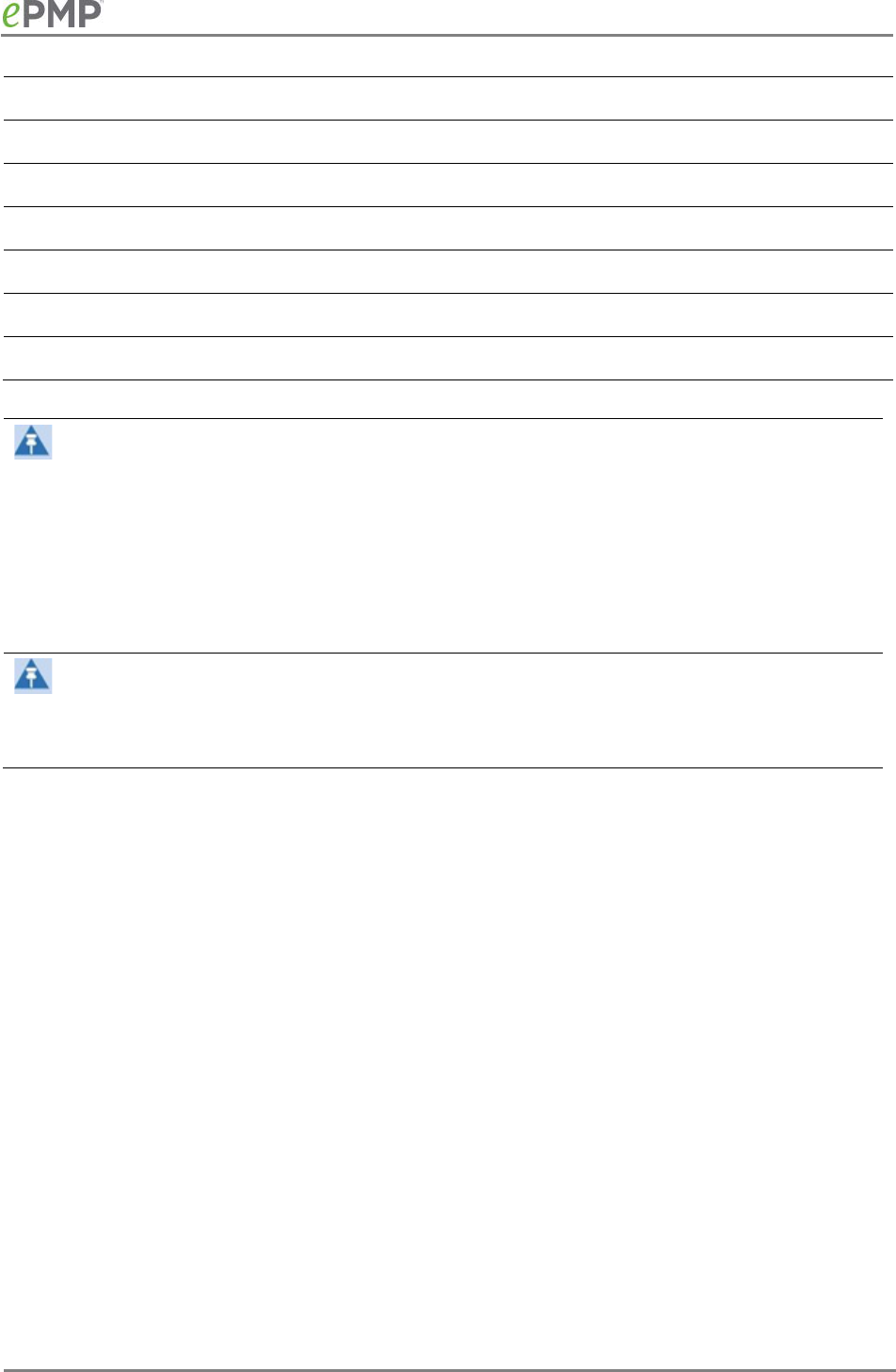
CAMBIUM NETWORKS
PTP 40 MHz Connectorized, 17 dBi Sector 0.158 50.1 10 0.25 0.5 39.5
PTP 20 MHz Connectorized, 19 dBi Panel 0.050 79.4 10 0.18 0.4 50.5
PTP 40 MHz Connectorized, 25 dBi Dish 0.010 316.2 10 0.16 0.4 63.5
PTP 20 MHz Integrated, 12 dBi Patch 0.050 15.8 10 0.08 0.2 63.2
PTP 40 MHz Connectorized, 17 dBi Sector 0.025 50.1 10 0.10 0.2 39.9
PTP 20 MHz Connectorized, 19 dBi Panel 0.020 79.4 10 0.11 0.3 71.3
PTP 40 MHz Connectorized, 25 dBi Dish 0.006 316.2 10 0.13 0.3 56.7
Note
Gain of antenna in dBi = 10*log(G).
The regulations require that the power used for the calculations is the maximum power in the
transmit burst subject to allowance for source-based time-averaging.
At 2.4 GHz, 5.4 GHz and EU 5.8 GHz, the products are generally limited to a fixed EIRP which can
be achieved with the Integrated Antenna. The calculations above assume that the maximum
EIRP allowed by the regulations is being transmitted.
Note
If there are no EIRP limits in the country of deployment, use the distance calculations for FCC 5.8
GHz for all frequency bands.
265

CAMBIUM NETWORKS
Compliance with radio regulations
This section describes how the ePMP complies with the radio regulations that are enforced in
various countries.
Caution
Changes or modifications not expressly approved by Cambium Networks could void the user’s
authority to operate the system.
TYPE APPROVALS
This system has achieved Type Approval in various countries around the world. This means that
the system has been tested against various local technical regulations and found to comply. The
frequency bands in which the system operates may be unlicensed and, in these bands, the system
can be used provided it does not cause interference. The system is not guaranteed protection
against interference from other products and installations.
Table 83
lists the radio specification type approvals that have been granted for ePMP frequency
variants.
Table 87
Radio certifications
Frequency band
Region
Regulatory approvals
2.4 GHz, 5 GHz USA FCC Part 15 Class B
Canada IC RSS-210 Issue 8, Annex 8 (or latest)
Europe ETSI EN302 502 v1.2.1
ETSI EN301 893 v1.7.1
FCC AND ETSI COMPLIANCE TESTING
The system has been tested for compliance to both US (FCC) and European (ETSI) specifications. It
has been shown to comply with the limits for emitted spurious radiation for a Class B digital
device, pursuant to Part 15 of the FCC Rules in the USA and appropriate European ENs. These
limits have been designed to provide reasonable protection against harmful interference. However
the equipment can radiate radio frequency energy and, if not installed and used in accordance with
the instructions, may cause harmful interference to other radio communications. There is no
guarantee that interference will not occur in a particular installation.
266

CAMBIUM NETWORKS
Note
A Class B Digital Device is a device that is marketed for use in a residential environment,
notwithstanding use in commercial, business and industrial environments.
Note
Notwithstanding that Cambium Networks has designed (and qualified) the ePMP products to
generally meet the Class B requirement to minimize the potential for interference, the ePMP
product range is not marketed for use in a residential environment.
EXAMPLES OF REGULATORY LIMITS
Examples of the regulatory limits that apply in typical regions of operation are in the following
tables:
•
Table 88
– 5.1 GHz
•
Table 89
– 5.2 GHz
•
Table 90
– 5.4 GHz
•
Table 91
– 5.8 GHz
•
Table 92
– 2.4 GHz
Table 88
Regulatory Limits - 5.1 GHz
Country
Frequency
range
Valid Center Frequency
for 20 MHz Band
Valid Center Frequency
for 40 MHz Band
Conducted
Power
Argentina 5150-5250 5160-5240 every 5 MHz 5170-5230 every 5 MHz 13
Ecuador 5150-5250 5160-5240 every 5 MHz 5170-5230 every 5 MHz 13
Malaysia 5150-5250 5160-5240 every 5 MHz 5170-5230 every 5 MHz 13
Peru 5150-5250 5160-5240 every 5 MHz 5170-5230 every 5 MHz 13
Philippines 5150-5250 5160-5240 every 5 MHz 5170-5230 every 5 MHz 13
Venezuela 5150-5250 5160-5240 every 5 MHz 5170-5230 every 5 MHz 13
Other 5150-5250 5160-5240 every 5 MHz 5170-5230 every 5 MHz 18
267

CAMBIUM NETWORKS
Table 89
Regulatory limits - 5.2 GHz
Country
Frequency
range
Valid Center
Frequency for
20 MHz Band
Valid Center
Frequency for
40 MHz Band
Conducted
Power
EIRP
Power
DFS
Argentina 5250-5350 5270 to 5330
every 5MHz
5280 to 5320
every 5MHz 13 Yes
Brazil
5250-5350
Canada 5250-5350 5280 to 5320
every 5MHz
5290 to 5310
every 5MHz
DIFF between
20MHz/40MHz
-> 12 for
20MHz, 13 for
40MHz
30 Yes
Chile 5250-5350 5270 to 5330
every 5MHz
5280 to 5320
every 5MHz 13 Yes
Colombia 5250-5350 5270 to 5330
every 5MHz
5280 to 5320
every 5MHz 13 Yes
Ecuador 5250-5350 5260 to 5340
every 5MHz
5270 to 5330
every 5MHz 13 No
Ghana 5250-5350 5270 to 5330
every 5MHz
5280 to 5320
every 5MHz 13 Yes
Guam 5250-5350 5280 to 5320
every 5MHz
5290 to 5310
every 5MHz
DIFF between
20MHz/40MHz
-> 12 for
20MHz, 13 for
40MHz
30 Yes
Hong
Kong 5250-5350 5270 to 5330
every 5MHz
5280 to 5320
every 5MHz 13 Yes
Kenya 5250-5350 5270 to 5330
every 5MHz
5280 to 5320
every 5MHz 13 Yes
Malaysia 5250-5350 5270 to 5330
every 5MHz
5280 to 5320
every 5MHz 13 Yes
Peru 5250-5350 5270 to 5330
every 5MHz
5280 to 5320
every 5MHz 13 Yes
Philippines 5250-5350 5270 to 5330
every 5MHz
5280 to 5320
every 5MHz 13 Yes
Puerto
Rico 5250-5350 5280 to 5320
every 5MHz
5290 to 5310
every 5MHz
DIFF between
20MHz/40MHz
-> 12 for
30 Yes
268

CAMBIUM NETWORKS
Country
Frequency
range
Valid Center
Frequency for
20 MHz Band
Valid Center
Frequency for
40 MHz Band
Conducted
Power
EIRP
Power
DFS
20MHz, 13 for
40MHz
Taiwan 5250-5350 5280 to 5320
every 5MHz
5290 to 5310
every 5MHz 13 Yes
Thailand 5250-5350 5270 to 5330
every 5MHz
5280 to 5320
every 5MHz 13 Yes
U.S. Virgin
Islands 5250-5350 5280 to 5320
every 5MHz
5290 to 5310
every 5MHz
DIFF between
20MHz/40MHz
-> 12 for
20MHz, 13 for
40MHz
30 Yes
Uganda 5250-5350 5270 to 5330
every 5MHz
5280 to 5320
every 5MHz 18 Yes
United
States 5250-5350 5280 to 5320
every 5MHz
5290 to 5310
every 5MHz
DIFF between
20MHz/40MHz
-> 12 for
20MHz, 13 for
40MHz
30 Yes
Venezuela 5250-5350 5260 to 5340
every 5MHz
5270 to 5330
every 5MHz 13 No
Other 5250-5350 5260 to 5340
every 5MHz
5270 to 5330
every 5MHz 18 No
269

CAMBIUM NETWORKS
Table 90
Regulatory limits - 5.4 GHz
Country
Frequency
ranges
Valid Center
Frequency for
20 MHz Band
Valid Center
Frequency for
40 MHz Band
Conducted
Power
EIRP
Power
DFS
Argentina 5470-5725 5480 to 5715
every 5MHz
5490 to 5705
every 5MHz
16
None
Australia
5470-
5600,5650-
5725
5485 to 5590
every 5MHz,
5660 to 5710
every 5 MHz
5495 to 5580
every 5MHz,
5670 to 5700
every 5 MHz
15 30 ETSI
Austria
5470-
5600,5650-
5725
5480 to 5590
every 5MHz,
5660 to 5715
every 5 MHz
5490 to 5580
every 5MHz,
5670 to 5705
every 5 MHz
15 30 ETSI
Belgium
5470-
5600,5650-
5725
5480 to 5590
every 5MHz,
5660 to 5715
every 5 MHz
5490 to 5580
every 5MHz,
5670 to 5705
every 5 MHz
15 30 ETSI
Bosnia and
Herzegovina
5470-
5600,5650-
5725
5480 to 5590
every 5MHz,
5660 to 5715
every 5 MHz
5490 to 5580
every 5MHz,
5670 to 5705
every 5 MHz
15 30 ETSI
Brazil 5470-5725 5480 to 5715
every 5MHz
5490 to 5705
every 5MHz
16 30 FCC
Bulgaria
5470-
5600,5650-
5725
5480 to 5590
every 5MHz,
5660 to 5715
every 5 MHz
5490 to 5580
every 5MHz,
5670 to 5705
every 5 MHz
15 30 ETSI
Canada
5470-
5600,5650-
5725 (*1)
5495 to 5590
every 5MHz,
5660 to 5705
every 5 MHz
5510 to 5580
every 5MHz,
5670 to 5695
every 5 MHz
13 30 FCC
Chile 5470-5725 5480 to 5715
every 5MHz
5490 to 5705
every 5MHz 16 30 FCC
Colombia 5470-5725 5480 to 5715
every 5MHz
5490 to 5705
every 5MHz
16 30 FCC
Croatia
5470-
5600,5650-
5725
5480 to 5590
every 5MHz,
5660 to 5715
every 5 MHz
5490 to 5580
every 5MHz,
5670 to 5705
every 5 MHz
15 30 ETSI
Cyprus
5470-
5600,5650-
5725
5480 to 5590
every 5MHz,
5660 to 5715
every 5 MHz
5490 to 5580
every 5MHz,
5670 to 5705
every 5 MHz
15 30 ETSI
Czech
Republic
5470-
5600,5650-
5725
5480 to 5590
every 5MHz,
5660 to 5715
every 5 MHz
5490 to 5580
every 5MHz,
5670 to 5705
every 5 MHz
15 30 ETSI
270

CAMBIUM NETWORKS
Country
Frequency
ranges
Valid Center
Frequency for
20 MHz Band
Valid Center
Frequency for
40 MHz Band
Conducted
Power
EIRP
Power
DFS
Denmark
5470-
5600,5650-
5725
5480 to 5590
every 5MHz,
5660 to 5715
every 5 MHz
5490 to 5580
every 5MHz,
5670 to 5705
every 5 MHz
15 30 ETSI
Ecuador 5470-5725 5480 to 5715
every 5MHz
5490 to 5705
every 5MHz 16 30 None
Finland
5470-
5600,5650-
5725
5480 to 5590
every 5MHz,
5660 to 5715
every 5 MHz
5490 to 5580
every 5MHz,
5670 to 5705
every 5 MHz
15 30 ETSI
France
5470-
5600,5650-
5725
5480 to 5590
every 5MHz,
5660 to 5715
every 5 MHz
5490 to 5580
every 5MHz,
5670 to 5705
every 5 MHz
15 30 ETSI
Germany
5470-
5600,5650-
5725
5480 to 5590
every 5MHz,
5660 to 5715
every 5 MHz
5490 to 5580
every 5MHz,
5670 to 5705
every 5 MHz
15 30 ETSI
Ghana 5470-5725 5480 to 5715
every 5MHz
5490 to 5705
every 5MHz 16 30 FCC
Greece
5470-
5600,5650-
5725
5480 to 5590
every 5MHz,
5660 to 5715
every 5 MHz
5490 to 5580
every 5MHz,
5670 to 5705
every 5 MHz
15 30 ETSI
Guam
5470-
5600,5650-
5725
5495 to 5590
every 5MHz,
5660 to 5705
every 5 MHz
5510 to 5580
every 5MHz,
5670 to 5695
every 5 MHz
(5.47GHz
to 5.55
GHz is 10)
(5.55GHz
to 5.725
GHz is 13)
30 FCC
Hong Kong 5470-5725
5480 to 5715
every 5MHz
5490 to 5705
every 5MHz 15 30 FCC
Hungary
5470-
5600,5650-
5725
5480 to 5590
every 5MHz,
5660 to 5715
every 5 MHz
5490 to 5580
every 5MHz,
5670 to 5705
every 5 MHz
15 30 ETSI
Ireland
5470-
5600,5650-
5725
5480 to 5590
every 5MHz,
5660 to 5715
every 5 MHz
5490 to 5580
every 5MHz,
5670 to 5705
every 5 MHz
15 30 ETSI
Italy
5470-
5600,5650-
5725
5480 to 5590
every 5MHz,
5660 to 5715
every 5 MHz
5490 to 5580
every 5MHz,
5670 to 5705
every 5 MHz
15 30 ETSI
Kenya 5470-5725 5480 to 5715
every 5MHz
5490 to 5705
every 5MHz 16 30 FCC
271

CAMBIUM NETWORKS
Country
Frequency
ranges
Valid Center
Frequency for
20 MHz Band
Valid Center
Frequency for
40 MHz Band
Conducted
Power
EIRP
Power
DFS
Latvia
5470-
5600,5650-
5725
5480 to 5590
every 5MHz,
5660 to 5715
every 5 MHz
5490 to 5580
every 5MHz,
5670 to 5705
every 5 MHz
15 30 ETSI
Liechtenstein
5470-
5600,5650-
5725
5480 to 5590
every 5MHz,
5660 to 5715
every 5 MHz
5490 to 5580
every 5MHz,
5670 to 5705
every 5 MHz
15 30 ETSI
Lithuania
5470-
5600,5650-
5725
5480 to 5590
every 5MHz,
5660 to 5715
every 5 MHz
5490 to 5580
every 5MHz,
5670 to 5705
every 5 MHz
15 30 ETSI
Luxembourg
5470-
5600,5650-
5725
5480 to 5590
every 5MHz,
5660 to 5715
every 5 MHz
5490 to 5580
every 5MHz,
5670 to 5705
every 5 MHz
15 30 ETSI
Macedonia
5470-
5600,5650-
5725
5480 to 5590
every 5MHz,
5660 to 5715
every 5 MHz
5490 to 5580
every 5MHz,
5670 to 5705
every 5 MHz
15 30 ETSI
Malaysia 5470-5725
5480 to 5715
every 5MHz
5490 to 5705
every 5MHz 16
Malta
5470-
5600,5650-
5725
5480 to 5590
every 5MHz,
5660 to 5715
every 5 MHz
5490 to 5580
every 5MHz,
5670 to 5705
every 5 MHz
15 30 ETSI
Mauritius 5470-5725 5480 to 5715
every 5MHz
5490 to 5705
every 5MHz
15 30 ETSI
Mexico
5470-
5600,5650-
5725
5495 to 5590
every 5MHz,
5660 to 5705
every 5 MHz
5510 to 5580
every 5MHz,
5670 to 5695
every 5 MHz
16 30 FCC
Netherlands
5470-
5600,5650-
5725
5480 to 5590
every 5MHz,
5660 to 5715
every 5 MHz
5490 to 5580
every 5MHz,
5670 to 5705
every 5 MHz
15 30 ETSI
Netherlands
Antilles
5470-
5600,5650-
5725
5480 to 5590
every 5MHz,
5660 to 5715
every 5 MHz
5490 to 5580
every 5MHz,
5670 to 5705
every 5 MHz
15 30 ETSI
Nigeria 5470-5725 5480 to 5715
every 5MHz
5490 to 5705
every 5MHz 15 36
Norway
5470-
5600,5650-
5725
5480 to 5590
every 5MHz,
5660 to 5715
every 5 MHz
5490 to 5580
every 5MHz,
5670 to 5705
every 5 MHz
15 30 ETSI
272

CAMBIUM NETWORKS
Country
Frequency
ranges
Valid Center
Frequency for
20 MHz Band
Valid Center
Frequency for
40 MHz Band
Conducted
Power
EIRP
Power
DFS
Oman 5470-5725 5480 to 5715
every 5MHz
5490 to 5705
every 5MHz 15 30 ETSI
Peru 5470-5725 5480 to 5715
every 5MHz
5490 to 5705
every 5MHz
16 30 ETSI
Philippines 5470-5725 5480 to 5715
every 5MHz
5490 to 5705
every 5MHz 16 26
Poland
5470-
5600,5650-
5725
5480 to 5590
every 5MHz,
5660 to 5715
every 5 MHz
5490 to 5580
every 5MHz,
5670 to 5705
every 5 MHz
15 30 ETSI
Portugal
5470-
5600,5650-
5725
5480 to 5590
every 5MHz,
5660 to 5715
every 5 MHz
5490 to 5580
every 5MHz,
5670 to 5705
every 5 MHz
15 30 ETSI
Puerto Rico
5470-
5600,5650-
5725
5495 to 5590
every 5MHz,
5660 to 5705
every 5 MHz
5510 to 5580
every 5MHz,
5670 to 5695
every 5 MHz
(5.47GHz
to 5.55
GHz is 10)
(5.55GHz
to 5.725
GHz is 13)
30 FCC
Romania
5470-
5600,5650-
5725
5480 to 5590
every 5MHz,
5660 to 5715
every 5 MHz
5490 to 5580
every 5MHz,
5670 to 5705
every 5 MHz
15 30 ETSI
Serbia
5470-
5600,5650-
5725
5480 to 5590
every 5MHz,
5660 to 5715
every 5 MHz
5490 to 5580
every 5MHz,
5670 to 5705
every 5 MHz
15 30 ETSI
Slovakia
5470-
5600,5650-
5725
5480 to 5590
every 5MHz,
5660 to 5715
every 5 MHz
5490 to 5580
every 5MHz,
5670 to 5705
every 5 MHz
15 30 ETSI
Slovenia
5470-
5600,5650-
5725
5480 to 5590
every 5MHz,
5660 to 5715
every 5 MHz
5490 to 5580
every 5MHz,
5670 to 5705
every 5 MHz
15 30 ETSI
South Africa 5470-5725 5480 to 5715
every 5MHz
5490 to 5705
every 5MHz 15 30 FCC
South Korea 5470-5650 5480 to 5640
every 5MHz
5490 to 5630
every 5MHz 16 30 ETSI
Spain
5470-
5600,5650-
5725
5480 to 5590
every 5MHz,
5660 to 5715
every 5 MHz
5490 to 5580
every 5MHz,
5670 to 5705
every 5 MHz
15 30 ETSI
273

CAMBIUM NETWORKS
Country
Frequency
ranges
Valid Center
Frequency for
20 MHz Band
Valid Center
Frequency for
40 MHz Band
Conducted
Power
EIRP
Power
DFS
Sweden
5470-
5600,5650-
5725
5480 to 5590
every 5MHz,
5660 to 5715
every 5 MHz
5490 to 5580
every 5MHz,
5670 to 5705
every 5 MHz
15 30 ETSI
Switzerland
5470-
5600,5650-
5725
5480 to 5590
every 5MHz,
5660 to 5715
every 5 MHz
5490 to 5580
every 5MHz,
5670 to 5705
every 5 MHz
15 30 ETSI
Taiwan
5470-
5600,5650-
5725
5495 to 5590
every 5MHz,
5660 to 5705
every 5 MHz
5510 to 5580
every 5MHz,
5670 to 5695
every 5 MHz
13 30 FCC
Thailand 5470-5725
5480 to 5715
every 5MHz
5490 to 5705
every 5MHz 16 30 FCC
Turkey 5470-5725 5485 to 5710
every 5MHz
5495 to 5700
every 5MHz 15 30 ETSI
U.S. Virgin
Islands
5470-
5600,5650-
5725
5495 to 5590
every 5MHz,
5660 to 5705
every 5 MHz
5510 to 5580
every 5MHz,
5670 to 5695
every 5 MHz
(5.47GHz
to 5.55
GHz is 10)
(5.55GHz
to 5.725
GHz is 13)
30 FCC
Uganda 5470-5725 5480 to 5715
every 5MHz
5490 to 5705
every 5MHz 19 30 FCC
United
Kingdom
5470-
5600,5650-
5725 (*1)
5480 to 5590
every 5MHz,
5660 to 5715
every 5 MHz
5490 to 5580
every 5MHz,
5670 to 5705
every 5 MHz
15 30 ETSI
United
States
5470-
5600,5650-
5725
5495 to 5590
every 5MHz,
5660 to 5705
every 5 MHz
5510 to 5580
every 5MHz,
5670 to 5695
every 5 MHz
(5.47GHz
to 5.55
GHz is 10)
(5.55GHz
to 5.725
GHz is 13)
30 FCC
Venezuela 5470-5725
5480 to 5715
every 5MHz
5490 to 5705
every 5MHz 16 30 None
Vietnam
Other 5470-5725 5480 to 5715
every 5MHz
5490 to 5705
every 5MHz 19 None
Follow AP
CC 5470-5725 5480 to 5715
every 5MHz
5490 to 5705
every 5MHz 16 None
Generic ETSI
5470-
5600,5650-
5725
5480 to 5590
every 5MHz,
5660 to 5715
every 5 MHz
5490 to 5580
every 5MHz,
5670 to 5705
every 5 MHz
15 30 ETSI
(*1) The band 5600 MHz to 5650 MHz is reserved for the use of weather radars.
274

CAMBIUM NETWORKS
Table 91
Regulatory limits - 5.8 GHz
Country
Frequency
ranges
Valid Center
Frequency for
20 MHz Band
Valid Center
Frequency
for 40 MHz
Band
Conducted
Power
EIRP Power
DFS
Argentina 5725-5825 5735 to 5815
every 5 MHz
5745 to 5805
every 5 MHz
23
None
Australia 5725-5850 5740 to 5835
every 5 MHz
5750 to 5825
every 5 MHz
23 36 None
Bahrain 5725-5850 5735 to 5840
every 5 MHz
5745 to 5830
every 5 MHz
23 33 ETSI
Botswana 5725-5875 5735 to 5865
every 5 MHz
5745 to 5855
every 5 MHz
23 40
Brazil 5725-5850 5740 to 5835
every 5 MHz
5750 to 5825
every 5 MHz 23
PMP AP is
36. Other
device/mode
has no limit
None
Canada 5725-5850 5740 to 5835
every 5 MHz
5750 to 5825
every 5 MHz 23
PMP AP is
36. Other
device/mode
has no limit
None
Chile 5725-5850
5735 to 5840
every 5 MHz
5745 to 5830
every 5 MHz 23 36 None
China 5725-5850
5740 to 5835
every 5 MHz
5750 to 5825
every 5 MHz 23 33 None
Colombia 5725-5825
5735 to 5815
every 5 MHz
5745 to 5805
every 5 MHz 23 53 None
Denmark (*1)
5725-
5795,5815-
5875
5735 to 5785
every 5 MHz,
5825 to 5865
every 5 MHz
5745 to 5775
every 5 MHz,
5835 to 5855
every 5 MHz
23 36 ETSI
Ecuador 5725-5850 5735 to 5840
every 5 MHz
5745 to 5830
every 5 MHz 23 53 None
Finland
5725-
5795,5815-
5850
5735 to 5785
every 5 MHz,
5825 to 5840
every 5 MHz
5745 to 5775
every 5 MHz,
23 36 ETSI
Germany 5755-5875
5765 to 5865
every 5 MHz
5775 to 5855
every 5 MHz 23 36 ETSI
Ghana 5725-5825
5740 to 5810
every 5 MHz
5750 to 5800
every 5 MHz 23 36 FCC
Greece 5725-5795
5735 to 5785
every 5 MHz
5745 to 5775
every 5 MHz 23 36 ETSI
Guam 5725-5850 5740 to 5835
every 5 MHz
5750 to 5825
every 5 MHz 23
PMP AP is
36. Other
device/mode
has no limit
None
Hong Kong 5725-5850 5740 to 5835
every 5 MHz
5750 to 5825
every 5 MHz 23 36 None
275

CAMBIUM NETWORKS
Country
Frequency
ranges
Valid Center
Frequency for
20 MHz Band
Valid Center
Frequency
for 40 MHz
Band
Conducted
Power
EIRP Power
DFS
Iceland 5725-5875 5735 to 5865
every 5 MHz
5745 to 5855
every 5 MHz 23 36 ETSI
India 5825-5875 5840 to 5860
every 5 MHz
5850 to 5850
every 5 MHz
23 36 None
Indonesia 5725-5825 5735 to 5815
every 5 MHz
5745 to 5805
every 5 MHz
23 36 None
Ireland 5725-5875 5740 to 5860
every 5 MHz
5750 to 5850
every 5 MHz 23 33 None
Kenya 5725-5850 5735 to 5840
every 5 MHz
5745 to 5830
every 5 MHz
23 36 None
Liechtenstein
5725-
5795,5815-
5875
5735 to 5785
every 5 MHz,
5825 to 5865
every 5 MHz
5745 to 5775
every 5 MHz,
5835 to 5855
every 5 MHz
23 36 ETSI
Malaysia 5725-5875
5740 to 5860
every 5 MHz
5750 to 5850
every 5 MHz 23 30 None
Mauritius 5725-5850 5735 to 5840
every 5 MHz
5745 to 5830
every 5 MHz 23 36 ETSI
Mexico 5725-5850
5740 to 5835
every 5 MHz
5750 to 5825
every 5 MHz 23 36 None
New Zealand 5725-5825
5740 to 5810
every 5 MHz
5750 to 5800
every 5 MHz 23 53
Nigeria 5725-5850 5740 to 5835
every 5 MHz
5750 to 5825
every 5 MHz 23 ETSI
Norway (*1)
5725-
5795,5815-
5850
5735 to 5785
every 5 MHz,
5825 to 5840
every 5 MHz
5745 to 5775
every 5 MHz,
23 53 ETSI
Oman 5725-5850 5735 to 5840
every 5 MHz
5745 to 5830
every 5 MHz 23 33 ETSI
Peru 5725-5850 5735 to 5840
every 5 MHz
5745 to 5830
every 5 MHz
23 36 None
Philippines 5725-5825 5740 to 5810
every 5 MHz
5750 to 5800
every 5 MHz 23 30
Portugal 5725-5875 5735 to 5865
every 5 MHz
5745 to 5855
every 5 MHz 23 36 ETSI
Puerto Rico 5725-5850 5740 to 5835
every 5 MHz
5750 to 5825
every 5 MHz 23
PMP AP is
36. Other
device/mode
has no limit
None
Serbia 5725-5875 5735 to 5865
every 5 MHz
5745 to 5855
every 5 MHz 23 36 ETSI
Seychelles 5725-5850 5740 to 5835
every 5 MHz
5750 to 5825
every 5 MHz 23 53 ETSI
276

CAMBIUM NETWORKS
Country
Frequency
ranges
Valid Center
Frequency for
20 MHz Band
Valid Center
Frequency
for 40 MHz
Band
Conducted
Power
EIRP Power
DFS
Singapore 5725-5850 5740 to 5835
every 5 MHz
5750 to 5825
every 5 MHz 23 30 ETSI
South Africa 5725-5850 5735 to 5840
every 5 MHz
5745 to 5830
every 5 MHz 23 53
South Korea 5725-5825 5740 to 5810
every 5 MHz
5750 to 5800
every 5 MHz 23 30
Spain (*1)
5725-
5795,5815-
5855
5735 to 5785
every 5 MHz,
5825 to 5845
every 5 MHz
5745 to 5775
every 5 MHz,
5835 to 5835
every 5 MHz
23 36 ETSI
Switzerland
5725-
5795,5815-
5875
5735 to 5785
every 5 MHz,
5825 to 5865
every 5 MHz
5745 to 5775
every 5 MHz,
5835 to 5855
every 5 MHz
23 36 ETSI
Taiwan 5725-5850 5740 to 5835
every 5 MHz
5750 to 5825
every 5 MHz 23
PMP AP is
36. Other
device/mode
has no limit
None
Thailand 5725-5850 5740 to 5835
every 5 MHz
5750 to 5825
every 5 MHz 23 30 None
U.S. Virgin
Islands 5725-5850 5740 to 5835
every 5 MHz
5750 to 5825
every 5 MHz 23
PMP AP is
36. Other
device/mode
has no limit
None
Uganda 5725-5825 5735 to 5815
every 5 MHz
5745 to 5805
every 5 MHz 23 32+2*Ag/3
United
Kingdom (*1)
5725-
5795,5815-
5850
5735 to 5785
every 5 MHz,
5825 to 5840
every 5 MHz
5745 to 5775
every 5 MHz, 23 36 ETSI
United States 5725-5850 5740 to 5835
every 5 MHz
5750 to 5825
every 5 MHz 23
PMP AP is
36. Other
device/mode
has no limit
None
Venezuela 5725-5850 5735 to 5840
every 5 MHz
5745 to 5830
every 5 MHz 23 36 None
Vietnam 5725-5850 5735 to 5840
every 5 MHz
5745 to 5830
every 5 MHz 23 30 None
Other 5725-5875 5735 to 5865
every 5 MHz
5745 to 5855
every 5 MHz
23 None
Follow AP CC 5725-5875 5735 to 5865
every 5 MHz
5745 to 5855
every 5 MHz 23 None
(*1) 5795 MHz to 5815 MHz band is assigned for Road Transport and Traffic Telematics (RTTT).
277

CAMBIUM NETWORKS
Table 92
Regulatory limits - 2.4 GHz
Country
Frequency
range
Valid Center Frequency
for 20 MHz Band
Valid Center Frequency
for 40 MHz Band
Conducted
Power
Argentina 2400-2500 2412-2462 every 5MHz 2422-2452 every 5MHz 27
Canada 2400-2500 2412-2462 every 5MHz 2427-2452 every 5MHz 27
Ecuador 2400-2500 2412-2462 every 5MHz 2422-2452 every 5MHz 27
Malaysia 2400-2500 2412-2462 every 5MHz 2422-2452 every 5MHz 27
Peru 2400-2500 2412-2462 every 5MHz 2422-2452 every 5MHz 27
Philippines 2400-2500 2412-2462 every 5MHz 2422-2452 every 5MHz 27
United
States 2400-2500 2412-2462 every 5MHz 2427-2452 every 5MHz 27
Venezuela 2400-2500 2412-2462 every 5MHz 2422-2452 every 5MHz 27
Other 2400-2500 2412-2462 every 5MHz 2422-2452 every 5MHz 27
278

CAMBIUM NETWORKS
Notifications
This section contains notifications of compliance with the radio regulations that are enforced in
various regions.
2.4 GHZ, 5.4 GHZ REGULATORY COMPLIANCE
The ePMP complies with the regulations that are enforced in the USA, Canada and Europe. The
relevant notifications are specified in this section.
2.4 GHz, 5.4 GHz FCC and IC notification
U.S. Federal Communication Commission (FCC) and Industry Canada (IC) Notification.
This device complies with part 15.407 of the US FCC Rules and Regulations and with RSS-210
Issue 8 of Industry Canada. Operation is subject to the following two conditions: (1) This device
may not cause harmful interference, and (2) This device must accept any interference received,
including interference that may cause undesired operation. In Canada, users must be cautioned to
take note that high power radars are allocated as primary users (meaning they have priority) of
5250 – 5350 MHz and 5470 – 5725 MHz and these radars could cause interference and/or damage to
license-exempt local area networks (LELAN).
For the connectorized version of the product and in order to reduce potential radio interference to
other users, the antenna type and its gain must be so chosen that the equivalent isotropically
radiated power (EIRP) is not more than that permitted by the regulations. The transmitted power
must be reduced to achieve this requirement.
This equipment has been tested and found to comply with the limits for a Class B digital device,
pursuant to Part 15 of the US FCC Rules and with RSS-210 of Industry Canada. These limits are
designed to provide reasonable protection against harmful interference in a residential installation.
This equipment generates, uses, and can radiate radio-frequency energy and, if not installed and
used in accordance with these instructions, may cause harmful interference to radio
communications. If this equipment does cause harmful interference to radio or television
reception, which can be determined by turning the equipment on and off, the user is encouraged
to correct the interference by one or more of the following measures:
• Increase the separation between the affected equipment and the unit;
• Connect the affected equipment to a power outlet on a different circuit from that which the
receiver is connected to;
• Consult the dealer and/or experienced radio/TV technician for help.
FCC IDs and Industry Canada Certification Numbers are reproduced on the product label (
Figure 56
and
Figure 57
).
279
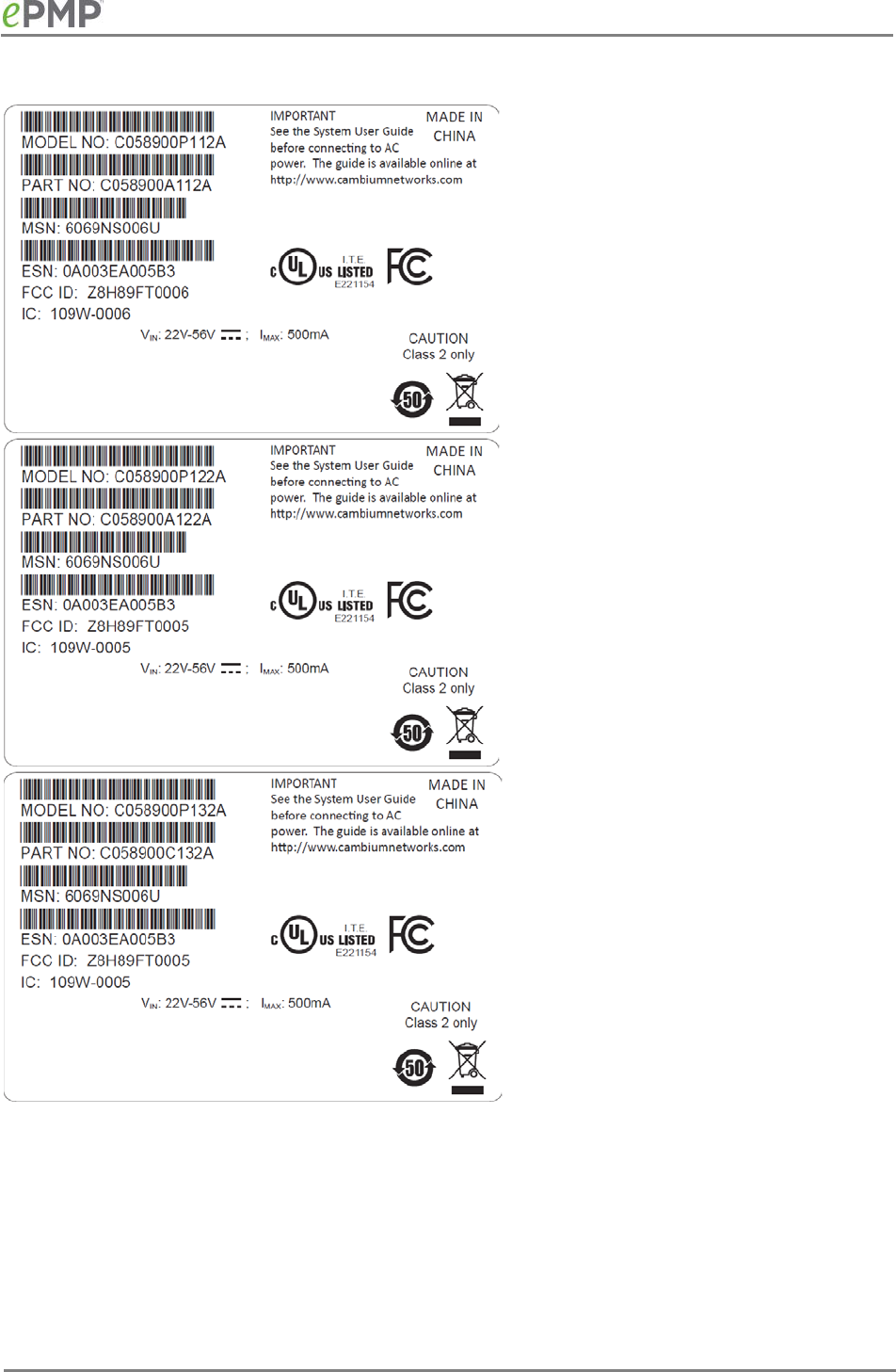
CAMBIUM NETWORKS
Figure 56
FCC and IC certifications on 5 GHz product labels
280
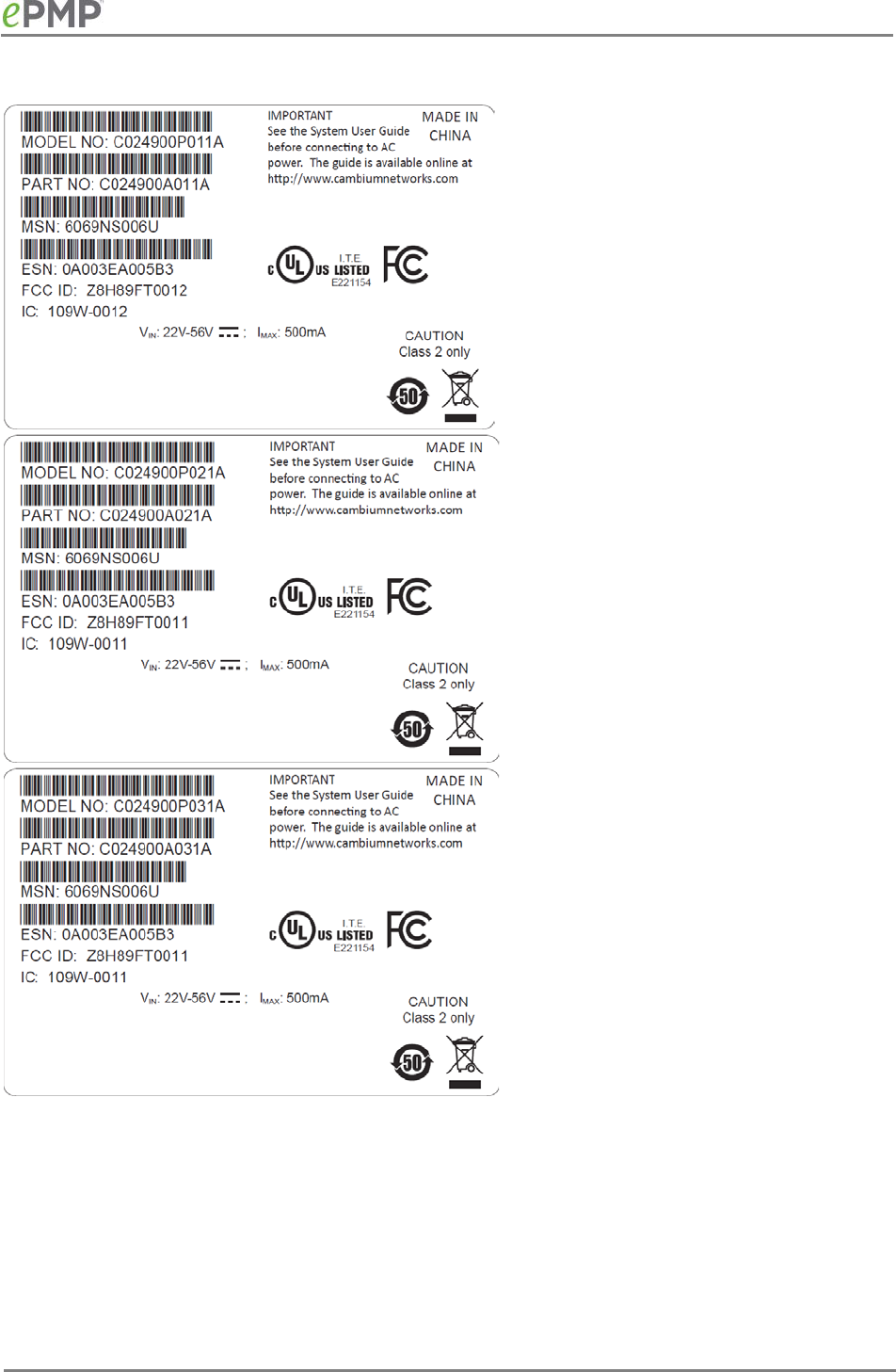
CAMBIUM NETWORKS
Figure 57
FCC and IC certifications on 2.4 GHz product labels
Where necessary, the end user is responsible for obtaining any National licenses required to
operate this product and these must be obtained before using the product in any particular
country. Contact the appropriate national administrations for details on the conditions of use for
the bands in question and any exceptions that might apply.
281
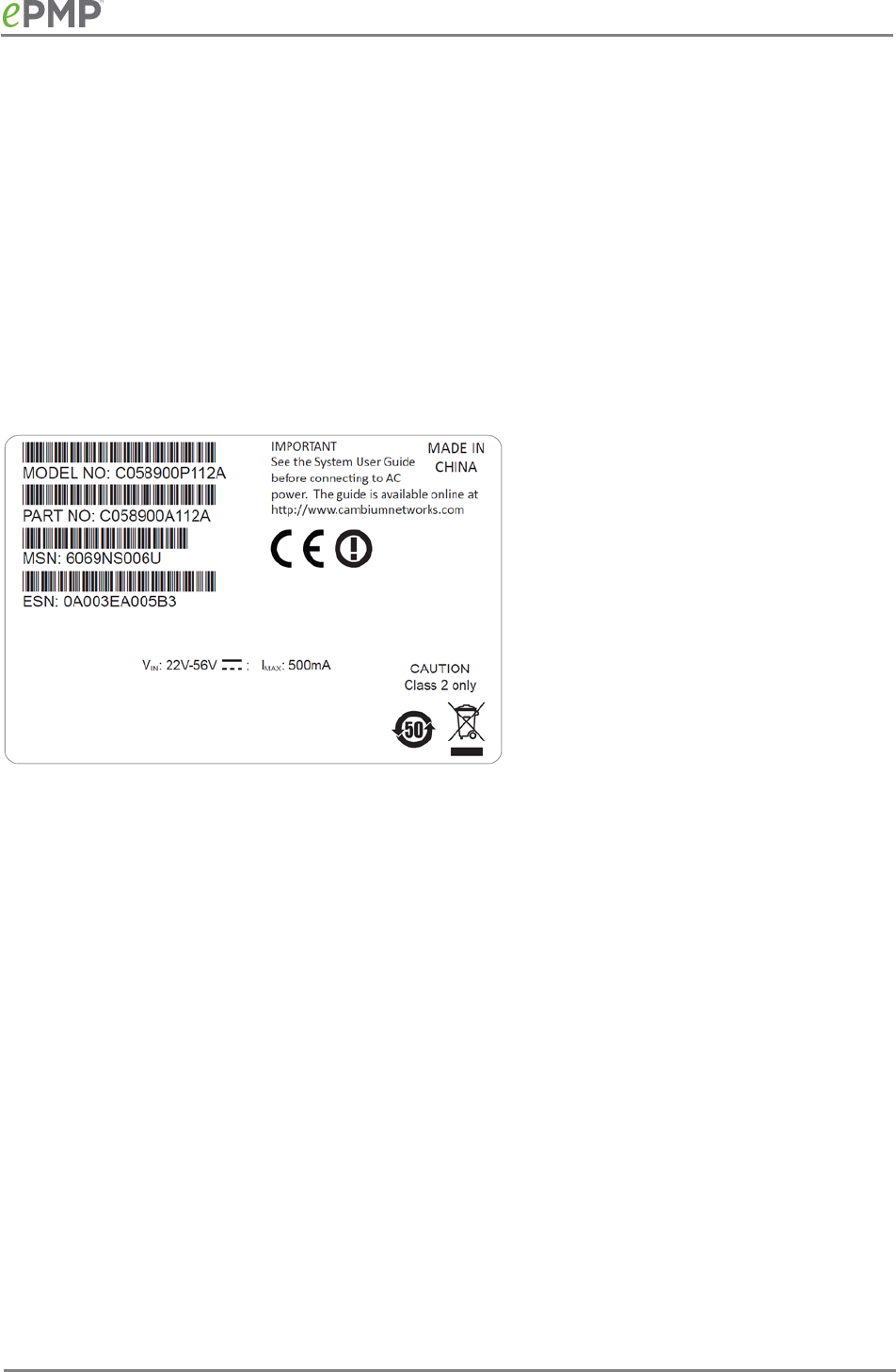
CAMBIUM NETWORKS
5.4 GHz European Union notification
The ePMP product is a two-way radio transceiver suitable for use in Broadband Wireless Access
System (WAS), Radio Local Area Network (RLAN), or Fixed Wireless Access (FWA) systems. It is a
Class 1 device and uses operating frequencies that are harmonized throughout the EU member
states. The operator is responsible for obtaining any national licenses required to operate this
product and these must be obtained before using the product in any particular country.
Hereby, Cambium Networks declares that the ePMP product complies with the essential
requirements and other relevant provisions of Directive 1999/5/EC. The declaration of conformity
may be consulted at the support website.
The European R&TTE directive 1999/5/EC Certification Number is reproduced on the product label
(
Figure 58
).
Figure 58
European Union certification on 5.4 GHz product label
5.8 GHZ REGULATORY COMPLIANCE
This system has achieved Type Approval in various countries around the world. This means that
the system has been tested against various local technical regulations and found to comply. The
frequency band in which the system operates is “license exempt” and the system is allowed to be
used provided it does not cause interference. The licensing authority does not guaranteed
protection against interference from other products and installations.
For the connectorized version of the product and in order to reduce potential radio interference to
other users, the antenna type and its gain should be so chosen that the Effective Isotropically
Radiated Power (EIRP) is not more than that permitted for successful communication.
U.S. Federal Communication Commission (FCC)
This device complies with part 15 of the US FCC Rules. Operation is subject to the following two
conditions: (1) This device may not cause harmful interference, and (2) This device must accept
any interference received, including interference that may cause undesired operation.
282

CAMBIUM NETWORKS
This equipment has been tested and found to comply with the limits for a Class B digital device,
pursuant to Part 15 of the US FCC Rules. These limits are designed to provide reasonable
protection against harmful interference in a residential installation. This equipment generates,
uses, and can radiate radio-frequency energy and, if not installed and used in accordance with
these instructions, may cause harmful interference to radio communications. If this equipment
does cause harmful interference to radio or television reception, which can be determined by
turning the equipment on and off, the user is encouraged to correct the interference by one or
more of the following measures:
• Increase the separation between the affected equipment and the unit;
• Connect the affected equipment to a power outlet on a different circuit from that which the
receiver is connected to;
• Consult the dealer and/or experienced radio/TV technician for help.
Industry Canada (IC)
This Class B digital apparatus complies with Canadian ICES-003.
Cet appareil numérique de la classe B conforme á la norme NMB-003 du Canada.
RSS-GEN issue 3 (7.1.3) Licence-Exempt Radio Apparatus:
This device complies with Industry Canada license-exempt RSS standard(s). Operation is
subject to the following two conditions: (1) this device may not cause interference, and (2) this
device must accept any interference, including interference that may cause undesired
operation of the device.
Le présent appareil est conforme aux CNR d'Industrie Canada applicables aux appareils radio
exempts de licence. L'exploitation est autorisée aux deux conditions suivantes : (1) l'appareil
ne doit pas produire de brouillage, et (2) l'utilisateur de l'appareil doit accepter tout brouillage
radioélectrique subi, même si le brouillage est susceptible d'en compromettre le
fonctionnement.
In Canada, high power radars are allocated as primary users (meaning they have priority) of the
5650 – 5850 MHz spectrum. These radars could cause interference or damage to license-exempt
local area network (LE-LAN) devices.
Product labels
FCC IDs and Industry Canada Certification Numbers are reproduced on the product label (
Figure
59
).
283
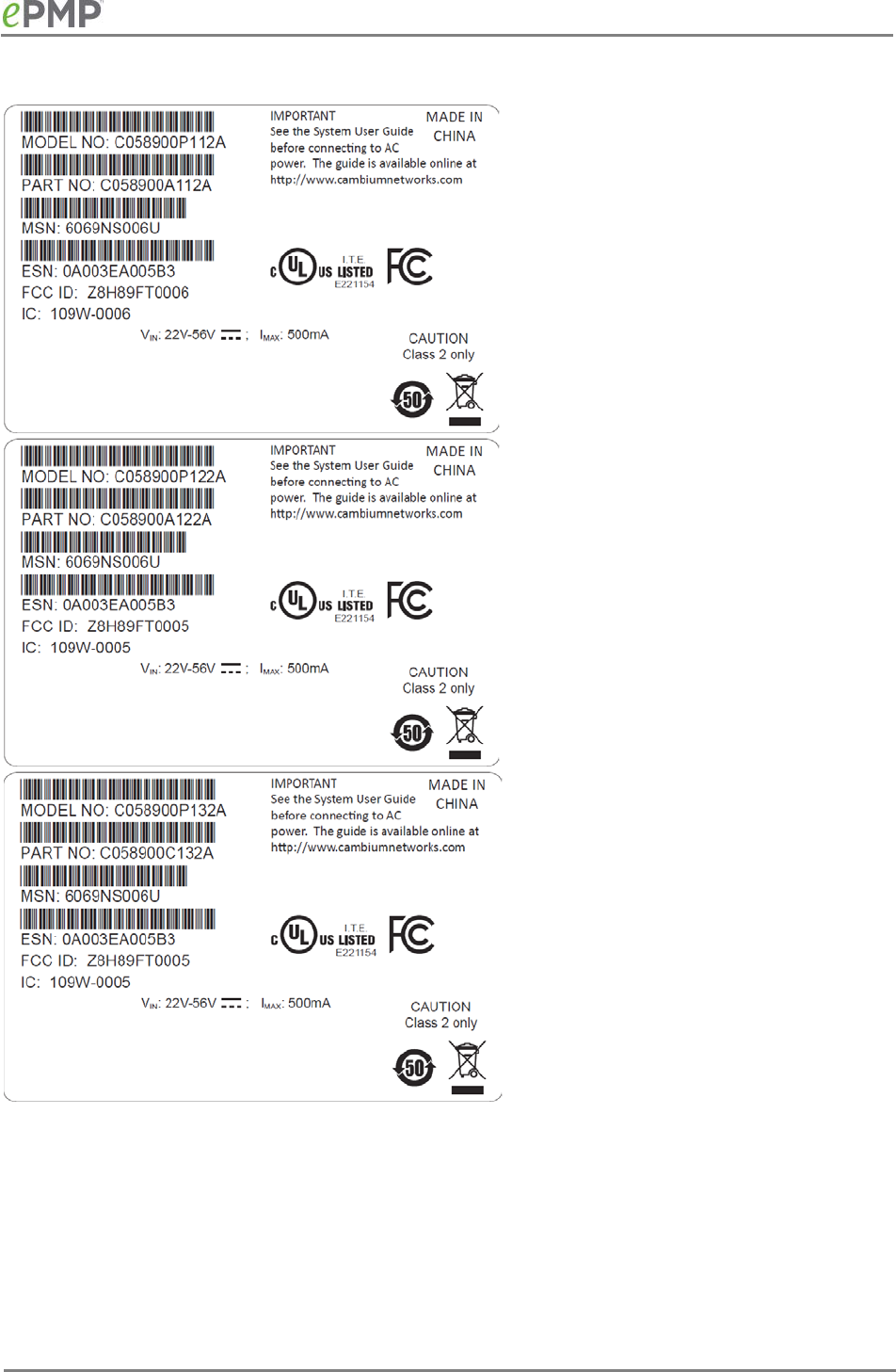
CAMBIUM NETWORKS
Figure 59
FCC and IC certifications on 5.8 GHz product label
Where necessary, the end user is responsible for obtaining any National licenses required to
operate this product and these must be obtained before using the product in any particular
country. Contact the appropriate national administrations for details on the conditions of use for
the bands in question and any exceptions that might apply.
284
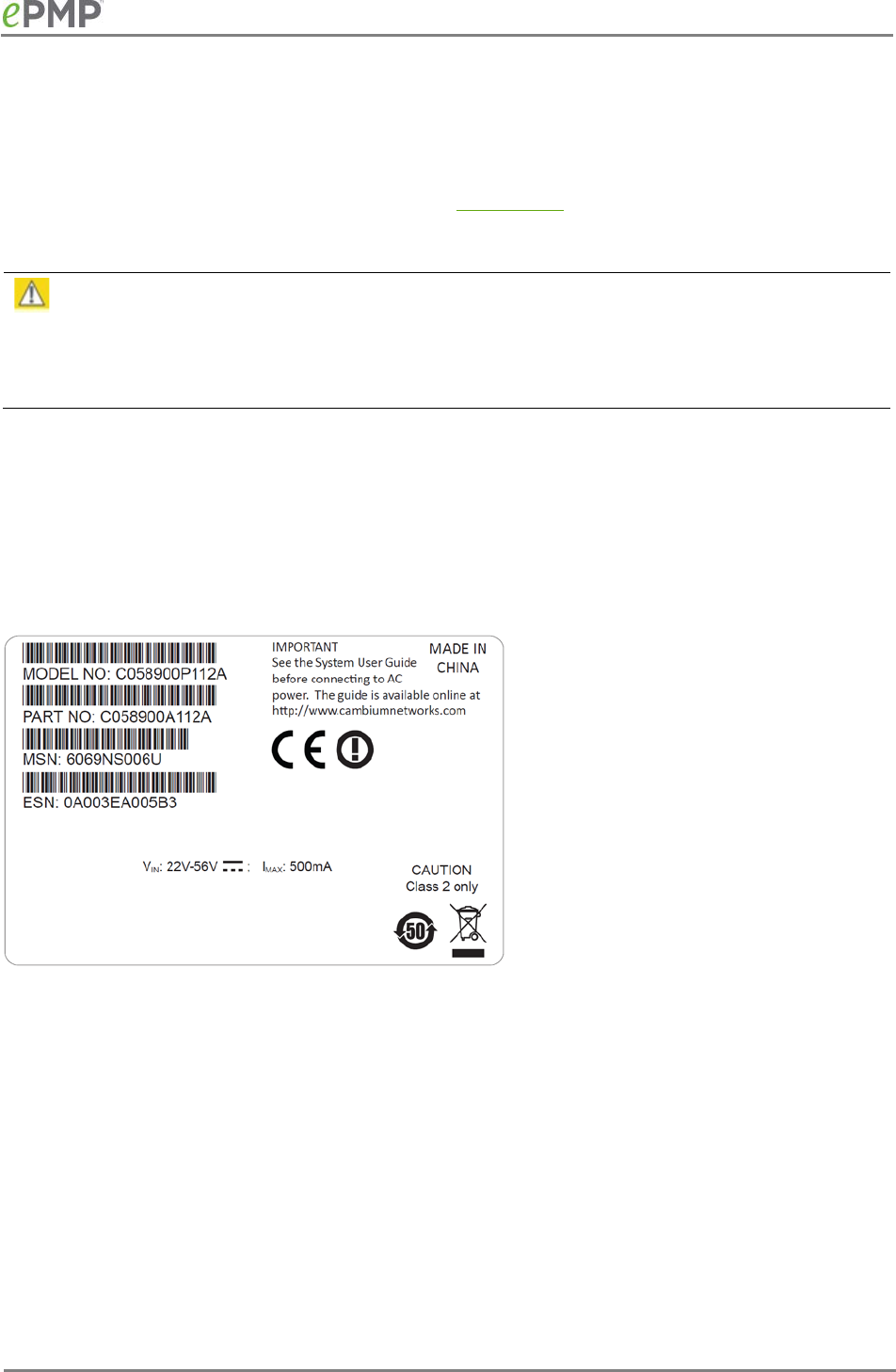
CAMBIUM NETWORKS
5.8 GHz European Union notification
The ePMP is a Class 2 device as it operates on frequencies that are not harmonized across the
EU. Currently the product may only be operated in the UK, Eire (IRL), Germany, Norway and
Denmark. However, the regulatory situation in Europe is changing and the radio spectrum may
become available in other countries in future. See www.ero.dk for further information. The
operator is responsible for obtaining any national licenses required to operate this product and
these must be obtained before using the product in any particular country.
Caution
This equipment operates as a secondary application, so it has no rights against harmful
interference, even if generated by similar equipment, and must not cause harmful interference
on systems operating as primary applications.
Hereby, Cambium Networks declares that the ePMP product complies with the essential
requirements and other relevant provisions of Directive 1999/5/EC. The declaration of conformity
may be consulted at the support website.
The European R&TTE directive 1999/5/EC Certification Number is reproduced on the product label
(
Figure 60
).
Figure 60
European Union certification on 5.8 GHz product label
5.8 GHz operation in the UK
The ePMP connectorized product has been notified for operation in the UK, and when operated in
accordance with instructions for use it is compliant with UK Interface Requirement IR2007. For UK
use, installations must conform to the requirements of IR2007 in terms of EIRP spectral density
against elevation profile above the local horizon in order to protect Fixed Satellite Services. The
frequency range 5795-5815 MHz is assigned to Road Transport & Traffic Telematics (RTTT) in the
U.K. and shall not be used by FWA systems in order to protect RTTT devices. UK Interface
Requirement IR2007 specifies that radiolocation services shall be protected by a Dynamic
Frequency Selection (DFS) mechanism to prevent co-channel operation in the presence of radar
signals.
285

CAMBIUM NETWORKS
THAILAND NOTIFICATION
This telecommunication equipment conforms to the requirements of the National
Telecommunications Commission.
286

CAMBIUM NETWORKS
Data throughput tables
This section contains tables to support calculation of the data rate capacity that can be provided by
ePMP configurations, as follows:
•
Data throughput capacity
on page
287
DATA THROUGHPUT CAPACITY
Table 93
shows the data throughput rates (Mbits/s) achieved with an AP/STA pair and the link
distance (range), is 0 km.
Table 93
Throughput for ePMP
MCS
Spatial
Streams
Mod.
Type
Coding
Rate
20 MHz
40 MHz
DL
UL
Both
DL
UL
Both
MCS15 2 64-QAM 5/6 90.64 28.33 118.97 187.83 55.23 243.06
MCS14 2 64-QAM 3/4 72.93 22.02 94.95 174.46 50.23 224.69
MCS13 2 64-QAM 2/3 53.15 13.52 66.67 151.41 46.54 197.95
MCS12 2 16-QAM 3/4 36.46 10.91 47.37 107.07 29.88 136.95
MCS11 2 16-QAM 1/2 27.57 8.6 37.17 56.66 15.48 72.14
MCS10 2 QPSK 3/4 21.96 7.57 29.53 38 11.67 49.67
MCS9 2 QPSK 1/2 9.31 3.18 12.49 19.06 5.93 24.99
MCS1 1 QPSK 1/2 8.39 2.42 10.81 18.63 5.72 24.35
At zero range. All rates are in Mbit/s. UDP 1518-byte packets, 75%DL/25%UL duty cycle
287
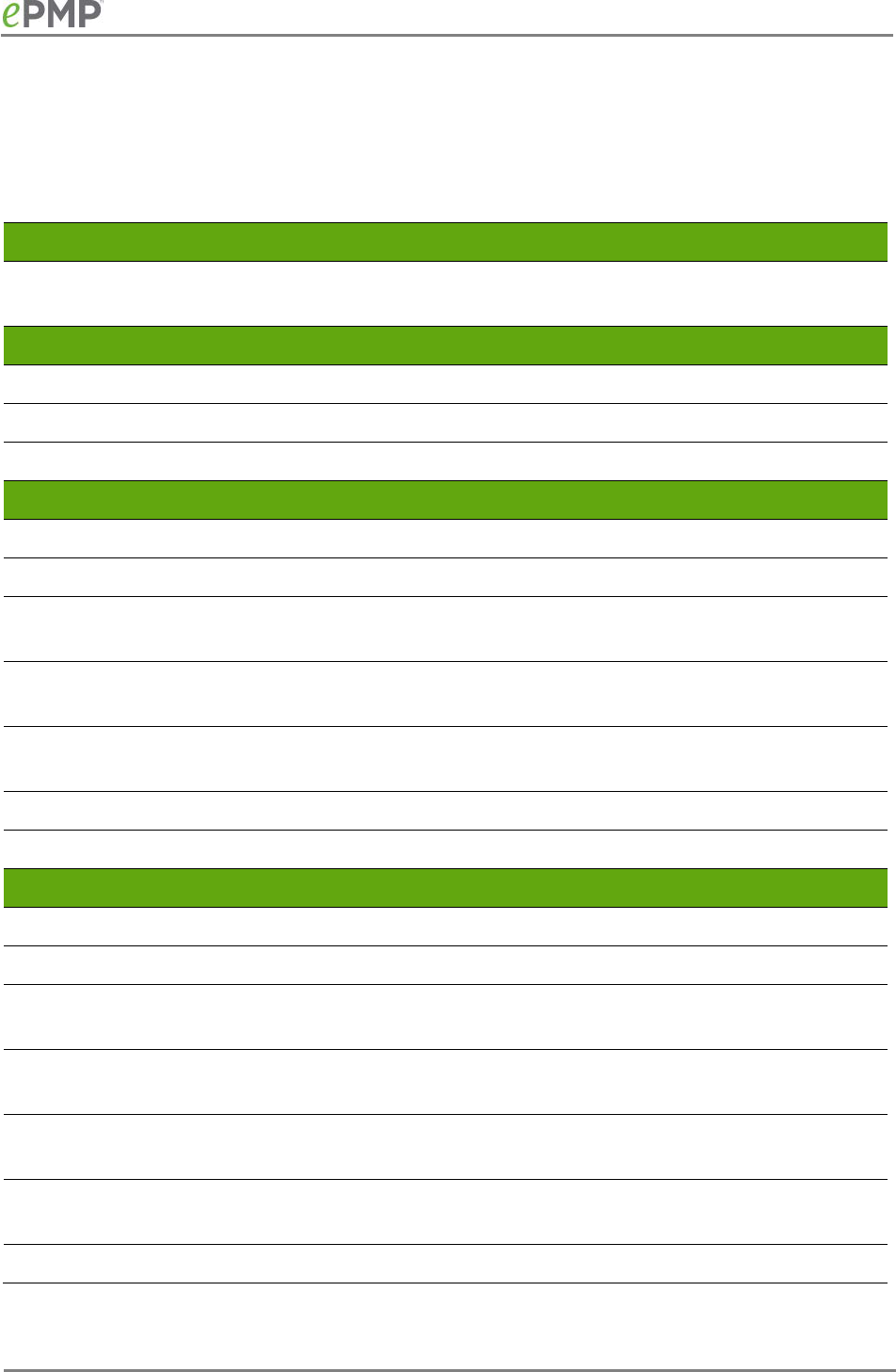
CAMBIUM NETWORKS
Radio Specifications
CONNECTORIZED RADIO SPECIFICATIONS
Table 94
Connectorized
Radio specifications, 5 GHz
Product
SALES MODEL NUMBERS C058900A112A (US/FCC ), C050900A013A (EU),
C050900A011A (ROW)
Spectrum
CHANNEL SPACING Configurable on 5 MHz increments
FREQUENCY RANGE 5150 - 5875 MHz
CHANNEL WIDTH 20 MHz or 40 MHz
Interface
MAC (MEDIA ACCESS CONTROL) LAYER Cambium Proprietary
PHYSICAL LAYER 2x2 MIMO/OFDM
ETHERNET INTERFACE 100/1000BaseT, rate auto negotiated (802.3af
compliant)
POWERING METHODS SUPPORTED 30V PoE Supply (included), CMM3 & CMM4,
802.3af PoE Supply
PROTOCOLS USED IPv4, UDP, TCP, IP, ICMP, SSH, SNMPv2c,
HTTP, HTTPs, FTP
NETWORK MANAGEMENT HTTP, HTTPs, SSH, FTP, SNMPv2c
VLAN 802.1Q with 802.1p priority
Performance
SUBSCRIBERS PER SECTOR Up to 120
ARQ Yes
NOMINAL RECEIVE SENSITIVITY (W/ FEC) @
20MHZ CHANNEL
MCS1 = -89 dBm to MCS15 = -68 dBm (per
branch)
NOMINAL RECEIVE SENSITIVITY (W/ FEC) @
40MHZ CHANNEL
MCS1 = -87 dBm to MCS15 = -65 dBm (per
branch)
MAXIMUM DEPLOYMENT RANGE @ 20 MHz
CHANNEL
Up to 13 miles
MAXIMUM DEPLOYMENT RANGE @ 40 MHz
CHANNEL
Up to 9 miles
MODULATION LEVELS (ADAPTIVE) MCS1 (QPSK 1/2) to MCS15 (64QAM 5/6)
288

CAMBIUM NETWORKS
LATENCY (nominal, roundtrip) 17 ms
GPS SYNCHRONIZATION Yes, via Internal GPS, CMM3, or CMM4
QUALITY OF SERVICE Three level priority (Voice, High, Low) with
packet classification by DSCP, COS, VLAN ID, IP
& MAC Addr,
Link Budget
ANTENNA Options Antennas for 90° or 120° sectors are available
TRANSMIT POWER RANGE -20 to +30 dBm (combined, to regional EIRP
limit) (1 dB interval)
ANTENNA GAIN 15 dBi (90° sector)
MAXIMUM TRANSMIT POWER 30 dBm combined (5.8 GHz Band)
Physical
ANTENNA CONNECTION 50 Ω
, RP (Rev
SURGE SUPPRESSION 1 Joule Integrated
ENVIRONMENTAL IP55
TEMPERATURE -30°C to +55°C (-22°F to +131°F)
WEIGHT
4.5 kg (10 lbs) with antenna
0.52 kg (1.1 lbs) without antenna
WIND SURVIVAL 190 km/hour (118 mi/hour) with antenna
DIMENSIONS (H x W x D) Radio: 26.9 x 11 x 7.7 cm (10.6 x 4.3 x 3.0 in)
Antenna (excl brackets): 80.4 x 16 x 6.3 cm (31.7
x 6.3 x 2.5 in)
Security
ENCRYPTION 128-bit AES (CCMP mode)
Certifications
FCCID Z8H89FT0006
INDUSTRY CANADA CERT 109W-0006
CE EN 302 502 v1.2.1
EN 301 893 v1.7.1
289
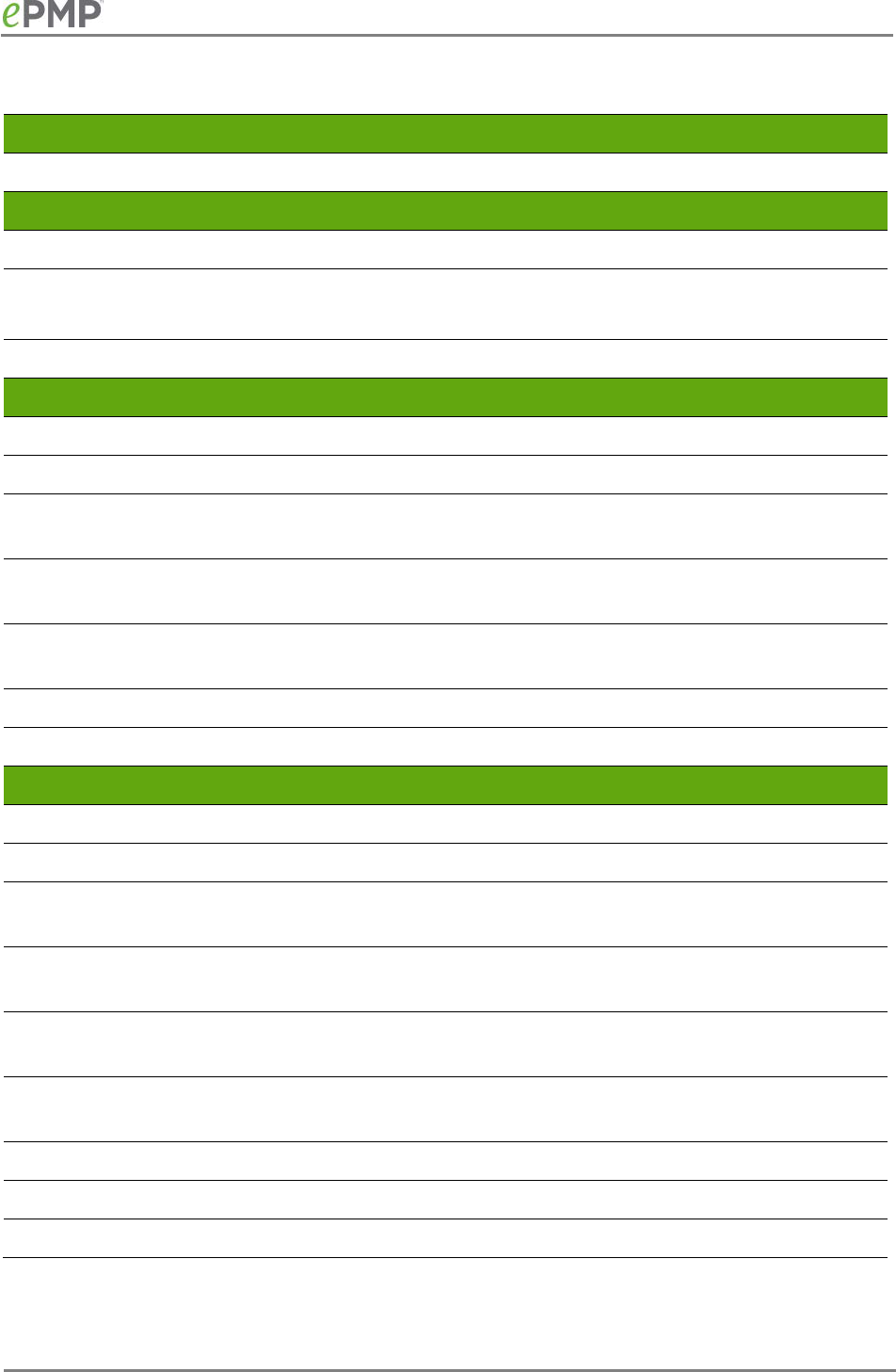
CAMBIUM NETWORKS
Table 95
Connectorized
Radio specifications, 2.4 GHz
Product
SALES MODEL NUMBERS C024900A011A
Spectrum
CHANNEL SPACING Configurable on 5 MHz increments
FREQUENCY RANGE 2402 - 2472 MHz (20 MHz)
2407 - 2472 MHz (40 MHz)
CHANNEL WIDTH 20 MHz or 40 MHz
Interface
MAC (MEDIA ACCESS CONTROL) LAYER Cambium Proprietary
PHYSICAL LAYER 2x2 MIMO/OFDM
ETHERNET INTERFACE 100/1000BaseT, rate auto negotiated (802.3af
compliant)
POWERING METHODS SUPPORTED 30V PoE Supply (included), CMM3 & CMM4,
802.3af PoE Supply
PROTOCOLS USED IPv4, UDP, TCP, IP, ICMP, SSH, SNMPv2c, HTTP,
HTTPs, FTP
NETWORK MANAGEMENT HTTP, HTTPs, SSH, FTP, SNMPv2c
VLAN 802.1Q with 802.1p priority
Performance
SUBSCRIBERS PER SECTOR Up to 120
ARQ Yes
NOMINAL RECEIVE SENSITIVITY (W/ FEC) @
20MHZ CHANNEL
MCS1 = -89 dBm to MCS15 = -68 dBm (per
branch)
NOMINAL RECEIVE SENSITIVITY (W/ FEC) @
40MHZ CHANNEL
MCS1 = -87 dBm to MCS15 = -65 dBm (per
branch)
MAXIMUM DEPLOYMENT RANGE @ 20 MHz
CHANNEL
Up to 13 miles
MAXIMUM DEPLOYMENT RANGE @ 40 MHz
CHANNEL
Up to 9 miles
MODULATION LEVELS (ADAPTIVE) MCS1 (QPSK 1/2) to MCS15 (64QAM 5/6)
LATENCY (nominal, roundtrip) 17 ms
GPS SYNCHRONIZATION Yes, via Internal GPS, CMM3, or CMM4
290
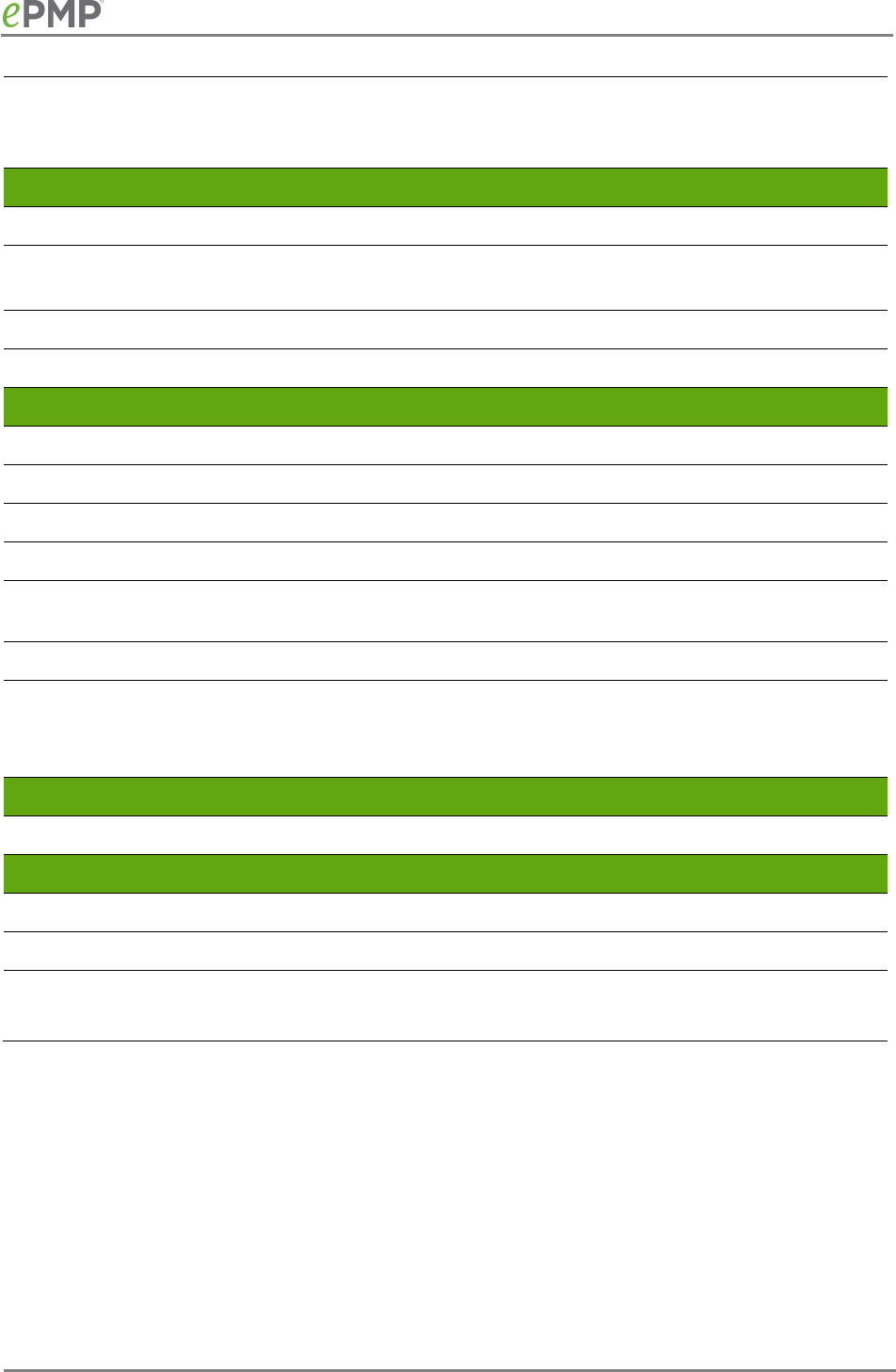
CAMBIUM NETWORKS
QUALITY OF SERVICE Three level priority (Voice, High, Low) with
packet classification by DSCP, COS, VLAN ID, IP
& MAC Addr,
Link Budget
ANTENNA Options Antennas for 90° or 120° sectors are available
TRANSMIT POWER RANGE -20 to +30 dBm (combined, to regional EIRP limit)
(1 dB interval)
ANTENNA GAIN 15 dBi (90° / 120° sector)
MAXIMUM TRANSMIT POWER 30 dBm combined
Physical
ANTENNA CONNECTION 50 Ω
, RP (Rev e
SURGE SUPPRESSION 1 Joule Integrated
ENVIRONMENTAL IP55
TEMPERATURE -30°C to +55°C (-22°F to +131°F)
WEIGHT
4.5 kg (10 lbs) with antenna
0.52 kg (1.1 lbs) without antenna
WIND SURVIVAL 190 km/hour (118 mi/hour) with antenna
DIMENSIONS (H x W x D) Radio: 26.9 x 11 x 7.7 cm (10.6 x 4.3 x 3.0 in)
Antenna (excl brackets): 80.4 x 16 x 6.3 cm (31.7
x 6.3 x 2.5 in)
Security
ENCRYPTION 128-bit AES (CCMP mode)
Certifications
FCCID Z8H89FT0006
INDUSTRY CANADA CERT 109W-0006
CE EN 302 502 v1.2.1
EN 301 893 v1.7.1
291
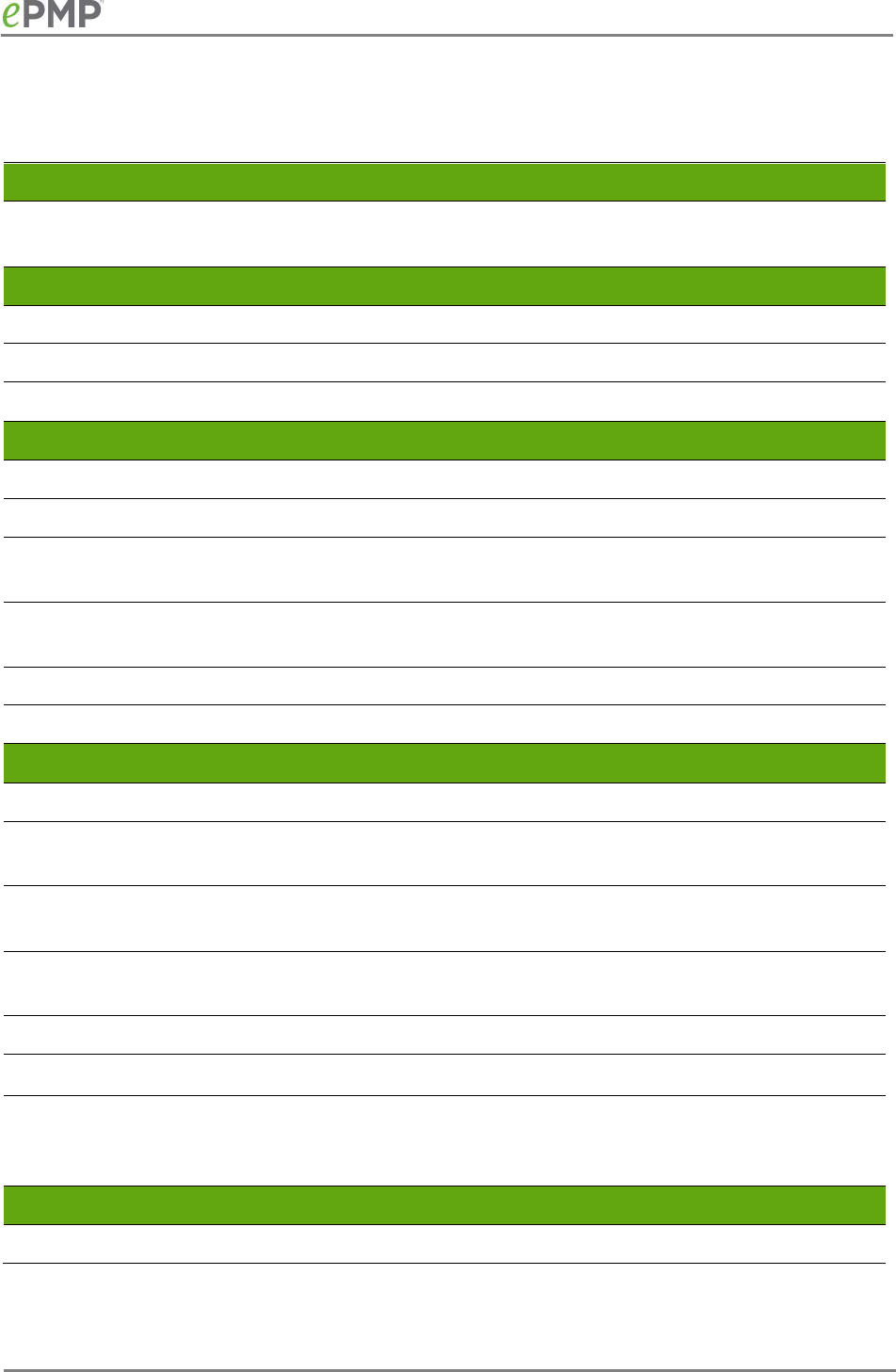
CAMBIUM NETWORKS
INTEGRATED RADIO SPECIFICATIONS
Table 96
Integrated Radio specifications, 5 GHz
Product
MODEL NUMBER C058900C132A (US/FCC ), C050900C033A (EU),
C050900C031A (ROW)
Spectrum
CHANNEL SPACING Configurable on 5 MHz increments
FREQUENCY RANGE 5150 - 5875 MHz
CHANNEL WIDTH 20 MHz or 40 MHz
Interface
MAC (MEDIA ACCESS CONTROL) LAYER Cambium Proprietary
PHYSICAL LAYER 2x2 MIMO/OFDM
ETHERNET INTERFACE 100BaseT, Cambium PoE (V+ = pins 7 & 8,
Return = pins 4 & 5)
PROTOCOLS USED IPv4, UDP, TCP, IP, ICMP, SSH, SNMPv2c,
HTTPs, FTP
NETWORK MANAGEMENT HTTPs, SSH, FTP, SNMPv2c
VLAN 802.1Q with 802.1p priority
Performance
ARQ Yes
NOMINAL RECEIVE SENSITIVITY (W/ FEC) @
20MHZ CHANNEL
MCS1 = -89 dBm to MCS15 = -70 dBm (per
branch)
NOMINAL RECEIVE SENSITIVITY (W/ FEC) @
40MHZ CHANNEL
MCS1 = -87 dBm to MCS15 = -65 dBm (per
branch)
MAXIMUM DEPLOYMENT RANGE @ 20 MHz
CHANNEL
Up to 13 miles
MODULATION LEVELS (ADAPTIVE) MCS1 (QPSK 1/2) to MCS15 (64QAM 5/6)
LATENCY (nominal, roundtrip) 17 ms
QUALITY OF SERVICE
Three level priority (Voice, High, Low) with
packet classification by DSCP, COS, VLAN ID, IP
& MAC Addr, Broadcast, Multicast and Station
Priority
Link Budget
ANTENNA BEAM WIDTH 24° azimuth, 12° elevation
292
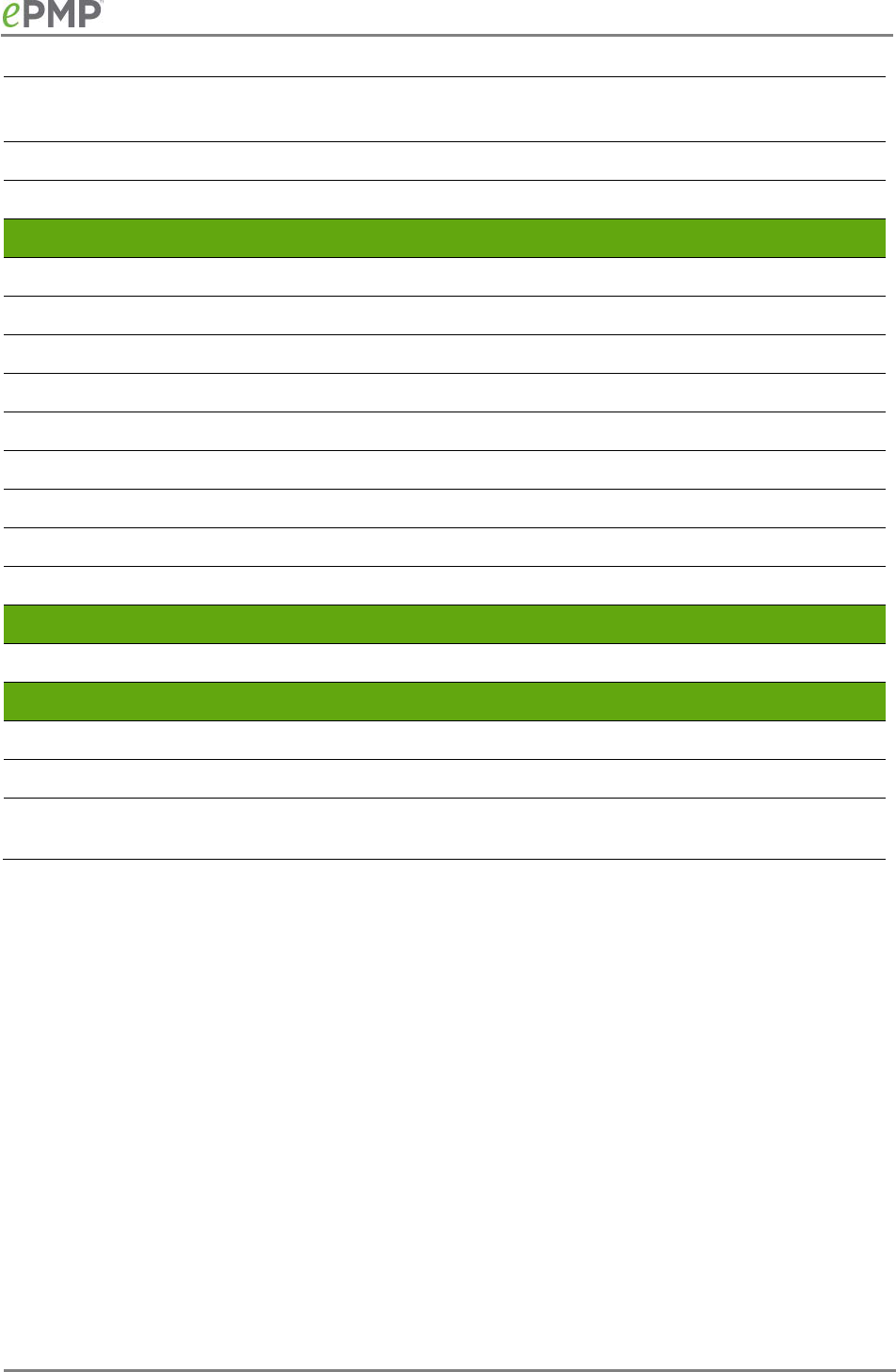
CAMBIUM NETWORKS
TRANSMIT POWER RANGE -20 to +30 dBm (combined, to regional EIRP
limit) (1 dB interval)
ANTENNA GAIN 13 dBi, integrated patch
MAXIMUM TRANSMIT POWER 30 dBm combined (5.8 GHz Band)
Physical
ANTENNA CONNECTION Integrated patch antenna
SURGE SUPPRESSION 1 Joule Integrated
ENVIRONMENTAL IP55
TEMPERATURE -30°C to +55°C (-22°F to +131°F)
WEIGHT 0.49 kg (1.1 lb.)
WIND SURVIVAL 145 km/hour (90 mi/hour) with antenna
DIMENSIONS (H x W x D) 29.1 x 14.5 x 8.3 cm (11.4 x 5.7 x 3.3 in)
POWER CONSUMPTION 7 W Maximum, 5 W Typical
INPUT VOLTAGE 24 to 30 V
Security
ENCRYPTION 128-bit AES (CCMP mode)
Certifications
FCCID Z8H89FT0006
INDUSTRY CANADA CERT 109W-0006
CE
EN 302 502 v1.2.1
EN 301 893 v1.7.1
293
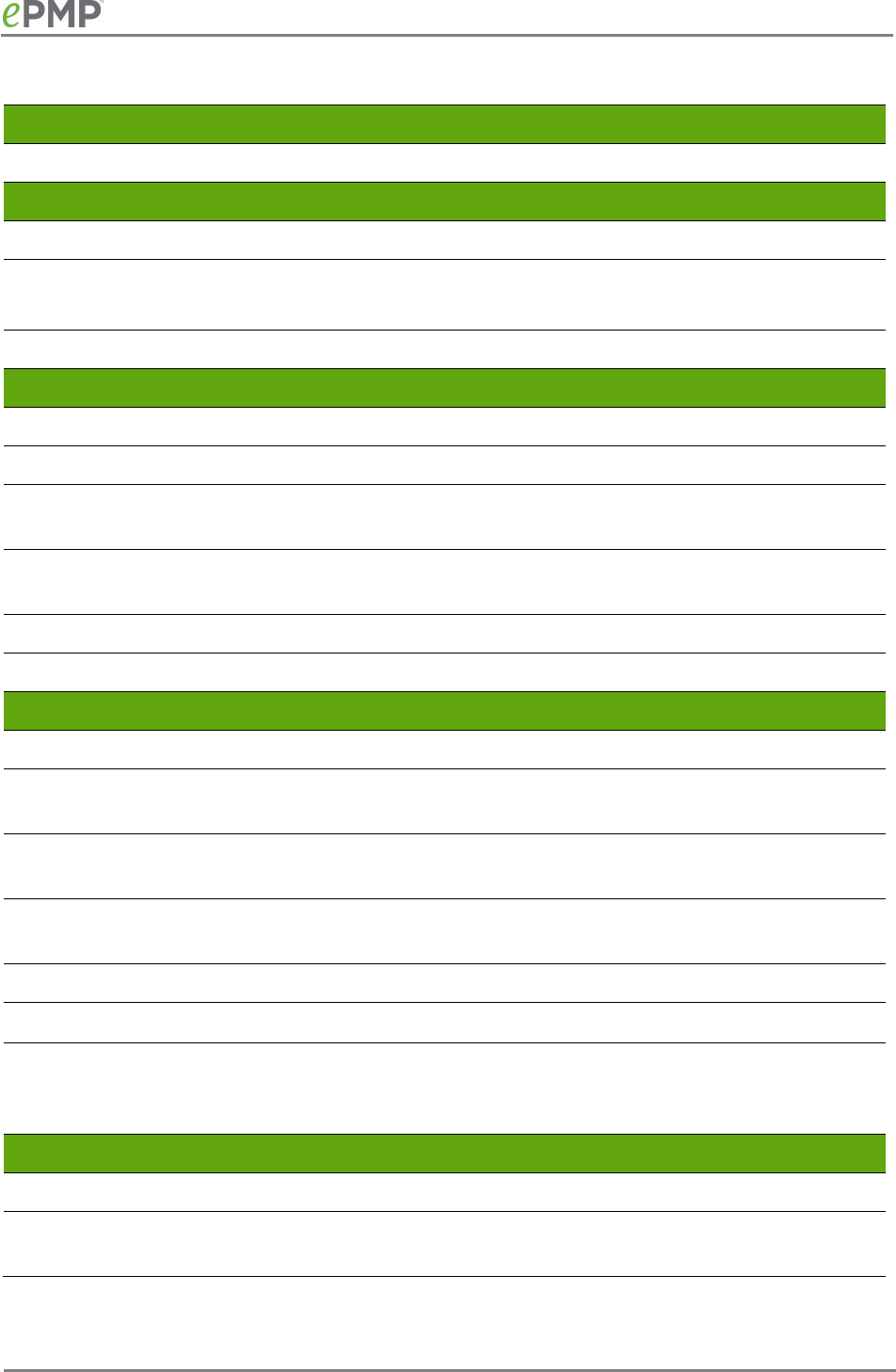
CAMBIUM NETWORKS
Table 97
Integrated Radio specifications, 2.4 GHz
Product
MODEL NUMBER C024900A031A
Spectrum
CHANNEL SPACING Configurable on 5 MHz increments
FREQUENCY RANGE 2402 - 2472 MHz (20 MHz)
2407 - 2472 MHz (40 MHz)
CHANNEL WIDTH 20 MHz or 40 MHz
Interface
MAC (MEDIA ACCESS CONTROL) LAYER Cambium Proprietary
PHYSICAL LAYER 2x2 MIMO/OFDM
ETHERNET INTERFACE 100BaseT, Cambium PoE (V+ = pins 7 & 8,
Return = pins 4 & 5)
PROTOCOLS USED IPv4, UDP, TCP, IP, ICMP, SSH, SNMPv2c,
HTTPs, FTP
NETWORK MANAGEMENT HTTPs, SSH, FTP, SNMPv2c
VLAN 802.1Q with 802.1p priority
Performance
ARQ Yes
NOMINAL RECEIVE SENSITIVITY (W/ FEC) @
20MHZ CHANNEL
MCS1 = -89 dBm to MCS15 = -70 dBm (per
branch)
NOMINAL RECEIVE SENSITIVITY (W/ FEC) @
40MHZ CHANNEL
MCS1 = -87 dBm to MCS15 = -65 dBm (per
branch)
MAXIMUM DEPLOYMENT RANGE @ 20 MHz
CHANNEL
Up to 13 miles
MODULATION LEVELS (ADAPTIVE) MCS1 (QPSK 1/2) to MCS15 (64QAM 5/6)
LATENCY (nominal, roundtrip) 17 ms
QUALITY OF SERVICE
Three level priority (Voice, High, Low) with
packet classification by DSCP, COS, VLAN ID, IP
& MAC Addr, Broadcast, Multicast and Station
Priority
Link Budget
ANTENNA BEAM WIDTH 24° azimuth, 12° elevation
TRANSMIT POWER RANGE -20 to +30 dBm (combined, to regional EIRP
limit) (1 dB interval)
294
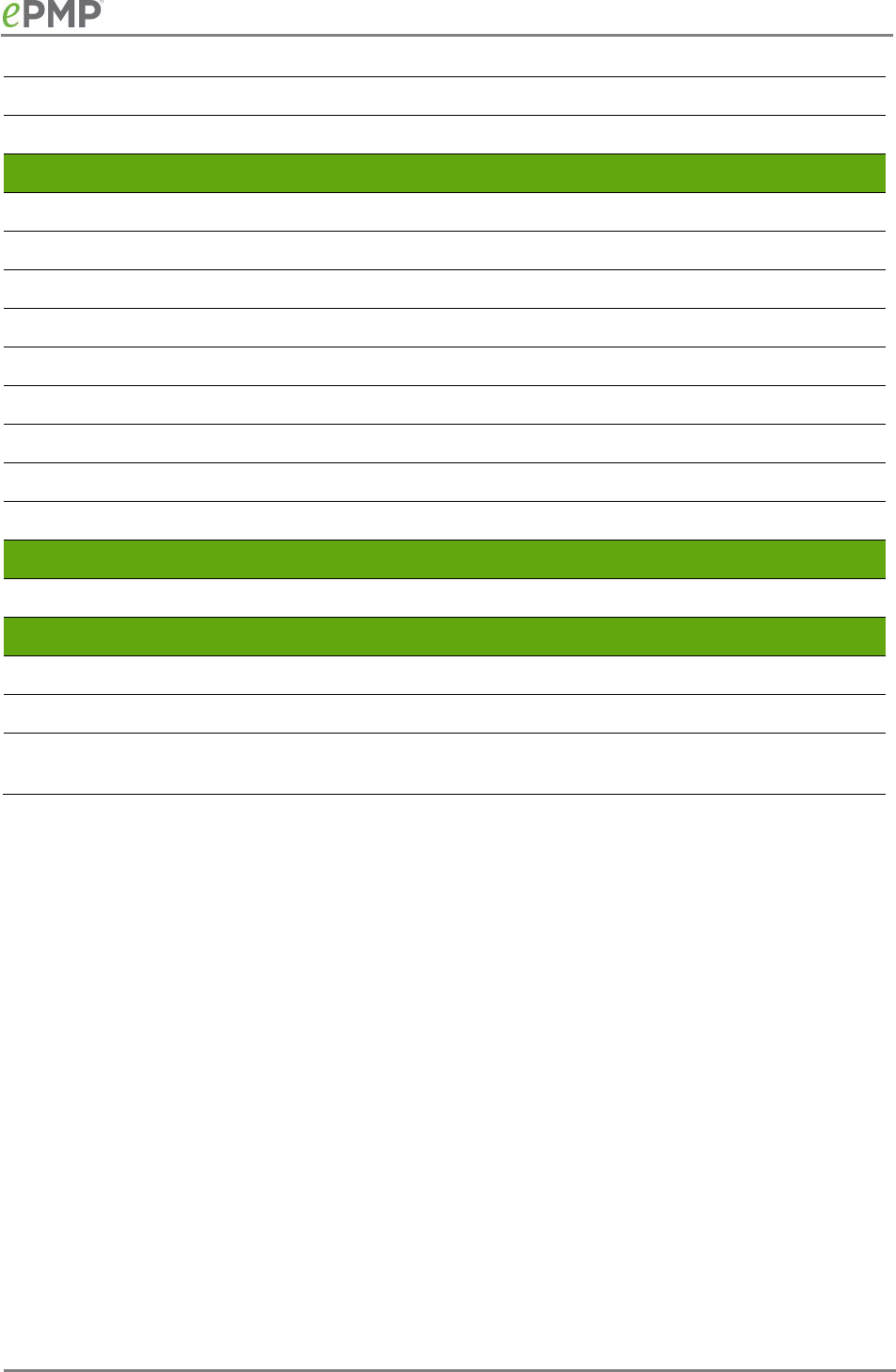
CAMBIUM NETWORKS
ANTENNA GAIN 12 dBi, integrated patch
MAXIMUM TRANSMIT POWER 30 dBm combined
Physical
ANTENNA CONNECTION Integrated patch antenna
SURGE SUPPRESSION 1 Joule Integrated
ENVIRONMENTAL IP55
TEMPERATURE -30°C to +55°C (-22°F to +131°F)
WEIGHT 0.49 kg (1.1 lb.)
WIND SURVIVAL 145 km/hour (90 mi/hour) with antenna
DIMENSIONS (H x W x D) 29.1 x 14.5 x 8.3 cm (11.4 x 5.7 x 3.3 in)
POWER CONSUMPTION 7 W Maximum, 5 W Typical
INPUT VOLTAGE 24 to 30 V
Security
ENCRYPTION 128-bit AES (CCMP mode)
Certifications
FCCID Z8H89FT0006
INDUSTRY CANADA CERT 109W-0006
CE
EN 302 502 v1.2.1
EN 301 893 v1.7.1
295
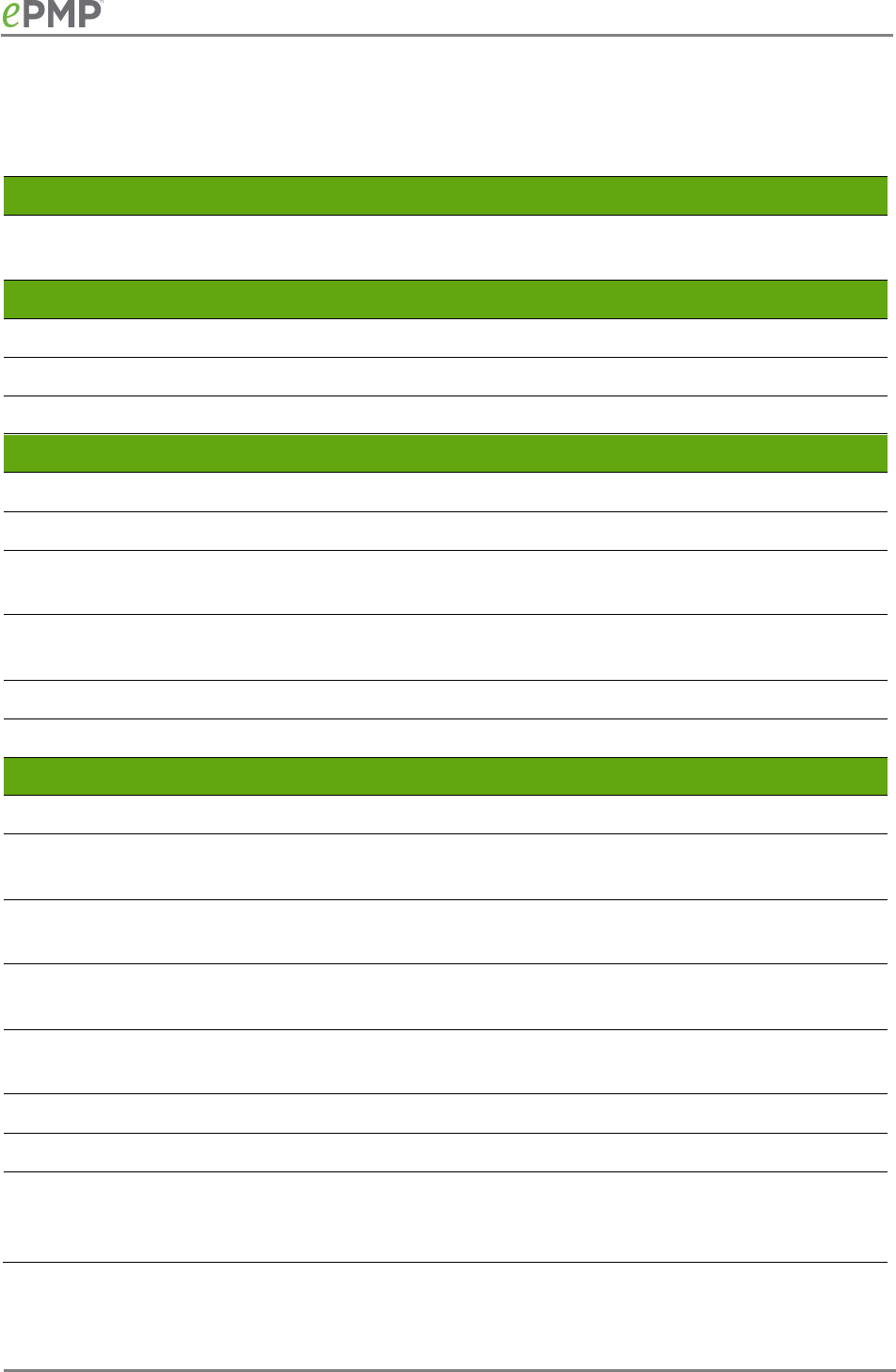
CAMBIUM NETWORKS
UN-SYNCED CONNECTORIZED RADIO SPECIFICATIONS
Table 98
Un-synced Connectorized
Radio specifications, 5 GHz
Product
SALES MODEL NUMBERS C058900A122A (US/FCC ), C050900A023A (EU),
C050900A021A (ROW)
Spectrum
CHANNEL SPACING Configurable on 5 MHz increments
FREQUENCY RANGE 5150 - 5875 MHz
CHANNEL WIDTH 20 MHz or 40 MHz
Interface
MAC (MEDIA ACCESS CONTROL) LAYER Cambium Proprietary
PHYSICAL LAYER 2x2 MIMO/OFDM
ETHERNET INTERFACE 100BaseT, Cambium PoE (V+ = pins 7 & 8,
Return = pins 4 & 5)
PROTOCOLS USED IPv4, UDP, TCP, IP, ICMP, SSH, SNMPv2c,
HTTPs, FTP
NETWORK MANAGEMENT HTTPs, SSH, FTP, SNMPv2c
VLAN 802.1Q with 802.1p priority
Performance
ARQ Yes
NOMINAL RECEIVE SENSITIVITY (W/ FEC) @
20MHZ CHANNEL
MCS1 = -89 dBm to MCS15 = -70 dBm (per
branch)
NOMINAL RECEIVE SENSITIVITY (W/ FEC) @
40MHZ CHANNEL
MCS1 = -87 dBm to MCS15 = -65 dBm (per
branch)
MAXIMUM DEPLOYMENT RANGE @ 20 MHz
CHANNEL
Up to 13 miles
MAXIMUM DEPLOYMENT RANGE @ 40 MHz
CHANNEL
Up to 9 miles
MODULATION LEVELS (ADAPTIVE) MCS1 (QPSK 1/2) to MCS15 (64QAM 5/6)
LATENCY (nominal, roundtrip) 17 ms
QUALITY OF SERVICE
Three level priority (Voice, High, Low) with
packet classification by DSCP, COS, VLAN ID, IP
& MAC Addr, Broadcast, Multicast and Station
Priority
296
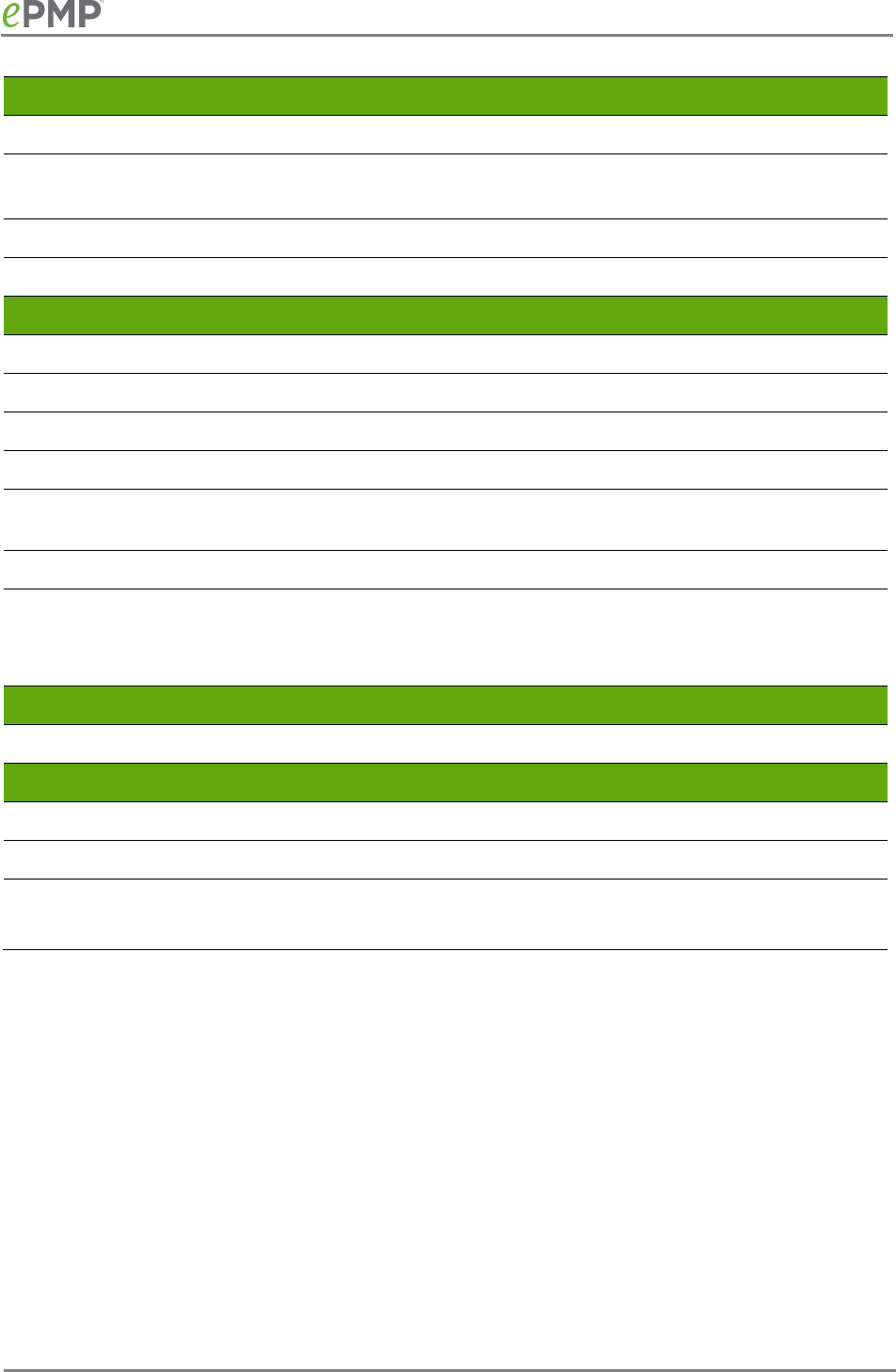
CAMBIUM NETWORKS
Link Budget
ANTENNA Options Antennas for 90° or 120° sectors are available
TRANSMIT POWER RANGE -20 to +30 dBm (combined, to regional EIRP
limit) (1 dB interval)
ANTENNA GAIN 15 dBi (90° sector)
MAXIMUM TRANSMIT POWER 30 dBm combined (5.8 GHz Band)
Physical
ANTENNA CONNECTION 50 Ω
, RP (Rev
SURGE SUPPRESSION 1 Joule Integrated
ENVIRONMENTAL IP55
TEMPERATURE -30°C to +55°C (-22°F to +131°F)
WEIGHT
4.5 kg (10 lbs) with antenna
0.52 kg (1.1 lbs) without antenna
WIND SURVIVAL 190 km/hour (118 mi/hour) with antenna
DIMENSIONS (H x W x D) Radio: 26.9 x 11 x 7.7 cm (10.6 x 4.3 x 3.0 in)
Antenna (excl brackets): 80.4 x 16 x 6.3 cm (31.7
x 6.3 x 2.5 in)
Security
ENCRYPTION 128-bit AES (CCMP mode)
Certifications
FCCID Z8H89FT0006
INDUSTRY CANADA CERT 109W-0006
CE EN 302 502 v1.2.1
EN 301 893 v1.7.1
297
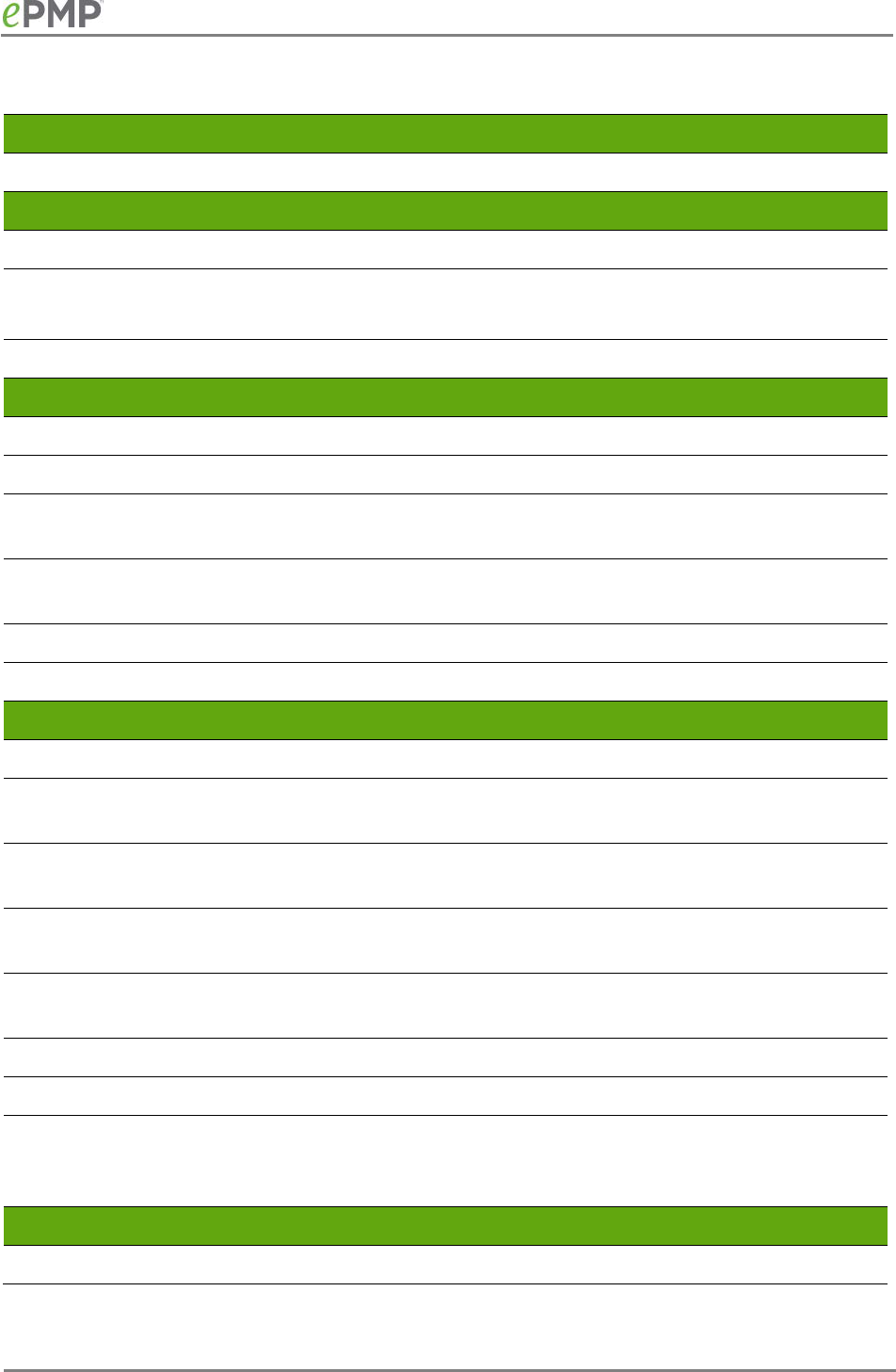
CAMBIUM NETWORKS
Table 99
Un-synced Connectorized
Radio specifications, 2.4 GHz
Product
SALES MODEL NUMBERS C024900A021A
Spectrum
CHANNEL SPACING Configurable on 5 MHz increments
FREQUENCY RANGE 2402 - 2472 MHz (20 MHz)
2407 - 2472 MHz (40 MHz)
CHANNEL WIDTH 20 MHz or 40 MHz
Interface
MAC (MEDIA ACCESS CONTROL) LAYER Cambium Proprietary
PHYSICAL LAYER 2x2 MIMO/OFDM
ETHERNET INTERFACE 100BaseT, Cambium PoE (V+ = pins 7 & 8, Return
= pins 4 & 5)
PROTOCOLS USED IPv4, UDP, TCP, IP, ICMP, SSH, SNMPv2c, HTTPs,
FTP
NETWORK MANAGEMENT HTTPs, SSH, FTP, SNMPv2c
VLAN 802.1Q with 802.1p priority
Performance
ARQ Yes
NOMINAL RECEIVE SENSITIVITY (W/ FEC) @
20MHZ CHANNEL
MCS1 = -89 dBm to MCS15 = -70 dBm (per
branch)
NOMINAL RECEIVE SENSITIVITY (W/ FEC) @
40MHZ CHANNEL
MCS1 = -87 dBm to MCS15 = -65 dBm (per
branch)
MAXIMUM DEPLOYMENT RANGE @ 20 MHz
CHANNEL
Up to 13 miles
MAXIMUM DEPLOYMENT RANGE @ 40 MHz
CHANNEL
Up to 9 miles
MODULATION LEVELS (ADAPTIVE) MCS1 (QPSK 1/2) to MCS15 (64QAM 5/6)
LATENCY (nominal, roundtrip) 17 ms
QUALITY OF SERVICE
Three level priority (Voice, High, Low) with
packet classification by DSCP, COS, VLAN ID, IP
& MAC Addr, Broadcast, Multicast and Station
Priority
Link Budget
ANTENNA Options Antennas for 90° or 120° sectors are available
298
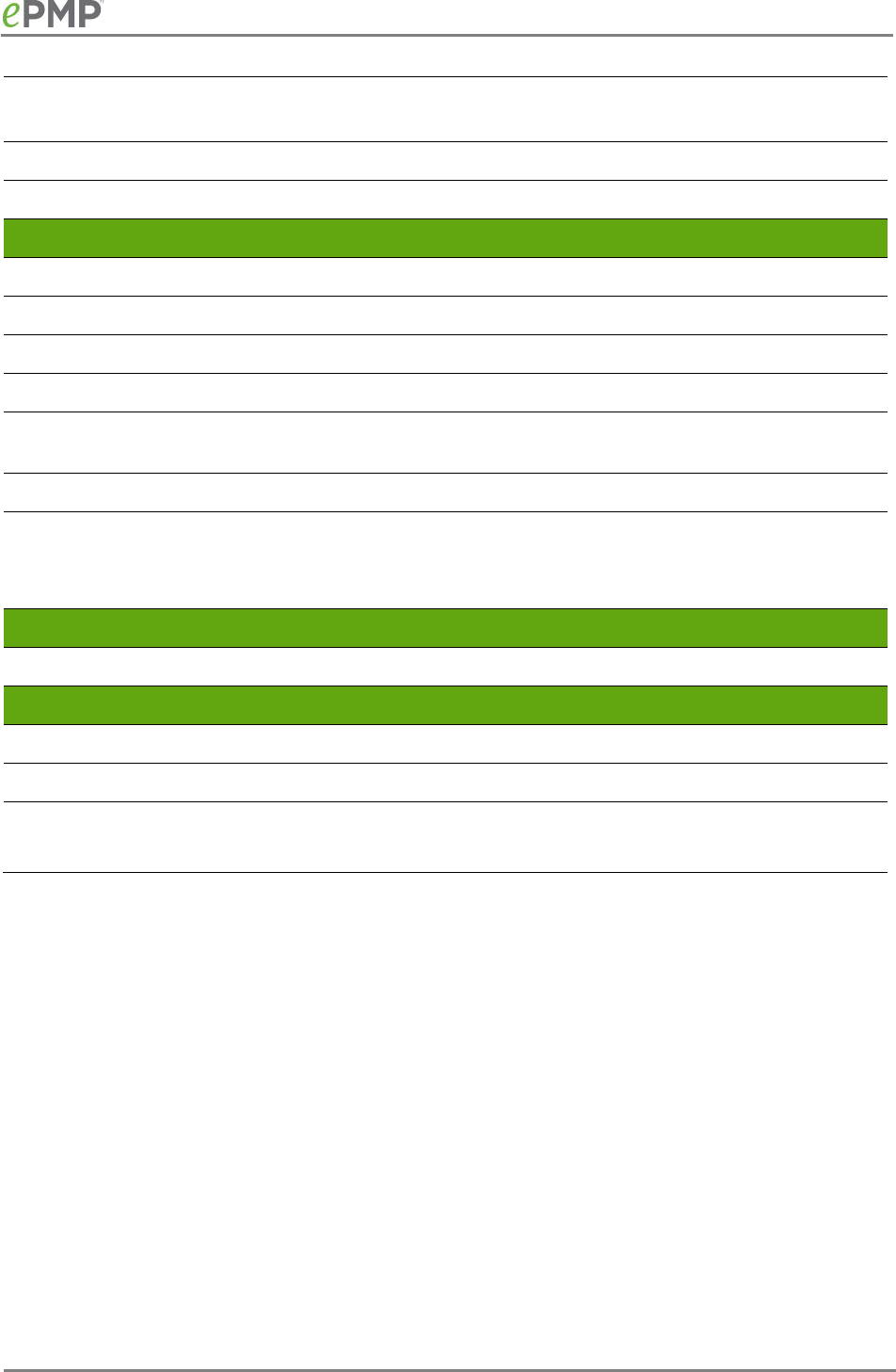
CAMBIUM NETWORKS
TRANSMIT POWER RANGE -20 to +30 dBm (combined, to regional EIRP limit)
(1 dB interval)
ANTENNA GAIN 15 dBi (90° / 120° sector)
MAXIMUM TRANSMIT POWER 30 dBm combined
Physical
ANTENNA CONNECTION 50 Ω
, RP (Reverse Pol
female
SURGE SUPPRESSION 1 Joule Integrated
ENVIRONMENTAL IP55
TEMPERATURE -30°C to +55°C (-22°F to +131°F)
WEIGHT
4.5 kg (10 lbs) with antenna
0.52 kg (1.1 lbs) without antenna
WIND SURVIVAL 190 km/hour (118 mi/hour) with antenna
DIMENSIONS (H x W x D) Radio: 26.9 x 11 x 7.7 cm (10.6 x 4.3 x 3.0 in)
Antenna (excl brackets): 80.4 x 16 x 6.3 cm (31.7
x 6.3 x 2.5 in)
Security
ENCRYPTION 128-bit AES (CCMP mode)
Certifications
FCCID Z8H89FT0006
INDUSTRY CANADA CERT 109W-0006
CE EN 302 502 v1.2.1
EN 301 893 v1.7.1
299

CAMBIUM NETWORKS
Glossary
Term
Definition
AES
Advanced Encryption Standard
ANSI
American National Standards Institute
AP
Access Point
CINR
Carrier to Interference plus Noise Ratio
CMM
Cluster Management Module
CNSS
Cambium Network Services Server
DFS
Dynamic Frequency Selection
EIRP
Equivalent Isotropically Radiated Power
EMC
Electromagnetic Compatibility
EMD
Electromagnetic Discharge
ETH
Ethernet
ETSI
European Telecommunications Standards Institute
FCC
Federal Communications Commission
FEC
Forward Error Correction
GPS
Global Positioning System
GUI
Graphical User Interface
HTTP
Hypertext Transfer Protocol
IC
Industry Canada
IEEE
Institute of Electrical and Electronics Engineers
IP
Internet Protocol
LAN
Local Area Network
LED
Light Emitting Diode
LOS
Line of Sight
MIMO
Multiple In Multiple Out
MTU
Maximum Transmission Unit
nLOS
Near Line of Sight
NTP
Network Time Protocol
OFDM
Orthogonal Frequency Division Multiplexing
PC
Personal Computer
PMP
Point to Multipoint
QAM
Quadrature Amplitude Modulation
QPSK
Quadrature Phase Shift Keyed
RF
Radio Frequency
RMA
Return Merchandise Authorization
RSSI
Received Signal Strength Indication
RTTT
Road Transport and Traffic Telematics
RX
Receive
SAR
Standard Absorption Rate
SNMP
Simple Network Management Protocol
STA
Station
SW
Software
TDD
Time Division Duplex
300

CAMBIUM NETWORKS
TDWR
Terminal Doppler Weather Radar
TX
Transmit
UNII
Unlicensed National Information Infrastructure
URL
Uniform Resource Locator
VLAN
Virtual Local Area Network
301
